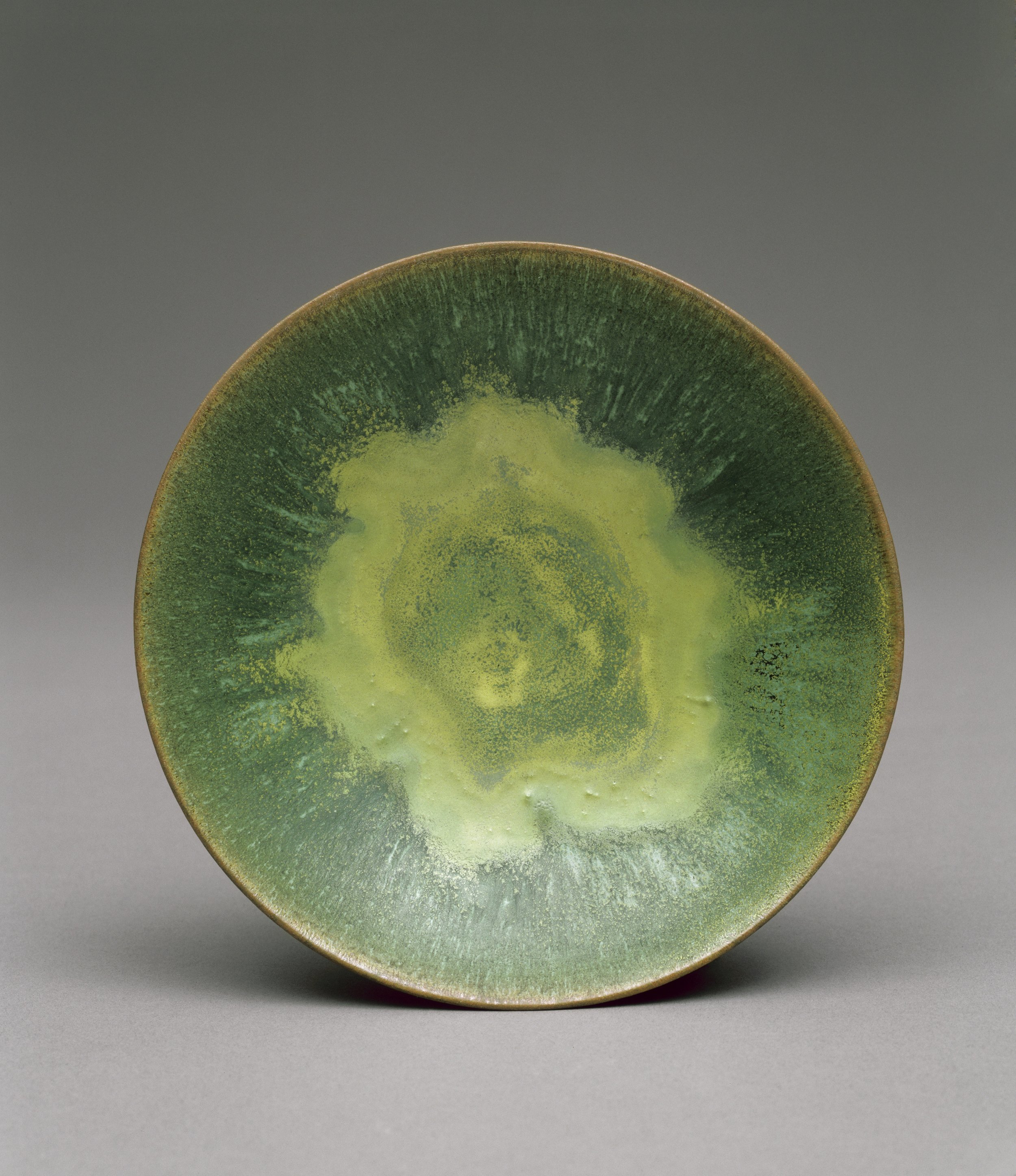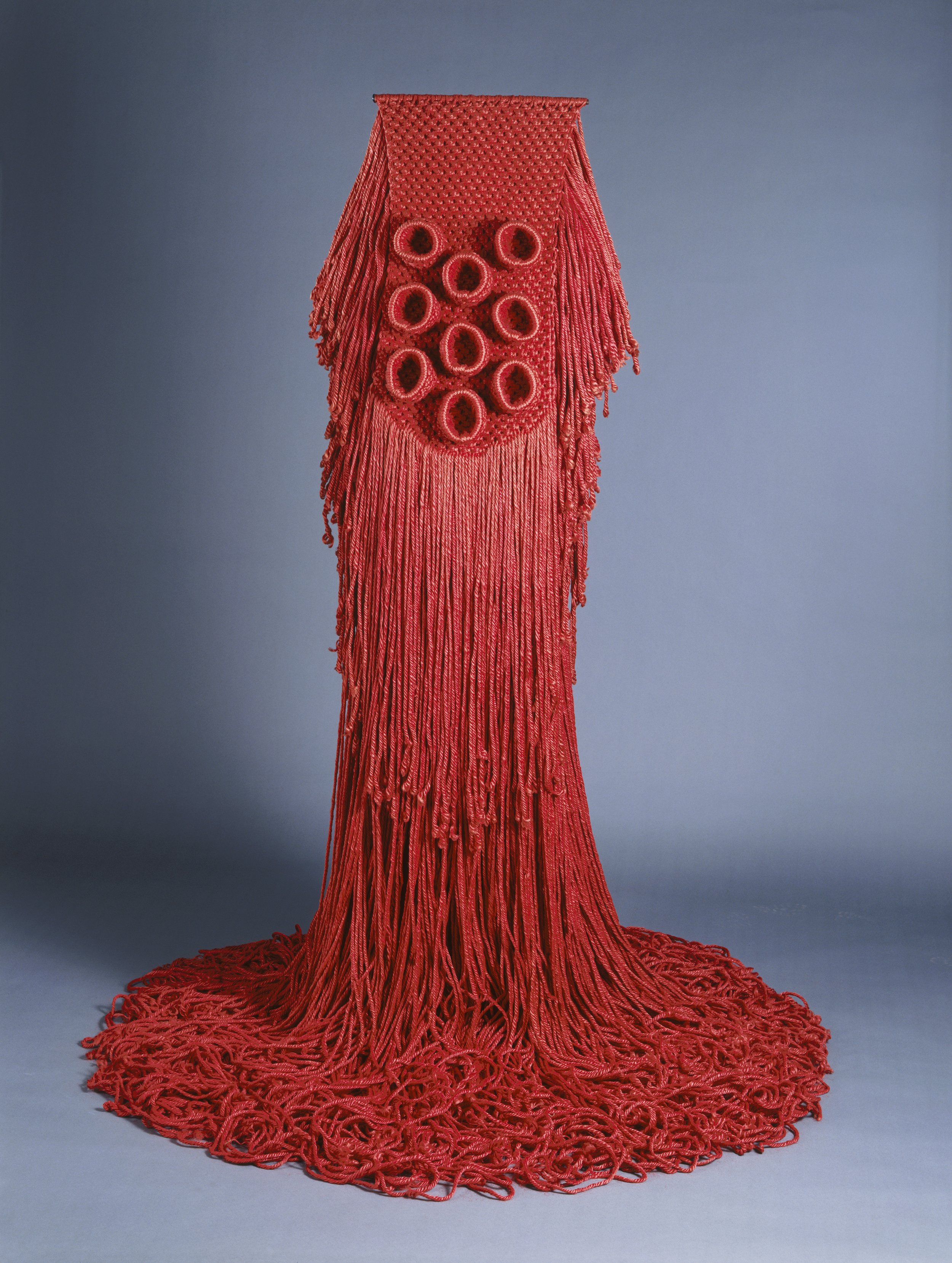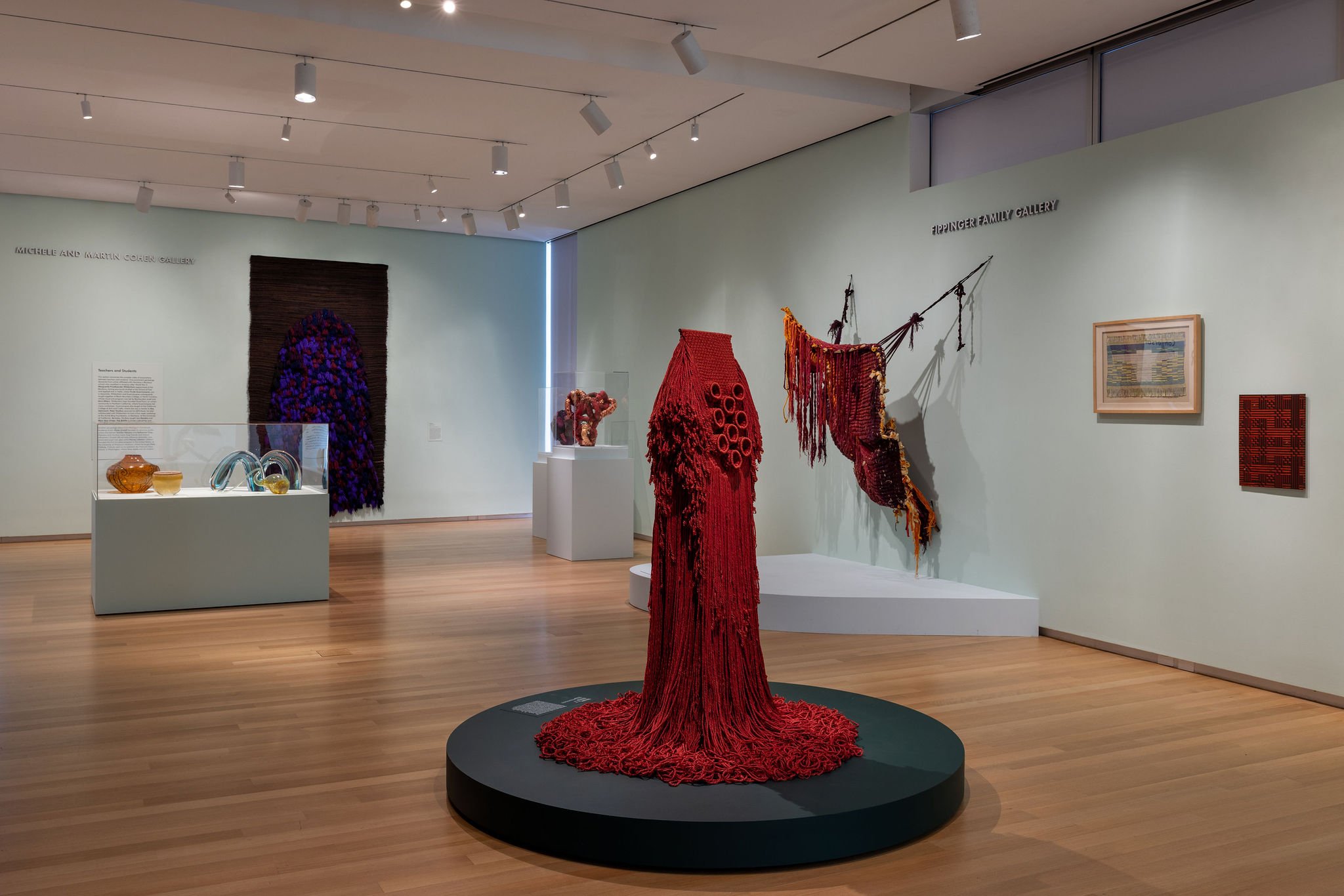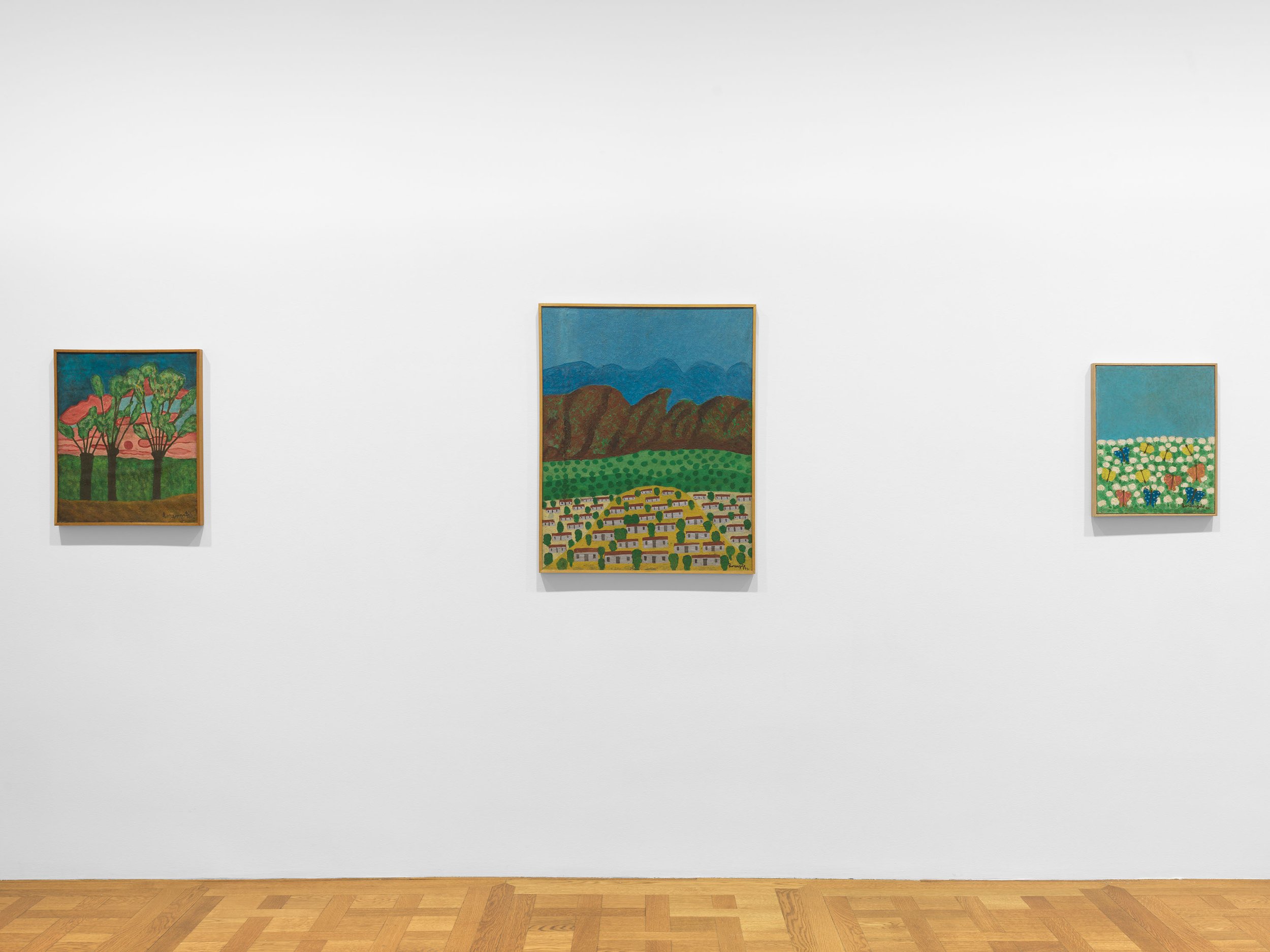ABDOULAYE KONATÉ : L’âme des signes/The Soul of Signs
Toutes les images / All images : Courtesy the artist and Templon, Paris —Brussels — New York
Malian artist Abdoulaye Konaté is exhibiting his work for the very first time at Galerie Templon. The gallery’s Brussels space is hosting the L’Ame des Signes/The Soul of Signs exhibition, a brand new series of eight textile pieces.
Abdoulaye Konaté, known as the Master, was born in 1953 in Diré, Mali. He is a leading figure on the African contemporary art scene. In the 1990s, he swapped canvas and brushes for needle and thread as fabric developed into his favourite medium. His work combines Western modernism with African symbolism, addressing social and political issues such as religious fanaticism and social justice with a complex and shimmering palette that has become his signature over the years.
Toutes les images / All images : Courtesy the artist and Templon, Paris —Brussels — New York
The Soul of Signs exhibition covers the gallery walls in majestic hand-embroidered canvases. The artist creates them using offcuts of African Bazin fabric which he dyes then rearranges in entrancing shaded tones, from fiery red to midnight blue, emerald green to golden yellow. "Nature is an endless source of colour inspiration to me," explains the artist. "A butterfly, a bird, a chameleon or a starry sky inspire me every day to come up with new pigments."
Konaté uses fine thread to embroider mysterious linguistic symbols on his multi-hued canvases. He finds the symbols during his travels, on the rim of 16th-century Tunisian ceramics, for instance, or at the heart of Berber art museums. “These marks have their own soul because they bear within them the heritage of a culture,” explains the artist. “Today’s generations have a duty to ensure that not everything is forgotten, to make use of these keys to our past and adapt them to contemporary society.”
Toutes les images / All images : Courtesy the artist and Templon, Paris —Brussels — New York
Born in 1953 in Diré, Mali, Konaté lives and works in Bamako. He is a visual artist and major figure on the contemporary art scene of his country and the African continent. After graduating from the Institut National des Arts of Bamako in 1976, he studied at the Instituto Superior de Arte in Havana, Cuba, from 1978 to 1985. He headed the Exhibitions Division at the Musée National du Mali from 1985 to 1997 before taking charge of the Palais de la Culture in Bamako and Rencontres Photographiques de Bamako from 1998 to 2002. He then took up the post of head of the Conservatoire des Arts et Métiers Multimédia "Balla Fasseké Kouyaté" in Bamako, Mali.
Toutes les images / All images : Courtesy the artist and Templon, Paris —Brussels — New York
His work has been shown in numerous solo exhibitions, including at the Espace Dominique Bagouet in Montpellier (2021), Zeitz MOCAA in Cape Town (2020), Fondation CDG in Rabat, Morocco (2017), Arken Museum of Modern Art, Copenhagen(2016), Fondation Festival sur le Niger in Mali (2012), Galerie Nationale d’Art in Dakar (2011), Biennale d’Art Contemporain in Dakar (2010), Forum für Kunst in Germany (2009), Musée National du Mali in Bamako (1992), and Musée de l’IFAN in Senegal (1992). He has been invited to take part in a wide range of group exhibitions, such as at La Villette in Paris (2017), 57th Venice Biennale (2017), Biennale d’Art Contemporain in Dakar (2016), Norrköping Konstmuseum in Sweden (2015), National Museum of African Art, Smithsonian Institute in the USA (2013), Musée d’Art Moderne de la Ville de Paris (2013), Stedelijk Museum in the Netherlands (2012), Institut du Monde Arabe in Paris (2011), Bienal de La Habana in Cuba (2009), Gwangju Biennale in South Korea (2008), Documenta – Kassel in Germany (2007), and Palais des Beaux-Arts in Brussels (2003).
His work features in public collections at institutions including the Metropolitan Museum of Art in the USA, Smithsonian Museum in the USA, Stedelijk Museum in the Netherlands and D’ak’art, Biennale de l’Art Africain Contemporain in Senegal.
For more information about Abdoulaye’s artwork and his exhibition, please visit Templon’s site. The gallery can also be found on Instagram, artnet, Facebook, YouTube, and Artsy.
EDI RAMA
Courtesy of Marian Goodman Gallery
“Politics is the battle of everyday life. And art is like a prayer.” – Edi Rama
Marian Goodman Gallery is pleased to present a new solo exhibition by Edi Rama, artist and current Prime Minister of Albania. This first major monographic exhibition in Paris, where Rama lived in the 1990s, offers a panorama of his artistic practice through drawings on paper, printed wallpaper, ceramic sculptures and a hand-embroidered folding screen. The ensemble, the result of an unprecedented creative process, underscores the artist's close relationship with color. Color has been essential to Rama, both in his political career and in his artistic practice, for its ability to convey elements of the psyche but also for its potential to change our perceptions and invigorate dialogue between individuals.
EDI RAMA Untitled, 2024 Ceramic 25 5/8 x 28 3/8 x 25 5/8 in. (65 x 72 x 65 cm) Photo credit: Rebecca Fanuele © Edi Rama Courtesy of the artist and Marian Goodman Gallery
For Rama, drawing stems from a “need to find a balance between the inner gaze and outer gaze.” In the spirit of automatic drawings which focus on the unconscious mind, and to improve his concentration and listening skills, Rama draws during meetings and telephone calls in his ministerial office. “The only thing I know is that they are part of my working time. It is about working and it is like something inside me that is trying to escape the working frame.” Once completed, the drawings, which have become emblematic of his oeuvre, consist of complex compositions, made of bright colors partially covering A4 printed notes or daily appointment schedules.
The presence of hundreds of colored markers on his official desk dates back to the time when, as the Mayor of Tirana, he launched the ambitious project of repainting the city's facades of social housing in vivid colors. This initiative, documented by his long-time friend Anri Sala in his video Dammi i colori (2003), was intended not only to beautify the city, but also to revitalize the community; by using color as a means for social impact, Rama wanted to create a sense of belonging and communication with the inhabitants. “I do not think there is another city in Europe, be it the richest, where people discuss so passionately and collectively about colors. The hottest discussion in the coffee bars, in homes, in the streets was what the colors were doing to us,” explains Edi Rama in the 2003 video.








When Rama started drawing in his ministerial office, he also decided to display his colorful works as well as incorporating them as motifs for a wallpaper on site. The immersive installation that comprises Rama's office has been transposed to the first space of the exhibition, with a newly-designed wallpaper. Large polychromatic ceramic sculptures, which seem to embody the three-dimensional translation of his works on paper, are presented on custom-made pedestals. Conceived as ronde-bosse, that play with color, texture and shape, they invite the viewer to examine them from multiple angles. Extravagant and atypical at the same time, each resemble an architecture of whimsy and ingenuity.
EDI RAMA Untitled, 2024 Paravent, printed fabric, embroidery, ceramic and bronze sculpture 64 3/4 x 71 5/8 x 2 in. (164.5 x 182 x 5 cm) Photo credit: Rebecca Fanuele © Edi Rama Courtesy of the artist and Marian Goodman Gallery
For the first time, Rama also includes in its exhibition a folding screen on which his multicolored drawings are hand-embroidered, combined with a composition inspired by X-rays of the famous cycle The Battle of San Romano painted by Florentine Renaissance artist Paolo Uccello in the early 1440s.
EDI RAMA Untitled, 2023 Mixed media on paper 7 7/8 x 11 3/4 in. (20 x 30 cm) Photo credit: Rebecca Fanuele © Edi Rama Courtesy of the artist and Marian Goodman Gallery
The second space of the exhibition is imbued with the atmosphere of the studio where he models, paints and fires his ceramic pieces. Unlike his drawings, Rama's ceramics are made in his spare time in a studio outside the Kryeministria. Since his very first set of works, exhibited in 2016 in our New York gallery, the artist has deepened his knowledge and technique of ceramics, as evidenced by new small wall sculptures in glazed ceramic, pieces combining ceramic and bronze, and those composed from multiple fragments.
Born in 1964, Edi Rama lives and works in Tirana. A former professor of painting at the Tirana Academy of Fine Arts and a former player on the national basketball team, he is also the author of several books. He has served as Prime Minister of Albania since 2013. Alongside his political career, which began in 1998, Rama regularly exhibits his work, which has been the subject of several solo shows, most recently Improvisations, Zappeion, Athens, Greece (2023) and Edi Rama: Work, which traveled from Kunsthalle Rostock, Germany (2028) to the Nevada Museum of Art, Ren (2019)
EDI RAMA Untitled (Paris), 2024 (DETAIL) Archival pigment inkjet on 11 mil, latex based, nylon reinforced wallpaper installation Dimensions variable Photo credit: Rebecca Fanuele © Edi Rama Courtesy of the artist and Marian Goodman Gallery
Rama took part in Viva Arte Viva, the 57th Venice International Art Biennale in 2017. He has also exhibited his work at numerous institutions, including the New Museum in New York (2016), the Musée d'art contemporain de Montréal (2011), the MNAM - Centre Pompidou in Paris (2010), and Rama took part in Viva Arte Viva, the 57th Venice International Art Biennale in 2017. He has also exhibited his work at numerous institutions, including the New Museum in New York (2016), the Musée d'art contemporain de Montréal (2011), the MNAM - Centre Pompidou in Paris (2010) and the Haus der Kunst in Munich (2004).






Exhibition view: Edi Rama, Galerie Marian Goodman Paris 8 June – 26 July 2024 Photo credit: Rebecca Fanuele © Edi Rama and Marian Goodman Gallery Courtesy of the artist and Marian Goodman Gallery
There was an opening reception on Saturday, June 8th, from 6 to 8 p.m., at 66 rue de Temple in Paris. The exhibition will close on July 26th of this year. For more information about the exhibit, please visit the Marian Goodman Gallery’s site. The gallery can also be found on Instagram, YouTube, Facebook, and Artsy.
*Hover over the image to find the caption.
Craft Front & Center: Conversation Pieces
Installation view of Craft Front & Center: Conversation Pieces at the Museum of Arts and Design, New York Photo by Jenna Bascom; courtesy the Museum of Arts and Design. Image dimensions: 2048px x 1366px
Craft Front & Center: Conversation opened on June 1 2024. Each Piece explores craft’s collaborative approach to learning and working by placing pioneering twentieth-century craft artists into dialogue with twenty-first century artists who are rethinking craft techniques and materials. Showcasing MAD’s permanent collection, the exhibition brings together more than sixty historic, recently acquired, and commissioned works in a range of artistic media; most prominently, the central craft materials of ceramic, glass, and fiber. “While all art hinges on the exchange of ideas, craft-based art is particularly dependent on the relationships between artists,” said Alexandra Schwartz, MAD’s Curator of Modern & Contemporary Art, Design & Craft. “Techniques such as weaving, blowing glass, or throwing pots are skills that must be taught. As a result, artists who use craft techniques tend to be especially attuned to craft traditions—and invested in upending them.”
Gertrud Natzler and Otto Natzler Bowl (H814), 1957. Photographer: Photo: Ed Watkins. Image dimensions: 4585px x 5307px
Three overlapping thematic sections illuminate how craft’s collaborative approach to learning and working informs creative practices. The “Teachers and Students” section presents works by artist educators alongside works by their pupils. Notable pedagogic relationships represented include California College of Arts and Crafts faculty Trude Guermonprez and her mentee Kay Sekimachi, University of California, Berkeley faculty Paul Voulkos and students Jun Kaneko and Mary Ann Unger, and Cranbrook Academy of Art’s Maija Grotell, who trained Toshiko Takaezu and Katherine Choy. The section also includes artists who studied together at the same academies and workshops, many of whom went on to work together and influence one another throughout their career, such as Bauhaus alumni Marguerite Friedländer-Wildenhain and Anni Albers.
Claire Zeisler Red Wednesday, 1967. Photographer: Eva Heyd Image dimensions: 4347px x 5764px
The “Collaborations” section provides an expansive view of artistic partnerships. Founders of the artist collective AYDO Studio, A young Yu and Nicholas Oh create multimedia projects that explore their Korean American heritage and incorporate Korea’s craft traditions, often in audacious and unexpected ways. Designer Pedro Barrail works with a team of indigenous craftspeople in Paraguay to produce furniture that challenges perceived divisions between ancient craft techniques and contemporary design. Composing a stoneware portrait of her own mother inspired by a carved ivory likeness of a sixteenth-century German aristocrat, artist Rachelle Dang forms a collaboration with the ivory’s unnamed artist.
Installation view of Craft Front & Center: Conversation Pieces at the Museum of Arts and Design, New York Photo by Jenna Bascom; courtesy the Museum of Arts and Design. Image dimensions: 2048px x 1366px
The “Generational Dialogues” section examines how the creative resonances of the studio craft movement continue to influence artists and designers today. It includes experimental works of fiber art created by Sheila Hicks and Claire Zeisler and artists who continue to push the boundaries of the medium, such as Vadis Turner and Kira Dominguez Hultgren. To further explore the significance of dialogue among artists, MAD asked ceramic artists Marie Herwald Hermann and Anders Herwald Ruhwald, who share a studio in Chicago, to collaboratively select works from the permanent collection to be shown alongside their own. Hermann’s works, created specifically for the exhibition, directly reference the works of Ruth Duckworth. Ruhwald apprenticed with Jun Kaneko and his works on view were influenced by his mentor.
EXHIBITION CREDITS
Craft Front & Center has been made possible by a major grant from the National Endowment for the Humanities and Museum of Arts and Design together: Democracy demands wisdom. The exhibition is also supported, in part, by public funds from the New York City Department of Cultural Affairs in partnership with the City Council and the New York State Council on the Arts with the support of the Office of the Governor and the New York State Legislature. Research was supported by a Craft Research Fund grant from the Center for Craft. Additional support from The Gladys Krieble Delmas Foundation.
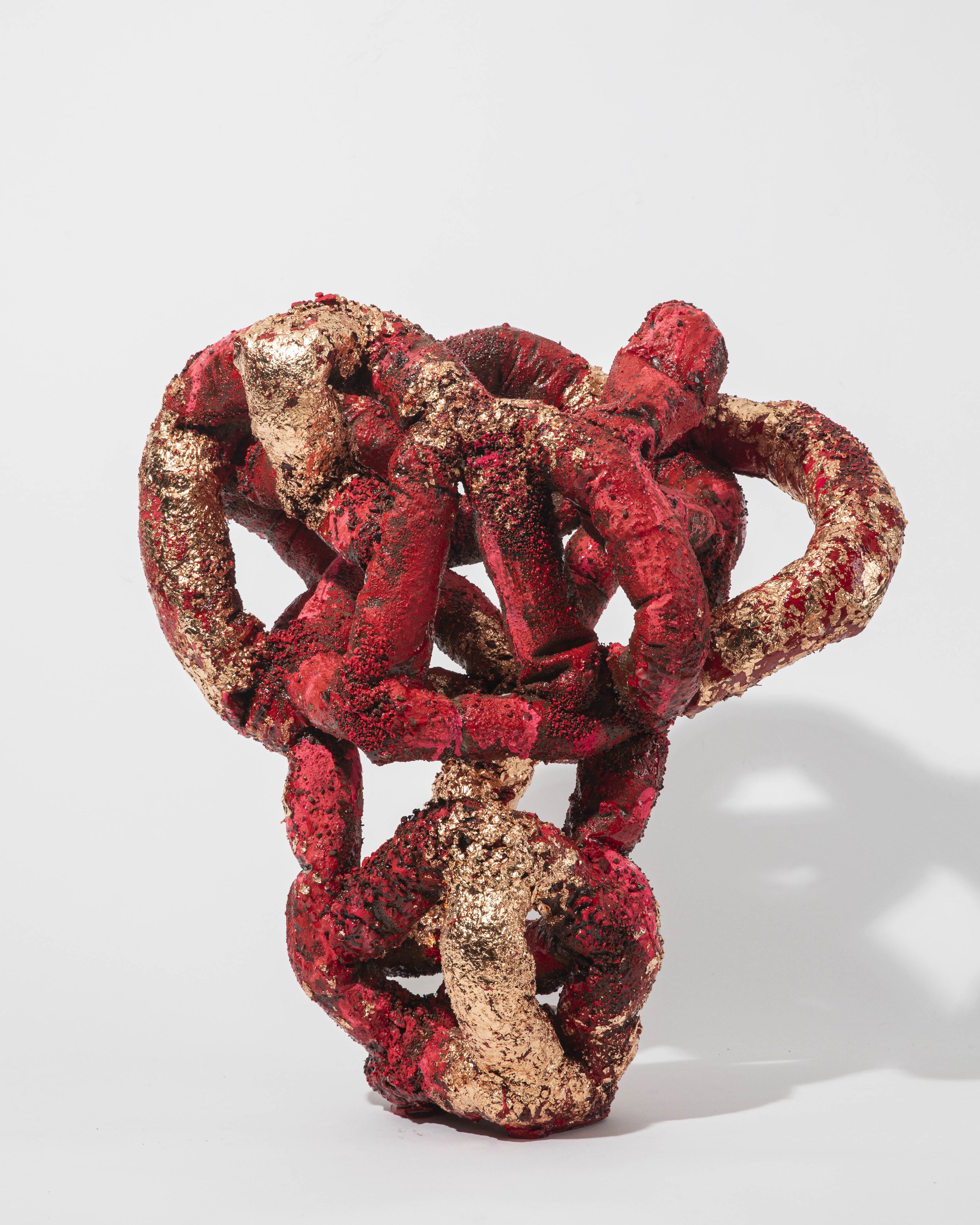
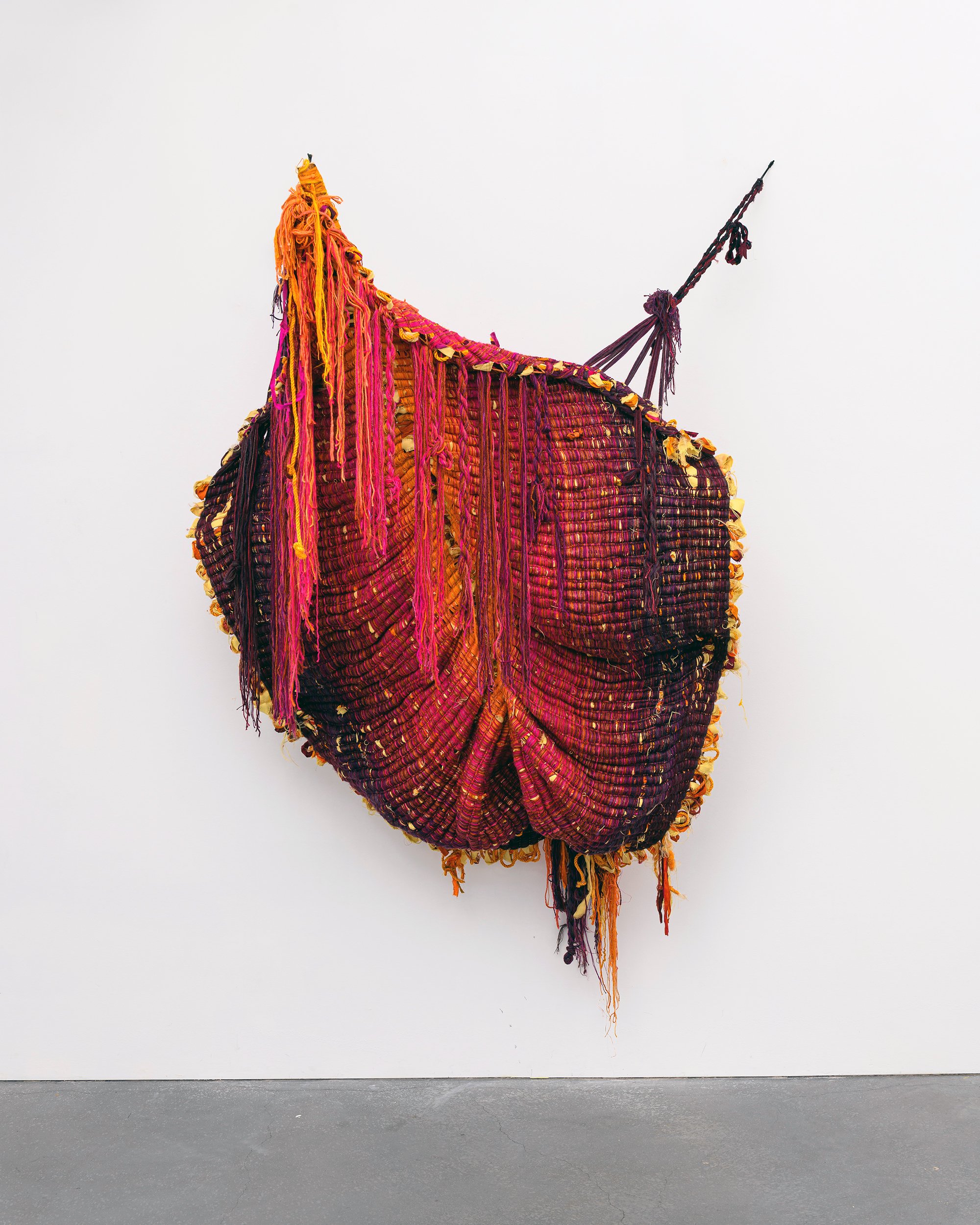
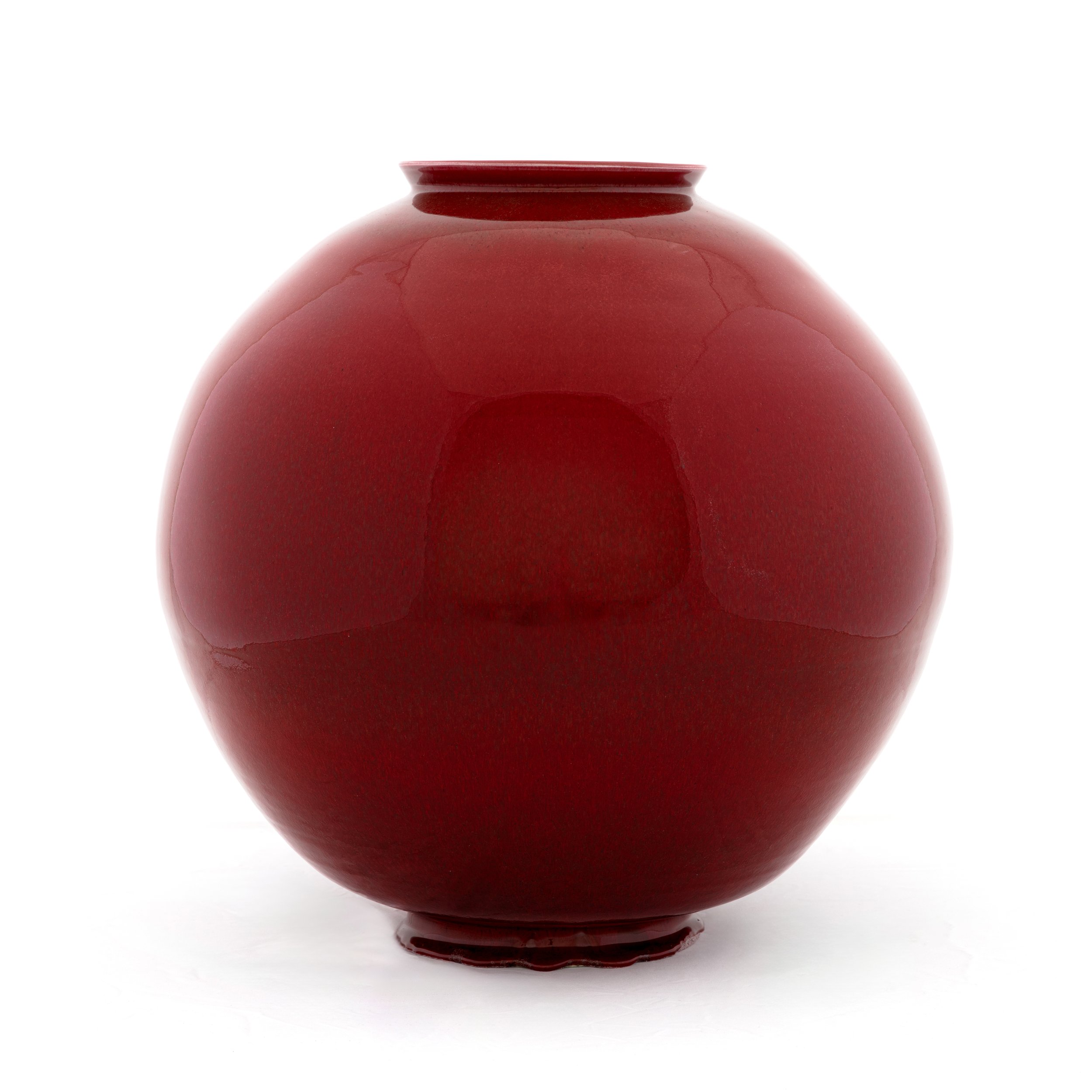
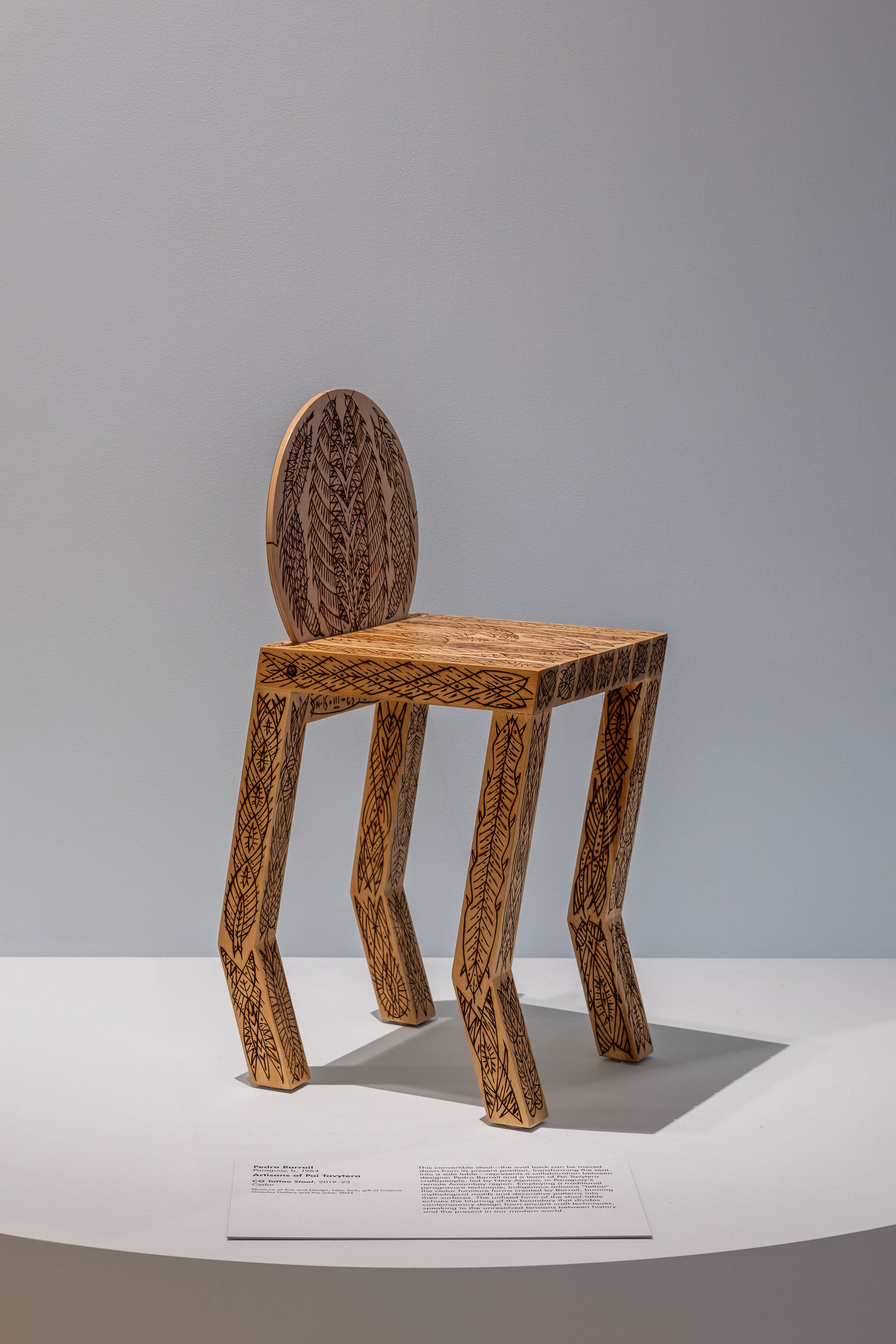
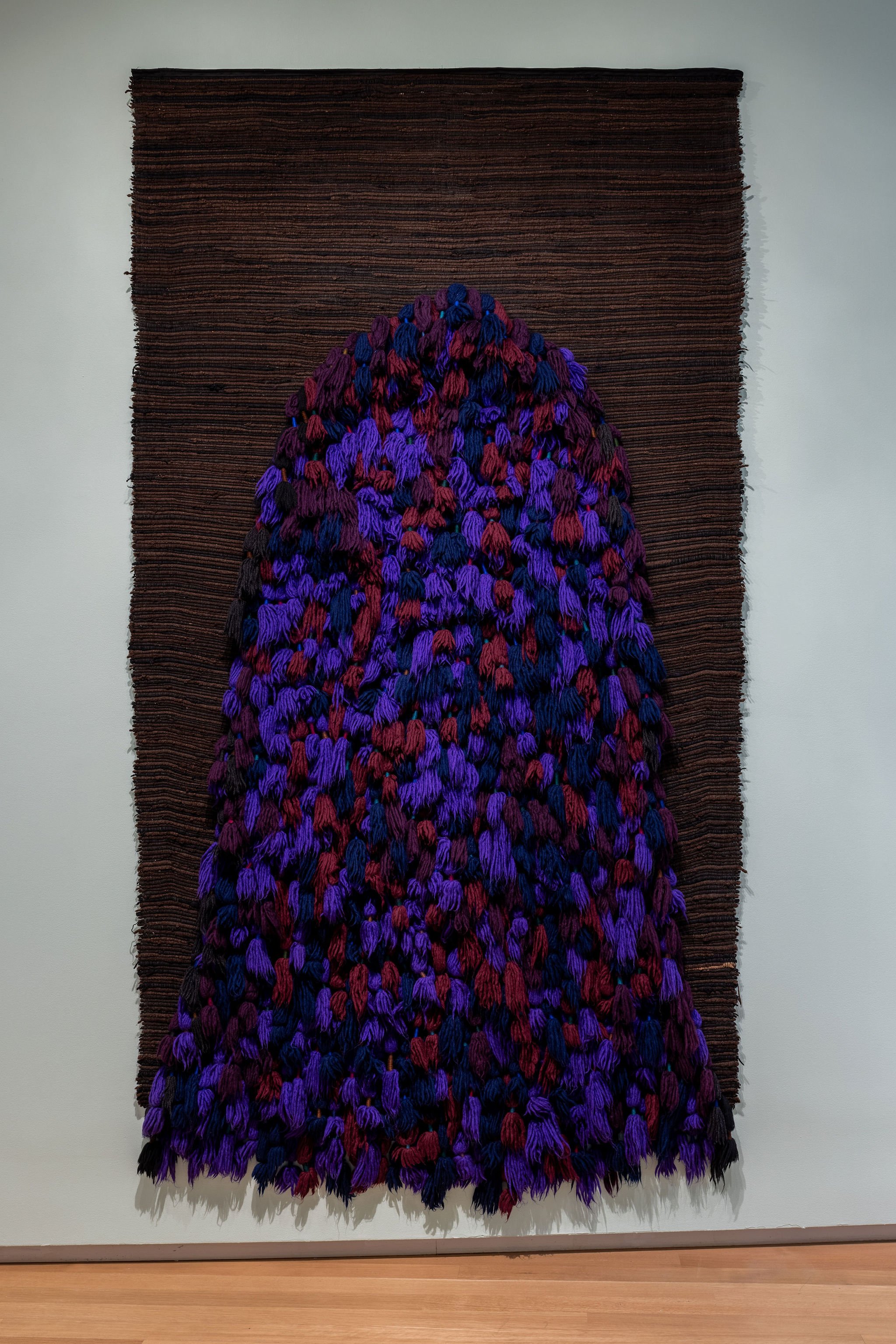
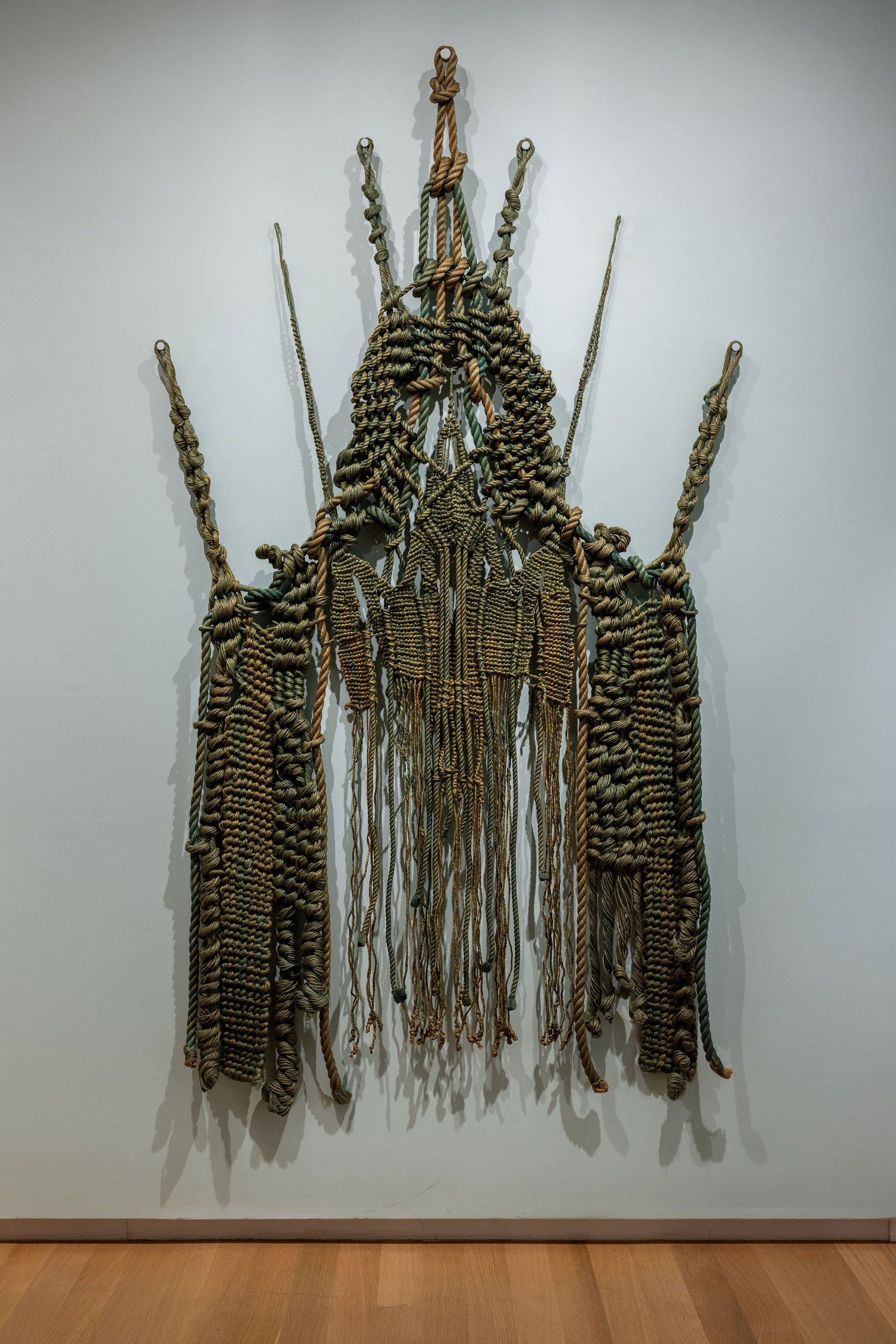
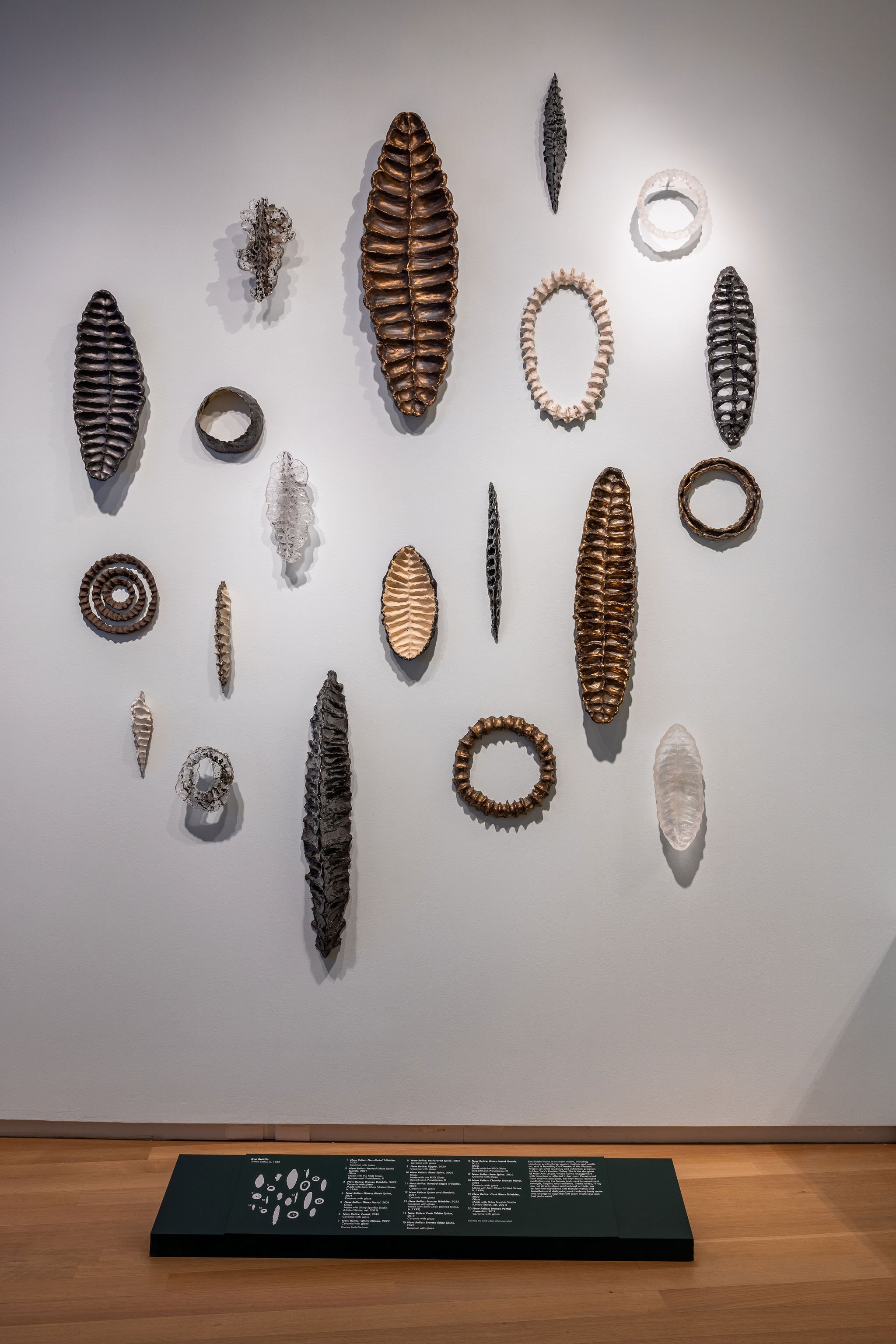
ARTISTS ON VIEW (ALPHABETICAL)
Anni Albers; AYDO Studio (A young Yu and Nicholas Oh); André Azevedo; Eve Biddle; Dale Chihuly; Katherine Choy; Rachelle Dang; Kira Dominguez Hultgren; Ruth Duckworth; Marguerite Friedländer-Wildenhain; Françoise Grossen; Maija Grotell; Trude Guermonprez; Marie Herwald Hermann; Sheila Hicks; Tony Jojola; Jun Kaneko; Liliana Ovalle & Colectivo 1050º; Harvey Littleton; Gertrud Natzler; Otto Natzler; Pedro Barrail & Artisans of Pai Tavytera; Anders Herwald Ruhwald; Kay Sekimachi; Toshiko Takaezu; Peter Ting; Vadis Turner; Mary Ann Unger; Peter Voulkos; Claire Zeisler.
Installation view of Craft Front & Center: Conversation Pieces at the Museum of Arts and Design, New York Photo by Jenna Bascom; courtesy the Museum of Arts and Design. Image dimensions: 2048px x 1366px
ABOUT THE MUSEUM OF ARTS AND DESIGN
The Museum of Arts and Design (MAD) champions contemporary makers across creative fields and presents the work of artists, designers, and artisans who apply the highest level of ingenuity and skill. Since the Museum’s founding in 1956 by philanthropist and visionary Aileen Osborn Webb, MAD has celebrated all facets of making and the creative processes by which materials are transformed, from traditional techniques to cutting-edge technologies. Today, the Museum’s curatorial program builds upon a rich history of exhibitions that emphasize a cross-disciplinary approach to art and design, and reveals the workmanship behind the objects and environments that shape our everyday lives. MAD provides an international platform for practitioners who are influencing the direction of cultural production and driving twenty-first-century innovation, and fosters a participatory setting for visitors to have direct encounters with skilled making and compelling works of art and design.
For more information about this exhibition and other exhibitions at the Museum of Arts and Design, please visit their site here. MAD can also be found on Facebook, Instagram, and YouTube.
Joyce J. Scott: Walk a Mile in My Dreams
Joyce J. Scott: Walk a Mile in My Dreams features a new large-scale commission and nearly 140 objects across the full arc of the artist’s career BALTIMORE, MD On March 24, the Baltimore Museum of Art (BMA) opened the 50-year career retrospective of artist Joyce J. Scott (b. 1948, Baltimore, MD), encompassing the full range and depth of her prolific and genre- defying practice. Joyce J. Scott: Walk a Mile in My Dreams features nearly 140 works from the 1970s to the present—including sculpture, jewelry, textiles, artwear garments, performance compilations, prints, mixed-media installations, and a new large-scale commission. The astonishing virtuosity and ingenuity of Scott’s work in every medium seamlessly coalesces with her lifelong vision to confront racism, sexism, classism, and “all the ‘isms’ society offers” through impish and audacious humor, expressions of beauty, and a humanistic engagement with global events. Her innate ability to move across medium and genre, leveraging her materials to speak fearlessly to subjects of deep personal and communal meaning make her one of the most significant artists of our time and deserving of greater scholarly study and public recognition. Joyce J. Scott: Walk a Mile in My Dreams is co-organized by the BMA and the Seattle Art Museum (SAM) and co-curated by Cecilia Wichmann, BMA Associate Curator of Contemporary Art, and Catharina Manchanda, SAM Jon and Mary Shirley Curator of Modern and Contemporary Art, with support from Leslie Rose, Joyce J. Scott Curatorial Research Assistant. The exhibition will be presented in Baltimore as a special ticketed exhibition from March 24 through July 14, 2024, and in Seattle from October 17, 2024, through January 20, 2025. Joyce J. Scott: Walk a Mile in My Dreams is accompanied by a fully illustrated 288-page catalog that offers new scholarship, artist reflections, and a selection of vital out-of-print source materials.
Installation view of Joyce J. Scott: Walk a Mile in My Dreams at the Baltimore Museum of Art, March 2024. Photo by Mitro Hood.
“Joyce J. Scott is a living legend and a pillar of Baltimore’s artistic community. Her multidisciplinary practice is in a word, magnetic, distinguished in its ability to conjure moments of beauty and awe, while also bringing people into conversation about challenging subjects in a way that is open and embracing. Her work is deeply rooted in both local and global contexts, vibrating with a resonance that is utterly and uniquely Joyce,” said Asma Naeem, the BMA’s Dorothy Wagner Wallis Director. “The
Joyce J. Scott. Joyce's Necklace. c. 1978-85. Rotasa Collection. © Joyce Scott courtesy Goya Contemporary. photo: Ian Reeves
BMA has had the honor of engaging audiences with Scott’s work for many years through exhibitions, public programs, and acquisitions. We are thrilled now to present this comprehensive exhibition that highlights the remarkable range of her career.” Scott has embraced her identity as an artist and performer since childhood. At home in Baltimore, her mother, the artist Elizabeth Talford Scott (1916–2011)—who is also currently the subject of a solo exhibition at the BMA and eight partner sites across Baltimore City—taught her to sew and express herself creatively. Scott considers this knowledge her inheritance: both the specific techniques and aesthetic traditions carried by enslaved people from Africa to the Americas and the awareness of her own life’s potential as part of a continuum.
In the 1970s, Scott began what would become a lifelong commitment to artistic learning and engagementwith global cultures. Her extensive travels have taken her to many countries, including Mexico, Cuba, Peru, Mali, Senegal, Scotland, South Africa, Thailand, and Italy, where she connected with local artisans and community members through a shared embrace of textiles, beads, and glass. As a result, Scott’s work has responded to global events—from the AIDS crisis to South African Apartheid and to American police brutality—and served to memorialize personal and collective transformations and traumas.


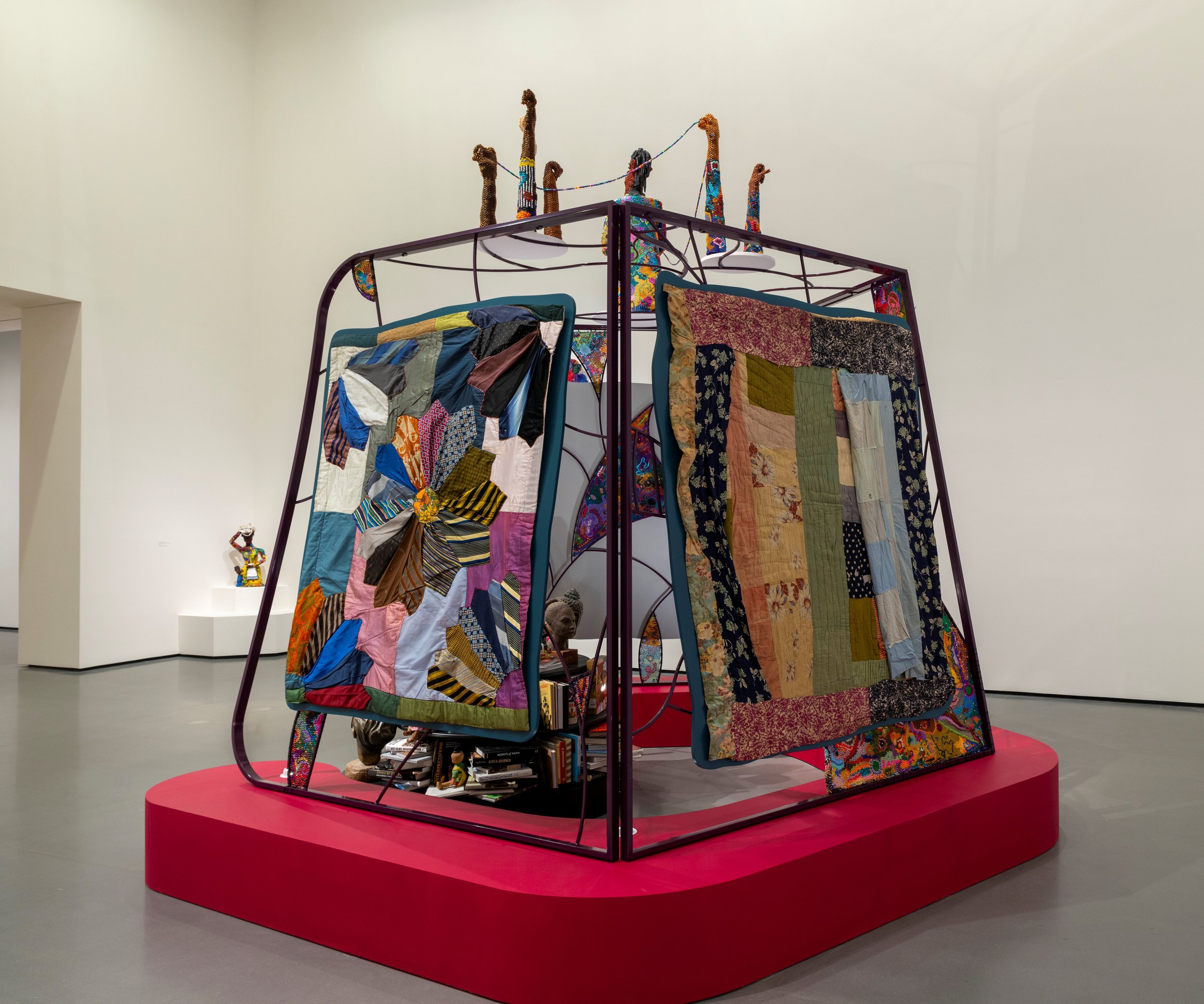







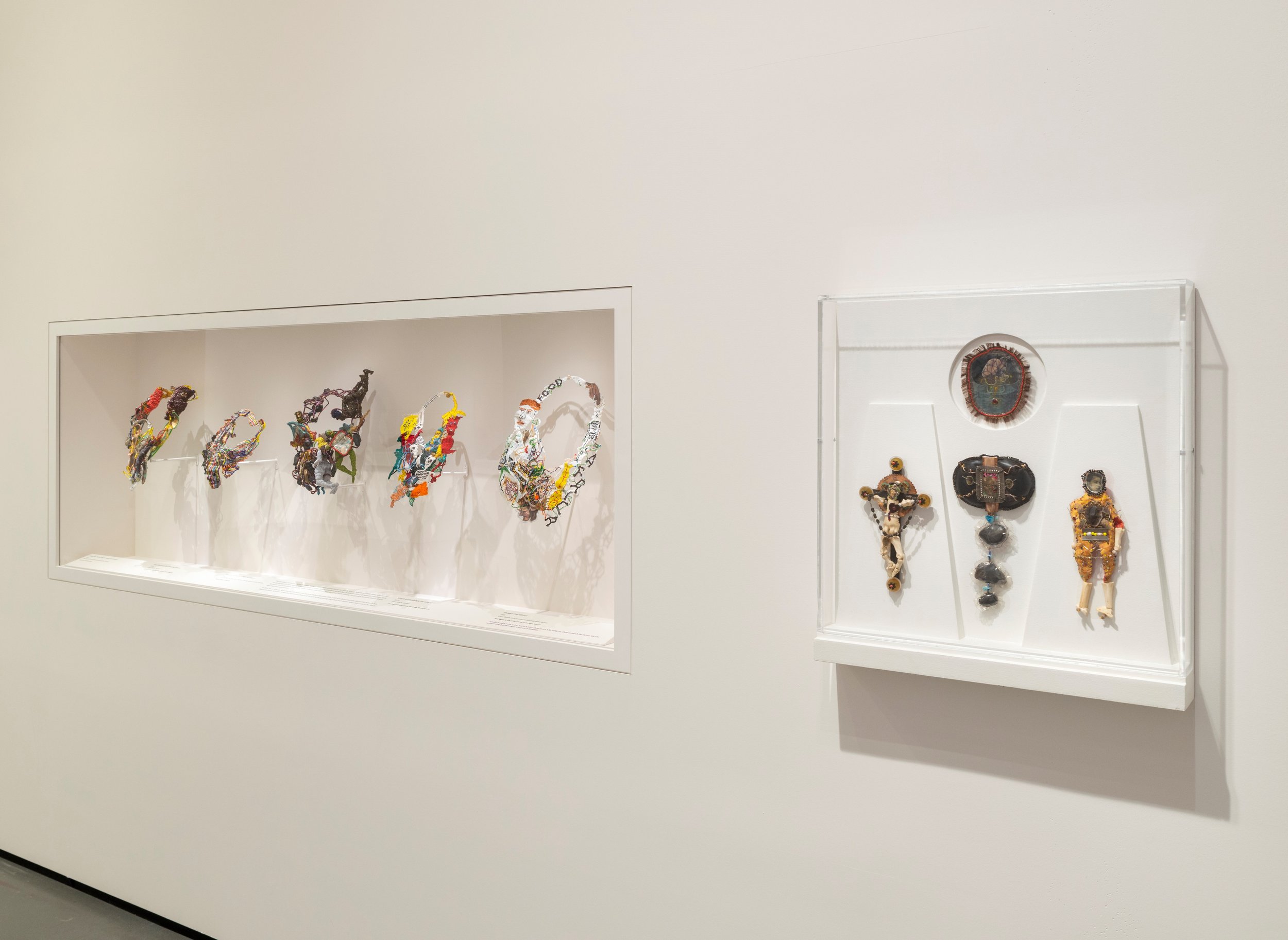




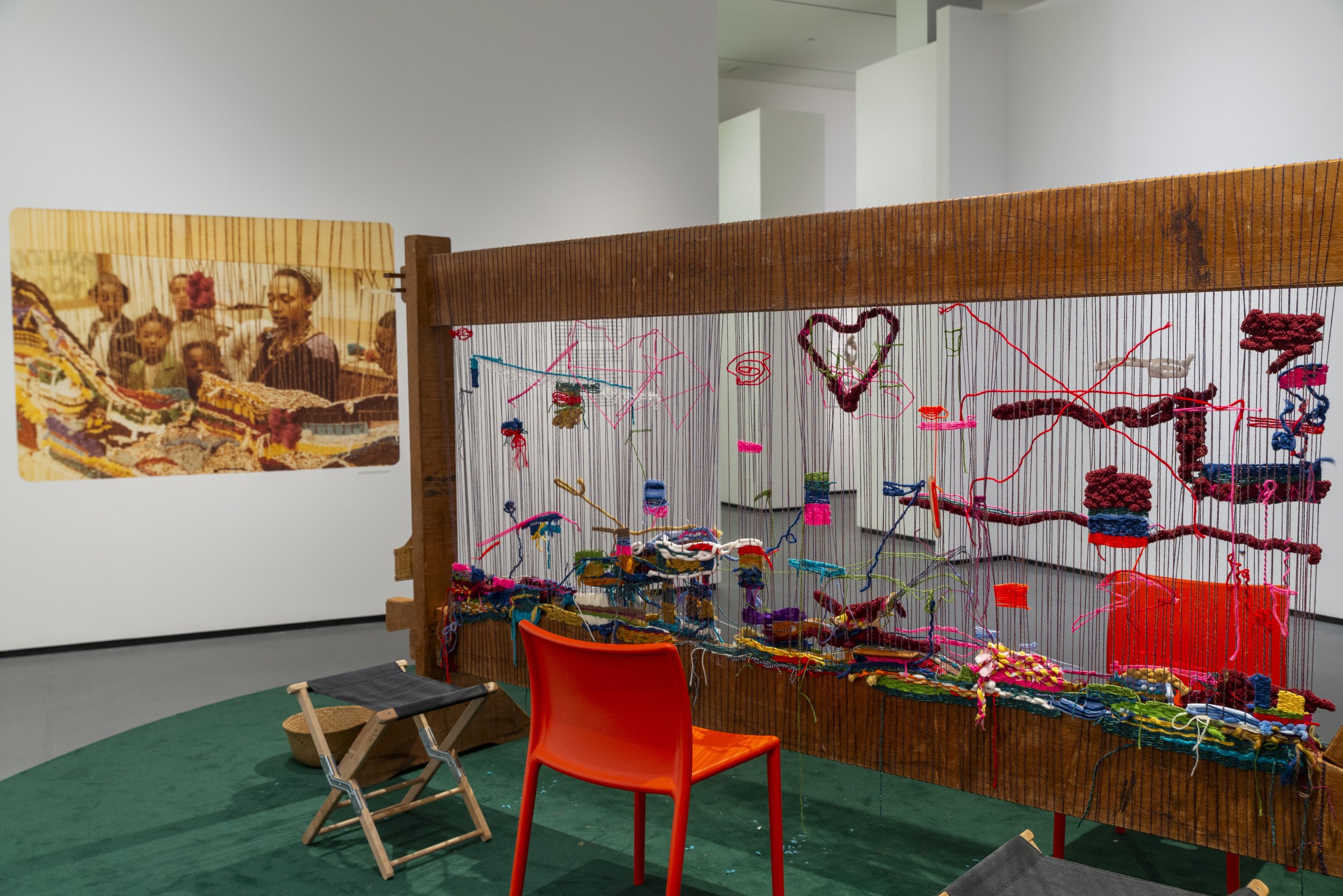
Installation view of Joyce J. Scott: Walk a Mile in My Dreams at the Baltimore Museum of Art, March 2024. Photo by Mitro Hood.
Joyce J. Scott: Walk a Mile in My Dreams draws on the BMA’s long commitment to Scott’s work, from the first acquisition in 1984 to a mid-career retrospective co-organized with the Maryland Institute College of Art’s groundbreaking Exhibition Development Seminar in 2000 and many recent acquisitions.
Kay Lawal and Joyce Scott for the Thunder Thigh Revue's Women in Substance performance, Baltimore. 1985. Philip Arnoult papers, Special Collections, Sheridan Libraries, Johns Hopkins University. © Joyce Scott courtesy Goya Contemporary, photo: Peggy Fox
The exhibition also reflects Scott’s longstanding engagement in the Seattle region through residencies at such venues as Pilchuck Glass School in 1992 and also includes a major sculpture recently acquired by SAM. The BMA’s exhibition is organized in ten thematic sections, with pivotal works reflecting the artist’s cyclical return to motifs and materials over time as she brings forward new ideas and fosters dialogue to support personal healing and critical social change. Additionally, the exhibition includes an expansive array of archival photography drawn in part from the artist’s personal collection. Among the exhibition highlights are:
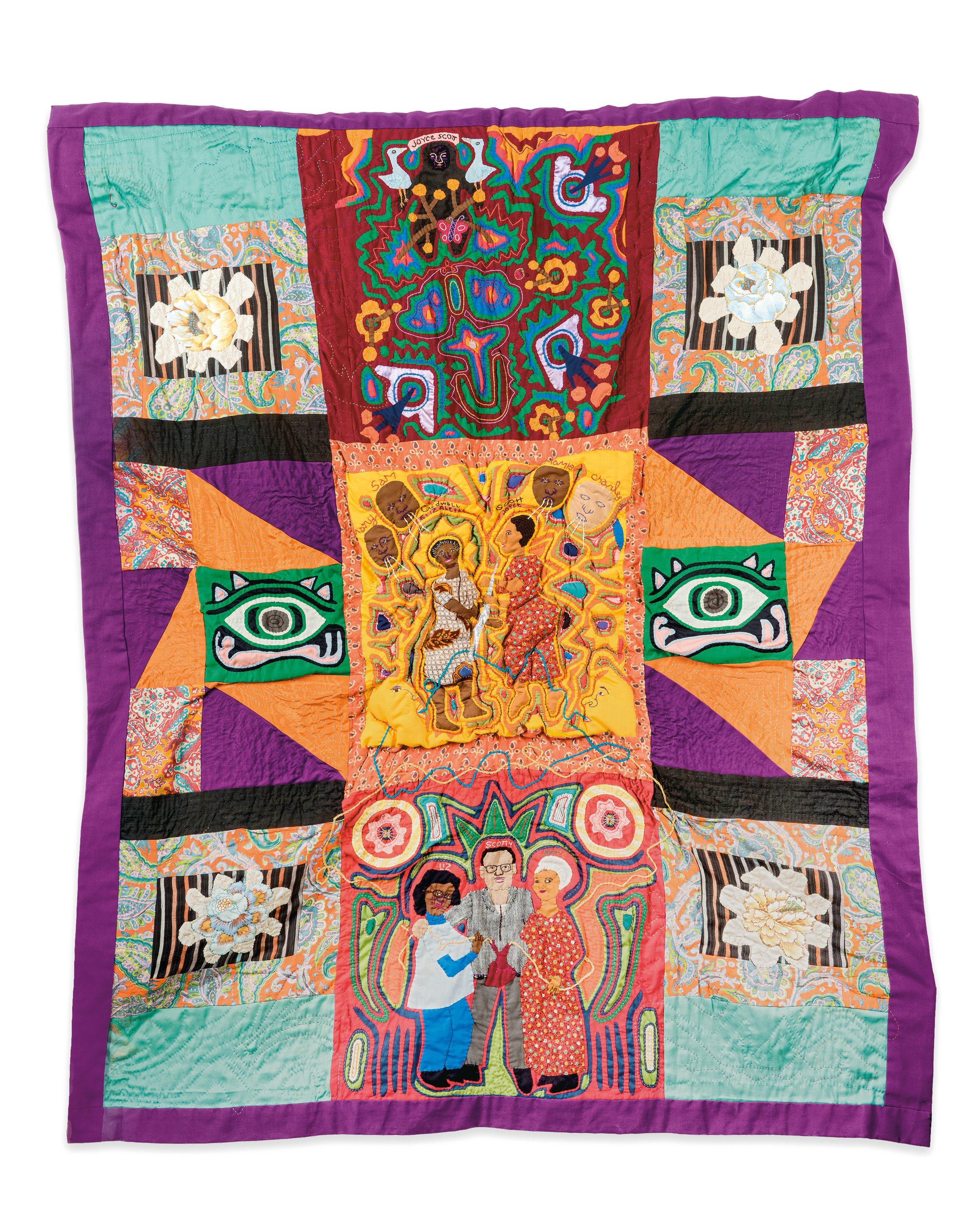
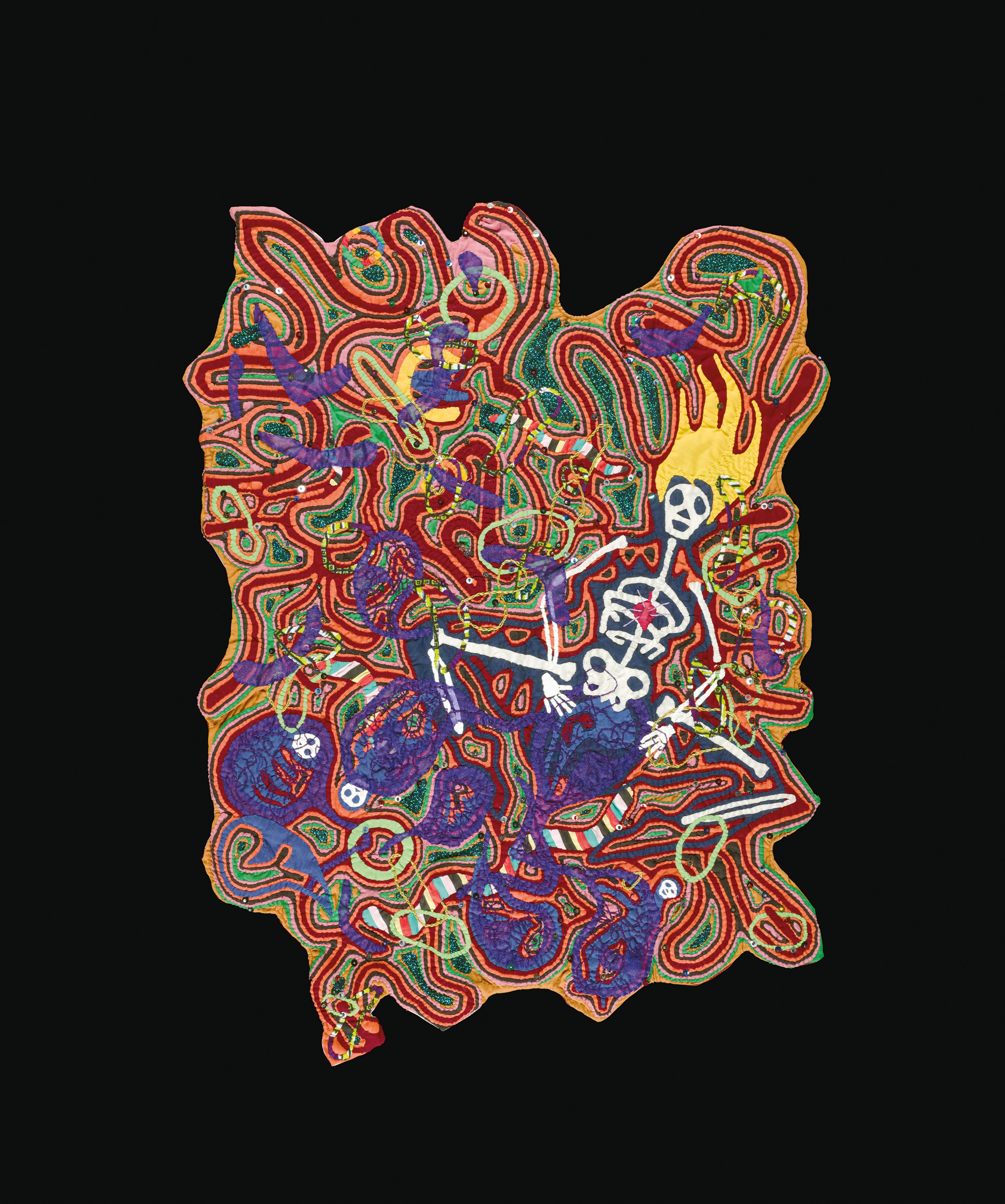








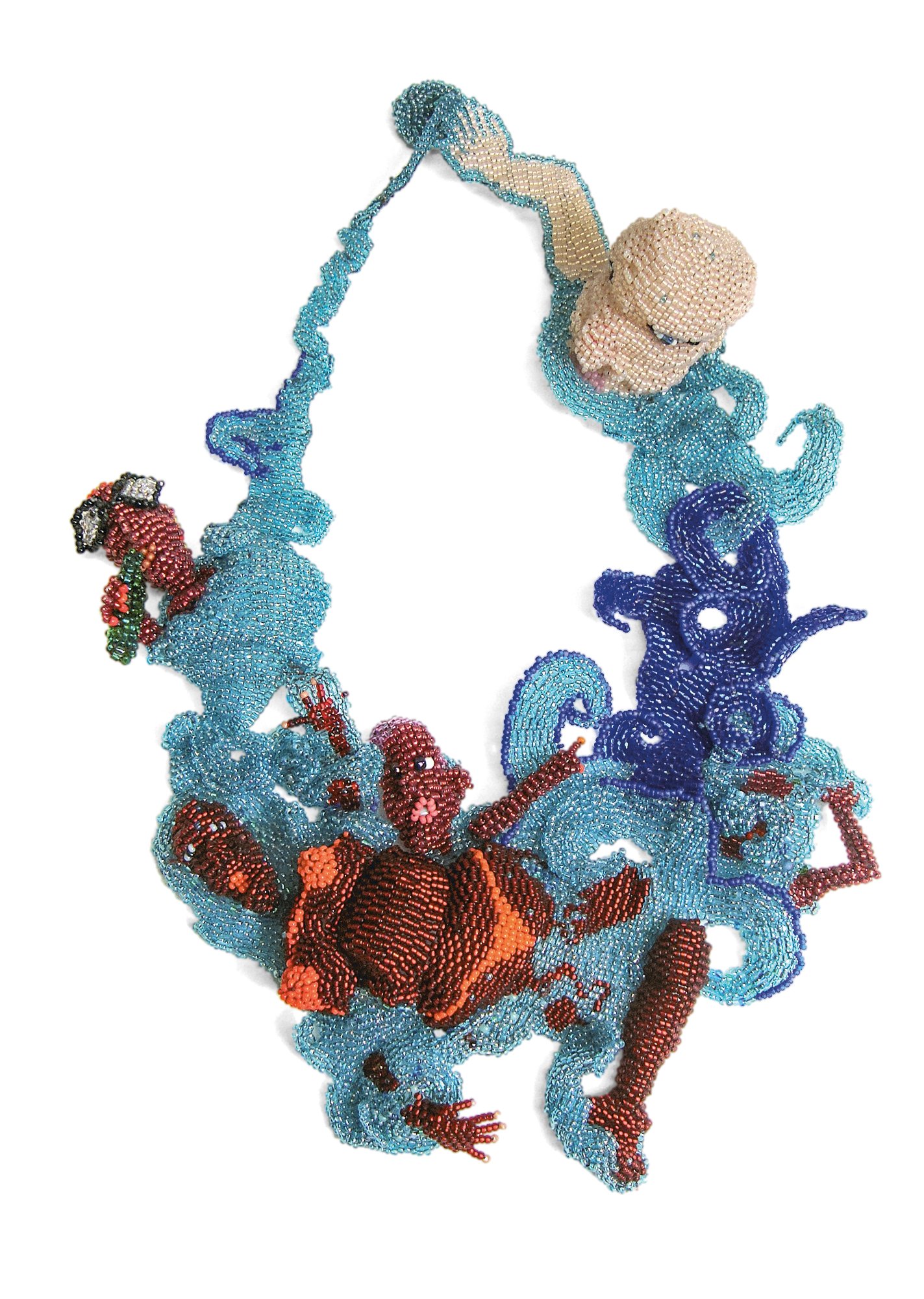



• A new large-scale commission titled The Threads That Unite My Seat to Knowledge (2024) that gathers heirloom family quilts to honor generations of makers in Scott’s family and create a storytelling environment within the exhibition.
• A fashion vignette featuring expressive garments Scott made for herself and friends beginning in the 1970s and sculptural necklaces such as What You Mean Jungle Music (1987) and Hunger (1991) that bridge performance and sculpture, showing how wearing difficult truths can incite conversations about social justice.
• Significant examples from iconic cycles of work reunited for the first time in many years, including Scott’s "Mammy/Nanny” series of the 1980s-90s; riffs on the watermelon trope such as Man Eating Watermelon (1986); and works from her “Still Funny” series that show Scott confronting American history and racial violence in the U.S. and abroad.
Joyce J. Scott performs Walk a Mile in My Drawers, Theatre Project, Baltimore, May 18-19, 2006. Image courtesy of Kel C. Millionie. Photo by Kel C. Millionie
• Ephemera and rare performance footage that bring to life Scott’s earliest performances with Robert Sherman (late 1970s); her legendary “Thunder Thigh Revue” act with Kay Lawal- Muhammad (1985-90); and solo theater pieces such as “Generic Interference/Genetic Engineering” (1988-95) and “Walk a Mile in My Drawers” (2006).
• A communal weaving area echoes Scott’s improvised performances from the 1970s and invites a new generation to discover this collaborative artform. The loom and tables will be periodically activated by Scott and other teaching artists with materials provided by Scrap B-More. Visitors may participate any time; completed works will be presented in the gallery then raffled with proceeds going to support a scholarship fund established by the artist at MICA.Joyce Scott
Joyce J. Scott. Mammie Wada. 1981. Baltimore Museum of Art: Gift of J.B. Hanson and Tom Haulk, Baltimore. © Joyce Scott courtesy Goya Contemporary, photo: Mitro Hood
“Joyce J. Scott’s sophisticated and virtuosic use of a wide range of materials brings beauty and biting irony to bear on subjects ranging from the traumatic to the joyous and transcendent,” said co-curators Wichmann and Manchanda. “Her intergenerational practice is radical in its commitment to community and place while building self-awareness and empathy. Those who already know Scott’s intimate and revelatory work will be astonished to see the many facets of her practice brought together—and those who encounter her work for the first time can expect to be blown away.”




Installation view of Joyce J. Scott: Walk a Mile in My Dreams at the Baltimore Museum of Art, March 2024. Photo by Mitro Hood.
Catalog
A fully illustrated 288-page catalog—co-published by SAM and BMA and distributed by Yale University Press—offers a critical resource that introduces the richness and complexity of Scott’s work through new scholarship, artist reflections, and a selection of vital out-of-print source materials. In addition to an introduction co-authored by Manchanda and Wichmann, the publication features two thematic interviews with the artist by Dr. Leslie King Hammond, Dean Emeritus of the Maryland Institute College of Art, and Valerie Cassel Oliver, Sydney and Frances Lewis Family Curator of Modern and Contemporary Art at the Virginia Museum of Fine Arts. Essays on key aspects of Scott’s work are contributed by scholars Tiffany E. Barber, Angela N. Carroll, Henry J. Drewal, Ashley Minner Jones, and Lowery Stokes Sims. A cross-generational group of artists—Oletha DeVane, Sonya Clark, Kay Lawal-Muhammad, Jeffrey Gibson, Malcolm Peacock, and William Rhodes—reflect on Scott’s influential role as artist, mentor, and educator. The out-of-print catalogue from Scott’s 30-year retrospective organized by guest curator George Ciscle at the BMA with students from MICA’s Exhibition Development Seminar remains a vital resource on Scott’s work and has been digitized and archived: artbma.org/kickinit

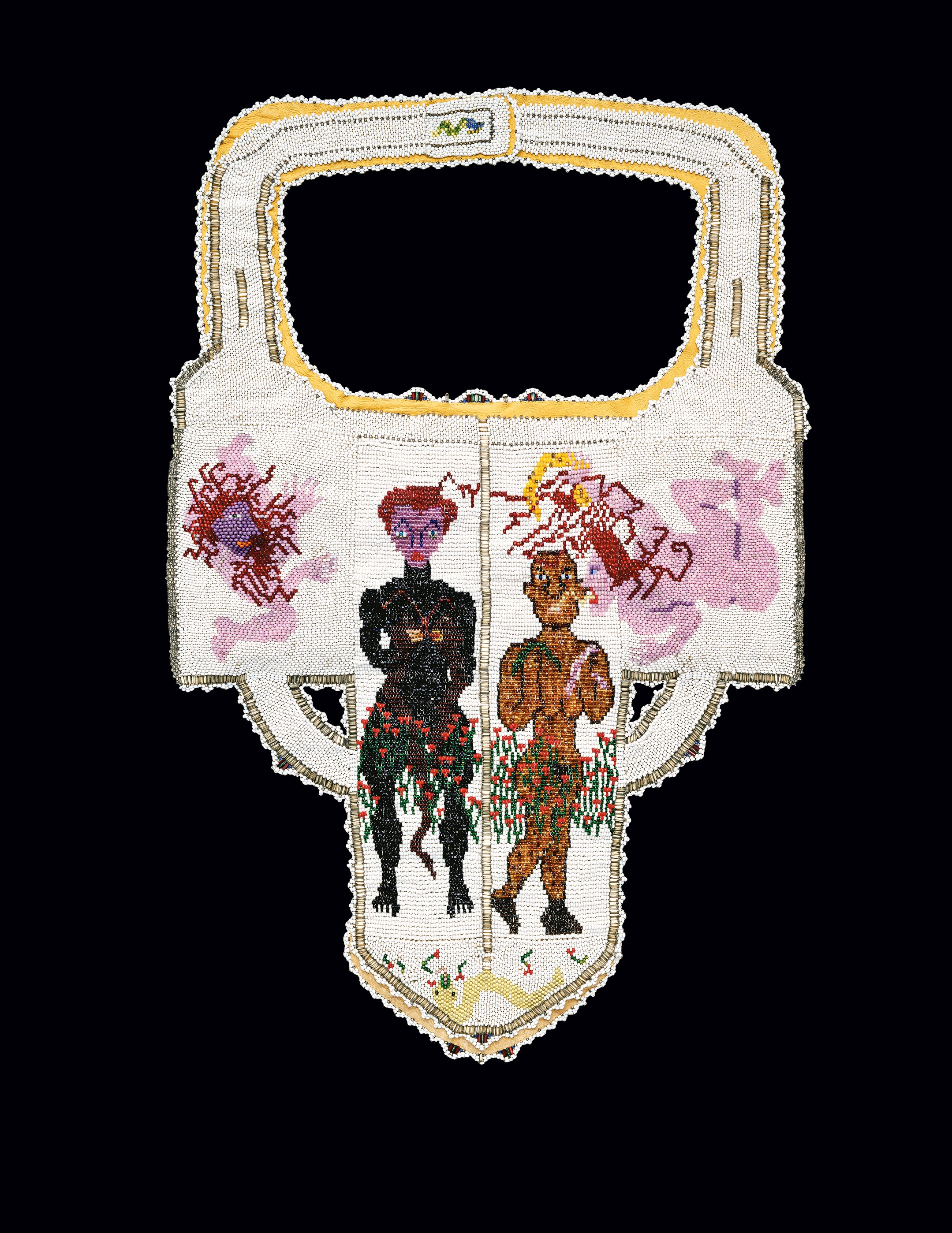


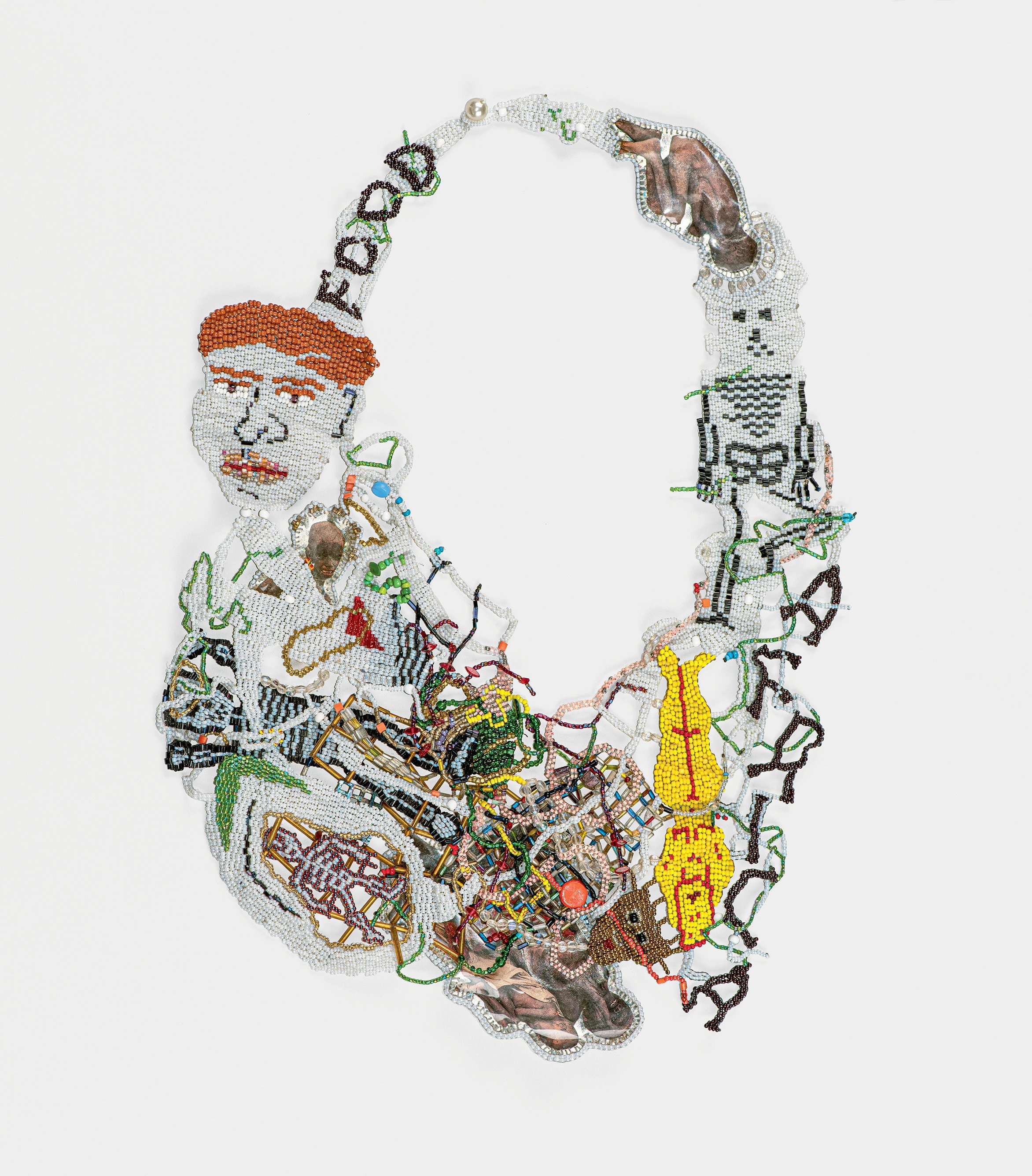
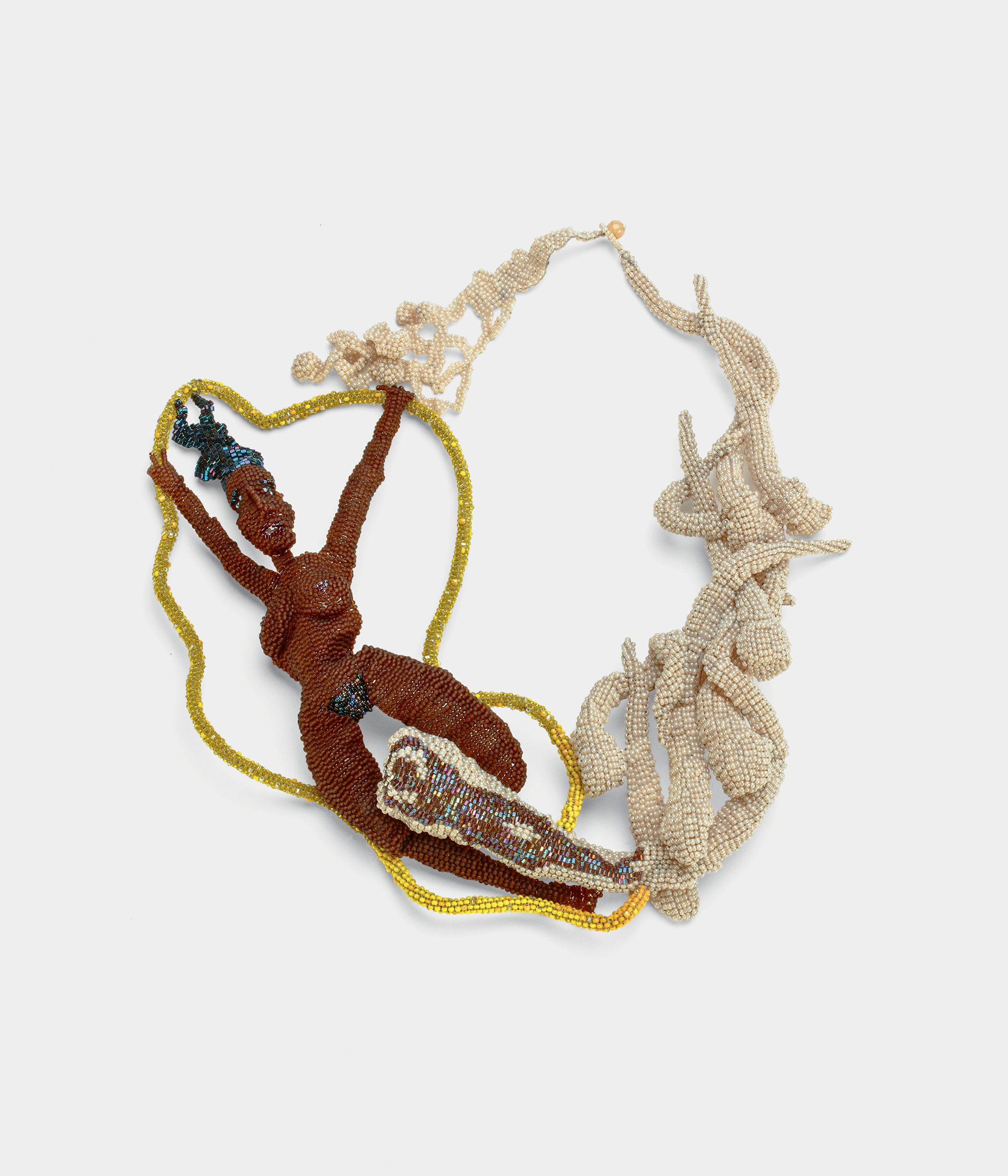

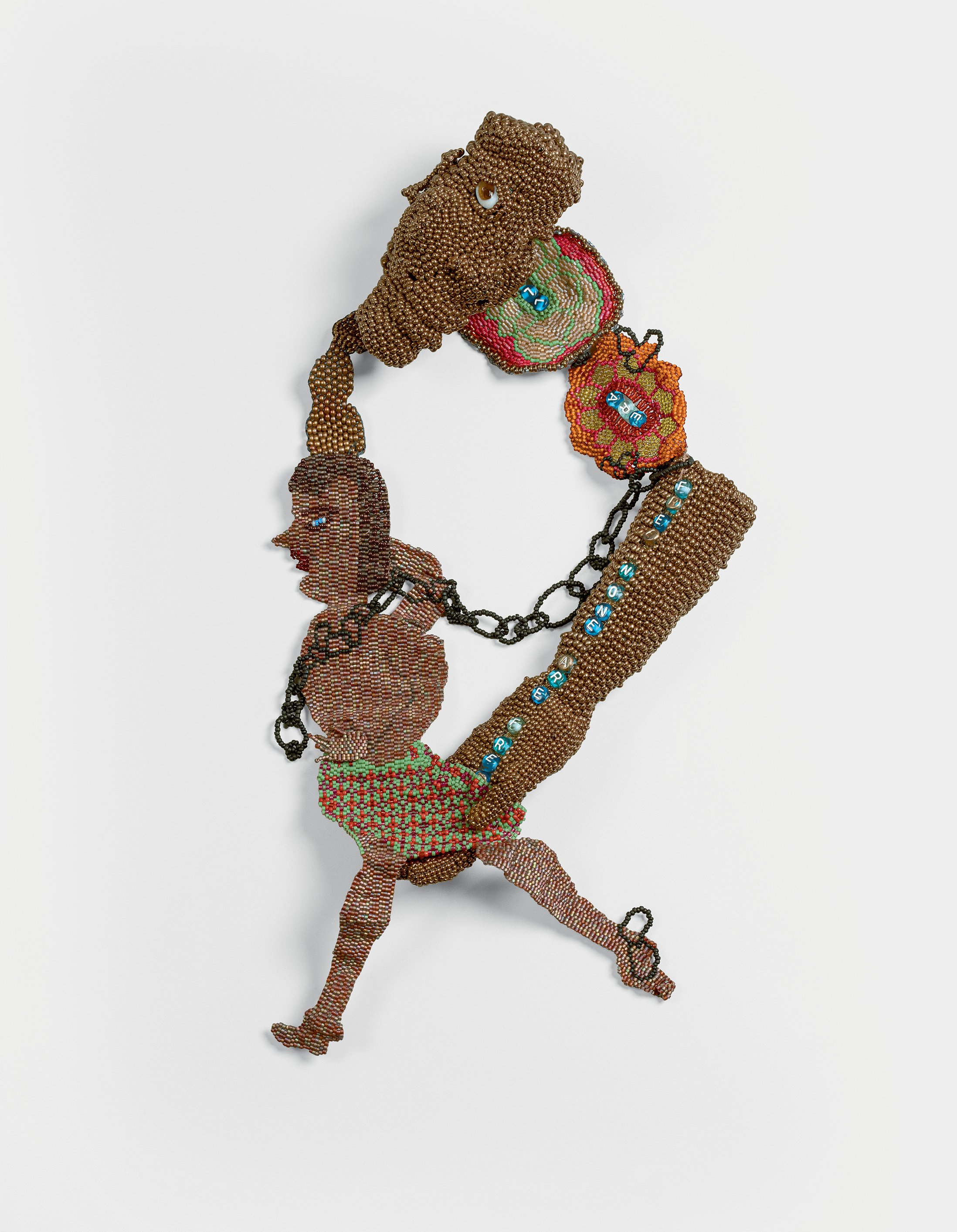



Sponsors
This exhibition and national tour are made possible by substantial grants from the Ford Foundation, Henry Luce Foundation, Terra Foundation for American Art, and The Andy Warhol Foundation for the Visual Arts. In Baltimore, the exhibition is also supported by the Alvin and Fanny B. Thalheimer Exhibition Endowment Fund, the Suzanne F. Cohen Exhibition Fund, Bank of America, Wagner Foundation, Joanne Gold and Andrew Stern, The Jacques and Natasha Gelman Foundation, Transamerica, the National Endowment for the Arts, the Clair Zamoiski Segal and Thomas H. Segal Contemporary Art Endowment Fund, Goya Contemporary Gallery and Martha Macks-Kahn, The Coby Foundation, Ltd., and the American Craft Council.
Courtesy of Joyce J. Scott
Joyce J. Scott
Joyce J. Scott (b. 1948, Baltimore, MD) earned her Bachelor of Fine Arts from the Maryland Institute College of Art and a Master of Fine Arts from the Instituto Allende in Mexico. In 2018, she was awarded an honorary fellowship from NYU, as well as honorary doctorates from both MICA and the California College of the Arts. In 2022, she was awarded an honorary doctorate from Johns Hopkins University. Her work has been the subject of numerous exhibitions, with major solo shows such as Joyce J. Scott: Harriet Tubman and Other Truths at Grounds for Sculpture, Hamilton, NJ (2018); Joyce J. Scott: Truths and Visions at the Museum of Contemporary Art, Cleveland (2015); Maryland to Murano: The Neckpieces & Sculpture of Joyce J. Scott at the Museum of Arts and Design, New York (2014-15); and Joyce J. Scott: Kickin’ It with the Old Masters at the BMA (2000). She has received commissions, grants, awards, residencies, and honors, including from MacArthur Foundation Fellowship (2016), Lifetime Achievement Award from the Women’s Caucus for the Arts, Anonymous Was a Woman, and Smithsonian Visionary Artist Award, among others. Scott’s work is also included in many public collections, including the BMA, Metropolitan Museum of Art, Brooklyn Museum of Art, Los Angeles County Museum of Art, National Museum of African American History and Culture, the Seattle Art Museum, and many others.
Baltimore Museum of Art
Founded in 1914, the Baltimore Museum of Art (BMA) inspires people of all ages and backgrounds through exhibitions, programs, and collections that tell an expansive story of art—challenging long-held narratives and embracing new voices. Our outstanding collection of more than 97,000 objects spans many eras and cultures and includes the world’s largest public holding of works by Henri Matisse; one of the nation’s finest collections of prints, drawings, and photographs; and a rapidly growing number of works by contemporary artists of diverse backgrounds. The museum is also distinguished by a neoclassical building designed by American architect John Russell Pope and two beautifully landscaped gardens featuring an array of modern and contemporary sculpture. The BMA is located three miles north of the Inner Harbor, adjacent to the main campus of Johns Hopkins University, and has a community branch at Lexington Market. General admission is free so that everyone can enjoy the power of art.
Visitor Information
General admission to the BMA is free. The BMA is open Wednesday through Sunday from 10 a.m. to 5 p.m., with extended hours on Thursdays until 9 p.m. The Sculpture Gardens are open Wednesday through Sunday, 10 a.m. to dusk. The museum and gardens are closed New Year’s Day, Juneteenth, July 4, Thanksgiving Day, and Christmas Day. The BMA is located at 10 Art Museum Drive, three miles north of Baltimore’s Inner Harbor. For general museum information, call 443-573-1700 or visit here.
For more information about this exhibition and other exhibitions at the Baltimore Museum of Art, please visit their site here. The museum can also be found on YouTube, Facebook, and Instagram.
Adam Pendleton: An Abstraction
Black Dada (A/A), 2024 silkscreen ink and black gesso on canvas, two parts 96" × 76" (243.8 cm × 193 cm) No. 91039
New York – Pace is pleased to present An Abstraction, an exhibition of recent paintings and drawings by New York- based artist Adam Pendleton, at its 540 West 25th Street gallery in New York. Pendleton’s first solo show at Pace’s New York gallery in ten years, An Abstraction follows a series of significant solo exhibitions by the artist at museums around the world, including the Museum of Modern Art in New York in 2021; the Montreal Museum of Fine Arts in 2022; and mumok - Museum Moderner Kunst Stiftung Ludwig Wien, Vienna in 2023. The return to his home city marks a continuation of his career-long project of creating spaces of engagement and “fighting for the right to exist in and through abstraction.”
Pendleton’s work indexes and documents the physical process of painting to create layered pictorial fields that—in their painterly, psychic, and verbal expressions—announce a new mode of visual composition for the 21st century. He is guided by a visual and structural philosophy he has termed “Black Dada,” an ongoing inquiry into Blackness and its relationship to abstraction and conceptions of the avant-garde. Investigating Blackness as a color and theoretical proposition, the artist’s work reflects a contrapuntal understanding of the world in both sensorial and conceptual terms.
Black Dada (B), 2024 silkscreen ink and black gesso on canvas, two parts 96" × 76" (243.8 cm × 193 cm) No. 91041
In An Abstraction, the artist’s 12 paintings and 13 drawings will hang within a monumental, site-specific architecture consisting of five black triangular forms. These sculptural walls will reorder the gallery into new, unexpected spaces and extend the visual language of the exhibited works.
Bringing together the artist’s Black Dada and Untitled (Days) bodies of work, the new paintings and drawings in the exhibition feature a variety of marks—spray painting, stenciled geometric forms, and expressionistic brushstrokes— to blur distinctions between painting, drawing, and photography and propose painting as a documentary and performative act.
Pendleton’s new Black Dada works imbue his iconic black and white compositions with focused and saturated colors. Each of the paintings and drawings in this body of work bears one or more typographic letters from the phrase “BLACK DADA,” rendered in a sans serif font amid the artist’s gestural marks. Continually transposing and overwriting these two modes of inscription, Pendleton cultivates a living library of his own ever-evolving gestures and processes.
Black Dada (K), 2024 silkscreen ink and black gesso on canvas, two parts 96" × 76" (243.8 cm × 193 cm) No. 91042
Paintings and drawings from Pendleton’s Untitled (Days) body of work will also be featured in An Abstraction. Using collagist strategies of indexing, daily mark-making, fragmentation, and recombination, these works create a cumulative portrait of the artist’s experimentations in the studio.
In spring 2025, the Hirshhorn Museum and Sculpture Garden in Washington, D.C. will present Love, Queen, a landmark exhibition of Pendleton’s work that will anchor the institution’s 50th anniversary year.


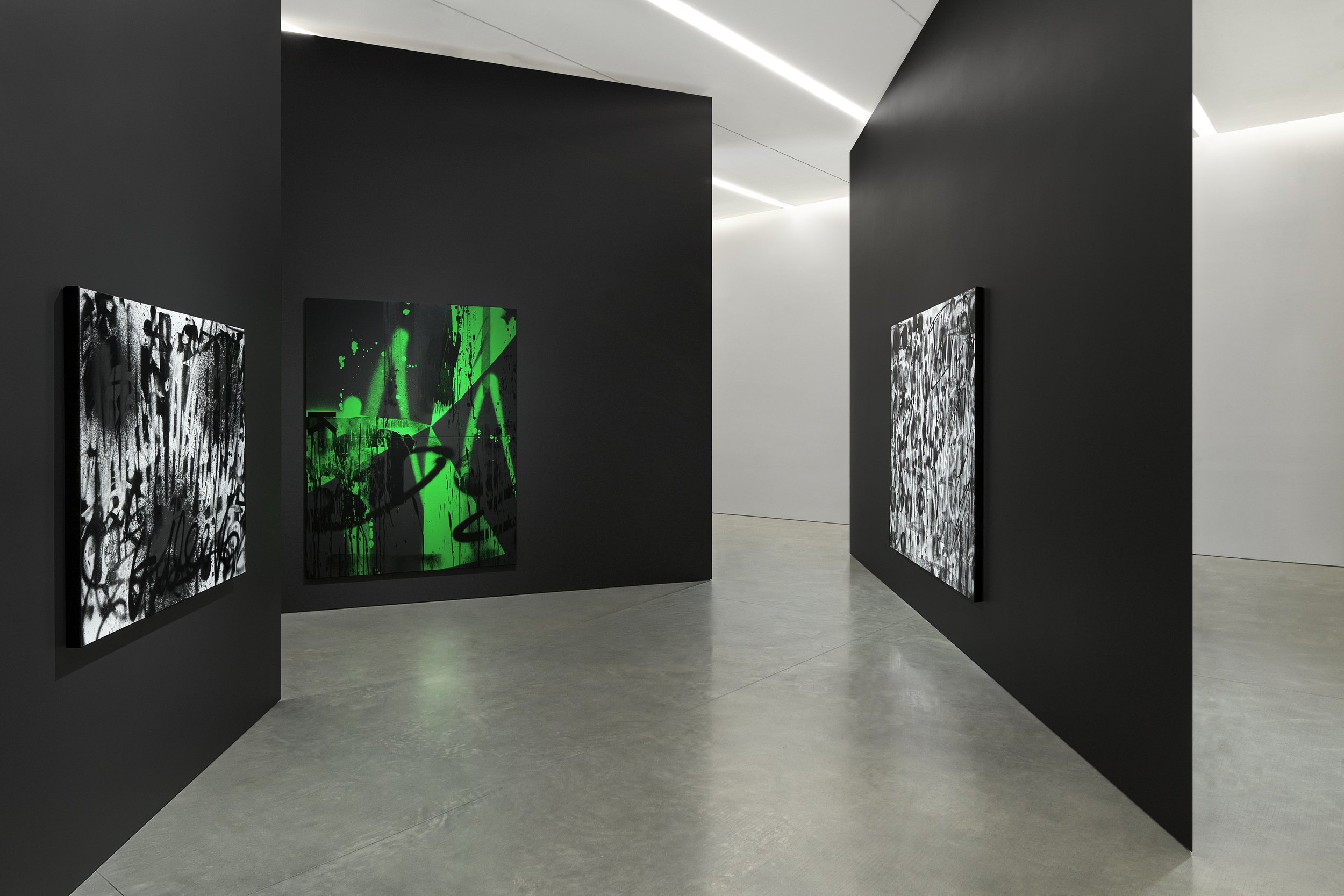

Adam Pendleton: An Abstraction 540 West 25th Street, New York, NY 10001 May 3 – August 16, 2024 Photography courtesy Pace Gallery
Born in Richmond, Virginia in 1984, Adam Pendleton completed the Artspace Independent Study Program in Pietrasanta, Italy, in 2002. His work has been featured at major museums around the world, including solo exhibitions at the Baltimore Museum of Art; Le Consortium, Dijon, France; Isabella Stewart Gardner Museum, Boston; KW Institute for Contemporary Art, Berlin; Museum of Contemporary Art Cleveland; and Museum of Contemporary Art Denver, among others. Recent solo and group exhibitions include Adam Pendleton: Who is Queen? (2021–22) at the Museum of Modern Art, New York; Adam Pendleton: These Things We’ve Done Together (2021–22) at the Montreal Museum of Fine Arts; Biennial: Quiet as It’s Kept (2022) at the Whitney Museum of American Art, New York; Adam Pendleton: Blackness, White and Light (2023–24) at the mumok - Museum Moderner Kunst Stiftung Ludwig Wien, Vienna; and Adam Pendleton: To Divide By (2023–24) at the Mildred Lane Kemper Art Museum, St. Louis.
Black Dada Drawing (L), 2024 silkscreen ink on paper in artist's frame 38" × 30-3/8" (96.5 cm × 77.2 cm) No. 91798
His work is in numerous public collections, including the Museum of Modern Art, New York; the Whitney Museum of American Art, New York; the Solomon R. Guggenheim Museum, New York; the Studio Museum in Harlem, New York; the Carnegie Museum of Art, Pittsburgh; the Museum of Contemporary Art Chicago; the Museum of Contemporary Art San Diego; and Tate, London.
Pace is a leading international art gallery representing some of the most influential contemporary artists and estates from the past century, holding decades-long relationships with Alexander Calder, Jean Dubuffet, Barbara Hepworth, Agnes Martin, Louise Nevelson, and Mark Rothko. Pace enjoys a unique U.S. heritage spanning East and West coasts through its early support of artists central to the Abstract Expressionist and Light and Space movements.
Since its founding by Arne Glimcher in 1960, Pace has developed a distinguished legacy as an artist-first gallery that mounts seminal historical and contemporary exhibitions. Under the current leadership of CEO Marc Glimcher, Pace continues to support its artists and share their visionary work with audiences worldwide by remaining at the forefront of innovation. Now in its seventh decade, the gallery advances its mission through a robust global program— comprising exhibitions, artist projects, public installations, institutional collaborations, performances, and interdisciplinary projects. Pace has a legacy in art bookmaking and has published over five hundred titles in close collaboration with artists, with a focus on original scholarship and on introducing new voices to the art historical canon.
Today, Pace has seven locations worldwide, including European footholds in London and Geneva as well as Berlin, where the gallery established an office in 2023. Pace maintains two galleries in New York—its headquarters at 540 West 25th Street, which welcomed almost 120,000 visitors and programmed 20 shows in its first six months, and an adjacent 8,000 sq. ft. exhibition space at 510 West 25th Street. Pace’s long and pioneering history in California includes a gallery in Palo Alto, which was open from 2016 to 2022. Pace’s engagement with Silicon Valley’s technology industry has had a lasting impact on the gallery at a global level, accelerating its initiatives connecting art and technology as well as its work with experiential artists. Pace consolidated its West Coast activity through its flagship in Los Angeles, which opened in 2022. Pace was one of the first international galleries to establish outposts in Asia, where it operates permanent gallery spaces in Hong Kong and Seoul, along with an office and viewing room in Beijing. In spring 2024, Pace will open its first gallery space in Japan in Tokyo’s new Azabudai Hills development.
The exhibition opened on May 3 and will be on view until August 16 2024 at Pace Gallery 510 West 25th Street in New York. For more information about this exhibition and others, please visit the Pace Gallery’s website here. Pace Gallery can be found on Instagram and Artsy, too.
teamLab: The World of Irreversible Change
teamLab: The World of Irreversible Change 510 West 25th Street, New York, NY 10001 May 10 – August 16, 2024 Photography courtesy Pace Gallery
New York – Pace is pleased to present an exhibition by teamLab at its 510 West 25th Street gallery in New York. Which opened on May 10 and will be on view until August 16, the show spotlights a single interactive digital artwork—titled The World of Irreversible Change—projected on a wall in the gallery. This presentation marks teamLab’s first solo exhibition in New York in ten years.
Founded by Toshiyuki Inoko in Tokyo in 2001, teamLab is an international collective of artists, programmers, engineers, CG animators, mathematicians, and architects. Known for its multisensory, immersive work, teamLab explores the relationships between humans and the world, encouraging new modes of perception through its pioneering, technologically advanced installations. In recent years, teamLab has presented solo exhibitions at the Asian Art Museum in San Francisco; Amos Rex in Helsinki; TANK Shanghai; and many other institutions and venues around the world.
The exhibition at Pace in New York, The World of Irreversible Change is projected on a large, freestanding, black-painted wall in a darkened gallery space. First presented by the collective in spring 2022 at the Aomori Museum of Art in Japan, this screen-based work, created by teamLab over five years, has never before been exhibited as a projection. Conceptually, The World of Irreversible Change centers on everyday life in an anonymous city during an unspecified epoch. Animated figures move throughout the panoramic village scene, which will change with the time of day and weather in New York. Scenery and stories will unfold each day, and the lives of the people in the city will continue eternally unless gallery visitors interact with the work, causing permanent disruption.
teamLab: The World of Irreversible Change 510 West 25th Street, New York, NY 10001 May 10 – August 16, 2024 Photography courtesy Pace Gallery
Over the course of its exhibition at Pace, The World of Irreversible Change can transform as a result of viewers’ engagement with it. If visitors continue to intervene with the work during its three-month presentation, the scenes of daily life will become increasingly agitated and chaotic, with fighting between individuals escalating into an all-out war. Peace and harmony will give way to fire and destruction, a devolution that speaks to the inherency and universality of violence in the human experience. The city will become forever devoid of people, while plants will begin populating its streets and ruins over time.
“In the ruined city where not a single person remains, the seasons still pass and the sun rises and sets with the time of the real world,” teamLab writes in a statement on The World of Irreversible Change. “After a while, new flora begin to grow in the burnt ruins of the city. The flora grow, bloom, and scatter repeatedly, changing daily with the real passage of time ... Once the world of this artwork begins to burn, the world from before can never be returned to. The people who interact with the artwork cause this outcome.”
Along with its forthcoming presentation of The World of Irreversible Change at Pace’s New York gallery, teamLab will present an interactive installation as part of Art@Harbour 2024 in Hong Kong, running from March 25 to June 2. The collective also recently established teamLab Borderless, a permanent museum of over 70 digital works presented as one continuous world within a multi-room exhibition space, in Tokyo’s Azabudai Hills development, which is also home to Pace’s new gallery in the Japanese capital, opening this summer. Following Tokyo, teamLab Borderless will open in Jeddah, Saudi Arabia and Hamburg, Germany, and teamLab is also preparing to open a massive 17,000 square-meter (nearly 183,000 square-feet) experiential art space in Abu Dhabi. Later this year, teamLab’s annual exhibition in the ancient forest of Mifuneyama Rakuen in Kyushu, Japan will take place for the tenth year.
Last year, in December 2023, the collective’s museum teamLab Planets Tokyo was ranked fifth on Google’s “Year in Search,” measured by activity on Google Maps.
teamLab, The World of Irreversible Change, 2024, © teamLab, courtesy Pace Gallery
teamLab (f. 2001) is an international art collective, an interdisciplinary group of various specialists such as artists, programmers, engineers, CG animators, mathematicians and architects whose collaborative practice seeks to navigate the confluence of art, science, technology, and the natural world.
teamLab aims to explore the relationship between the self and the world and new perceptions through art. In order to understand the world around them, people separate it into independent entities with perceived boundaries between them. teamLab seeks to transcend these boundaries in our perception of the world, of the relationship between the self and the world, and of the continuity of time. Everything exists in a long, fragile yet miraculous, borderless continuity of life.
teamLab’s works are in the permanent collection of Amos Rex, Helsinki; Art Gallery of New South Wales, Sydney; Art Gallery of South Australia, Adelaide; Asia Society Museum, New York; Asian Art Museum, San Francisco; Borusan Contemporary Art Collection, Istanbul; Museum of Contemporary Art, Los Angeles; and National Gallery of Victoria, Melbourne.
Pace is a leading international art gallery representing some of the most influential contemporary artists and estates from the past century, holding decades-long relationships with Alexander Calder, Jean Dubuffet, Barbara Hepworth, Agnes Martin, Louise Nevelson, and Mark Rothko. Pace enjoys a unique U.S. heritage spanning East and West coasts through its early support of artists central to the Abstract Expressionist and Light and Space movements.
Since its founding by Arne Glimcher in 1960, Pace has developed a distinguished legacy as an artist-first gallery that mounts seminal historical and contemporary exhibitions. Under the current leadership of CEO Marc Glimcher, Pace continues to support its artists and share their visionary work with audiences worldwide by remaining at the forefront of innovation. Now in its seventh decade, the gallery advances its mission through a robust global program— comprising exhibitions, artist projects, public installations, institutional collaborations, performances, and interdisciplinary projects. Pace has a legacy in art bookmaking and has published over five hundred titles in close collaboration with artists, with a focus on original scholarship and on introducing new voices to the art historical canon.
Today, Pace has seven locations worldwide, including European footholds in London and Geneva as well as Berlin, where the gallery established an office in 2023. Pace maintains two galleries in New York—its headquarters at 540 West 25th Street, which welcomed almost 120,000 visitors and programmed 20 shows in its first six months, and an adjacent 8,000 sq. ft. exhibition space at 510 West 25th Street. Pace’s long and pioneering history in California includes a gallery in Palo Alto, which was open from 2016 to 2022. Pace’s engagement with Silicon Valley’s technology industry has had a lasting impact on the gallery at a global level, accelerating its initiatives connecting art and technology as well as its work with experiential artists. Pace consolidated its West Coast activity through its flagship in Los Angeles, which opened in 2022. Pace was one of the first international galleries to establish outposts in Asia, where it operates permanent gallery spaces in Hong Kong and Seoul, along with an office and viewing room in Beijing. In spring 2024, Pace will open its first gallery space in Japan in Tokyo’s new Azabudai Hills development.
This exhibition opened on May 10 and will be on view until August 16, 2024, at Pace Gallery 510 West 25th Street in New York. For more information about this exhibition and others, please visit the Pace Gallery’s website here. Pace Gallery can be found on Instagram and Artsy, too.
Alicja Kwade and Agnes Martin: Space Between the Lines
Alicja Kwade and Agnes Martin: Space Between the Lines 1201 South La Brea Avenue, Los Angeles, CA 90019 May 18 – June 29, 2024 Photography by Jeff McLane, courtesy Pace Gallery
Los Angeles – Pace is pleased to present a two-artist exhibition of work by Alicja Kwade and Agnes Martin—co- curated by Kwade and Arne Glimcher, the gallery’s founder—at its Los Angeles space. On view from May 18 to June 29, this show will place works by Kwade, including two new large-scale sculptures, in dialogue with a selection of paintings and works on paper by Martin. This will be Kwade’s first significant presentation of new work in Los Angeles and her first major exhibition with Pace since joining the gallery in 2023.
Kwade is known internationally for sculptures, large-scale public installations, films, photographs, and works on paper that engage poetically and critically with scientific and philosophical concepts. Through a distinctive vocabulary encompassing reflection, repetition, and the manipulation of everyday objects and natural materials, the artist raises questions about structures and systems that govern and shape our daily lives. In her contemplative works, which dismantle boundaries of perception, she challenges commonly accepted ideas and beliefs while proposing new modes of seeing and understanding reality.
Alicja Kwade and Agnes Martin: Space Between the Lines 1201 South La Brea Avenue, Los Angeles, CA 90019 May 18 – June 29, 2024 Photography by Jeff McLane, courtesy Pace Gallery
The result of a longstanding conversation that Kwade has undertaken with Glimcher around the work of Agnes Martin, who was a close friend of Glimcher and whom he has represented since 1974, the exhibition at Pace’s LA gallery centers on the affinities and intersections between Kwade’s artistic concerns and those of Martin. Although separated by generations, several threads run through both artists’ practices—in particular, their focus on time and temporality as an organizing principle of perceptual experience. These artists also share a fascination with the relationship between truth and beauty. While Kwade’s work is often grounded by a conceptual armature, Martin sought to express a transcendental quietude and purity through painting. For both artists, ordered, mathematical systems, often expressed through their use of line, are integral to their approaches to artmaking. On a formal level, enactments of balance, negotiations of symmetry and non-symmetry, and explorations of liminal, in-between spaces cut across their works.
Alicja Kwade and Agnes Martin: Space Between the Lines 1201 South La Brea Avenue, Los Angeles, CA 90019 May 18 – June 29, 2024 Photography by Jeff McLane, courtesy Pace Gallery
“For some time, I have been interested in a dialogue between Agnes Martin’s paintings and the sculptures of Alicja Kwade,” Glimcher says of the exhibition, “Both artists have been involved in the possibilities of line, both bring a meditative sensibility, and both are interested in questions of time. Both make works that reveal themselves slowly, with time. I have always felt Agnes’s work is closer to music than it is to traditional painting, and with Alicja, there is a parallel sense of adjacency with other modes of perception.”
Two new large-scaled sculptures by Kwade—which are related to her ParaPivot series—will anchor the exhibition. In these works, titled Distorted Dream (2024) and Distorted Day (2024), carved stone orbs appear to float within a framework of polished steel plates and powder-coated steel frames, which intersect at oblique angles. Reflecting her interest in ancient astronomy, Kwade’s ParaPivot sculptures suggest imagined solar systems realized in miniature, in which steel supports chart the orbital pathways of planetary bodies. Meanwhile, the artist’s large-scale Jo’s snow (2023) sculptures, which consist of sculpted marble forms that naturalistically resemble piles of partially melted snow, will be on view in the gallery’s courtyard, installed across the grassy outdoor space.
Alicja Kwade and Agnes Martin: Space Between the Lines 1201 South La Brea Avenue, Los Angeles, CA 90019 May 18 – June 29, 2024 Photography by Jeff McLane, courtesy Pace Gallery
Highlights in the exhibition also include Martin’s painting, The Sea (2003), the only entirely black painting the artist ever made. In this composition, which Martin produced a year before her death, minutely incised horizontal lines of equal weights are painstakingly carved into the painted surface, producing a humming, vibratory effect reminiscent of flowing water. But Martin’s painting is in no way representational—she was interested, instead, in marking time in her work, creating material and durational encounters between her own body and the canvas. Like Kwade’s sculptures— whose open voids produce shifting views of Martin’s painting as viewers circumnavigate the gallery space—this painting, like the other works of Martin included in the exhibition, celebrates art’s phenomenological and perceptual powers.
Pace's exhibition in LA coincides with Kwade’s solo presentation at the Voorlinden Museum in the Netherlands, running through June 9. Among other recent presentations around the world, her work figured in the 2022 edition of Desert X AlUla in Saudi Arabia and the 57th Venice Biennale, Viva Arte Viva, in 2017.
Alicja Kwade and Agnes Martin: Space Between the Lines 1201 South La Brea Avenue, Los Angeles, CA 90019 May 18 – June 29, 2024 Photography by Jeff McLane, courtesy Pace Gallery
Alicja Kwade (b. 1979, Katowice, Poland) investigates and questions universally accepted notions of space, time, science, and philosophy by breaking down frames of perception in her work. Kwade’s multifaceted practice spans sculpture, installation, video, and photography. She utilizes quotidian and found objects such as rocks, mirrors, lamps, and clocks to explore profound ideas about the fabric of reality. Kwade’s use of elements such as copper, iron, human-made plastics, and recycled materials reflects her interest in both physics and chemistry, using art to bring core concepts together and examine the phenomena of the physical world. Her works often utilize the alchemical properties of her chosen materials to reveal the nature of the systems we use to understand the world, such as marking time and uncovering the origins of the universe, distilling complex ideas through form, material, and composition. Through her practice, Kwade examines planetary systems, molecular compositions, and mathematical frameworks, challenging conventional modes of thinking and exploring both the physical and metaphysical. While her work is often associated with Minimalism, Kwade approaches her practice with an eye toward Conceptual art.
Important exhibitions of Kwade’s work include Alicja Kwade: Von Explosionen zu Ikonen Piepenbrock Förderpreis für Skulptur 2008 WerkRaum. 25, Hamburger Bahnhof, Museum für Gegenwart, Berlin (2008); Alicja Kwade: Probleme massereicher Körper, Westfälischer Kunstverein, Münster, Germany (2010); Alicja Kwade: Monolog aus dem 11ten Stock, Haus am Waldsee, Berlin (2015); Alicja Kwade: Warten auf Gegenwart, Kunstmuseum St. Gallen, Switzerland (2014), which traveled to Kunsthalle Nürnberg, Germany (2015); Perception is Reality - Über die Abbildung von Wirklichkeit und Virtuellen Welten, Frankfurter Kunstverein, Germany (2017); Alicja Kwade: Out of Ousia, Kunsthal Charlottenborg, Copenhagen (2018); Alicja Kwade: “Being...”, Neuer Berliner Kunstverein, Berlin (2018); Alicja Kwade: LinienLand, Museum Haus Konstruktiv, Zurich (2018); Alicja Kwade: Kausalkonsequenz, Langen Foundation, Neuss, Germany (2020); Alicja Kwade: In Abwesenheit / In Absence, Berlinische Galerie – Landesmuseum für Moderne Kunst, Berlin (2021); Alicja Kwade: Au Cours Des Mondes, Place Vendôme, Paris (2022). In 2017, she participated in Viva Arte Viva, which was curated by Christine Macel at the 57th Venice Biennale. In 2019, The Metropolitan Museum of Art commissioned her to create ParaPivot, which was on view at the roof garden through October of that year. Her work is held in numerous public collections worldwide, including Centre Pompidou, Paris; Kunsthalle Mannheim, Germany; Los Angeles County Museum of Art; Louisiana Museum of Modern Art, Humlebæk, Denmark; and Wroclaw Contemporary Museum, Poland. Kwade lives and works in Berlin.
Agnes Martin (b. 1912, Macklin, Saskatchewan, Canada; d. 2004, Taos, New Mexico), one of the most influential painters of her generation, left an indelible mark on the history of modern and contemporary art. Growing up in western Canada, she moved between New Mexico and New York throughout her early career. For a pivotal decade starting in 1957, Martin lived and worked in Coenties Slip, a neighborhood in lower Manhattan she shared with emerging artists including Ellsworth Kelly, before returning to New Mexico in 1968. Inspired by the transcendent qualities of paintings by Mark Rothko and Ad Reinhardt, Martin considered herself to be an Abstract Expressionist. Nonetheless, her oeuvre played a critical role in heralding the advent of Minimalism, influencing, among others, Eva Hesse’s sculptural practice and Sol LeWitt’s wall drawings. Characterized by austere lines and grids superimposed upon muted grounds of color, Martin’s paintings elegantly negotiate the confines of structure and space, draftsmanship, and the metaphysical.
Pace is a leading international art gallery representing some of the most influential contemporary artists and estates from the past century, holding decades-long relationships with Alexander Calder, Jean Dubuffet, Barbara Hepworth, Agnes Martin, Louise Nevelson, and Mark Rothko. Pace enjoys a unique U.S. heritage spanning East and West coasts through its early support of artists central to the Abstract Expressionist and Light and Space movements.
Since its founding by Arne Glimcher in 1960, Pace has developed a distinguished legacy as an artist-first gallery that mounts seminal historical and contemporary exhibitions. Under the current leadership of CEO Marc Glimcher, Pace continues to support its artists and share their visionary work with audiences worldwide by remaining at the forefront of innovation. Now in its seventh decade, the gallery advances its mission through a robust global program— comprising exhibitions, artist projects, public installations, institutional collaborations, performances, and interdisciplinary projects. Pace has a legacy in art bookmaking and has published over five hundred titles in close collaboration with artists, with a focus on original scholarship and on introducing new voices to the art historical canon.
Today, Pace has seven locations worldwide, including European footholds in London and Geneva as well as Berlin, where the gallery established an office in 2023. Pace maintains two galleries in New York—its headquarters at 540 West 25th Street, which welcomed almost 120,000 visitors and programmed 20 shows in its first six months, and an adjacent 8,000 sq. ft. exhibition space at 510 West 25th Street. Pace’s long and pioneering history in California includes a gallery in Palo Alto, which was open from 2016 to 2022. Pace’s engagement with Silicon Valley’s technology industry has had a lasting impact on the gallery at a global level, accelerating its initiatives connecting art and technology as well as its work with experiential artists. Pace consolidated its West Coast activity through its flagship in Los Angeles, which opened in 2022. Pace was one of the first international galleries to establish outposts in Asia, where it operates permanent gallery spaces in Hong Kong and Seoul, along with an office and viewing room in Beijing. In 2024, Pace will open its first gallery space in Japan in Tokyo’s new Azabudai Hills development.
This exhibition opened on May 18th at 1201 S La Brea Ave Los Angeles and will close on June 29, 2024. For more information about this exhibition and others, please visit the Pace Gallery’s website here. Pace Gallery can be found on Instagram and Artsy, too.
Michaël Borremans : The Monkey
Michaël Borremans The Monkey, 2023 Oil on canvas © Michaël Borremans Courtesy the artist and David Zwirner
David Zwirner is pleased to announce The Monkey, an exhibition of new paintings by Belgian artist Michaël Borremans, taking place at the gallery’s London location. In these works, Borremans continues to explore surface and artifice in his careful consideration of mise-en-scène, combining technical mastery with subject matter that defies straightforward interpretation to create works that are simultaneously humorous and unnerving, familiar and enigmatic. This will be Borremans’s eighth solo exhibition with the gallery and his second at David Zwirner London.
The title of the exhibition is taken from several new portrait paintings that depict the eponymous primate, who is shown in these works from the shoulders up, adorned in blue and gold regalia. The portraits invoke The Monkey Painter (1739/1740) by the great eighteenth-century French painter Jean Siméon Chardin, showing a simian in painter’s garb at work on a canvas. Borremans’s monkey, as the artist noted in a recent interview with director Luca Guadagnino, “is a self-portrait” but “not just a self-portrait.” Rather, the artist said, “It’s a universal version of the portrait of the painter, the figure of the artist.”1
Installation view, Michaël Borremans, The Monkey, David Zwirner, London, 2024. Courtesy David Zwirner
While Chardin’s famous work appears to have been based on an actual monkey, the dull gaze and softly blurred and glossy features of Borremans’s monkey reveals that the subject of his portraits is not a live animal but a small, glazed sculptural figurine. Borremans created these works by meticulous application of layer upon layer of translucent oil paint, giving the monkeys a quality of timelessness and depth that parallels the sculptural nature of the shiny figurine. At the same time, cast within the format and traditional associations of the portraiture genre, the monkey appears discomfitingly sentient. Reflecting on these qualities in a recent essay that will appear in a new publication by David Zwirner Books, writer Katya Tylevich notes: “The artist loves a dry laugh mixed with the somber medium of oil on canvas. In The Monkey, however, the joke comes wrapped in razor blades. This body of work feels sharp and dangerous. The laugh more acidic.”2
Another work, also titled The Monkey (2023) but portraying a young man in three-quarter profile gazing out toward the frame, reinforces the fluid, conceptual, and ambiguous nature of these paintings. Like the monkey figurine, his hard, round helmet reflects gleaming light off its smooth surface, complicating any literal reading of the human subjects as animate and the monkey sculptures as inanimate. In several other portraits of human figures, Borremans paints his subjects in costumes that have appeared in previous bodies of works—lustrous hooded puffer jackets, which seemingly place them in our present day, or in the future, though little is revealed about the setting in which they are shown.
Michaël Borremans The Talent, 2023 Oil on canvas © Michaël Borremans Courtesy the artist and David Zwirner
The works’ titles—such as The Talent (2023) and The Talent II (2023)—connect the portrayed subjects to certain historical archetypes, yet their appearances resist clear narratives. In these two related paintings, Borremans presents a figure from the torso up, clad in generic cowboy and Western attire that the artist sourced from Hollywood studios during a recent trip to Los Angeles. If Borremans gives his monkey an uncanny alertness, the cowboy outfit “makes his human model into a figurine.”3 As Tylevich further observes, “Borremans creates an imbalance between viewer and subject. He muddies the presupposed allegory of the human figure. Representations of our own image often evoke empathy. But Borremans makes us question whether his images feel anything for us in return.”4
Complementing the portraits are a group of small-format panel paintings of landscapes that likewise build on the motifs and ambiguities of similar works from The Acrobat, the artist’s closely related 2022 solo exhibition at David Zwirner New York. Though the portraits and landscapes directly engage and subvert their respective genres, Borremans also sees them as linked: “A portrait of mine can be perceived as a landscape because it also appeals to the subconscious,” states the artist. “The work is never literal, it can never be perceived that way. It’s more emotional.”5 In these landscapes, Borremans uses scale as a tool of mystification that unsettles the relationships and hierarchies between subjects and objects. The Gardener (2023) shows a forested tableaux with the monkey figurine making a reappearance at a size that dwarfs a vitrine-like structure and several human figures below. The Smell and The Smell II (both 2023) include enlarged Cadillac hood ornaments that appear massive compared to the miniaturized cars and reclining humans in the middle and foreground. Here, as in the portraits, Borremans sets the literal and figurative stage, allowing unseen and unspoken tensions to simmer beneath the surface of his works, drawing the viewer into them.
The Monkey follows the April 2024 opening of Borremans’s solo exhibition The Promise at Prada Rong Zhai, Shanghai, as well as The Acrobat—a show much lauded by critics including John Vincler of the New York Times, who stated that Borremans “may be the greatest living figurative painter.”6
Michaël Borremans The Smell, 2023 Oil on wood © Michaël Borremans Courtesy the artist and David Zwirner
Michaël Borremans (b. 1963) was born in Geraardsbergen, Belgium, and in 1996 he received his M.F.A. from Hogeschool voor Wetenschap en Kunst, Campus St. Lucas, in Ghent. Borremans continues to live and work in Ghent.
David Zwirner has represented the artist’s work since 2001. In 2022, the solo exhibition Michaël Borremans: The Acrobat was on view at David Zwirner New York. Previous solo presentations of the artist’s work at the gallery include Fire from the Sun (Hong Kong, 2018), Black Mould (London, 2015), The Devil’s Dress (New York, 2011), Taking Turns (New York, 2009), Horse Hunting (New York, 2006), and Trickland (New York, 2003).
Borremans’s work has been the subject of solo exhibitions at a number of prominent institutions. A comprehensive solo exhibition will open at Museum Voorlinden in Wassenaar, the Netherlands, in November 2024. In April 2024, Prada Rong Zhai opened Michaël Borremans: The Promise, the presentation of which is installed in a 1918 historic home in the Jing’an district of Shanghai. In 2020, the two-person presentation, Michaël Borremans | Mark Manders: Double Silence, was on view at the 21st Century Museum of Contemporary Art, Kanazawa, Japan. Also in 2020, Michaël Borremans: The Duck was on view at Galerie Rudolfinum, Prague. Michaël Borremans: Fixture was presented at the Centro de Arte Contemporáneo de Málaga, Spain, in 2015–2016. A major museum survey, Michaël Borremans: As sweet as it gets, which included one hundred works from the past two decades, was on view at the Palais des Beaux-Arts in Brussels in 2014. The exhibition traveled later in the year to the Tel Aviv Museum of Art, followed by the Dallas Museum of Art in 2015. Michaël Borremans: The Advantage, the artist’s first solo museum show in Japan, was also on view in 2014 at the Hara Museum of Contemporary Art, Tokyo.



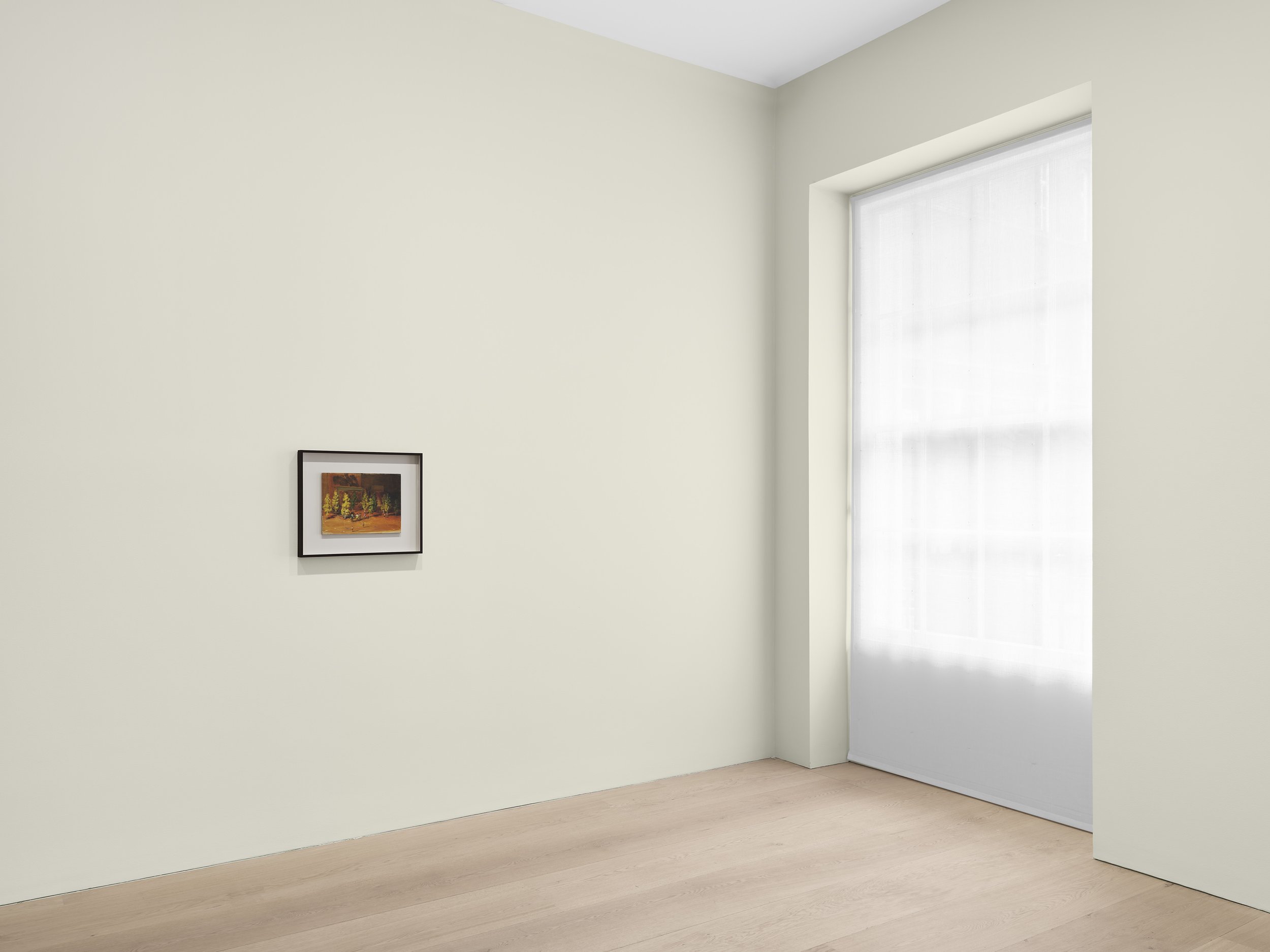

Installation view, Michaël Borremans, The Monkey, David Zwirner, London, 2024. Courtesy David Zwirner
In 2011, Michaël Borremans: Eating the Beard, a comprehensive solo show, was presented at the Württembergischer Kunstverein Stuttgart, and traveled to the Műcsarnok Kunsthalle, Budapest, and the Kunsthalle Helsinki. In 2010, he had a solo exhibition at the Kunstnernes Hus in Oslo, as well as commissioned work on view at the Royal Palace in Brussels. Other venues that have hosted solo exhibitions include the Kestner Gesellschaft, Hanover, Germany (2009); de Appel Arts Centre, Amsterdam (2007); Stedelijk Museum voor Actuele Kunst (S.M.A.K.), Ghent (2005; traveled to Parasol unit foundation for contemporary art, London, and Royal Hibernian Academy, Dublin); Cleveland Museum of Art (2005); Kunsthalle Bremerhaven, Germany (2004); and the Museum für Gegenwartskunst, Basel (2004).
Work by the artist is held in public collections internationally, including the Art Institute of Chicago; Cleveland Museum of Art; Dallas Museum of Art; Hammer Museum, Los Angeles; High Museum of Art, Atlanta; Israel Museum, Jerusalem; Los Angeles County Museum of Art; Musée d’Art Moderne de la Ville de Paris; Museum of Contemporary Art, Los Angeles; Museum of Fine Arts, Boston; The Museum of Modern Art, New York; National Gallery of Canada, Ottawa; San Francisco Museum of Modern Art; Stedelijk Museum voor Actuele Kunst (S.M.A.K.), Ghent; and the Walker Art Center, Minneapolis.
Citations:
1 Michaël Borremans, quoted in “Michaël Borremans Reveals His True Colors to Luca Guadagnino,” Interview (Spring 2024), accessed online.
2 Katya Tylevich, Michaël Borremans: The Monkey. Exh. cat. (New York: David Zwirner Books, 2024), p. 8.
3 Ibid., p. 56.
4 Ibid., pp. 9–10.
5 “Michaël Borremans in Conversation with Julian Taffel,” Marfa Journal (April 2024), n.p.
6 John Vincler, “Art We Saw This Spring,” New York Times (June 8, 2022), accessed online.
This exhibit will open on June 6th and will conclude on July 26th, 2024. For more information about this exhibit, visit David Zwirner’s site; please follow the gallery on Instagram. The gallery can also be found on Artsy here.
Gisela Colón: MATÉRIA PRIMA
Installation view, Gisela Colón, MATÉRIA PRIMA, Museu Nacional da República in Brasília, Brasilia, BR Credit: Courtesy of the Museu Nacional da República in Brasília and the artist. Photography: Diego Bresani
Museu Nacional da República in Brasília is proud to present Gisela Colón: MATÉRIA PRIMA, a multi-part exhibition of recent works by the Puerto Rican-American sculptor, whose ecofeminist artworks address ecological, cosmic, and universal concerns. The exhibition is curated by Simon Watson and Sara Seilert, director, National Museum of the Republic. The exhibition opened on March 21, 2024, and will close on June 3, 2024.
Installation view, Gisela Colón, MATÉRIA PRIMA, Museu Nacional da República in Brasília, Brasilia, BR Credit: Courtesy of the Museu Nacional da República in Brasília and the artist. Photography: Diego Bresani
Gisela Colón (b. 1966) is a Puerto Rican-American contemporary artist whose organic, totemic, light-activated sculptures and monumental environmental installations explore human perception and challenge viewers to experience transformation in real time and space. Through an artistic process that employs high-tech materials like optical acrylics and carbon fiber, as well as matter harvested from sites of the artist’s own life, Colón is known for pioneering a language of “organic minimalism” that recalls the energy of the earth, ancestral biological memories, and concepts of time, gravity, and universal forces of nature. Gisela Colón: MATÉRIA PRIMA marks the artist's first presentation in Brazil.
Organized by independent curator Simon Watson and National Museum director Sara Seilert, the three-part presentation begins outside the museum, where Colón showcases one of her monumental, carbon fiber “parabolic monoliths,” a form she has embedded in the Land Art interventions she’s created at sites around the world. Created specifically for Brasília, the 25-foot-tall monolith Plasmatic: The Fourth State of Matter (Parabolic Monolith Oxygen) references collective Latin American colonial histories, while simultaneously responding to Oscar Niemeyer’s archetypally modernist architecture of the site. Colón employs the word “plasmatic”-- referring to the fourth state of matter created under superheated, intense pressure-- as a metaphor to describe the Latinx experience. “Like plasma,” she says, “we are born of deep oppression, becoming mountains bursting from geological forces beneath the earth, or supernovae exploding into space. The mutable, iridescent surface of the sculpture poetically embodies the evolutionary nature of our colonial struggle, while engaging in a synergistic dialogue with the cultural, ethnographic, and historic conditions of this remarkable Brazilian site.”
At the same time, the monolith’s form evokes the aerodynamic geometries of projectiles used in surveillance and war, and recalls the fraught history of militarized colonialism in the Caribbean, as well as the artist’s own complicated personal experiences with gun violence. Yet for Colón the monolith also echoes, in its soaring verticality, the arresting mountainous peaks of Puerto Rico’s El Yunque Rainforest and the Cordillera Central, an enduring source of materia prima for her. In Colón’s hands, the violence of a projectile is subsumed into the primal, enigmatic form of the mountain, in a decolonial act of transformative healing. Through the monolith, Colón reconfigures entangled histories into a universal language, transmuting forms of violence, displacement, and death into vessels of healing, light, and life,
Inside, under the museum’s iconic dome, Colón channels the force of mountainous geological structures with an immersive installation of works inseveral mediums: six large photo murals, seven 8-foot-high translucent totems, and three luminous sculptures of organic form from Colón’s Pod series. The photo murals present visual documentation of Colón’s international environmental activations around the world, allowing the viewer to travel metaphorically through time and space, through varied geological terrains and historic geographies including the 4500-year-old Egyptian site of the Pyramids of Giza; a remote desert in AlUla, Saudi Arabia, located on the 10,000-year-old spice route; a 17th-century baroque forest in the Netherlands; the Wadi Hanifa River, the only existing waterway in Riyadh, Saudi Arabia; the medieval-era fortification known as the Citadel Salah al-Din in Old Cairo, Egypt, a UNESCO world heritage site; and the resplendent gardens of Regent’s Park in London, England.
Installation view, Gisela Colón, MATÉRIA PRIMA, Museu Nacional da República in Brasília, Brasilia, BR Credit: Courtesy of the Museu Nacional da República in Brasília and the artist. Photography: Diego Bresani
In the same space, three cell-like Pod sculptures reflect Colón’s investigation into color theory, which she conducts through the production of a prismatic experience of light without the use of paint—a method the artist terms “structural color.” Created as vessels of structural color, the sculptures present a fluid color spectrum when seen from different points of view, a function of light refraction that is manifested across the natural world. Thus Colón’s asymmetrical, “humanized” forms embody characteristics of organic life, changing and transforming their physical qualities depending on environmental factors and facilitating a perceptual experience of color as light in real time, while allowing viewers to imagine “impossible” perceptual phenomena like imaginary colors.
Surrounding the Pods, Colón’s array of luminous, cosmic totems rise from the floor to create a topography of translucent, mountainous trees growing in an other-worldly forest. Beyond their large scale and apparent weight, each work articulates a distinctive sense of gravity, accomplished through their palpable response and interaction with surrounding light. Viewers themselves, in both their presence and perception, play an essential role in animating these radiant forms.
Colón’s manipulation of innovative 21st-century materials like optical acrylics and high-technology aerospace carbon fiber paradoxically hijacks the typical functions of these materials in service of militarism and surveillance, and diverts them into the service of transcendence. Colón explains, “I employ as source material the raw energy found in nature, ancestral biological memories, and universal cosmic forces.”
Installation view, Gisela Colón, MATÉRIA PRIMA, Museu Nacional da República in Brasília, Brasilia, BR Credit: Courtesy of the Museu Nacional da República in Brasília and the artist. Photography: Diego Bresani
Gisela Colón’s first monumental Monolith sculpture, realized in 2016, was acquired by the Los Angeles County Museum of Art (LACMA), and was recently featured in the definitive survey exhibition organized by the museum, Light, Space, Surface: Art from the Los Angeles County Museum of Art. Carol Eliel, Senior Curator of Modern Art, wrote about Colón’s work: “[She] understands her work in terms more universal than most artists, referring to her sculptures as
objects that interact not only with the light, viewers, and their immediate environment, but also with the energy of ‘the earth, of the planet’…her Monoliths– tall, freestanding, cast carbon-fiber forms-- in particular draw on the futuristic in tandem with the mysteries of ancient cultural artifacts and structures….”
Photography: Inna Svyatsky
About the artist
Born in 1966, in Vancouver, Canada to a Puerto Rican father studying abroad, Colón was raised in San Juan, Puerto Rico and spent her formative years there. The experiences of her youth exploring the biodiversity of the Caribbean island and creating art with her mother, who was a painter, planted the seeds for her later art practice. Colón graduated from Universidad de Puerto Rico–Recinto de Río Piedras (1987) and Southwestern Law School (1990), and continued to maintain a painting practice until 2012, when she shifted her focus to sculpture. Colón has exhibited internationally throughout the United States, Europe, the Middle East, and Latin America. Notable public exhibitions include The Future is Now for Saudi Arabia’s Land Art Biennial, Desert X AlUla (2020); Forever is Now, a site-specific presentation at the Pyramids of Giza, a UNESCO world heritage site dating back 4,500 years (2021); Godheads - Idols in Times of Crises in the Oude Warande Forest in the Netherlands (2022); One Thousand Galaxies of Light (Starfield), an immersive light installation at the Wadi Hanifa River, in Riyadh, Saudi Arabia (2022); and If The Walls Could Talk / Reclaimed Stones: Foundations of Civilization, Past, Present, Future, at the UNESCO World Heritage Site, the Citadel of Salah al-Din, in Cairo, Egypt (2023). Colón’s work was recently featured in the Los Angeles County Museum of Art’s (LACMA) historic survey exhibition Light, Space, Surface: Art from the Los Angeles County Museum of Art; the Addison Gallery of American Art, Andover, Massachusetts (2021-2022); and the Frist Art Museum, Nashville, Tennessee (2022). Most recently, Colón presented a solo exhibition, The Feminist Divine, at SCAD Museum of Art, Savannah, Georgia (2022). Her work is currently on view in an exhibition of works from the permanent collection of New York’s El Museo del Barrio, Something Beautiful: Reframing La Colección. Forthcoming international projects also include Materia Prima del Caribe: Viajando Através del Tiempo con Luz, Carbón, Balas, Tierra, Agua, y Sal, a collaborative exchange project for La Bienal de la Habana, Cuba (2024).
Gisela Colón’s work resides in institutional collections such as the Los Angeles County Museum of Art, Los Angeles, CA; Wadsworth Atheneum Museum of Art, Hartford, CT; El Museo del Barrio, New York, NY; SCAD Museum of Art, Savannah, GA; Norton Museum of Art, Palm Beach, FL; Museum of Contemporary Art San Diego, San Diego, CA; Perez Art Museum Miami, Miami, FL; Mint Museum, North Carolina; Palm Springs Art Museum, Palm Springs, CA; Grand Rapids Museum of Art, Grand Rapids, MI; and Daum Museum of Contemporary Art, Sedalia, MO.
Publication
An illustrated monograph will accompany this exhibition, containing a scholarly essay by Joachim Pissarro, Bershad Professor of Art History and Director of the Hunter College Galleries, Hunter College, New York, and former Curator in MoMA’s Department of Painting and Sculpture, as well as an interview by Susanna Temkin, curator at El Museo del Barrio, New York.
About Curator Simon Watson
Born in Canada and raised in England and the United States, Simon Watson is an independent curator and art advisor based in New York and São Paulo. A veteran of the cultural scene on three continents, over the past four decades he has curated and organized more than 350 art exhibitions for galleries and museums. His area of curatorial expertise is in spotting visual artists with outstanding potential, many of whom are now seen internationally in the blue chip category and are represented by some of the most established galleries in the world.
Gisela Colón: MATÉRIA PRIMA at Museu Nacional da República marks the second major exhibition Watson has curated the work of Gisela Colón. Their first project was in the legendary site-specific sculpture exhibition Forever Is Now (2022), on the Giza plateau outside Cairo, Egypt, for which Colón created a monumental “rising sun” sculpture positioned in front of the ancient Sphinx.
About Curator Sara Seilert
Sara Seilert is a curator of contemporary art and director of the National Museum of the Republic, being the first woman to hold this position at the institution. Master in Information Science (2023) from the University of Brasília (UnB), with research on the formation of contemporary art museum collections, specifically the collection of the National Museum of the Republic. With a bachelor's degree and degree in Fine Arts from the University of Brasília (2012), she works as a Cultural Activities Analyst with a specialization in Fine and Visual Arts at the Secretariat of Culture and Creative Economy of the Federal District. He has experience in the area of art education and museum management.
About Museu Nacional da República
The National Museum of the Republic (Museu Nacional da República) is a public cultural exhibition site managed by the Department of Culture and Creative Economy of the Federal District. The Museu acquires, preserves, researches, communicates, and exhibits the heritage of Brazilian society, and is host to traveling exhibitions of renowned Brazilian and international artists. Part of the Republic's Cultural Group, the Museu was designed by Oscar Niemeyer and featured in the Brasilia Pilot Plan Report, prepared in 1957 by Lúcio Costa to be part of the Southern Cultural Sector of the New Capital. One of the great, modern architectural monuments of Brasilia’s Esplanade of Ministries, the all- concrete Museu is famous for its white dome and sculptural entrance ramp. Construction of the building began in 1999; it features 14,500 square meters (156,000 square feet) of exhibition area and was inaugurated on December 15, 2006-- the same day that Oscar Niemeyer turned 99 years old.
Museum exhibition hours
March 21 – June 3, 2024
Tuesday to Sunday from 9am to 6:30pm
The exhibition will close on June 3rd of this year. For more information about this exhibition and others, please visit the Museu Nacional da República website here. They can also be found on Instagram here and Facebook here.
Gisela Colón : Mountains Are Inside Me
New York, NY - Efraín López is pleased to present Mountains Are Inside Me, an exhibition of new works by Puerto Rican- American sculptor, Gisela Colón. The exhibition will be on view from April 30 through June 22, 2024. For her first solo show at the gallery, the artist will present two new sculptural works alongside an early painting, a suite of intimately- scaled works on paper, and an architectural intervention. Mountains Are Inside Me will be accompanied by an essay authored by curator César García-Alvarez.
Gisela Colón’s sculptural practice explores identity, transformation, energy, time, and space. Her work is grounded in minimal organic aesthetics that refuse stasis, and instead embrace transformation and transcendence. Throughout her practice, Colón employs strategies of abstraction to both subsume and conceal the complexities of identity and personal narrative. Her work crosses geographic, political, and national boundaries, to form multicultural dialogues and create space for Latinx voices.
Contextualizing the origin of the monolithic form, the presentation opens with an early painting titled Pinnacle (El Yunque), 1996. Conjured from her observations and experiences in El Yunque, the tropical rainforest of her homeland in Puerto Rico, this work marks the first appearance of the monolithic structure that has become the principal occupation of Colón’s work. The artist’s use of abstraction and universal geometries belies an alternate reality shaped by complex diasporic conditions. Colon’s monoliths simultaneously evoke the fraught collective history of militarized colonialism in the Caribbean and draw upon her own layered experiences with gun violence. Shaped by a process of healing and transformation, the soaring verticality of the monoliths reflects the mountainous peaks of Puerto Rico’s captivating geology, an enduring source of materia prima for the artist.
Anchoring the main exhibition space, Tierra de Substrato Arecibo Hematita (Parabolic Monolith Hematite), builds upon Colón’s distinctive organic minimalist language while further elucidating her personal history and often-illegible identity as a diasporic Puerto Rican artist. In Tierra de Substrato Arecibo Hematita, Colón's use of red earth from her family’s plot of land in Arecibo connects formative moments of a childhood surrounded by violence and displacement to an early fascination with outer space and the cosmos nurtured at the Observatory de Arecibo—until recently the largest telescope in the world. A deeply personal work, Tierra de Substrato Arecibo Hematita, is the bedrock that lies beneath the artist’s own biographical story, concealed within layers calcified by the broader implications of Puerto Rico's stratified history with colonialism. The distinctive ochre color of Puerto Rico’s red earth comes from the mineral hematite, an iron oxide formed over time. Hematite, one of the earliest pigments used by man, appears in ancient cave drawings throughout the world, as well as on other planetary bodies. In Tierra de Substrato Arecibo Hematita, Colón constructs a vessel that imagines an expansive cosmic world filled with the energy of nature, ancestral memories, and a universal consciousness larger than any single individual. In imagining this vast expanse of space and time, subjective lived experiences on a human scale are absorbed into the universal, infinite form of the monolith—a structure shared across time by geological formations, prehistoric archeological structures, and ancient architectures. Colón’s larger-than-life totemic structure encapsulates a transformative moment in time, where the complexities of an infinite cosmos, composed of cosmic matter and energy, swirl within its confines.










Installation view, Gisela Colón, Mountains Are Inside Me, Efraín López, New York Credit: Courtesy of Efraín López and the artist. Photography: Inna Svyatsky
While rooted in Colón’s personal relationship to land and encounters with violence, Tierra de Substrato Arecibo Hematita works to absorb the specificities of individualized negative experiences to form a transformative vessel of healing, light, and life. In this work, Colón has invited us to consider what lies beneath the surface and sits within the infinite potentiality of the cosmic world, grounded in the raw dirt that bore ancestral life on earth.
About the Artist
Gisela Colón (American b. 1966, Vancouver, Canada, raised 1967, San Juan, Puerto Rico) is a Puerto Rican-American artist whose dynamic sculptures offer mutable, perceptual experiences through the refraction, reflection, and emission of light. Generated with advanced production methods such as carbon fiber casting meant for aerospace applications, Colón’s curvilinear forms emanate a seductive, iridescent glow, fluctuating in color based on environmental conditions and where the viewer stands in relation to the work. Colón coined the term “Organic Minimalism” to describe the dual condition of her work: reductive yet active and seemingly alive. While situated within the lineage of Minimalism, Colón’s practice refuses the stasis and rigidity of structure typical of work by her male predecessors, embracing the transformative and transcendent. Informed by the natural world and rich biodiversity of her home island of Puerto Rico, her work invokes the “feminine divine” as a method of creating space for underrepresented People.
Colón has exhibited internationally throughout the United States, Europe, Egypt, the Middle East, and Latin America. Notable public exhibitions include The Future is Now for the Land Art Biennial, Desert X, Godheads - Idols in Times of Crises in the Oude Warande Forest (Netherlands 2022), and One Thousand Galaxies of Light (Starfield), an immersive light installation at the Wadi Hanifa River, Riyadh, Saudi Arabia (November 2022). Colón's work was recently featured in the Los Angeles County Museum of Art's (LACMA's) historical survey exhibition Light, Space, Surface: Art from the Los Angeles County Museum of Art, the Addison Gallery of American Art, Andover, Massachusetts (2021-2022), and. Most recently, Colón presented a solo exhibition, The Feminist Divine, at the SCAD Museum of Art, Savannah, Georgia (2022). Her work is currently on view in an exhibition of works from the permanent collection of New York’s El Museo del Barrio, Something Beautiful: Reframing La Colección. Forthcoming international projects also include Materia Prima del Caribe: Viajando Através del Tiempo con Luz, Carbón, Balas, Tierra, Agua, y Sal, a collaborative exchange project for La Bienal de la Habana, Cuba (2024).
Gisela Colón’s work resides in institutional collections such as the Los Angeles County Museum of Art, Los Angeles, CA; Wadsworth Atheneum Museum of Art, Hartford, CT; El Museo del Barrio, New York, NY; SCAD Museum of Art, Savannah, GA; Norton Museum of Art, Palm Beach, FL; Museum of Contemporary Art San Diego, San Diego, CA; Perez Art Museum Miami, Miami, FL; Mint Museum, North Carolina; Palm Springs Art Museum, Palm Springs, CA; Grand Rapids Museum of Art, Grand Rapids, MI; and Daum Museum of Contemporary Art, Sedalia, MO.
About Efraín López
Efraín López is a Puerto Rican-American art dealer and exhibition maker based in New York City. Between 2012 and 2018, López founded and directed his eponymous gallery in Chicago, where he presented an ambitious and rigorous exhibition program, often giving artists their first solo presentation in the United States. His long-standing commitment to the career development of emerging artists has led to placements in major museum collections worldwide. In June of 2023 López opened Efraín López, a contemporary art gallery in New York's Tribeca neighborhood. The program is conceptual, multidisciplinary, and globally minded, engaging both emerging and established artists.
For more information about this exhibition and others please visit the Efraín López here
Paul McCartney Photographs 1963–64: Eyes of the Storm
Paul McCartney. Self-portrait. London, 1963. Pigmented inkjet print. © 1963 Paul McCartney under exclusive license to MPL Archive LLP
As The Beatles captured the hearts of millions, Paul McCartney captured it all on his Pentax film camera. Paul McCartney Photographs 1963–64: Eyes of the Storm takes visitors inside the 1963–64 frenzy of Beatlemania, as the band’s first U.S. tour skyrocketed them to global fame. More than 250 of McCartney’s photographs, recently rediscovered in his archives, reveal his singular vantage point at the center of this whirlwind of attention and adoration—illuminating both the historical, and the personal, moments McCartney and his bandmates experienced together. First on view at the National Portrait Gallery in London, England, the exhibition makes its New York debut at the Brooklyn Museum, opened on May 3, 2024, and is supported by Bloomberg Philanthropies.
Paul McCartney. John and George. Paris, January 1964. Pigmented inkjet print. © 1964 Paul McCartney under exclusive license to MPL Archive LLP
“Since first arriving in New York in February 1964, Paul McCartney has built a strong, everlasting connection to the city. His vibrant photographs from The Beatles’ first visit capture the energy of the city, the excitement of the American fans, and the frenzy of the band’s status as celebrities. Yet the images also record The Beatles’ fun and delight with each other. Through McCartney’s lens, we feel the intensity of being at the center of such extraordinary events,” says Catherine Futter, Director of Curatorial Affairs and Senior Curator of Decorative Arts.
Paul McCartney. Self-portraits. Paris, January 1964. Pigmented inkjet print. © 1964 Paul McCartney under exclusive license to MPL Archive LLP
In an immersive installation of photography, video clips, and archival material, Eyes of the Storm traces the period when The Beatles played concert halls in Liverpool and London and began to tour internationally, first to Paris and then to the United States. McCartney’s photographs convey the intensity of the band’s touring schedule in the U.S., as the Fab Four were swept from concerts to hotels to the road with rabid fans and paparazzi at their heels, from New York and Washington, DC, to Miami. The band’s arrival in New York signaled a turning point in popular culture, as their first televised performance on The Ed Sullivan Show was watched by around seventy-three million people and launched The Beatles into superstardom.
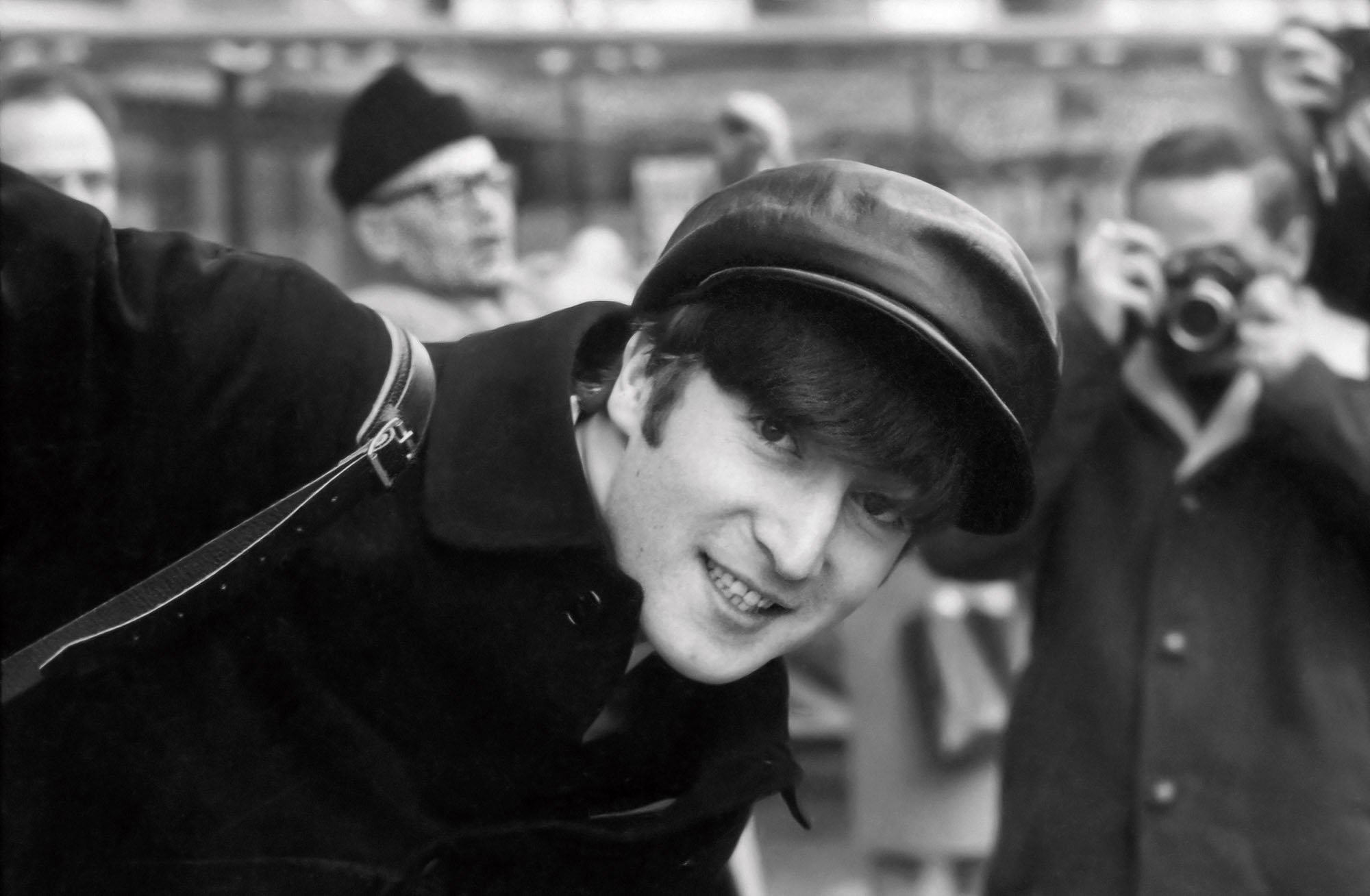

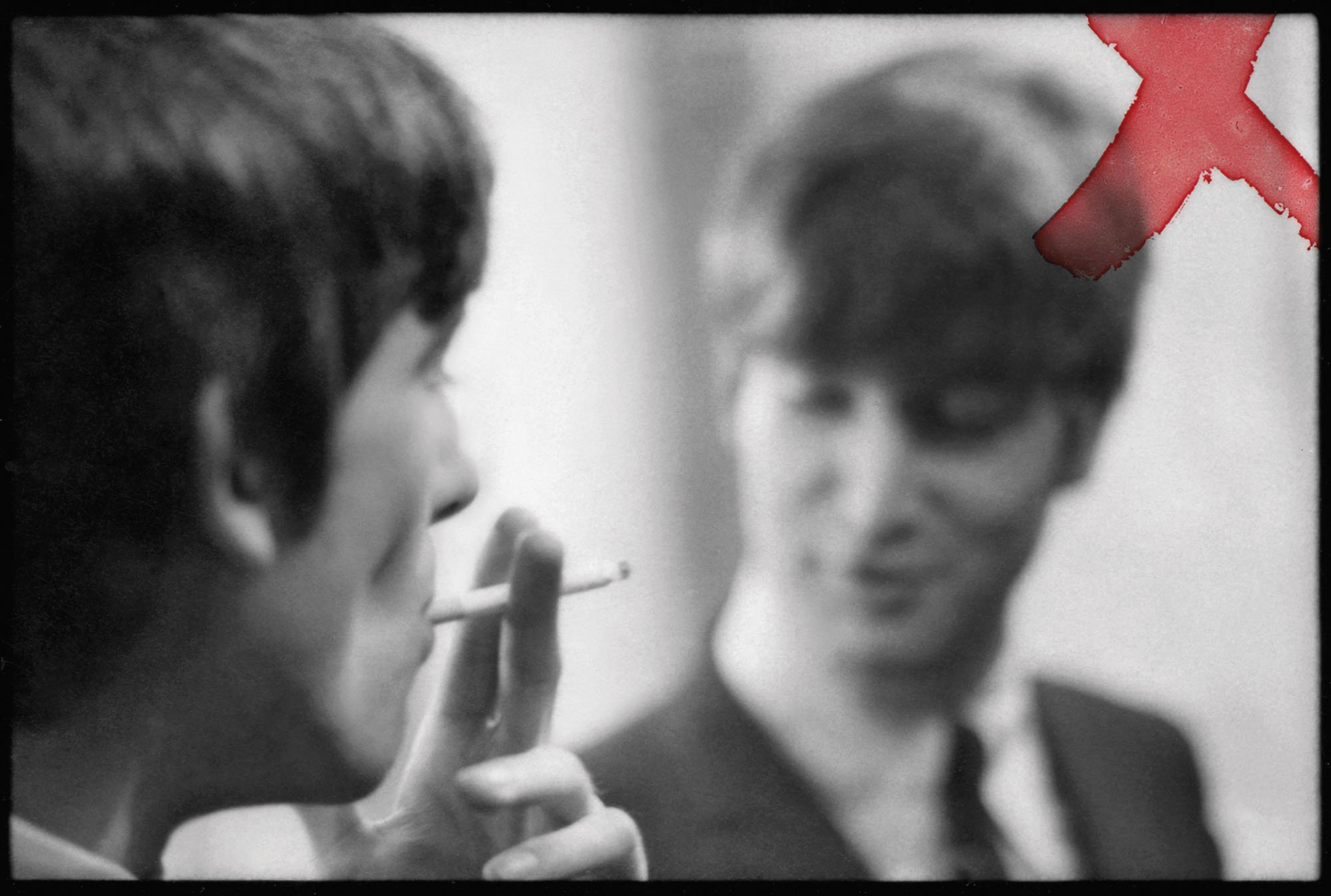



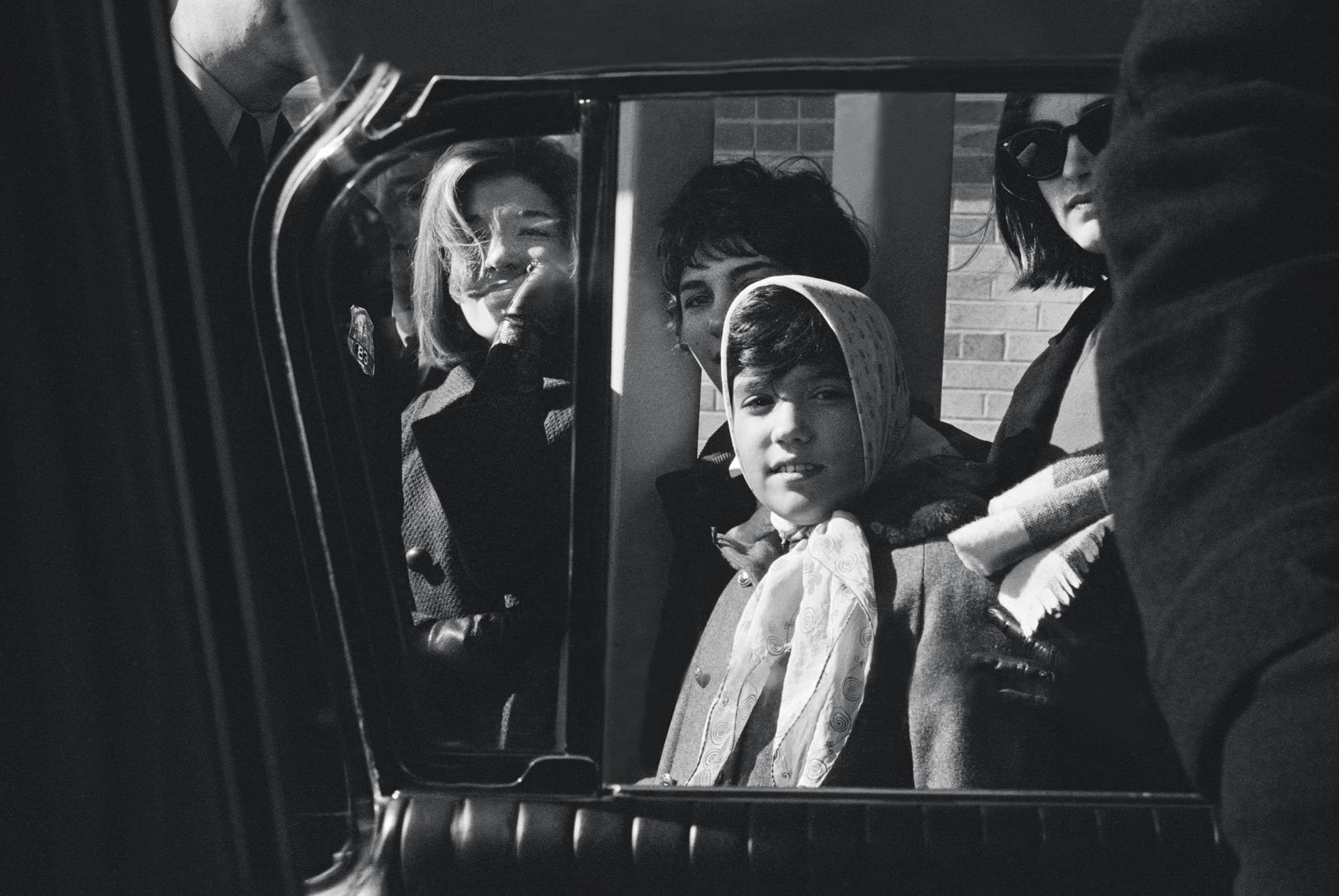


McCartney’s explorations in photography reflect his commitment to both the musical and visual arts. The range of work, from portraiture and landscape photos to documentary images, reveals McCartney’s familiarity with the formal styles of early 1960s photography. References to New Wave, documentary filmmaking, and photojournalism can be found across the exhibition.
Paul McCartney. West 58th Street, crossing 6th Avenue. New York, February 1964. Pigmented inkjet print. © 1964 Paul McCartney under exclusive license to MPL Archive LLP
Eyes of the Storm not only showcases McCartney’s artistic versatility but also serves as a personal and historical archive. In addition to documenting the demands of touring and nonstop media attention, the photographs evoke an affectionate family album, picturing his fellow band members, John Lennon, George Harrison, and Ringo Starr, at a time when their lives were changing irrevocably. The exhibition gives visitors a highly personal glimpse into an extraordinary time period of one of music’s enduring legends. Born in Liverpool, England, Paul McCartney rose to prominence as a founding member of The Beatles. Throughout his lifetime, McCartney has played a pivotal role in shaping the landscape of popular music and culture more broadly.









Installation view, Paul McCartney Photographs 1963-64: Eyes of the Storm, May 3, 2024 - August 18, 2024. (Photo: Danny Perez)
Paul McCartney Photographs 1963–64: Eyes of the Storm has been organized by the National Portrait Gallery, London, England, in collaboration with Paul McCartney. It is curated by Paul McCartney with Sarah Brown for MPL Communications and Rosie Broadley for the National Portrait Gallery. The presentation at the Brooklyn Museum is organized by Catherine Futter, Director of Curatorial Affairs and Senior Curator of Decorative Arts, and Jennie Tang, Executive Assistant to the Deputy Director of Art and the Director of Curatorial Affairs.
Lead Sponsor
About Bloomberg Philanthropies:
Bloomberg Philanthropies invests in 700 cities and 150 countries around the world to ensure better, longer lives for the greatest number of people. The organization focuses on five key areas for creating lasting change: the Arts, Education, Environment, Government Innovation, and Public Health. Bloomberg Philanthropies encompasses all of Michael R. Bloomberg’s giving, including his foundation, corporate, and personal philanthropy as well as Bloomberg Associates, a pro bono consultancy that works in cities around the world. In 2022, Bloomberg Philanthropies distributed $1.7 billion. For more information, about Bloomberg Philanthropies, please visit here and sign up for their newsletter, or follow them on Facebook, Instagram, YouTube, Twitter, and LinkedIn.
The exhibit opened on May 3rd, 2024, and the exhibit will close on August 18 of this year. Please visit the Brooklyn Museum’s site for more information about the exhibit. The Museum can also be found on Instagram, TikTok, YouTube, and Facebook.
Cui Fei : Vermicular Calligraphy
Vermicular Calligraphy_VI Lead, Driftwood 11 ¼ x 2 ½ x 1 ½ 2023
The Garage Art Center is thrilled to announce the opening of a captivating exhibition featuring the remarkable series of works by artist Cui Fei. Titled " Vermicular Calligraphy," the exhibition delves into the intricate world of writing found in nature, inviting viewers on a journey of discovery and contemplation.
This exhibition, Vermicular Calligraphy, showcases the recent works of Chinese American artist Cui Fei. The artworks in this series are profound visual explorations resulting from the artist's deep investigation into the shapes of writing discovered in nature. While collecting plant materials in nature, the artist became interested in the markings left by beetles on tree trunks and discovered that some of these patterns closely resemble Chinese calligraphy. Drawing inspiration from the shapes created by natural phenomena, the artist uses lead and metalworking techniques in the ‘Vermicular Calligraphy’ series to create sculptures of sections of tree trunks scarred by beetles. The metal sculptures delicately depict the contours and textures of the tree trunks, while the artist reproduces the imprints left by beetles on their surfaces through meticulous hammering.
Vermicular Calligraphy_III Lead, wood, 19” x 9” x 2 ¾ 2023-2024
The artist traces "writing" back to its origins in nature, emphasizing the importance of nature to human civilization. The gray lead pieces shaped like dead tree trunks also symbolize the immense loss caused by our excessive exploitation of nature. This exhibition serves as a poignant reminder of the urgent need for change for a sustainable future, awakening awareness through visual impact.
Vermicular Calligraphy_II (detail) Lead, wood 35” x 18" x 10" 2022-2023
Related Events
The opening reception happened on Saturday, May 4, from 4 pm to 6 pm. It offered a unique opportunity for attendees to meet the artist, gain insights into her creative process, and engage in conversation over the artwork presented.
Another highlight was the “Ink Rhythms: An Ink Rubbing Adventure” workshop that occurred on Saturday, May 18, 2024, from 3 pm to 5 pm, led by Cui Fei.
During the two-hour workshop, Cui Fei shared her wealth of experience and expertise. Through hands-on practice and expert guidance, participants explored the basic techniques of ink rubbing, using ink and delicate rice paper, and learn to meticulously reproduce intricate patterns and textures on rice paper of found objects.
Participants were able to experience the joy of artistic expression by immersing themselves in the physicality of ink rubbing, embracing the meditative and transformative qualities of this labor-intensive process, and cultivating a deeper appreciation for the objects that surrounded them.



Installation Views: Cui Fei, Vermicular Calligraphy, The Garage Art Center © Cui Fei Courtesy the artist and The Garage Art Center
This workshop is supported by funds from the New York State Council on the Arts, Statewide Community Regrants Program (formerly the Decentralization program) with the support of Governor Kathy Hochul and the New York State Legislature, and administered by Flushing Town Hall.
About the Artist
Cui Fei was born in China and now lives and works in New York. Her work has been exhibited nationally and internationally at venues such as the Warehouse Gallery at Syracuse University in Syracuse, NY; Princeton University Art Museum in Princeton, NJ; Museum of Arts and Design in New York, NY; Museum of Chinese in America in New York, NY; Queens Museum in Queens, NY; Aldrich Contemporary Art Museum in Ridgefield, CT; New Britain Museum of American Art in New Britain, CT; Jeju Museum of Art in Jeju, Korea; Rietberg Museum Zurich in Switzerland; Museum of East Asian Art in Cologne, Germany, among others.
She is a recipient of the Pollock-Krasner Foundation Grant, Artist’s Fellowship from the New York Foundation for the Arts, Artist Fellowship from Socrates Sculpture Park, SIP fellowship from the Robert Blackburn Printmaking Workshop, Workspace Grant from The Center for Book Arts, and Excellence in Arts Award from the Bronx Council on the Arts. She was selected for the Art Omi International Artists Residency, Artist-in-Residence Program at Light Work, Emerge Program at Aljira & Creative Capital in Newark, and the AIM program at the Bronx Museum of the Arts. Her work has been reviewed in The New York Times, Art in America, and YiShu—Journal of Contemporary Chinese Art, among other publications.
Her work is included in the permanent collections of the Brooklyn Museum, Princeton University Art Museum, Light Work at Syracuse University, and Stony Brook University.
Cui Fei’s interview with the magazine can be found here. For more information about this exhibition, please visit the Garage Art Center’s website here; the center can also be found on Facebook, YouTube, and Instagram. Her Artist Spotlight in the magazine can also be found here.
Paul Klee : Psychic Improvisation
Paul Klee, physiognomische Genesis (Physiognomic genesis), 1929 © Klee Family Courtesy David Zwirner
I am beginning to see a way to provide a place for my line.... With new strength ... I may dare to enter my prime realm of psychic improvisation again. Bound only very indirectly to an impression of nature, I may again dare to give form to what burdens the soul.1
—Paul Klee
David Zwirner is pleased to present Psychic Improvisation, an exhibition of work by Paul Klee, on view at the gallery’s 537 West 20th Street location in New York. Organized in collaboration with Alain and Doris Klee, with additional support from the Zentrum Paul Klee, Bern, this will be the gallery’s third solo exhibition of the revered modernist’s work, following 1939, at David Zwirner New York in 2019, and Late Klee, at David Zwirner London in 2020. While those exhibitions focused on Klee’s work from the middle to late 1930s, this presentation will explore his singular use of color and line, offering a concise yet instructive overview of the artist’s practice from the 1920s and 1930s.
This exhibition will feature a range of key works that visualize the artist’s immense skill as a colorist and a draftsman. Several works from the early 1920s—around the time Klee began teaching as a “form master” at the newly founded Bauhaus—feature vibrantly colored grid-like fields whose appearances vacillate between landscape and pure abstraction. Two related paintings, Friedhof (Cemetery) and Mädchen am Fenster (Girl at the window) (both 1920), exemplify this quality of Klee’s Bauhaus-era colorism. In these works, Klee breaks up the picture planes into cubist-style arrangements of geometric fragments and forms. Trees and crosses rendered in dark pigment appear as pictographic signs and contrast with the artist’s sensitive application of reds, greens, yellows, and blues, which delicately fill the quadrilinear and triangular forms that structure the compositions. White highlights further enhance the tonal range of the works and give the paintings an overall sense of light emanating from behind their surfaces—like stained glass.
Klee’s experimentation with line served as a vehicle for exploring abstraction during his time at the Bauhaus, and his inventive and varied use of the graphic medium comes through in intimate works composed of abstract, fractal-like forms or meandering webs and networks of lines. In Härten in Bewegung (Hardnesses in motion) (1927), Klee interlocks a series of rectangular planar forms that are all bisected by dark graphic lines to create dynamic spatial relationships on a modestly scaled support. The hard-edged geometry of that work finds its counterpart in dynamisch-polyphone Gruppe (Dynamic-polyphonic group) (1931), in which the combination of seemingly diaphanous overlapping organic shapes—made from delicate weaves of crosshatches—visually achieve the abstract sonoric quality referenced in the work’s title.







Installation view, Paul Klee: Psychic Improvisation, David Zwirner, New York, May 2–June 15, 2024 Courtesy David Zwirner
Complementing Klee’s high-modernist style will be drawings and paintings that highlight the artist’s unique and varied approach to the human figure. In works like Der Schutzmann vor seinem Haus (The policeman in front of his house), from 1923, the titular figure appears as a mechanomorphic assembly of shapes and lines with watercolor spreading out from the graphic forms in a bright medley of soft pigments that diffuse into the paper support. Other representations are more diaristic and at times caricaturish—accomplished with an economy of means that makes them evocative and ambiguous. Another standout composition exemplifying Klee’s colorism, ein Doppel-Schreier (A double screamer) (1939), from the artist’s late period, embodies a dual sense of humor and terror, in the form of two abutting heads—rendered in red and orange tones—with mouths agape and terrified expressions, set against a deep lapis blue ground.
Created during the tumult of the interwar years in Europe, the works in this exhibition testify to Klee’s status as a pioneering figure in the history of modern art, while the formal sophistication and deeply personal nature of the works underscore why his art continues to resonate with viewers and artists today.
Paul Klee, neue Orden (New medals), 1938 © Klee Family Courtesy David Zwirner
A pioneering modernist of unrivaled creative output, Paul Klee (1879–1940) counts among the truly defining artists of the twentieth century, exploring and expanding the terrain of avant-garde art through work that ranges from stunning colorist grids to evocative graphic productions. Klee taught for a decade, from 1921 to 1931, at the Bauhaus, the famed German art and design school, and the novelty of his work and ideas established him as one of the institution’s foremost instructors. He was associated with some of the most important art movements of the twentieth century, such as expressionism, cubism, and surrealism, yet his practice remained highly individualistic and distinct; it was never encapsulated by the concerns of a movement or reducible to the modernist binary of abstraction and figuration.
Klee was born a German citizen in Münchenbuchsee near Bern, Switzerland. In 1911, he had his first solo exhibition at the Galerie Thannhauser in Munich. In the same year, he met fellow artist Wassily Kandinsky and became acquainted with the expressionist group Der Blaue Reiter (The Blue Rider), exhibiting with them at their second show, in 1912. Later that year, after becoming familiar with the art of Pablo Picasso, Georges Braque, and Robert Delaunay during a trip to Paris, Klee began incorporating cubist and other innovative colorist techniques and ideas into his own distinct practice. Two years later, in 1914, Klee traveled to Tunisia with his friends the artists August Macke and Louis Moilliet, a revelatory experience that the artist credits with further awakening him to color.
Paul Klee, ein Doppel-Schreier (A double screamer), 1939 © Klee Family Courtesy David Zwirner
The renowned gallerist Hans Goltz, a fierce supporter of modern art and Paul Klee’s first general agent, from 1919 to 1925, staged a retrospective of Klee’s art in 1920 at his gallery in Munich. Alfred H. Barr, Jr., the first director of The Museum of Modern Art, New York, had become familiar with Klee’s art in the 1920s and presented an exhibition of his work in March of 1930, the institution’s first solo show of a living European artist. In 1935, Klee’s work was the subject of major retrospectives at the Kunsthalle Bern and the Kunsthalle Basel. In 1940, shortly before he passed away, Klee had a solo exhibition of new work at the Kunsthaus Zürich. In 1941, a traveling memorial exhibition was organized by The Museum of Modern Art, New York, and toured additional venues across the United States, including the San Francisco Museum of Art.
Klee’s work has been the subject of major retrospectives and traveling solo exhibitions at institutions worldwide. Among major exhibitions of his work during the past decade are The EY Exhibition: Paul Klee – Making Visible at Tate Modern from 2013 to 2014; the Centre Georges Pompidou, Paris, held Paul Klee: Irony at Work in 2016; Fondation Beyeler, Basel, hosted the retrospective Paul Klee: The Abstract Dimension from 2017 to 2018; Pinakothek der Moderne, Munich, featured Paul Klee: Construction of Mystery in 2018; and Museo delle culture, Milan, presented Paul Klee: Alle origini dell’arte (Paul Klee: At the Origins of Art) from 2018 to 2019. In 2019 Paul Klee: Equilíbrio Instável debuted at Centro Cultural Banco do Brasil, São Paulo, and traveled to Centro Cultural do Brasil, Rio de Janeiro, and Centro Cultural do Brasil, Belo Horizonte. In 2022, the San Francisco Museum of Modern Art presented the two-person exhibition Paul Klee & Lee Mullican: Outward Sight and Inner Vision. Paul Klee and the Secrets of Nature was on view at Fundació Joan Miró, Barcelona, from October 21, 2022 to February 12, 2023.
Paul Klee, Friedhof (Cemetery), 1920 © Klee Family Courtesy David Zwirner
In 1947, after the death of Paul Klee’s widow, four prominent collectors in Bern established the Paul Klee Foundation, which was housed in the Kunstmuseum Bern until 2004. On the occasion of a large donation of works from the Klee Family, the foundation was absorbed into a new museum dedicated to the artist. In 2005, the Zentrum Paul Klee opened as an independent institution and research center with a building designed by Renzo Piano. Klee’s work is in the permanent collections of countless major museums around the world.
he exhibition opened at the New York location, 537 West 20th Street on May 2nd and will conclude on June 15, 2024. For more information about this exhibit, visit David Zwirner’s site; you can also follow them on Instagram and find the gallery on Artsy here.
Citations
1 Paul Klee, The Diaries of Paul Klee: 1898–1918, ed. Felix Klee (Los Angeles and London: University of California Press, Berkeley, 1964), p. 232.
Magdalena Wosinska : Fulfill the Dream
‘Magdalena Wosinska: Fulfill the Dream on display at Fahey/Klein Gallery, Los Angeles’ © Fahey/Klein Gallery, Los Angeles
The Fahey/Klein Gallery is pleased to announce Magdalena Wosinska's debut solo exhibition, held in conjunction with the release of her newest monograph, Fulfill the Dream. This exhibition will include a selection of photographs from Fulfill the Dream, in addition to Wosinska’s photojournalistic imagery, which captures the intimacy of human connection that balances adventure and introspection.
‘Magdalena Wosinska: Fulfill the Dream on display at Fahey/Klein Gallery, Los Angeles’ © Fahey/Klein Gallery, Los Angeles
Central to Wosinska's photography is the celebration of spontaneity. Viewers find themselves immediately immersed in Wosinska's world, where authenticity reigns supreme and every moment is overflowing with a hint of rebelliousness. Through intimate portraits, she explores the complexities of selfhood, highlighting the interplay between inner emotions and outward appearances. Her subjects are portrayed genuinely, without artifice or pretense, inviting viewers to reflect on their own sense of identity. Whether it's skateboarding down city streets or basking in the golden hues of nature, each frame exudes a sense of liberation and outlaw attitude. The sensual and sun-drenched photographs of women roaming nude in nature are quintessentially Magdalena, as are her portraits of the South Central Cowboys and vignettes of motorcycles in the desert.
‘Magdalena Wosinska: Fulfill the Dream on display at Fahey/Klein Gallery, Los Angeles’ © Fahey/Klein Gallery, Los Angeles
At a young age, Magdalena Wosinska immigrated to the United States with her parents in 1991 from communist Poland. She found solace and belonging in the skateboarding subculture during the 90s, which became her passion and inspiration. At 14 years old, she began photographing with a dream of shooting the cover of a skate magazine (Thrasher). In time she found success in fine art, editorial, and commercial photography. Now, 25 years later, she's revisiting her roots with her most recent monograph "Fulfill the Dream," which will showcase her early images of skateboarding icons and highlight her artistic journey. Her book serves as a time capsule of the skateboarding scene and her evolution as an artist, capturing intimate moments from a unique perspective as one of the few women deeply embedded in the culture.

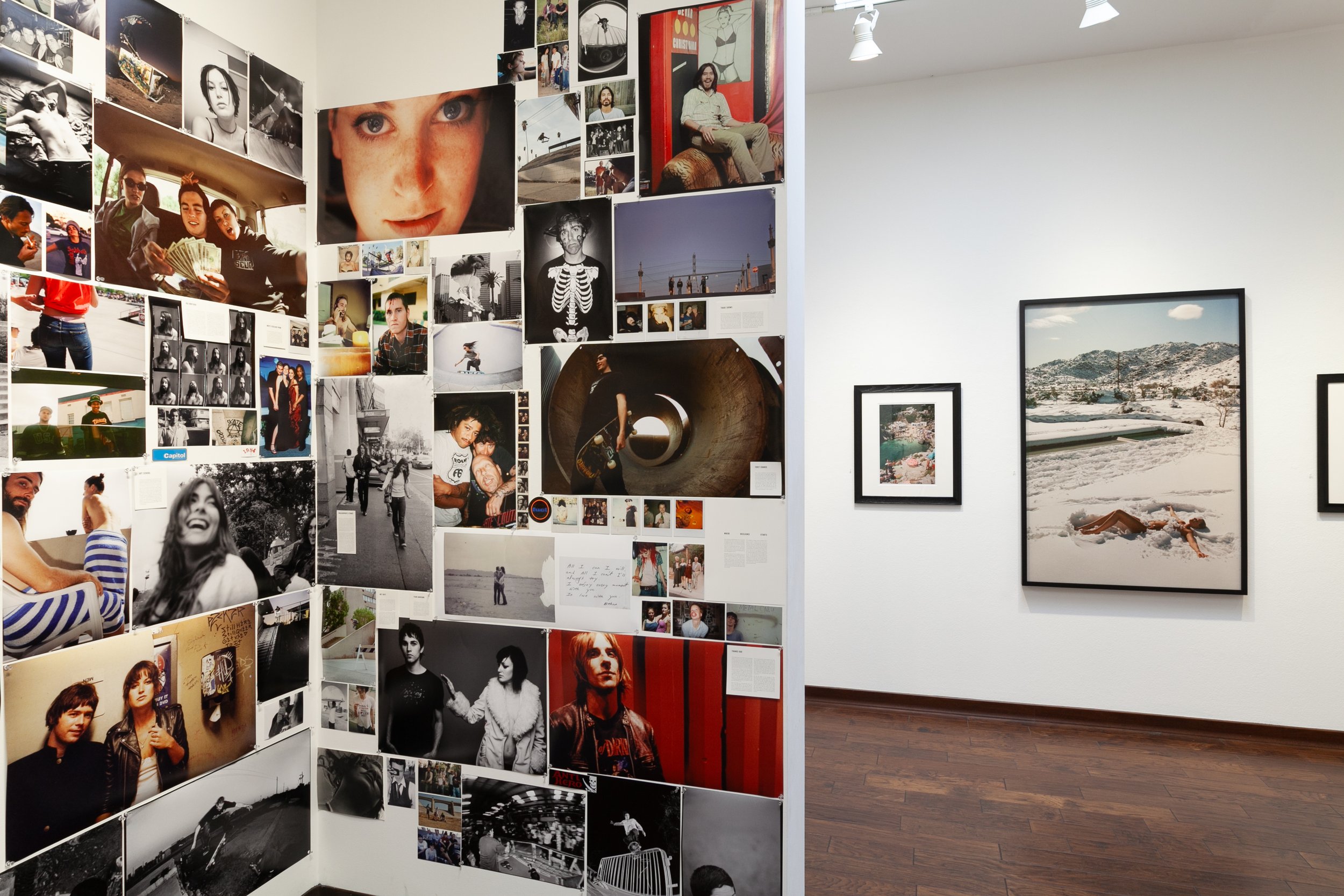

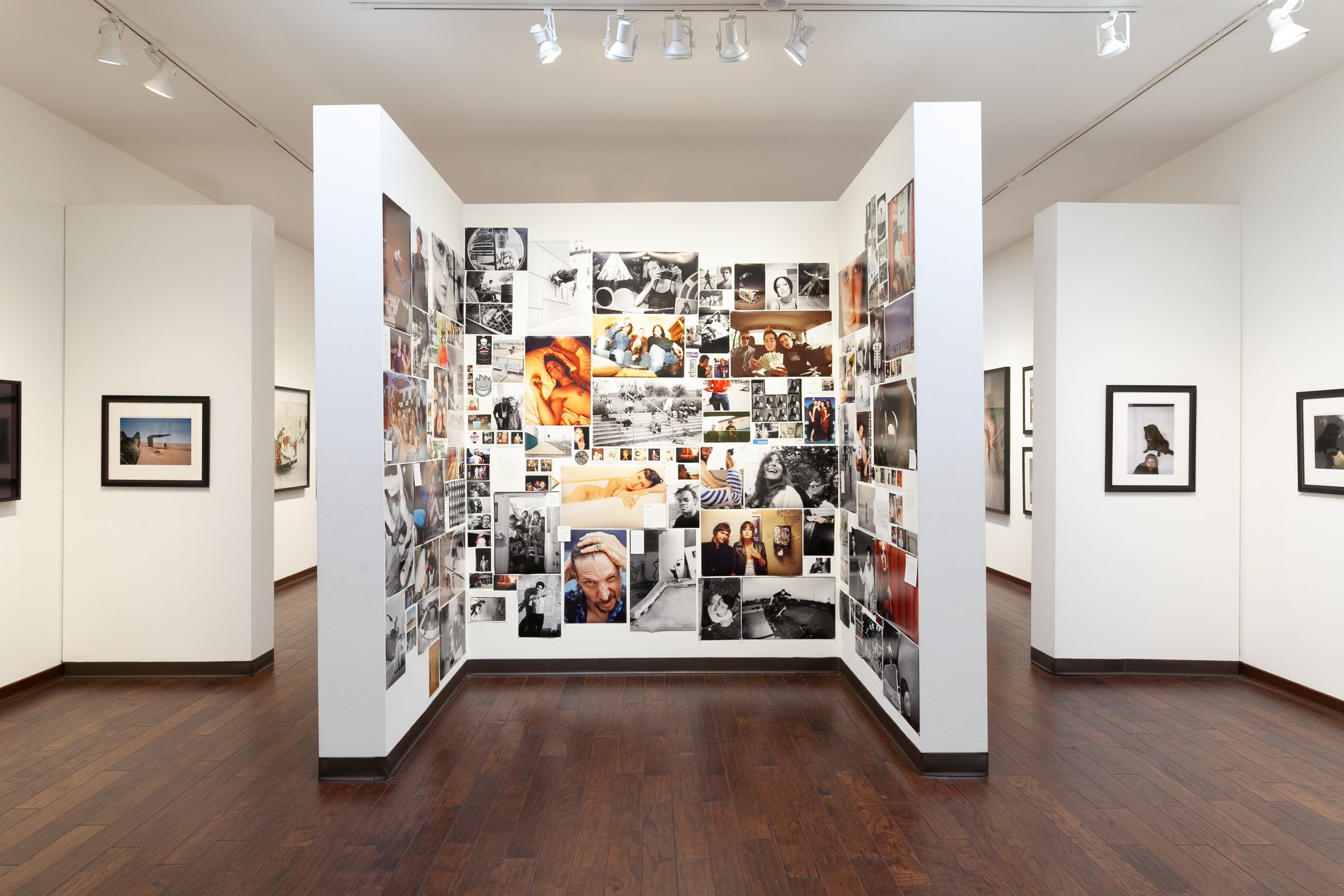

















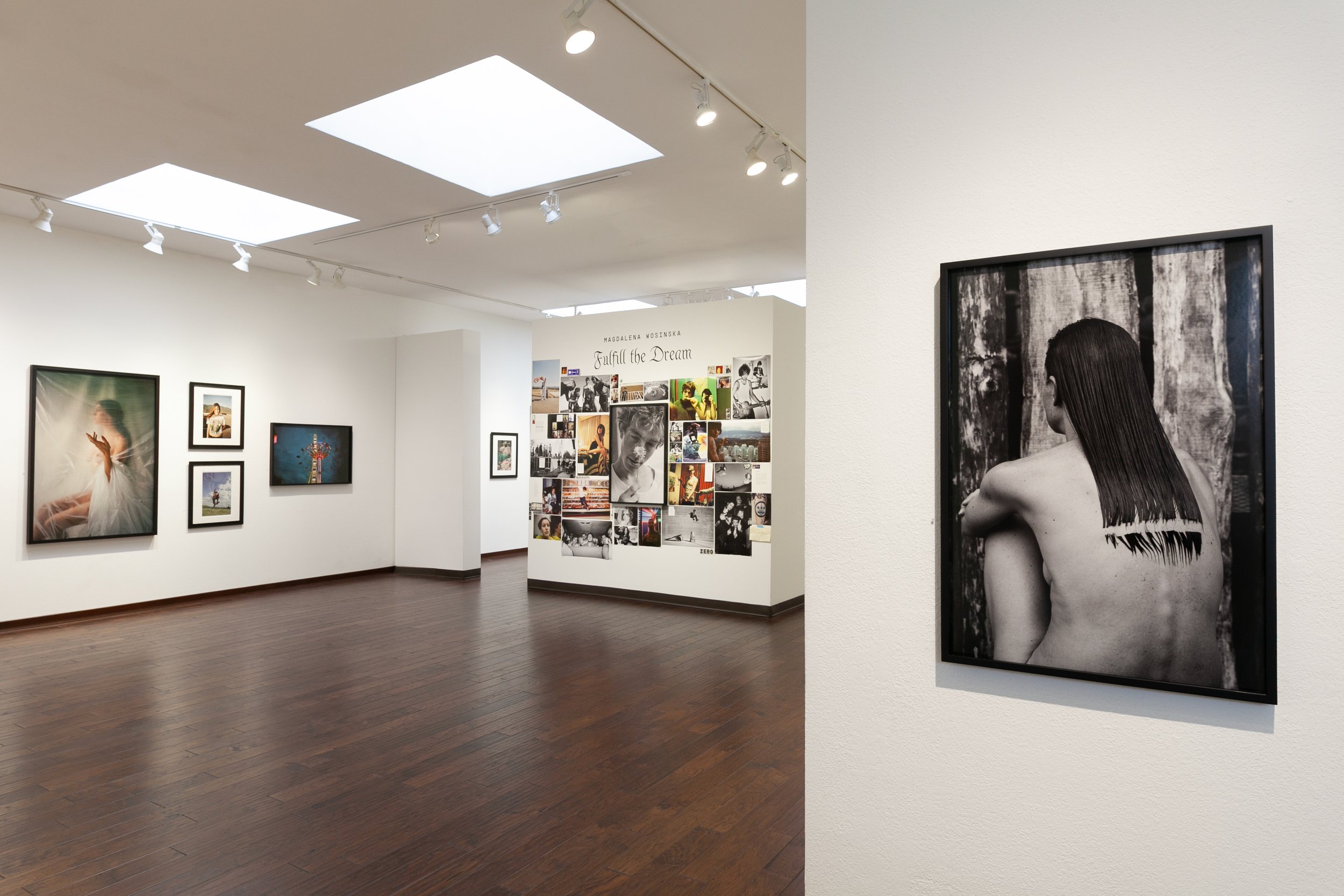
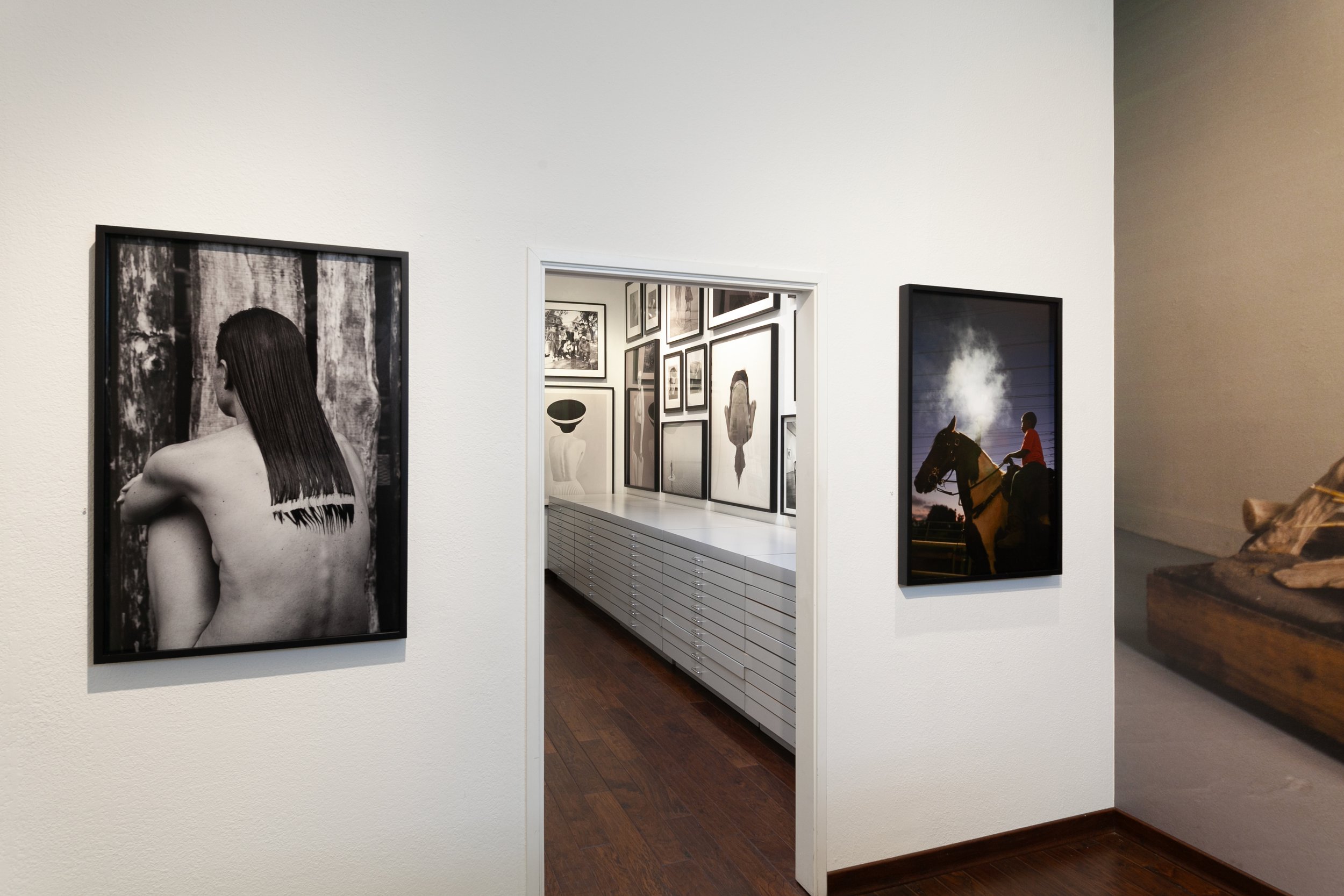

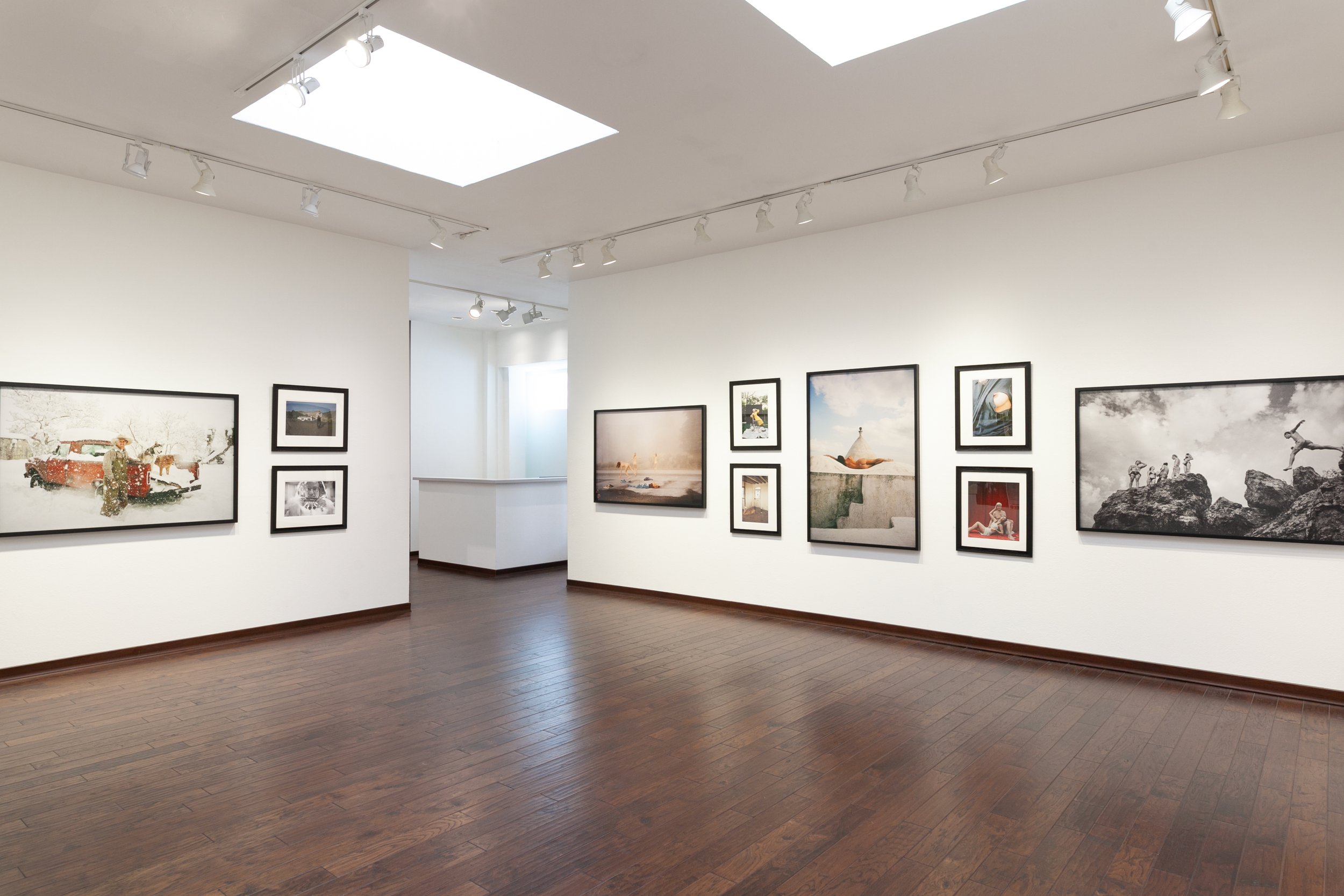
‘Magdalena Wosinska: Fulfill the Dream on display at Fahey/Klein Gallery, Los Angeles’ © Fahey/Klein Gallery, Los Angeles
‘Fulfill the Dream’ launched at Fahey/Klein Gallery in Los Angeles on April 18th; the show will run until June 1st. Magdalena Wosinska’s hardcover monograph, Fulfill the Dream, (Homecoming Gallery, 304 pages), is available for purchase at the gallery while supplies last. For more information about this exhibition and others at The Fahey/Klein Gallery please visit their website here. For a highlight of her book, please visit the Book Highlight section of the magazine here. Magdalena’s interview with the magazine can also be found here. The gallery can also be found on Instagram.
Lucas Arruda : Assum Preto
Lucas Arruda, Untitled (from the Deserto-Modelo series), 2022 © Lucas Arruda. Courtesy the artist and David Zwirner
David Zwirner is pleased to present new work by Brazilian artist Lucas Arruda, on view at the gallery’s 537 West 20th Street location in New York. The exhibition includes paintings and a site-specific light installation from his ongoing Deserto-Modelo series, marking the artist’s fourth solo presentation with the gallery.
Lucas Arruda, Untitled (from the Deserto-Modelo series), 2022 © Lucas Arruda. Courtesy the artist and David Zwirner
Assum Preto continues Arruda’s investigations into the painted medium and its ability to serve as an evocative and transcendental conduit for the unveiling of light, memory, and emotion. The exhibition is titled after a species of blackbird native to eastern Brazil—whose mundane birdsong, according to local tradition, is said to transform into a beautiful melody if the bird’s eyesight has been shaded. As the artist explains: “It’s as if, when the bird has everything in sight, and is full of information and distractions, it can’t organize itself. Only when it’s no longer surrounded by images, can it organize everything in its head. In a certain way, I think this has to do with light.... For me, light is related to remembering.”1 In the works on view, light takes on a multitude of forms, surfacing in various physical, ideographical, and affective manifestations.
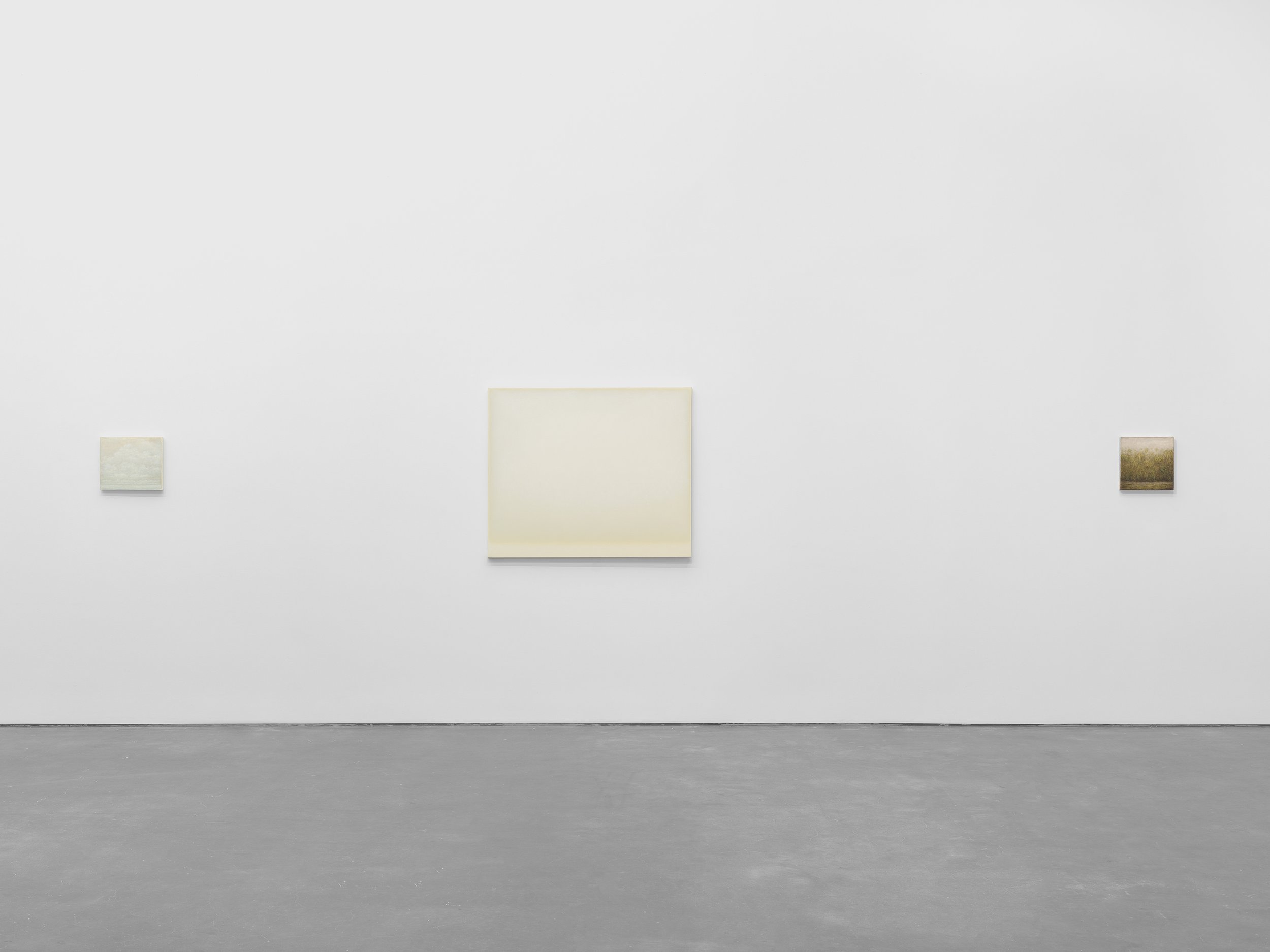
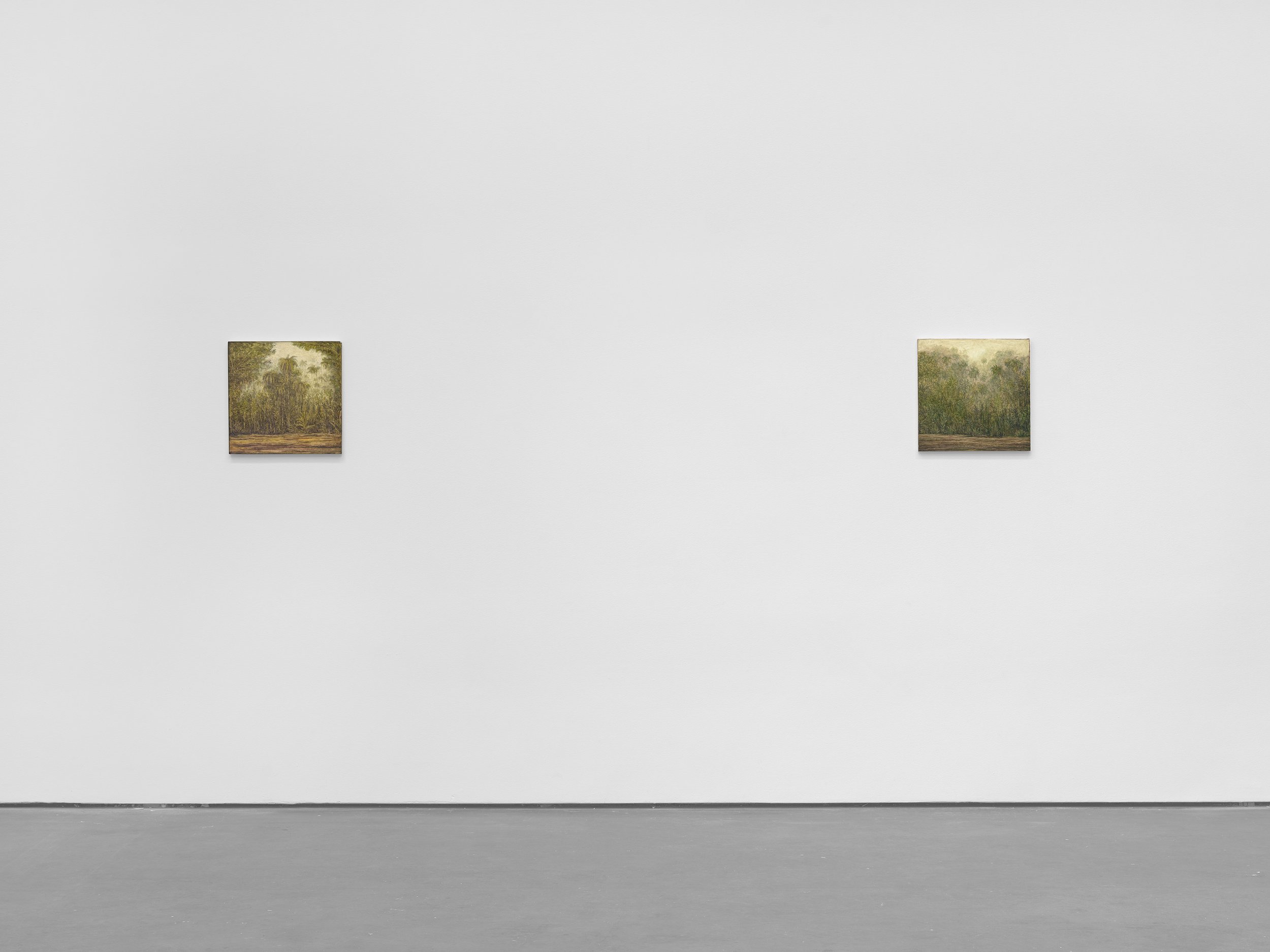
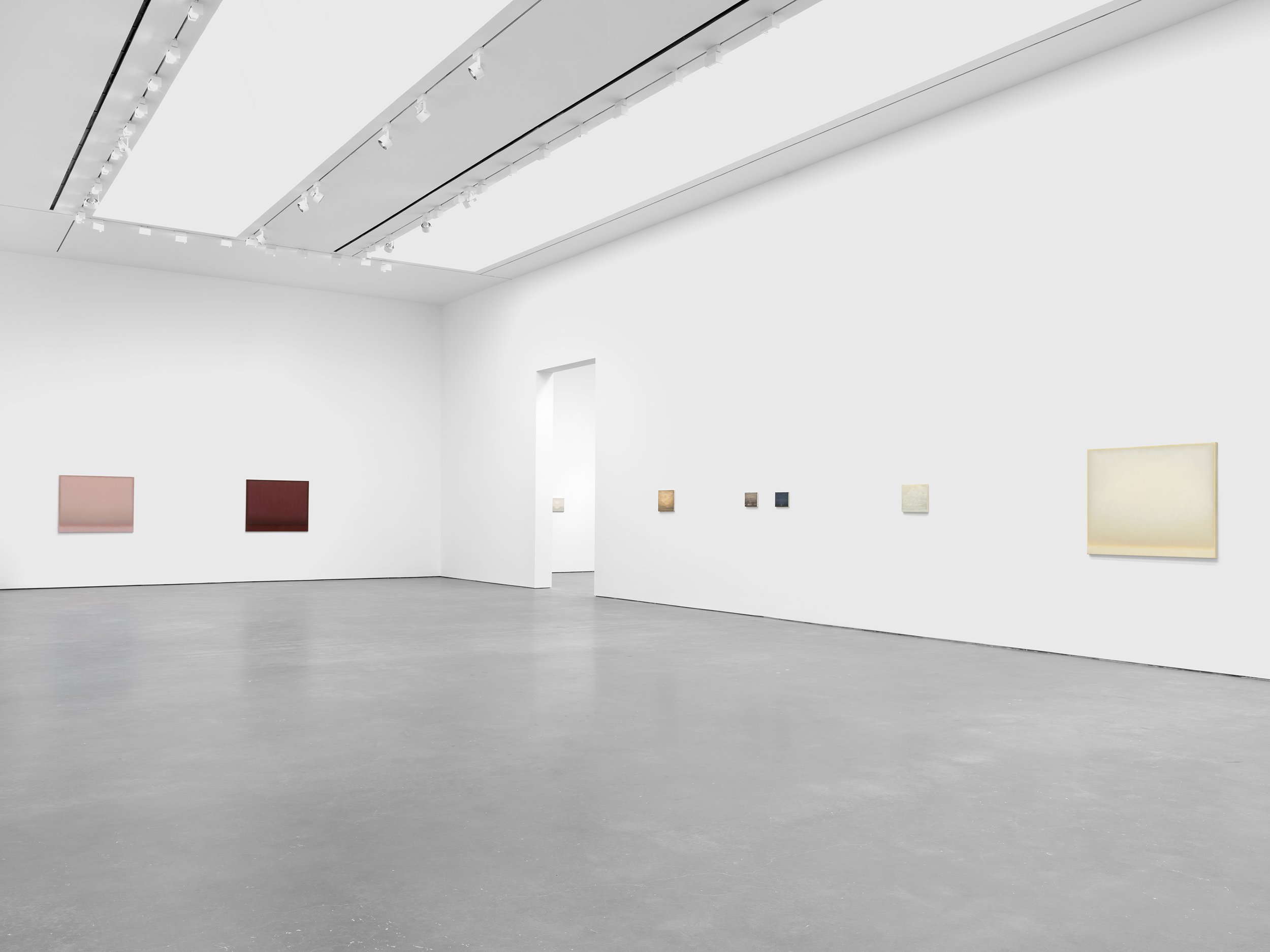

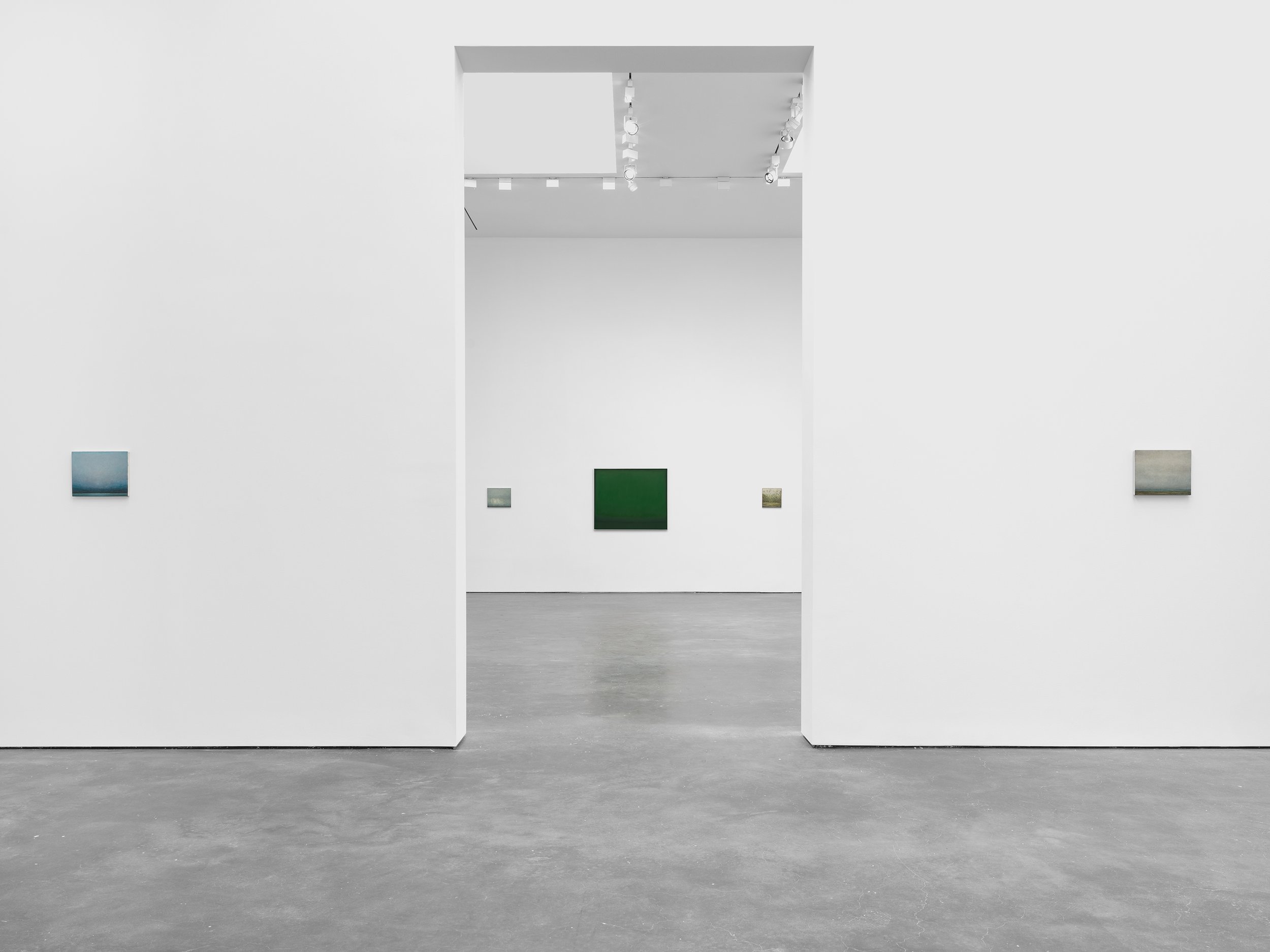
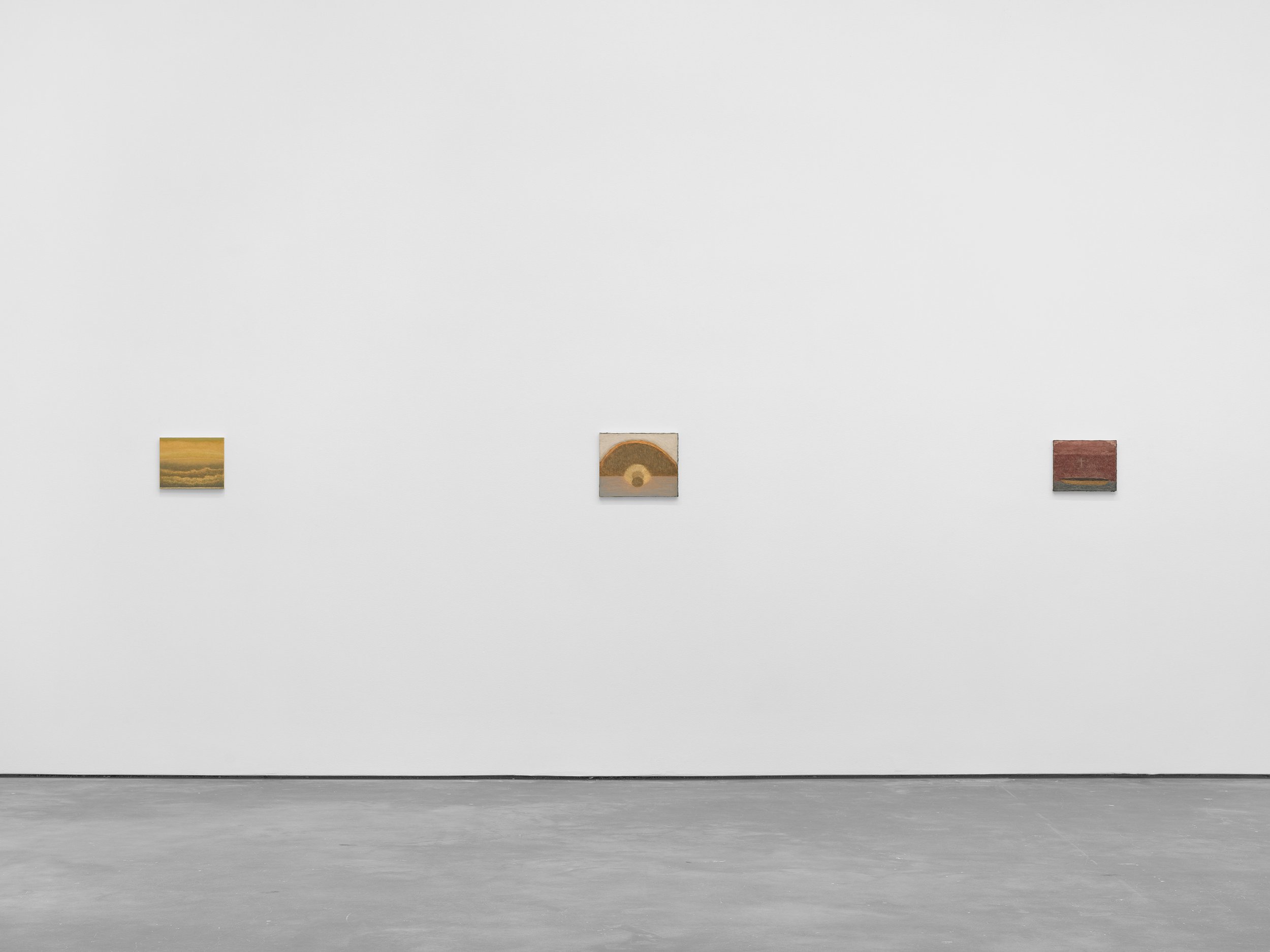
Installation view, Lucas Arruda: Assum Preto, David Zwirner, New York, May 2–June 15, 2024 Courtesy David Zwirner
The exhibition is primarily composed of new paintings from Arruda’s established body of seascapes, junglescapes, and abstract monochromes; together, these works bring about a complex understanding of landscape as a product of a state of mind rather than a depiction of reality. The works on view are notable for their fogged colors—exploring subtle but intricate variations within a single hue—that range from dense reds to ethereal and almost intangible veils of white. For the monochromes, Arruda adds layer upon layer of pigment to pre-dyed raw canvas in an attempt to replicate its tinted hue in paint, methodically returning to each work for weeks or even months on end until the composition slowly builds into a hazy and ever-shifting wall of light.
Lucas Arruda, Untitled (from the Deserto-Modelo series), 2023 © Lucas Arruda. Courtesy the artist and David Zwirner
The seascapes and junglescapes, on the other hand, are made on prepared surfaces using a reductive process whereby the impression of light is attained through the subtraction of pigment. Devoid of specific reference points, Arruda’s seascapes are all grounded only by their thin horizon lines. Above and below this border, charged atmospheric conditions engage further dichotomies between sky and earth, the nebulous and the solid, the psychic and the visual. The jungles, by contrast, dwell in verticality; their genesis lies in the artist’s formative memories of the verdant foliage outside his bedroom window. For Arruda, the quasi-mythical scenery of the Brazilian rainforest coaxes out tensions between reality and human imagination. Towering and impenetrable, yet containing a sense of the infinite that surpasses its physical bounds, in Arruda’s work the jungle becomes a site of power and enlightenment as much as it is a harbinger of darkness and uncertainty—a place where one can be lost to the world and find themselves again.
Lucas Arruda, Untitled (from the Deserto-Modelo series), 2023 © Lucas Arruda. Courtesy the artist and David Zwirner
As curator Lilian Tone writes: “[Arruda’s] paintings suggest a tenuous, fugitive, and mediated relation to nature as that which informs an aesthetic language. As viewers, we tend to make sense of the slightest mark within an open field, to immediately perceive a horizontal line as a horizon line, to create clouds from a change in direction of brushstrokes, and to perceive ground from a thick impasto. Arruda makes paintings we experience as at once beyond abstraction and yet before representation.”2
Lucas Arruda, Untitled (from the Deserto-Modelo series), 2024 © Lucas Arruda. Courtesy the artist and David Zwirner
In Assum Preto, Arruda debuts a group of small-scale, semi-abstract paintings that are constructed from a lexicon of symbolist motifs, marking a new turn in the artist’s practice while also harking back to the planar and architectonic forms that characterize his early oeuvre. In these works, he takes visual cues from the geometries and rich colorscapes found in the Brazilian modernist paintings of José Pancetti (1902–1958), Alfredo Volpi (1896–1988), and Amadeo Luciano Lorenzato (1900–1995). Arruda handles his brush lightly but with intense control, creating clouds and thickets of markings that delicately carve through the painted surface of the canvas in a manner recalling the textures and physicality of intaglio printmaking processes. Potent and open-ended, the symbols and motifs that populate these compositions—darkly brewing storms, empty canoes, and strings of outdoor lights—visualize the themes that permeate Arruda’s body of paintings, including the artist’s own dreams, experiences, and intuitions, through the lens of the sacred and the surreal. The images shift in and out of focus, as if hovering at the precipice of memory itself.
Lucas Arruda, Untitled (from the Deserto-Modelo series), 2024 © Lucas Arruda. Courtesy the artist and David Zwirner
Additionally featured is an example of Arruda’s site-specific light installations. These works comprise a pair of vertically balanced rectangles rendered directly on the gallery wall—the top one created through a light projection and the bottom one physically applied with paint—thus translating the genre of landscape into its most elemental form.
Born in São Paulo, Brazil, Lucas Arruda (b. 1983) received his BFA from Faculdade Santa Marcelina, São Paulo, in 2009. In 2023, Arruda’s work was on view in Assum Preto, a site-specific solo exhibition, curated by Hans Ulrich Obrist, that was presented in the library of the Ateneo de Madrid. A solo exhibition of the artist's work, Lugar sem Lugar, was on view at Fundação Iberê Camargo, Porto Alegre, Brazil, in 2021, and traveled to Instituto Tomie Ohtake, São Paulo, in 2022. The artist’s first large-scale institutional solo show, Deserto-Modelo, was on view at the Fridericianum, Kassel, Germany, in 2019. Arruda’s work has also been included in numerous prominent group exhibitions worldwide, including 38° Panorama da
Lucas Arruda, Untitled (from the Deserto-Modelo series), 2023 © Lucas Arruda. Courtesy the artist and David Zwirner
Arte Brasileira: 1000°, Museu de Arte Moderna, São Paulo (2024); Liquid Intelligence, Museo Nacional Thyssen-Bornemisza, Madrid (2023); Natureculture, Fondation Beyeler, Basel (2021); and Luogo e Segni, Punta della Dogana, Venice (2019).
In 2018, a monograph on the artist was published by Éditions Cahiers d’Art, Paris, with texts by Fernanda Brenner, Chris Sharp, and Hans Ulrich Obrist. In 2020, David Zwirner Books published a comprehensive monograph on Arruda’s work, with texts by Will Chancellor and Barry Schwabsky. In 2022, the Fridericianum, Kassel, published an accompanying catalogue to the artist’s 2019 solo exhibition, with texts by Vincenzo de Bellis, Fernanda Brenner, Marlene Bürgi, Lilian Tone, Theodora Vischer, and Moritz Wesseler.
Arruda’s work has been represented by David Zwirner since 2018, and he has had three prior solo exhibitions with the gallery in London (2017), New York (2019), and Paris (2022).
Lucas Arruda, Untitled (from the Deserto-Modelo series), 2023 © Lucas Arruda. Courtesy the artist and David Zwirner
His work is included in the permanent collections of the Art Institute of Chicago; Buffalo AKG Art Museum, Buffalo, New York; Centre Pompidou, Paris; Fondation Beyeler, Basel; Fondazione Sandretto Re Rebaudengo, Turin; Hirshhorn Museum and Sculpture Garden, Washington, DC; Institute of Contemporary Art, Miami; J. Paul Getty Museum, Los Angeles; Museo Jumex, Mexico City; K11 Art Foundation, Hong Kong; Kunstmuseum Den Haag, The Hague, the Netherlands; Long Museum, Shanghai; Moderna Museet, Stockholm; Museo Thyssen-Bornemisza, Madrid; Museum of Fine Arts, Boston; Museum Ludwig, Cologne; Pérez Art Museum, Miami; Pinacoteca do Estado de São Paulo; Pinault Collection, Paris; Rockbund Art Museum, Shanghai; Solomon R. Guggenheim Museum, New York; Stedelijk Museum, Amsterdam; Tate, United Kingdom; and the Walker Art Center, Minneapolis. Arruda lives and works in São Paulo.
Lucas Arruda, Untitled (from the Deserto-Modelo series), 2022 © Lucas Arruda. Courtesy the artist and David Zwirner
The exhibition opened at the New York location, 537 West 20th Street on May 2nd and will conclude on June 15, 2024. For more information about this exhibit, visit David Zwirner’s site; you can also follow them on Instagram and find the gallery on Artsy here.
Footnotes:
1 Lucas Arruda, “Lucas Arruda in conversation with Hans Ulrich Obrist,” in Lucas Arruda: Assum Preto. Exh. cat. (Madrid: Ateneo de Madrid and Fundación Sandretto Re Rebaudengo, 2022), p. 22.
2 Lilian Tone, “Painting as Liminality,” in Lucas Arruda: Deserto-Modelo. Exh. cat. (Kassel/Cologne: Museum Fridericianum and Buchhandlung Walther König, 2022), p. 149.
Amadeo Luciano Lorenzato
Amadeo Luciano Lorenzato, Sem título (Untitled), 1972. Courtesy David Zwirner
Amadeo Luciano Lorenzato Self-taught painter and sharpshooter
Submits to no school
Nor to this or that trend
Belongs to no clique
Paints whatever tickles his fancy
Amen
— Amadeo Luciano Lorenzato, 1948 1
David Zwirner is pleased to present an exhibition of paintings by Brazilian artist Amadeo Luciano Lorenzato (1900–1995), on view at the gallery’s East 69th Street location in New York. Marking Lorenzato’s second solo exhibition with the gallery and the second solo presentation of the artist’s work in the United States, this exhibition will coincide with his inclusion in the 60th Venice Biennale, organized by curator Adriano Pedrosa (April 20–November 24, 2024).
Among the foremost Brazilian artists of his generation, Lorenzato developed a singular body of paintings centered on his fastidious observations of the everyday subjects he encountered in his hometown of Belo Horizonte—including favelas, semi-urban landscapes, and scenes of agriculture and rural industry.
Lorenzato’s distinctive compositions are characterized by reduced geometric forms and densely textured surfaces that the artist achieved through the use of richly colored self-made pigments applied with brushes and enhanced with combs and forks. Imbued with an assured freedom of expression, these canvases masterfully capture the vitality of the artist’s surroundings as well as the colors and textures of the natural world. As Rodrigo Moura, Lorenzato scholar and chief curator at El Museo del Barrio, New York, notes, “Lorenzato’s paintings are not only born out of the desire to construct his own reality but also to contain the other dimensions that coexist within it, such as gesture, nature, and silence.” 2
Installation view, Amadeo Luciano Lorenzato, David Zwirner, New York, April 11–May 25, 2024. Courtesy David Zwirner
Spanning the last three decades of Lorenzato’s career, the paintings in this exhibition embody many of the primary concerns of the artist’s mature oeuvre, both in subject matter and form. Depicting scenes ranging from vast rural horizons of sun, sky, and land to close-up nature studies wherein tree branches or a single plant fill the entire picture plane, these works exemplify the artist’s restrained formal approach combined with his signature treatment of texture and color. Also on view will be contemplative still lifes and pastoral figurative scenes whose subject matter points to more personal, domestic aspects of Lorenzato’s practice while continuing the artist’s formal explorations of pattern and surface.
Writing on Lorenzato’s works, art historian Claudia Giannetti Nölle observes, “Especially through his ability to represent reality, he is able to transform or metamorphose elements of nature or human figures, conferring upon them a magical quality that can only be achieved through genuine abstraction of real forms and figures. His method of capturing everyday life and expressing it in drawings or oil paintings goes well beyond mere simplification.… The image seems to go through a process of distillation. He eschews finer details and focuses instead on the essential lines which make up the image he observes. The same can be said about his use of color.” 3
Installation view, Amadeo Luciano Lorenzato, David Zwirner, New York, April 11–May 25, 2024. Courtesy David Zwirner
Seen together, these works express an important crosscurrent between Brazilian art and broader modernist movements of the twentieth century. While he kept on hand a worn copy of painter Giorgio Vasari’s (1511–1574) famous book on Italian artists and was known to express admiration for painters such as Cézanne, Van Gogh, Monet, and Manet, Lorenzato operated as a singular and distinctly Brazilian artist—with European roots. Lorenzato’s practice was an amalgamation of Brazilian styles and a unique take on the influence of European art. In this way, his work is linked to the ideology of antropófago (anthropophagy), invented by poet Oswald de Andrade and inspired by a 1928 painting by Brazilian artist Tarsila do Amaral (1886–1973). Like Amaral, Lorenzato heeded European styles while avoiding any direct influences—in some ways anticipating the tropicália artistic movement that emerged in the late 1960s.
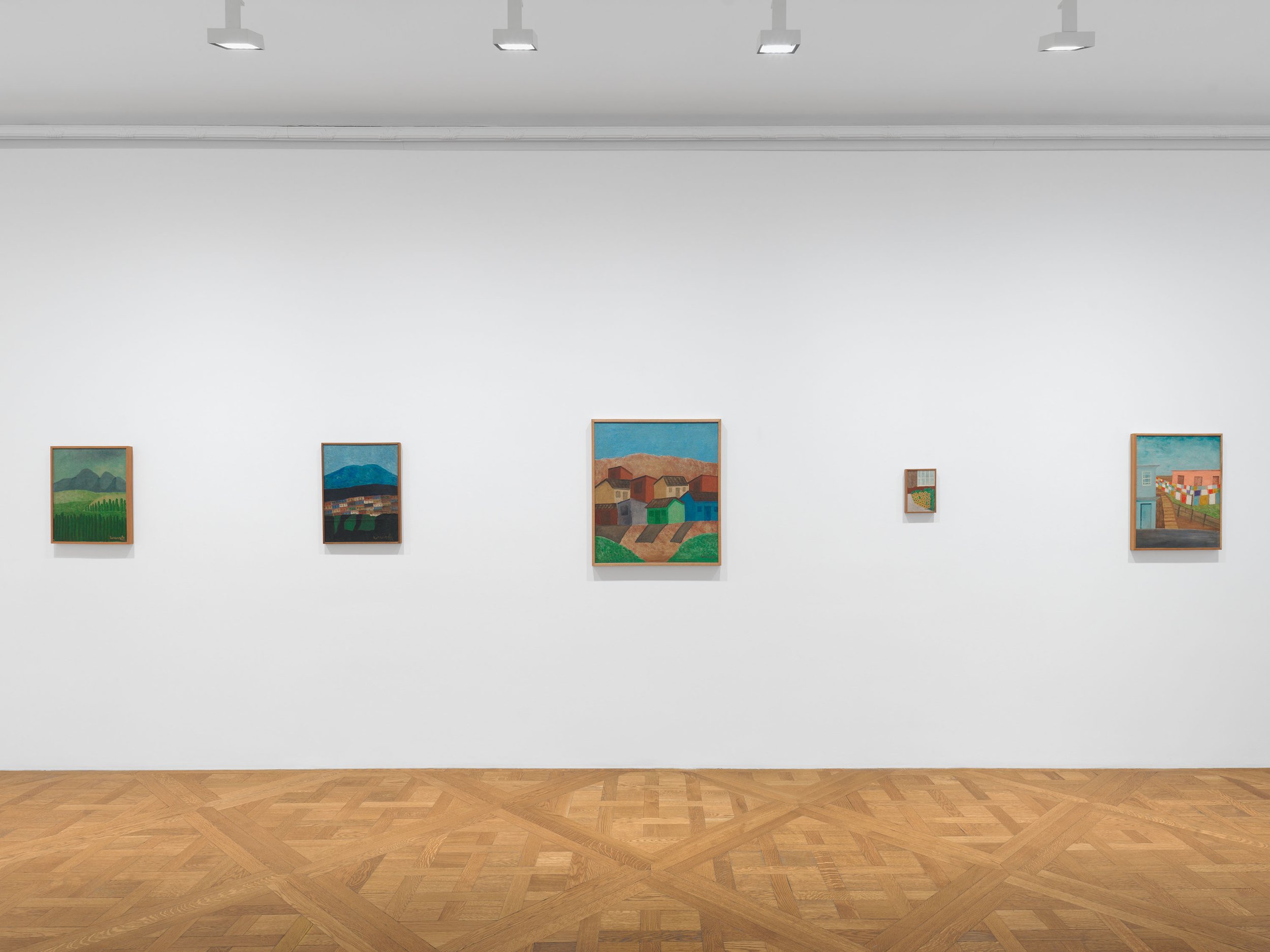
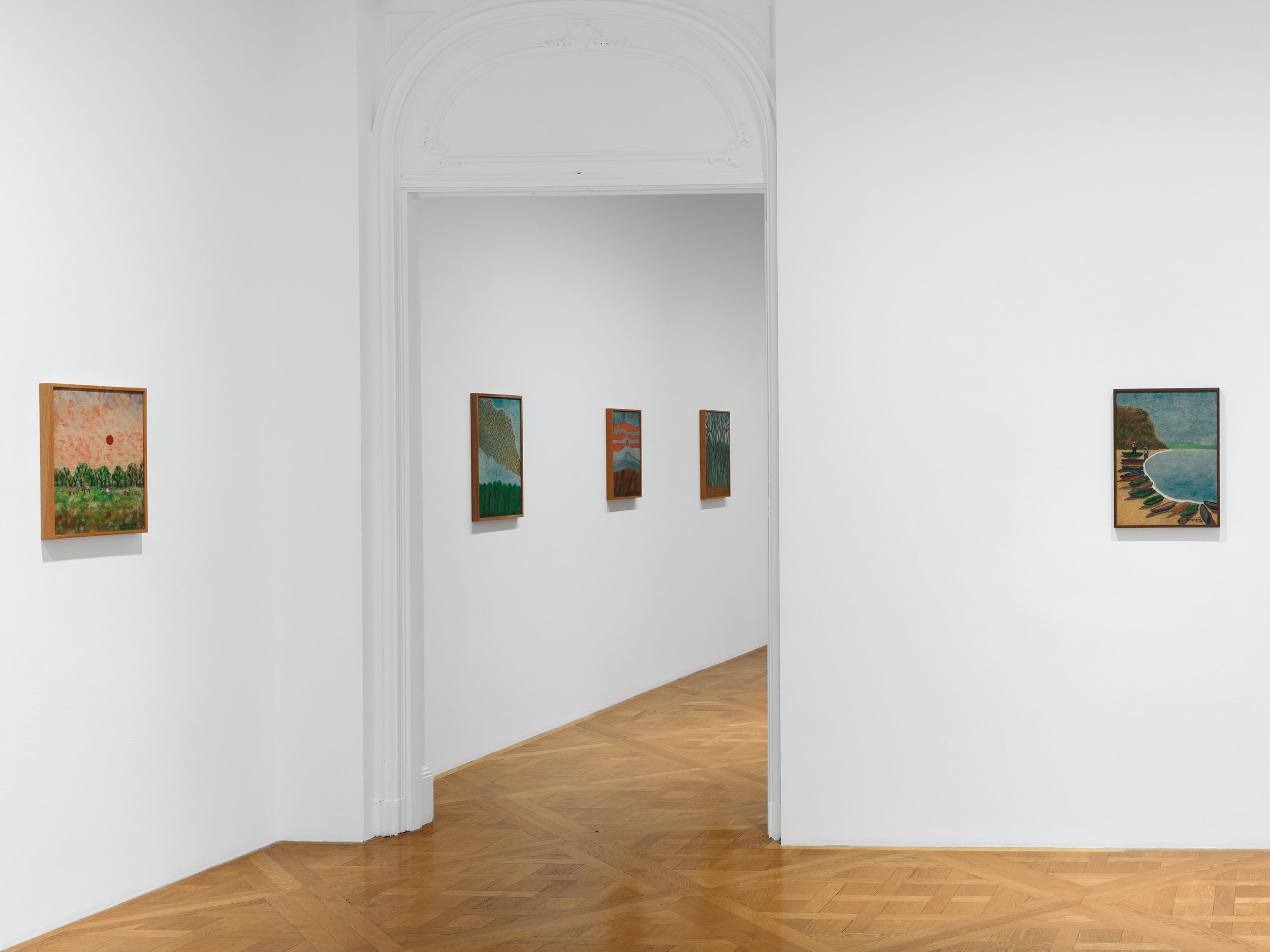
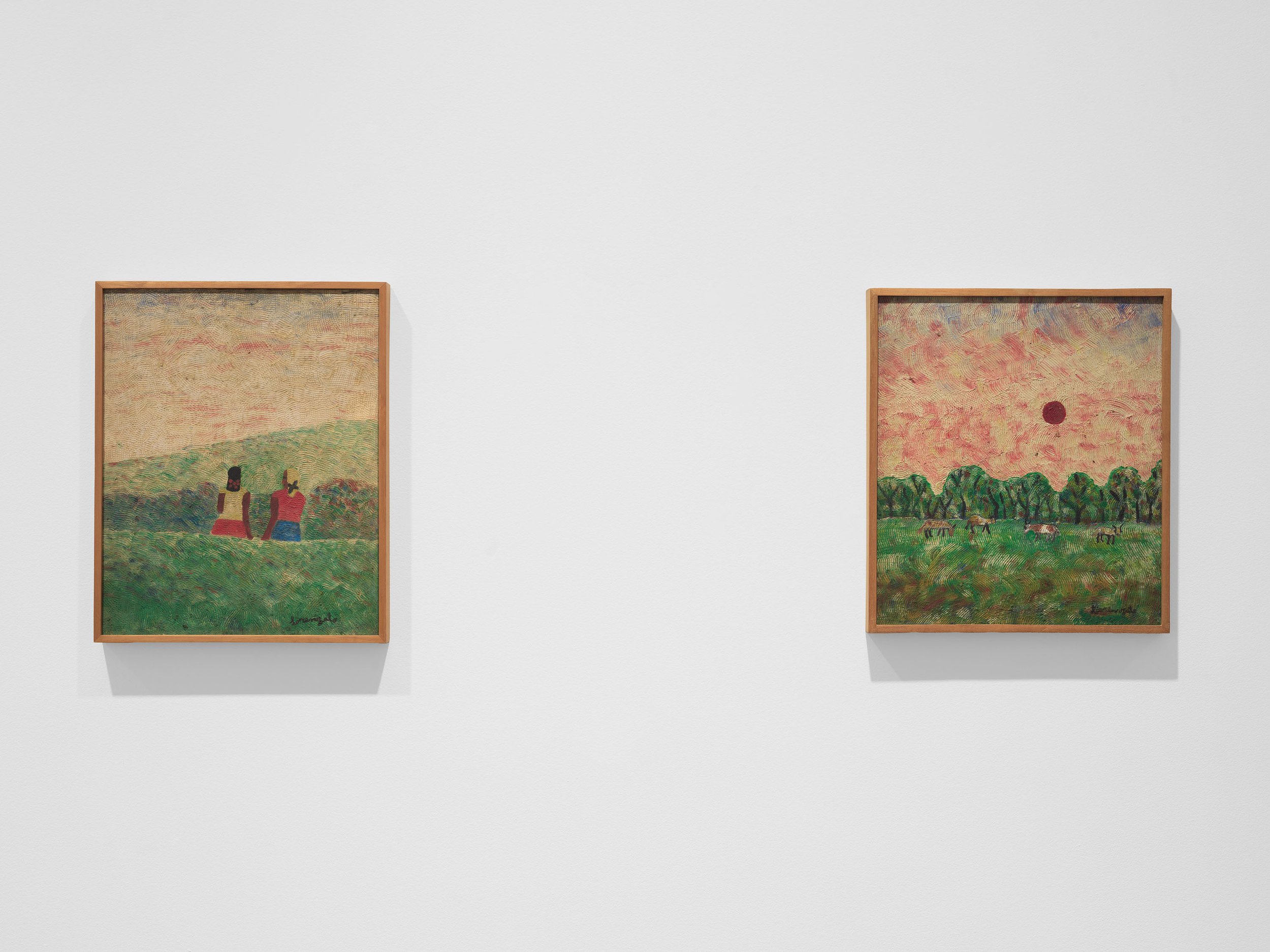
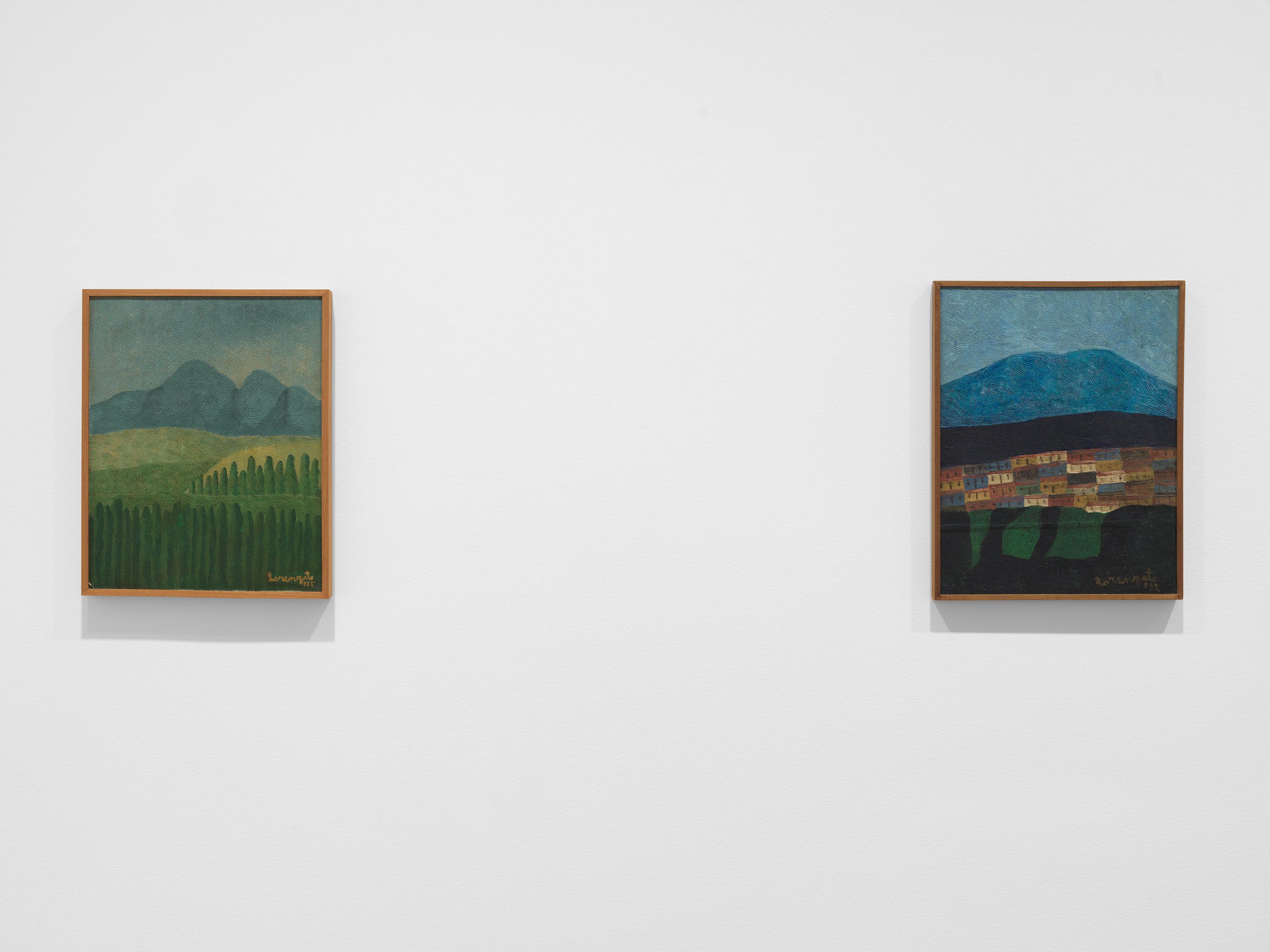
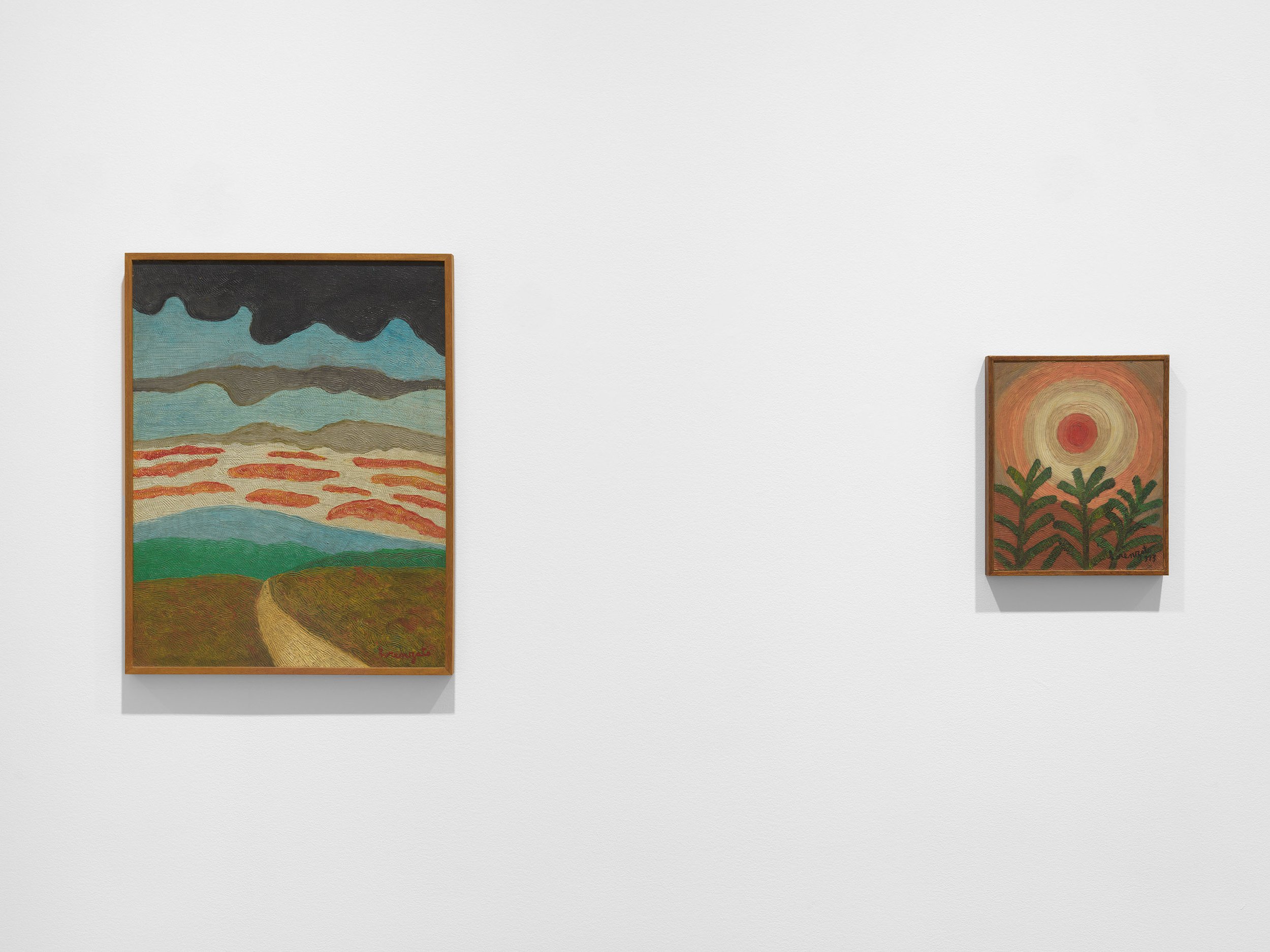
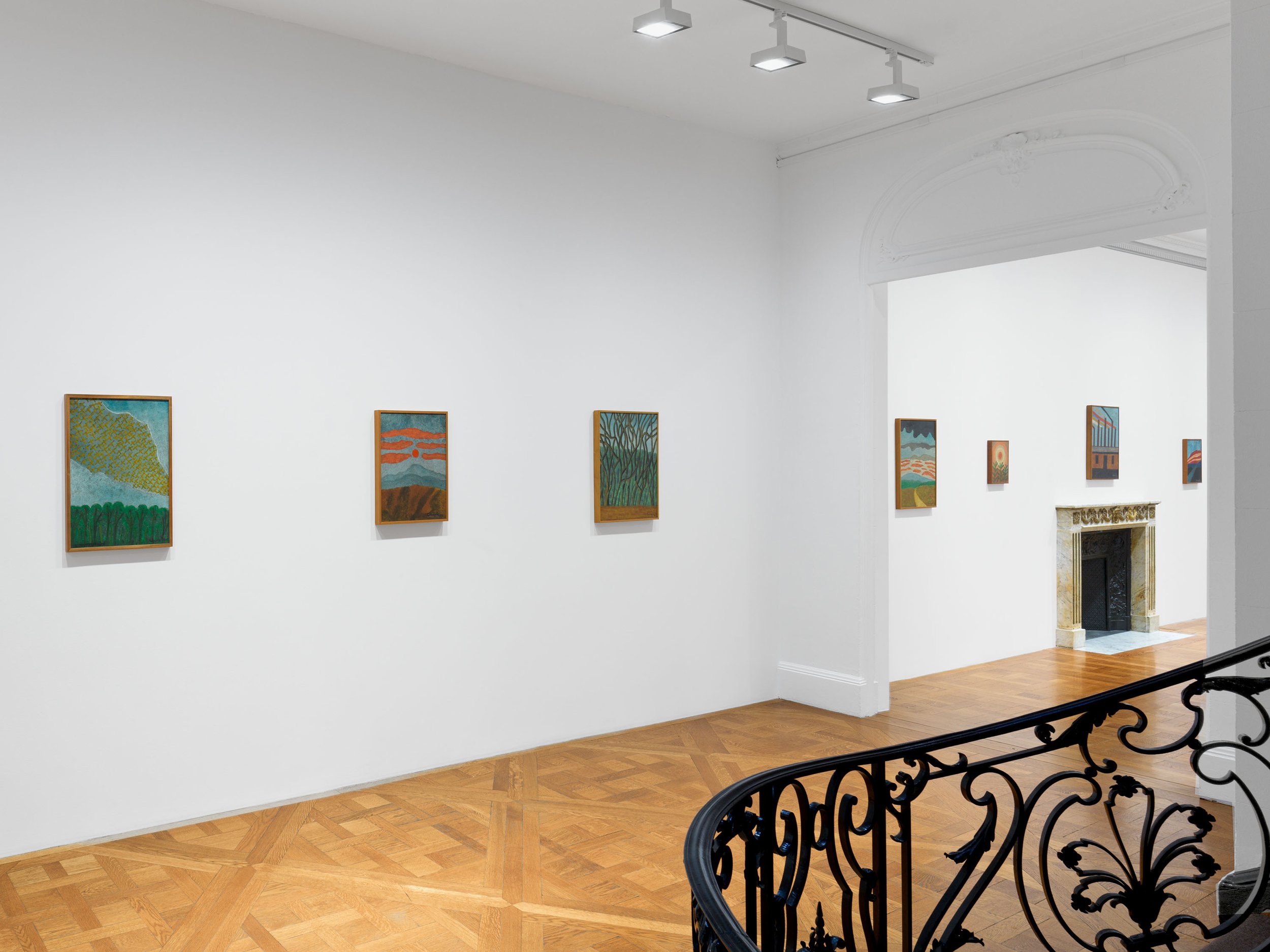
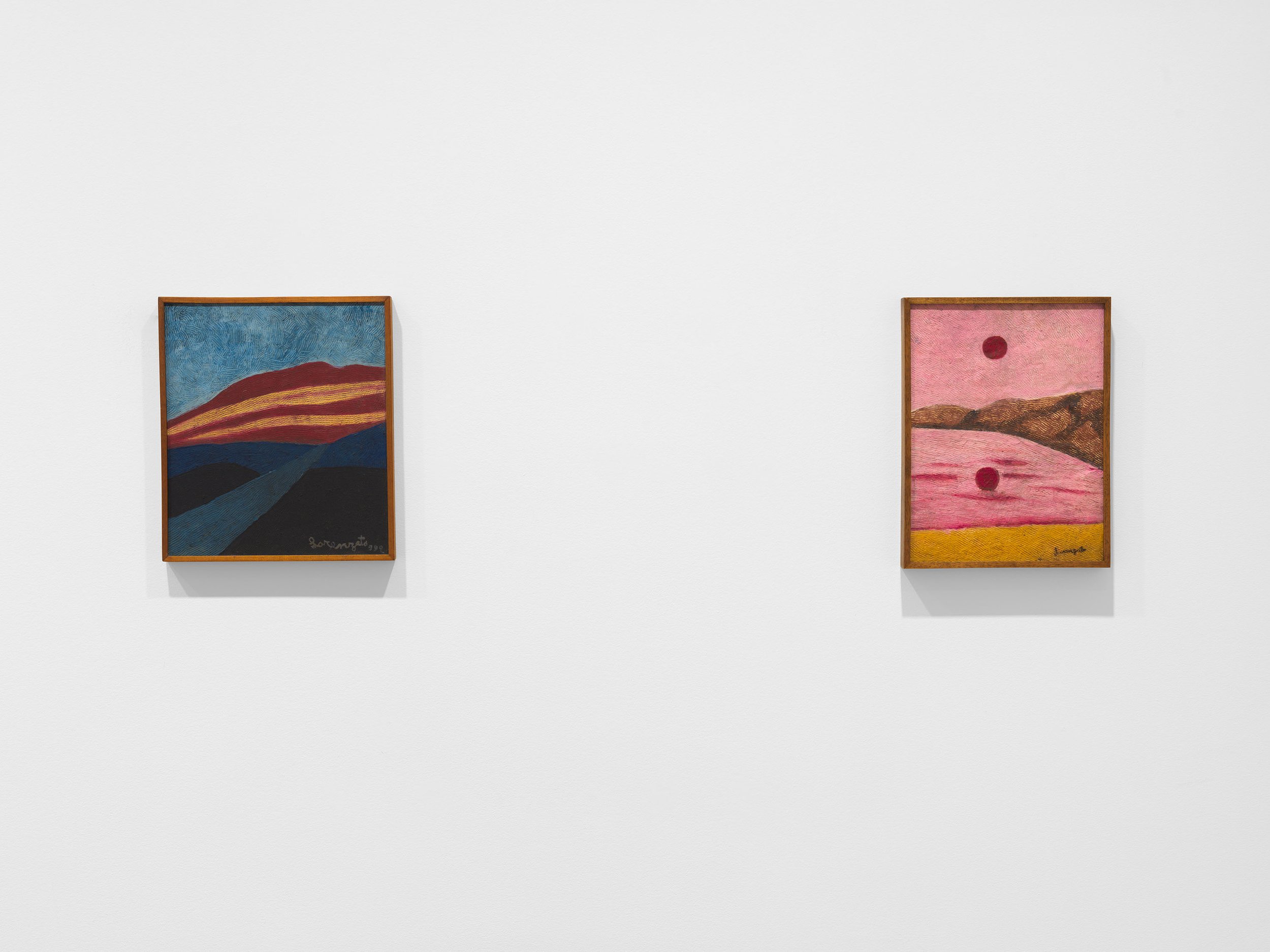
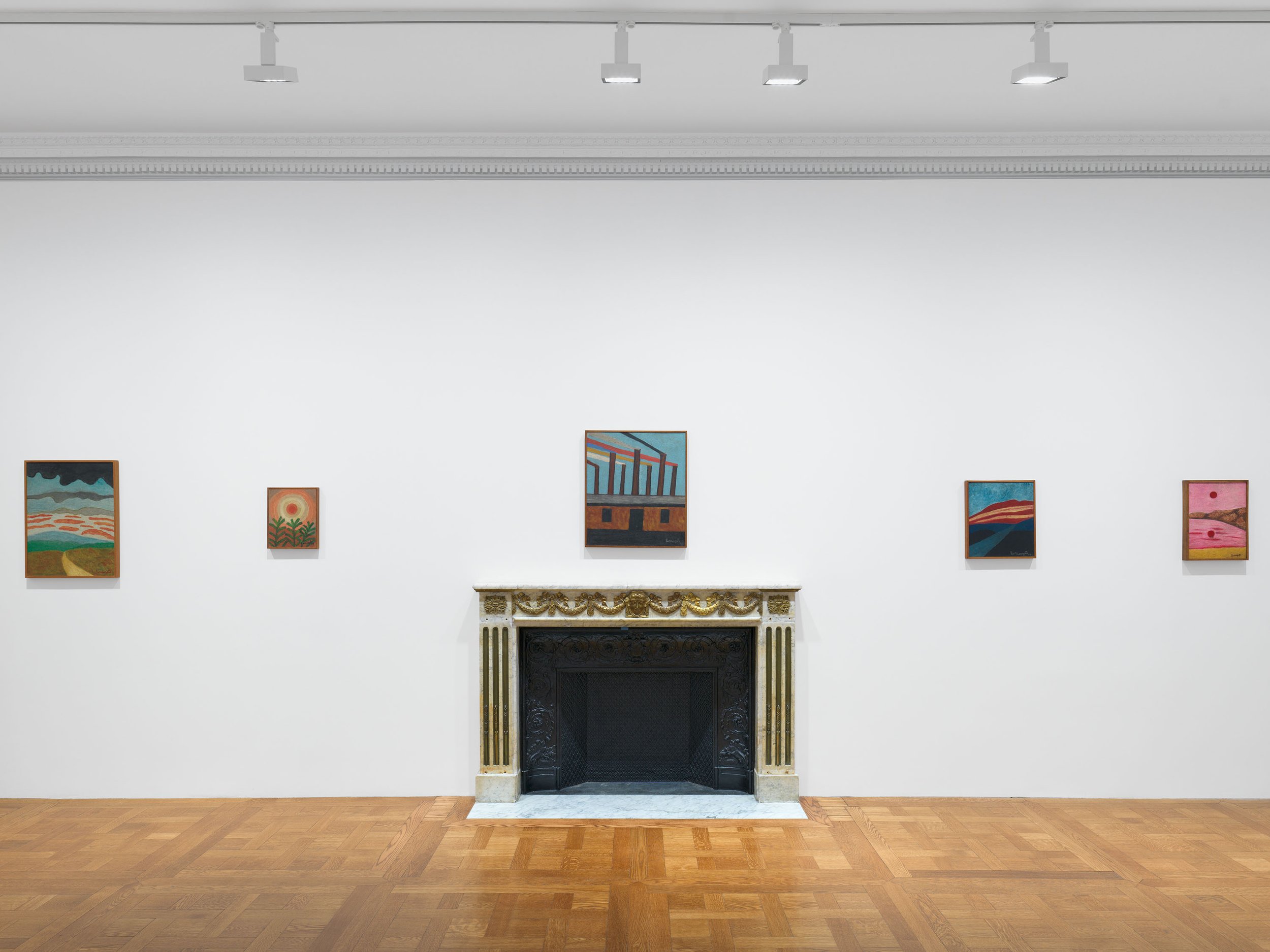

Installation view, Amadeo Luciano Lorenzato, David Zwirner, New York, April 11–May 25, 2024. Courtesy David Zwirner
Often using geometric shapes to suggest objects in real space, in his paintings Lorenzato shows a visual parallel to the work of Italian-born Brazilian modernist painter Alfredo Volpi (1896–1988), who similarly emphasized a deep rootedness in a Brazilian culture through painting everyday subjects, in São Paulo. Lorenzato’s position as a working-class artist—an atypical identity in Brazilian cultural circles until the later decades of the twentieth century—set him apart, both for his perspective on the rural vernacular and for his influence on local contemporaries. Legendary in his hometown, Lorenzato’s work was collected by fellow artists in Belo Horizonte, who introduced it to new audiences in São Paulo when they moved to the urban center in the 1990s, bringing wider awareness to the artist’s oeuvre. Recent critical and institutional attention to Lorenzato’s work has expanded the appreciation of his art far beyond the 3 Claudia Giannetti Nölle, Lorenzato: 90 Años. Exh. cat. (Belo Horizonte: Manoel Macedo Galeria de Arte, 1990), n.p. 2 Moura, Lorenzato, p. 31. regional recognition it received during his lifetime. This exhibition celebrates Lorenzato’s contribution to a global modernist canon, in which the nuances and textures of the artist’s intimate compositions can be considered alongside the universality of his colorful language.
Amadeo Luciano Lorenzato was born in 1900 to Italian parents who immigrated to Brazil in the last decade of the nineteenth century. In 1920, the artist moved with his parents to Italy, where he worked various construction and painting jobs on and off throughout Europe. Though he studied for a brief period at the Reale Accademia delle Arti in Vicenza, in 1925, Lorenzato was mostly self-taught, and he developed his technical proficiency in painting through a job restoring frescoes in Rome, having previously worked as a mural painter in Brazil.
Installation view, Amadeo Luciano Lorenzato, David Zwirner, New York, April 11–May 25, 2024. Courtesy David Zwirner
Lorenzato permanently returned to Belo Horizonte in 1948, and after sustaining an injury to his leg in 1956, he committed himself to painting full time. In 1964, he had his first solo exhibition at the Minas Tênis Clube in Belo Horizonte, followed by his inclusion in two group shows there the following year and a second solo exhibition in 1967. In the decades following, his work was exhibited in solo and group exhibitions in Brazil, including a retrospective exhibition at the Museu de Arte da Pampulha, Belo Horizonte, in 1995—the year of the artist’s death. In 1972, Lorenzato represented Brazil in the 3rd Triennial of Self-Taught Art in Bratislava, Czechoslovakia.
In 2019, Lorenzato’s first solo exhibition outside of Brazil was presented at David Zwirner London. In 2022, the artist’s work was included in the major group exhibition Histórias Brasileiras at Museu de Arte de São Paulo, curated by Adriano Pedrosa, which was part of a two-year program at the museum celebrating the bicentennial of Brazilian independence. Lorenzato is included in the 60th Venice Biennale, Stranieri Ovunque – Foreigners Everywhere, organized by Pedrosa and on view from April 20 to November 24, 2024.
Lorenzato’s work is represented in public collections internationally, including Fundação Clóvis Salgado, Belo Horizonte; Museu de Arte da Pampulha, Belo Horizonte; Museu de Arte de São Paulo; Nouveau Musée National de Monaco; Pinacoteca de São Paulo; and Universidade Federal de Viçosa, Brazil.
In 2023, with the support of Brazilian cultural institute Itaú Cultural, the Projeto Lorenzato was established with the mission of identifying and digitally cataloguing the artist’s work.
This exhibition opened on April 11th and will conclude on May 25, 2024. It is featured at 34 East 69th Street, New York. For more information about this exhibit, visit David Zwirner’s site; you can also follow them on Instagram and find the gallery on Artsy here.
Footnotes:
1 Amadeo Luciano Lorenzato, 1948, cited in Rodrigo Moura, Lorenzato, trans. Pedro Vainer (New York and São Paulo: KMEC Books/Ubu Editora, 2023), p. 14.
2 Moura, Lorenzato, p. 31
3 Claudia Giannetti Nölle, Lorenzato: 90 Años. Exh. cat. (Belo Horizonte: Manoel Macedo Galeria de Arte, 1990), n.p
The Yearlings by Kira Maria
Installation Views: Kira Maria Shewfelt, The Yearlings, Make Room Los Angeles © Kira Maria Shewfelt Courtesy the artist and Make Room LA
Presented by Make Room, The Yearlings by Kira Maria Shewfelt is a solo exhibition devoted to moments of becoming. The exhibition opened on April 20 and will conclude on May 24, 2024. In each painting, figures of lovers and children, horses and butterflies alike, convene, sharing touch or experience in scenes the artist describes as moments of “high transference and action”— and so, touch is a relational reminder, a promise that we are bound together, interconnected through our relationships, with potential for becoming more.
Installation Views: Kira Maria Shewfelt, The Yearlings, Make Room Los Angeles © Kira Maria Shewfelt Courtesy the artist and Make Room LA
Kira Maria’s paintings dispense with artifice and caring too much about the wrong things. Intimacy is a holding, an embrace, a kiss, a touch, but it is also the incremental appearance and shedding of expectations— there is permission to be observed as we really are and to want for more. Intimacy, care, and affection verge close to the goals of art, a meditation on what intuitively moves us. Intimacy is truthful— it is the personal made sublime, an ode to transformative experiences.
Installation Views: Kira Maria Shewfelt, The Yearlings, Make Room Los Angeles © Kira Maria Shewfelt Courtesy the artist and Make Room LA
Gestures and marks are applied so honestly that parts of paintings are rendered nearly translucent. Thin washes of oil paint dapple across a worked and cared for surface and the effect of accumulated layering creates new spaces of depth and richness. Made bold and tender, swiftly with action as with repose, these canvases carry marks of an extended process, holding intuitive making as dearly as the finish.
The artist’s scenes of nature allude to the efforts of 19th century Romanticism, expanding themes of the individual’s relationship with awe and grandeur to encompass the personal and domestic. Amid paintings of home, portraits of friends and lovers, and natural wonders, we experience splendor through color and gestural impressions. These artworks assign significance to the sensual, affective, and deeply connected, a testament to holding close spectacular moments, wherever we may find them.
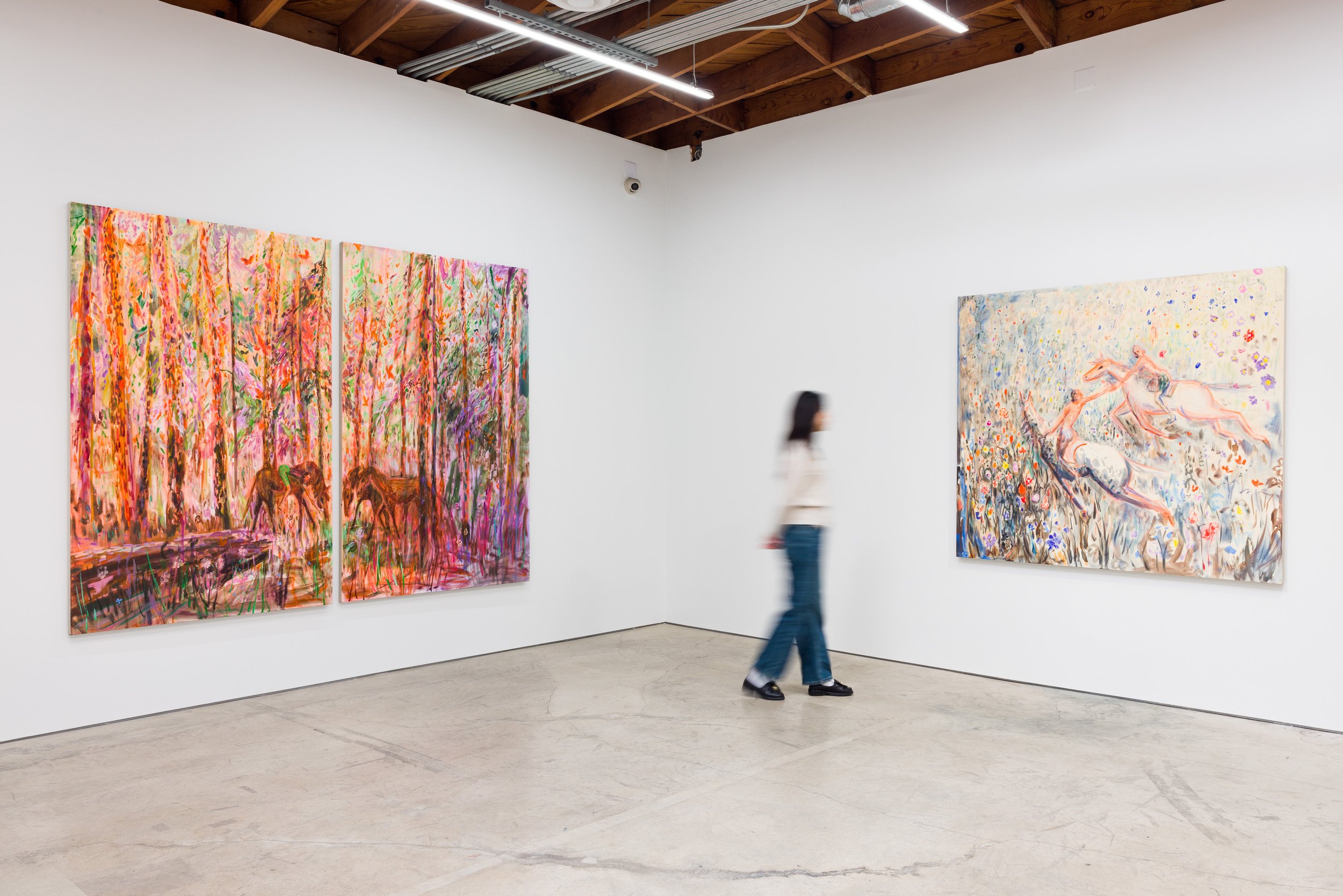

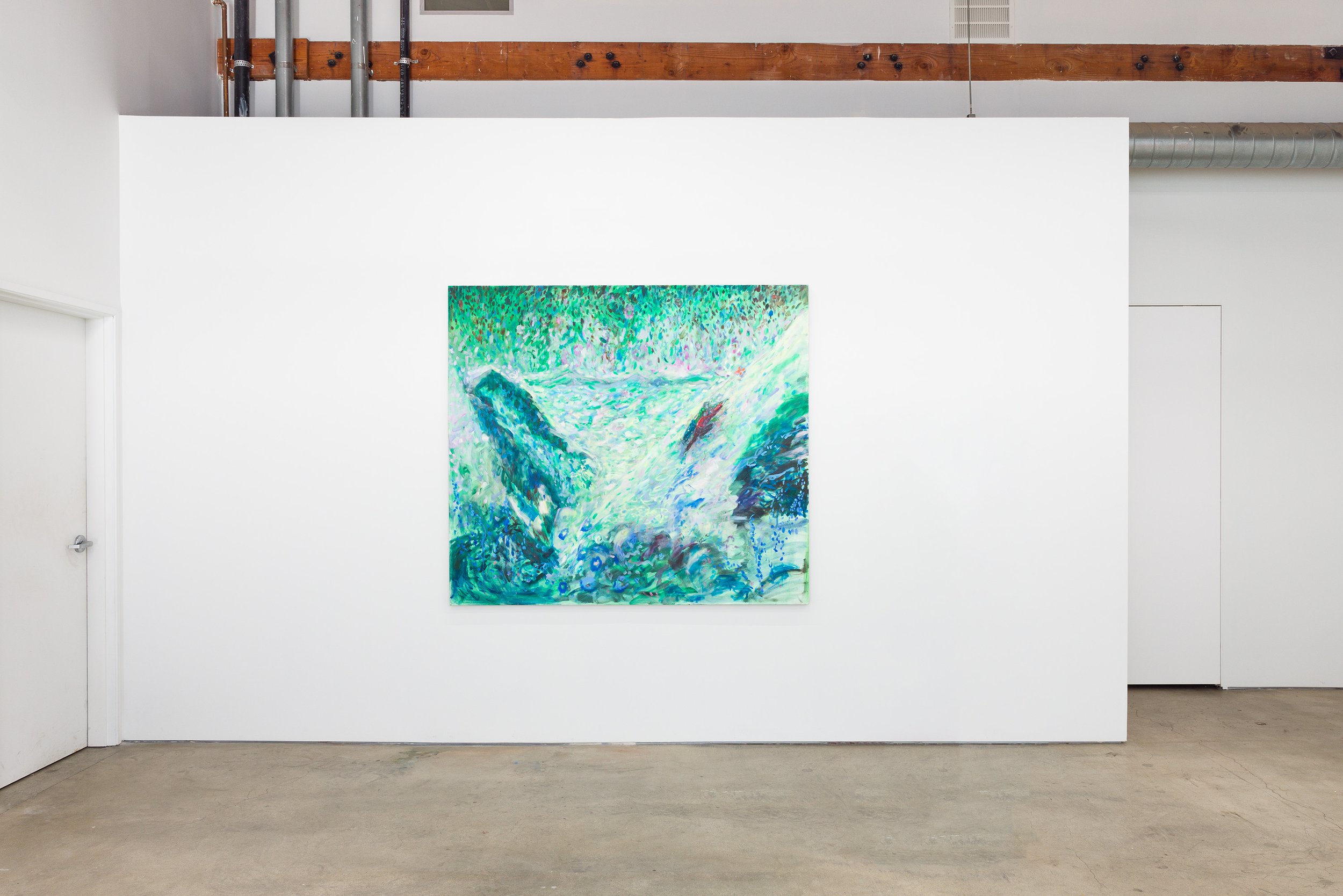
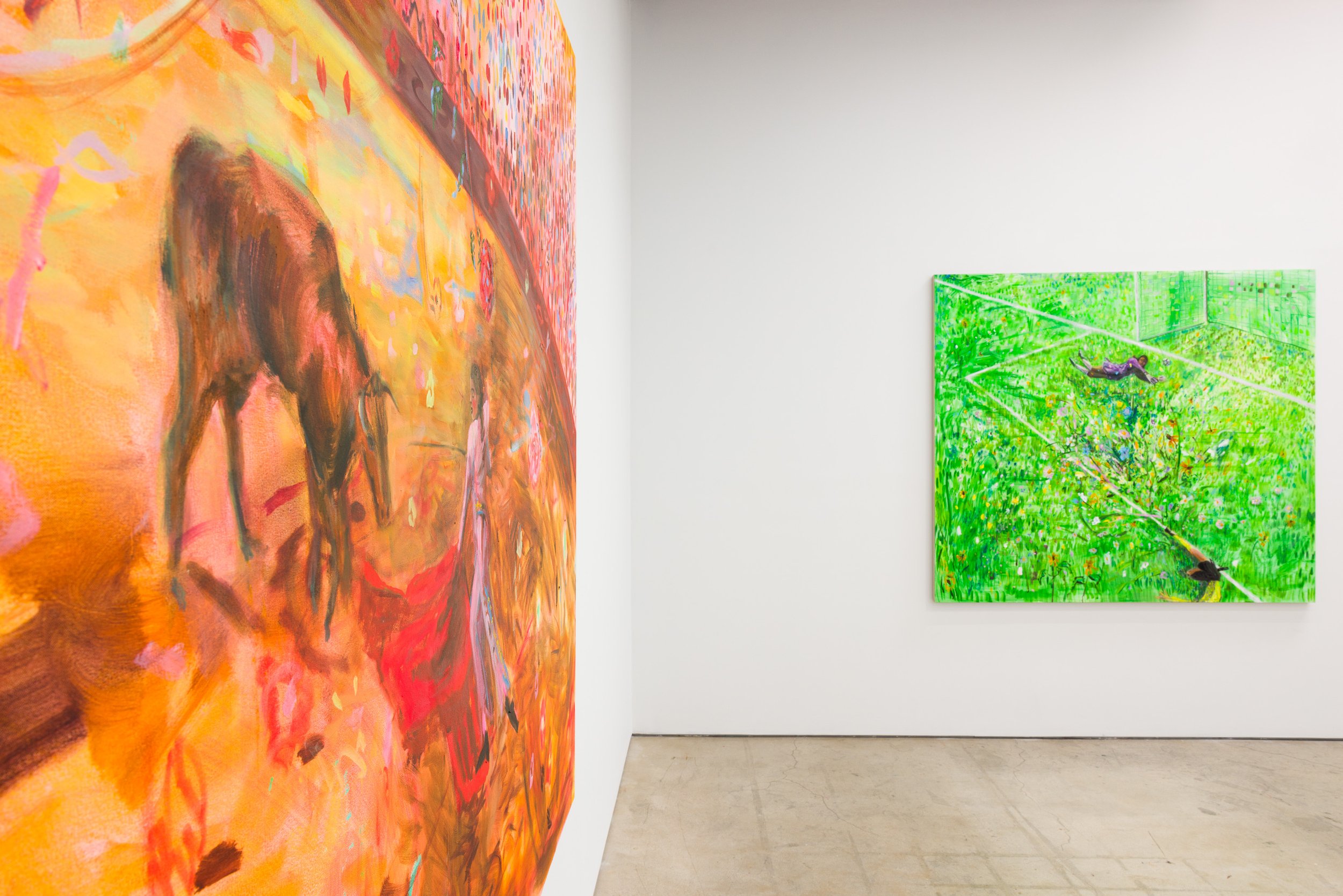
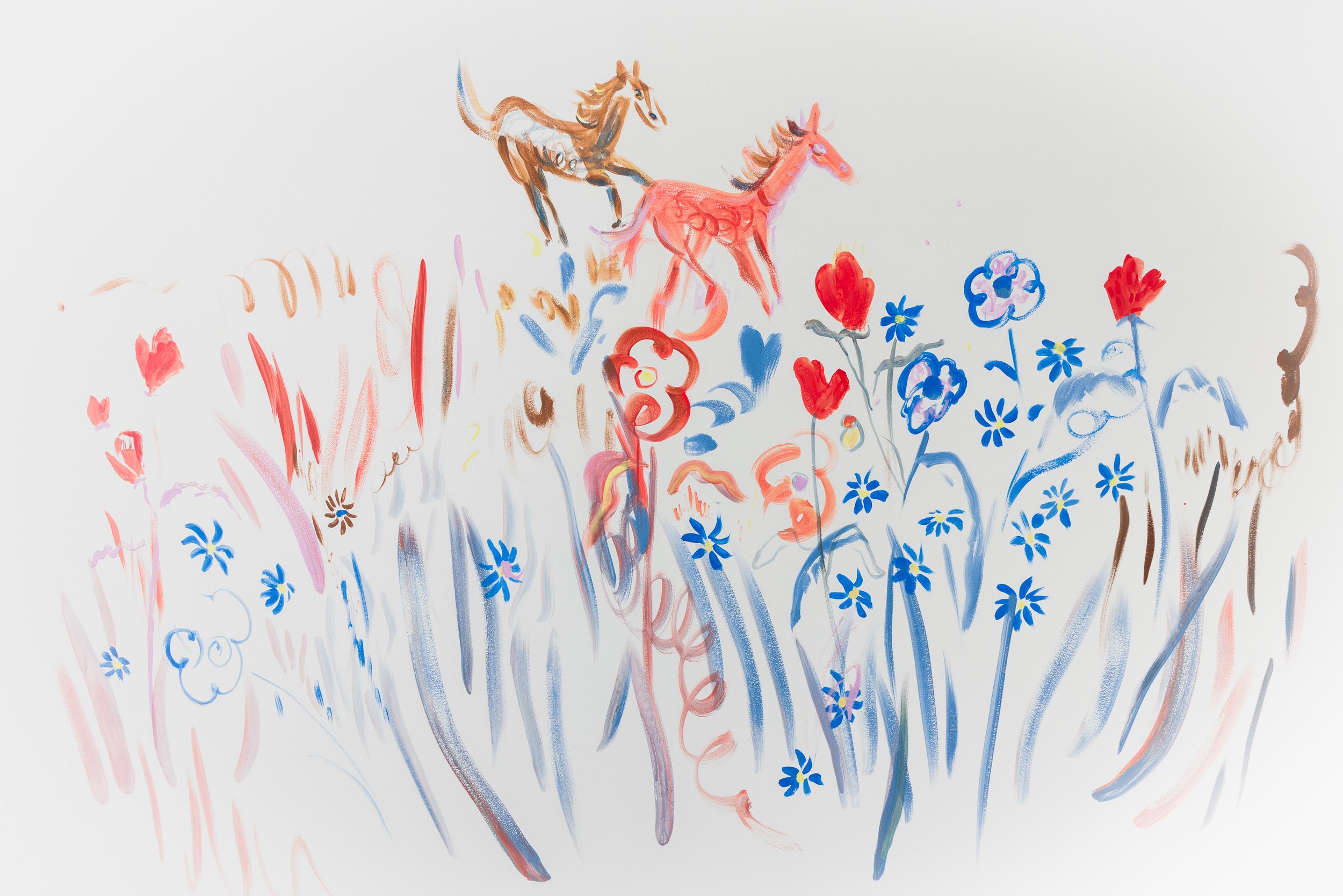
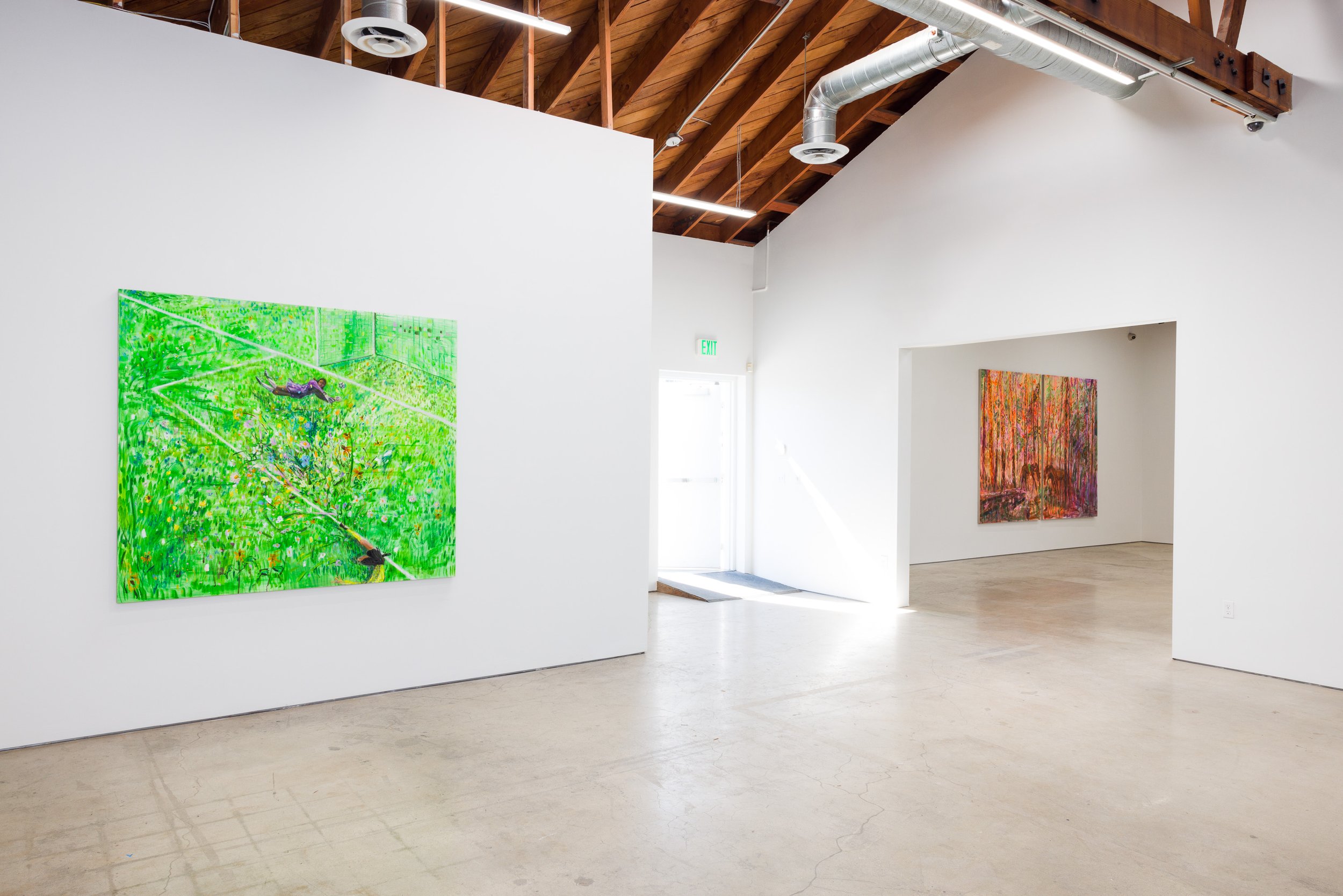
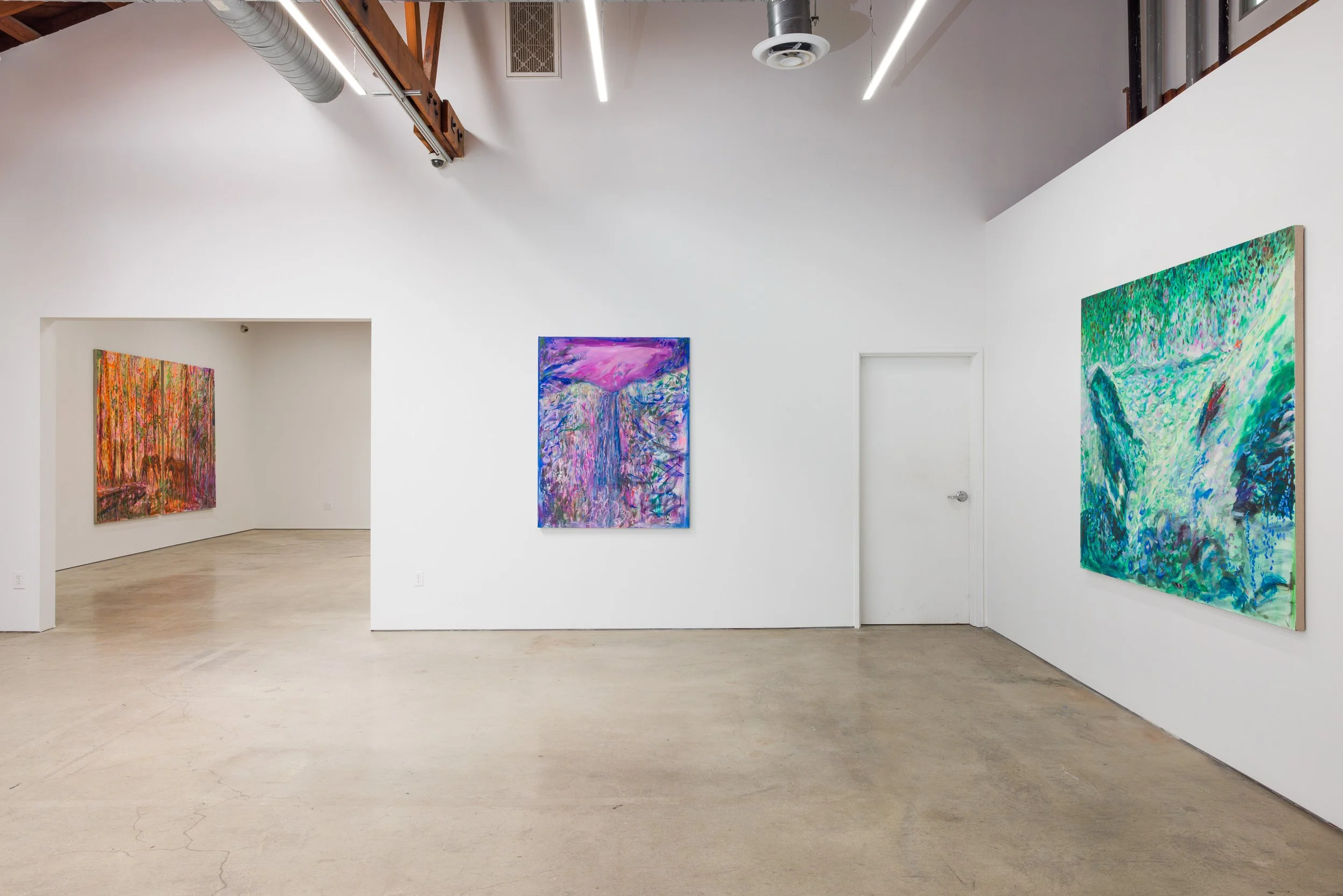
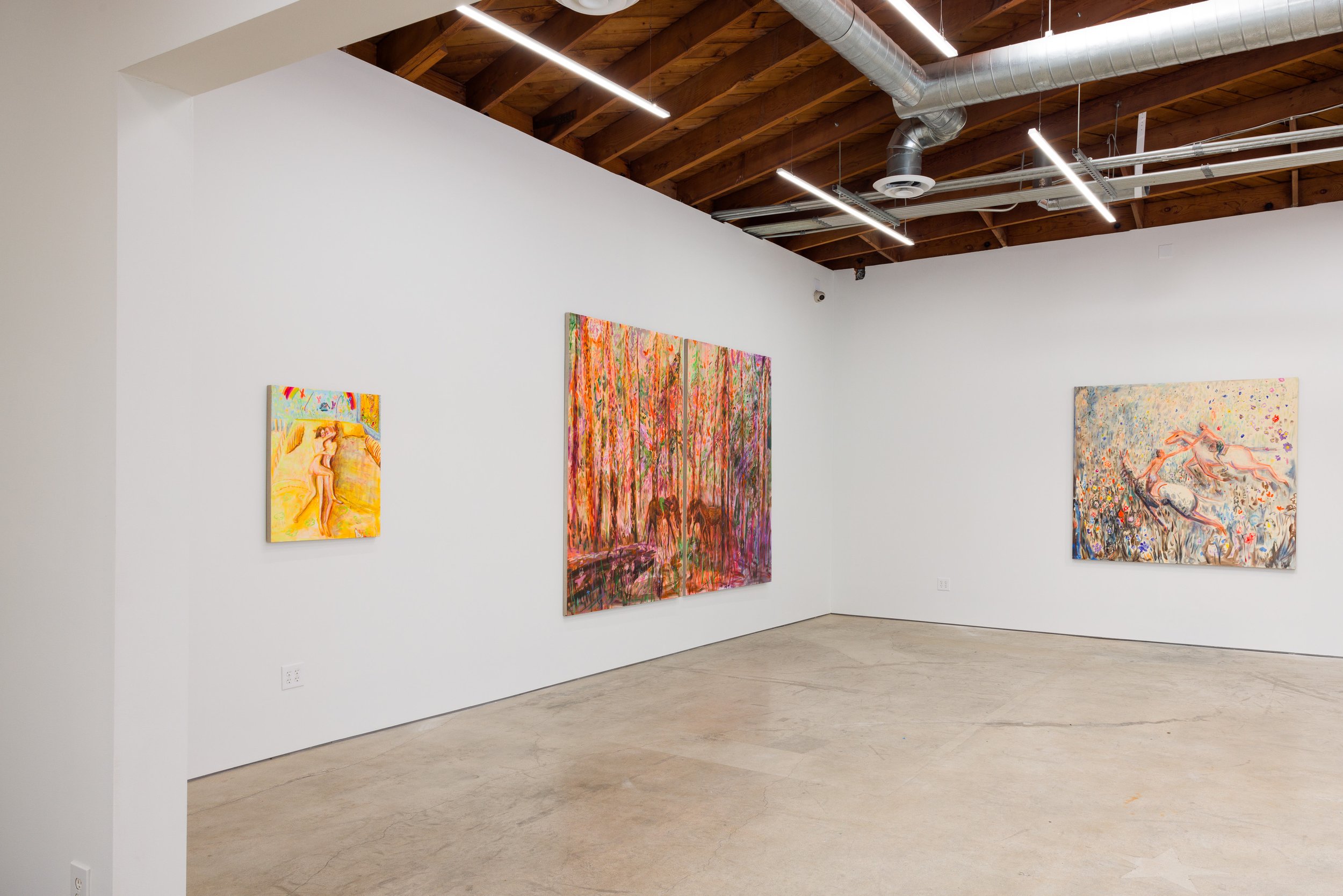
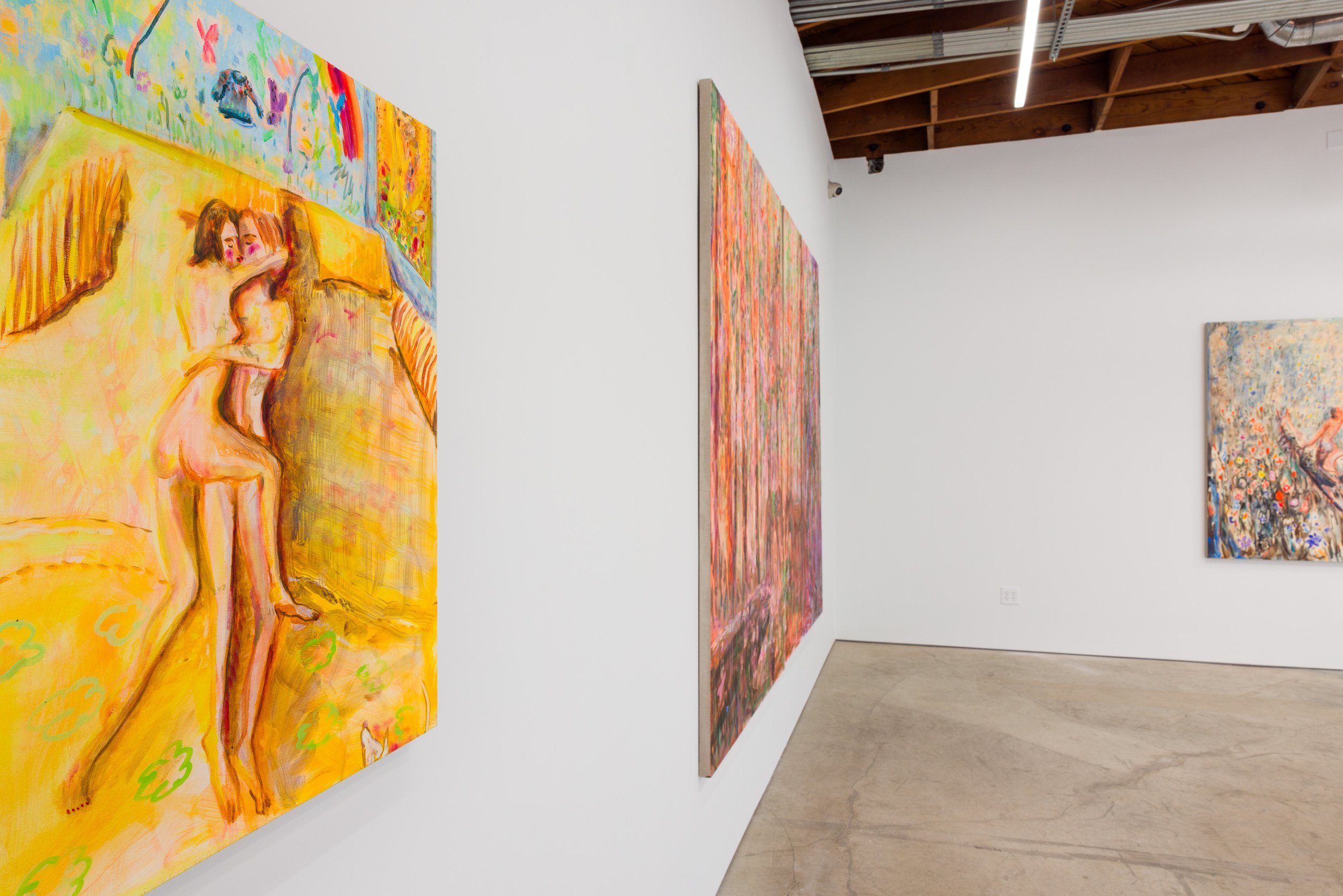
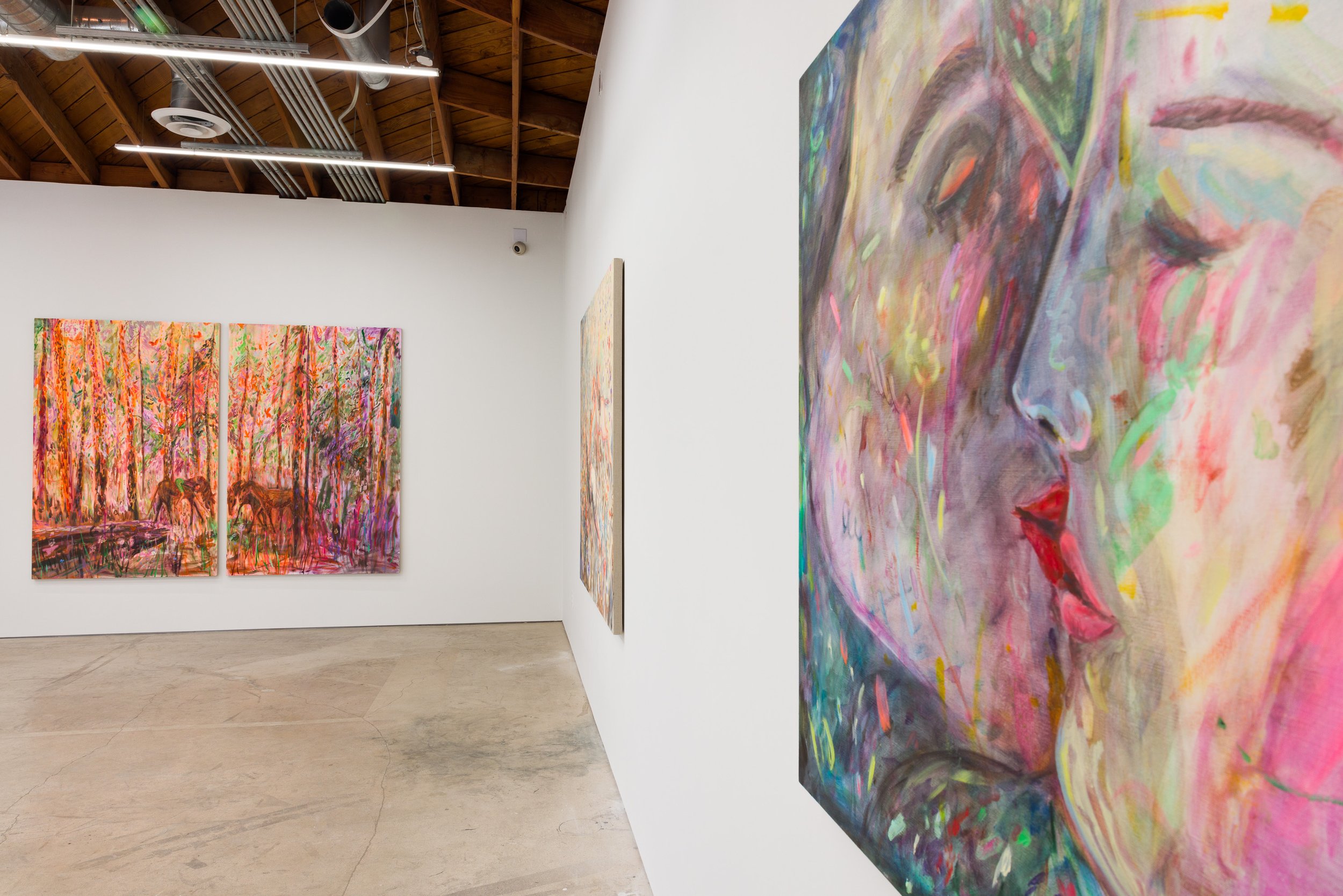
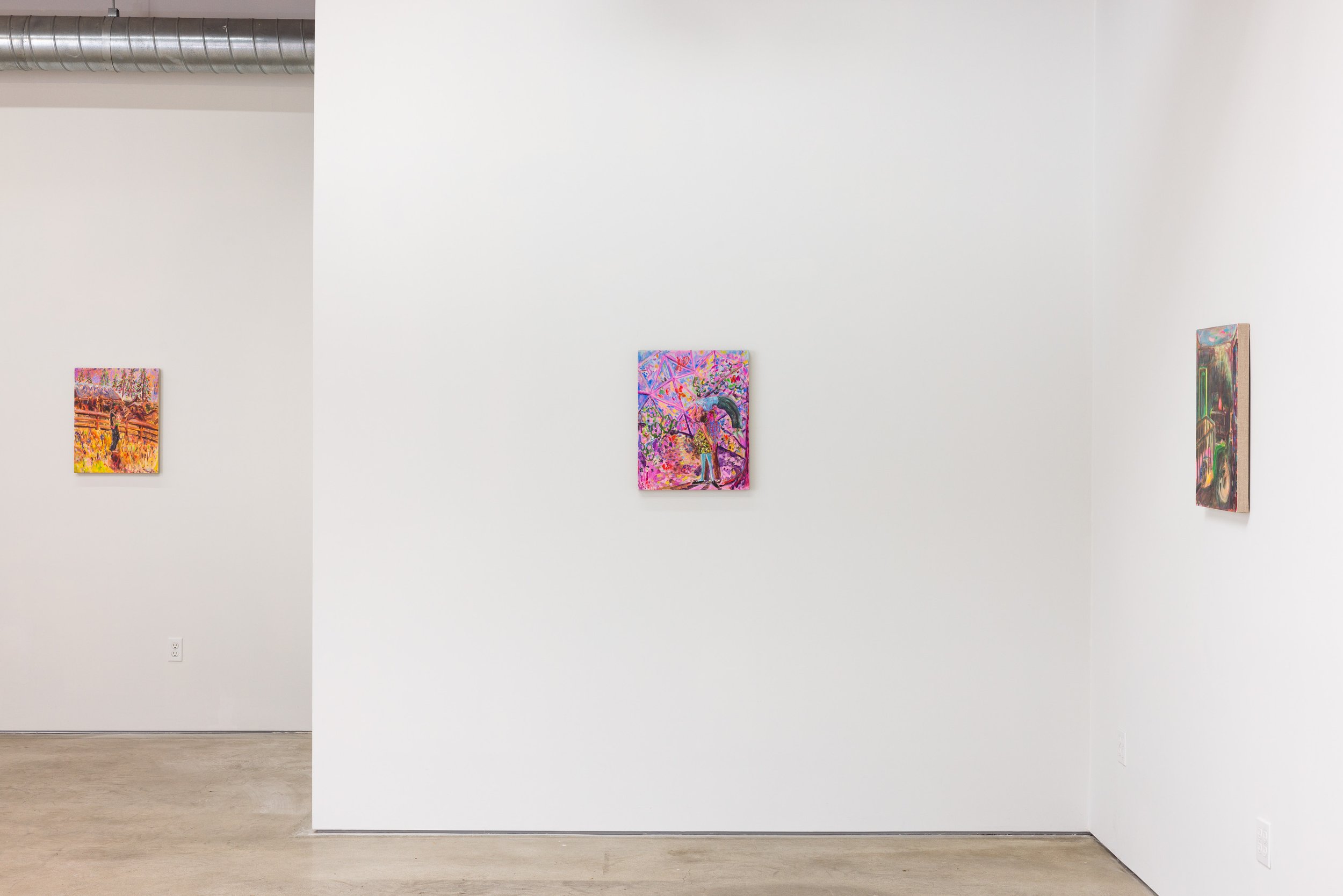
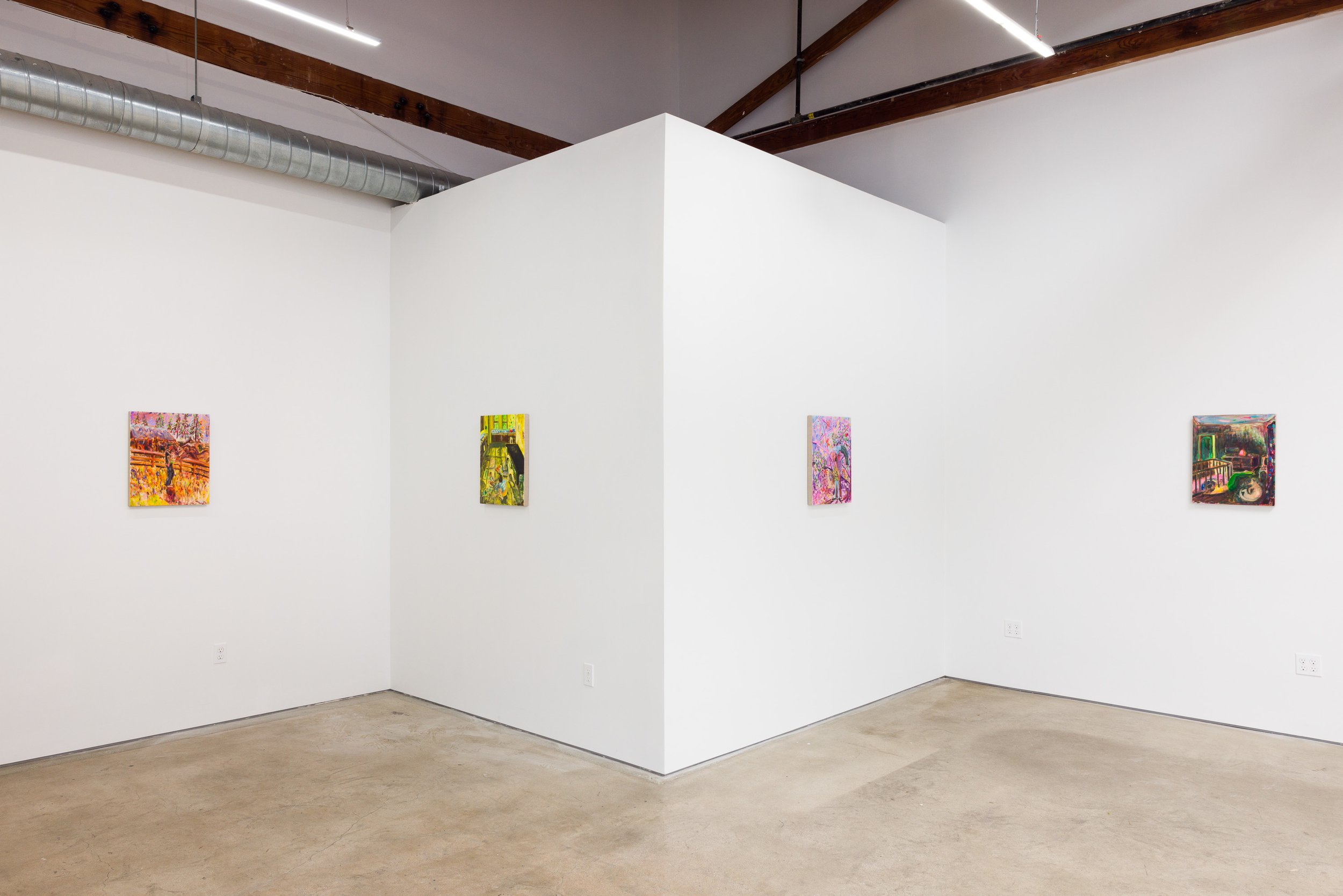
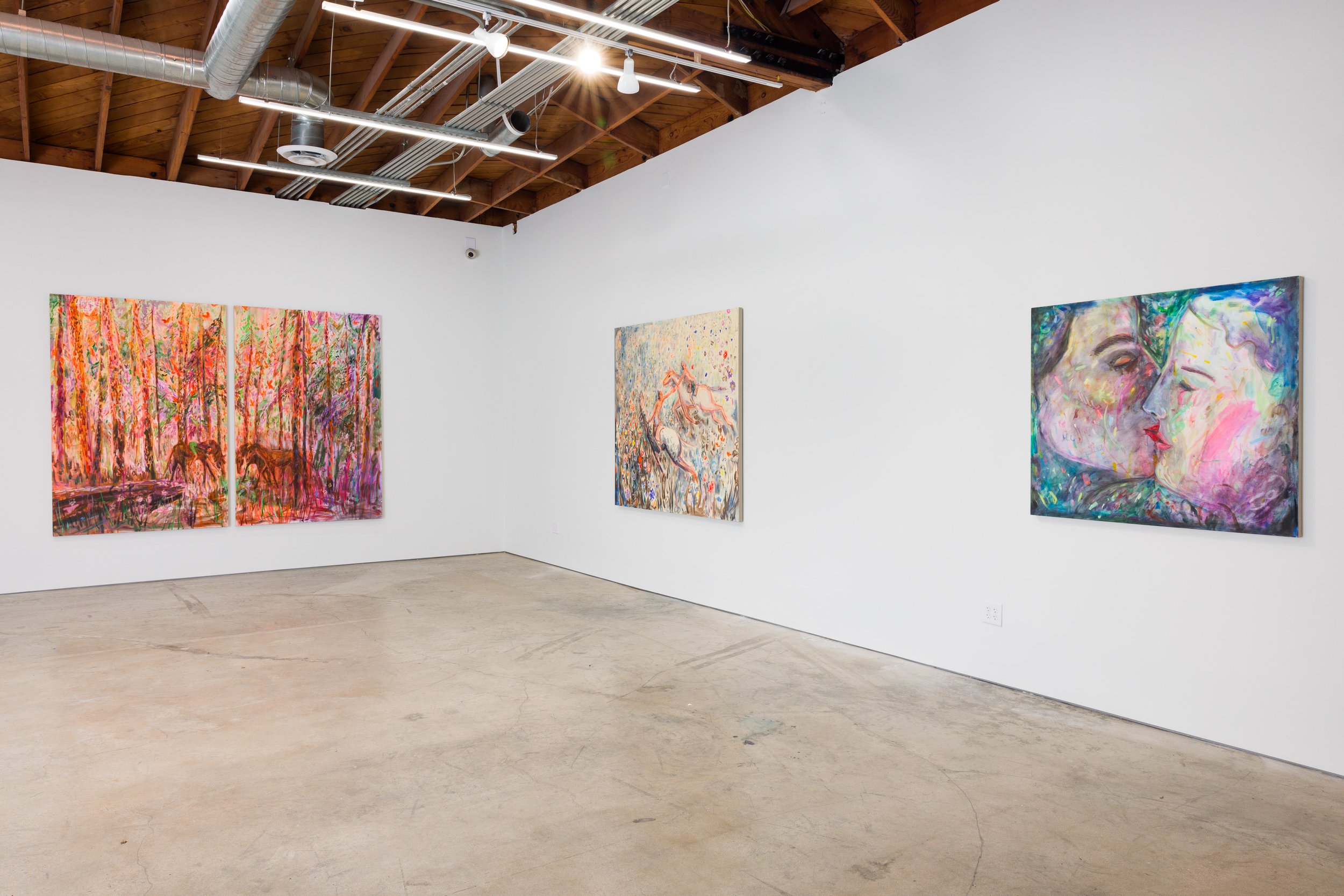
Installation Views: Kira Maria Shewfelt, The Yearlings, Make Room Los Angeles © Kira Maria Shewfelt Courtesy the artist and Make Room LA
Drawing imagery from an expansive archive, the artist’s references span cultural figures like the female matador Conchita Cintrón to autobiographical experiences, such as trips to Lake Tota in Colombia and horseback rides in December at the Michoacán butterfly sanctuary in Mexico. Dashes of color layered atop an image of lovers kissing call to mind visible supernovas, which Kira Maria has expressed as fascination with “the idea that stars are born and also die in moments of particulate friction”. For the artist, the personal can be a microcosm for the universal and understanding infinity can be as easy or challenging as knowing ourselves and relating to one another. Each point of contact imagines a shared reality. Romantic hues imbue the natural world with perceptual wonder. The corporeal body is flexible, elastic, strong, and tender. If color, light, the body, and touch are all mutable, so are the edges of the memory, dream, or images depicted. Sometimes in life, the more you wish for something, the more it becomes true, and so, with layered accumulations and veils of romantic color, the artist’s painterly incantations form visual continuities, conjuring the possibility of a synchronized, intimate, and dream-like world. The subconscious, now conscious, is the threshold where our dreams and reality collide and the artist effortlessly lets these boundaries blur. Each image is on the cusp of becoming. I encourage you, the viewer, to look long and longingly at Kira Maria’s paintings, not just at the surface, but at what glows in deep, romantic hues, shining from underneath. -Candice C. Chu Artist, writer, and contributing art editor —
© Kira Maria Shewfelt Courtesy the artist and Make Room LA
About the Artist:
Kira Maria Shewfelt (b. 1990, Los Angeles, CA) received her MFA in Drawing and Painting from New York University, her M.A. in Art History from the University of Southern California, and B.A. in Comparative Literature from Yale University. Solo exhibitions include the forthcoming The Yearlings, Make Room, Los Angeles, CA (2024). Group exhibitions include Unseen Orchestra, Make Room, Los Angeles, CA (2024); Piano, Piano, Et Al Gallery, San Francisco, CA (2023); The Angels, Baik Art Gallery & The Noblesse Collection, Seoul, Korea (2023); Untitled, Make Room Gallery, Art 021, Shanghai, China (2023); Untitled, Make Room Gallery, Art SG, Marina Bay Sands, Singapore (2023); LA Dreams 2: Light Touch, CFHILL, Stockholm, Sweden (2022); Flower Shop, Smoke the Moon, Santa Fe, NM (2022); Telescoping, False Cast Gallery, Santa Monica, CA (2022); A Body is a Home, Hyperspace, Culver City, CA (2022); Hot Tropic, La Loma Projects, Eagle Rock, CA (2021); Peripheral Reverie, Penske Projects, Montecito, CA (2020); So Far, La Loma Projects, Eagle Rock, CA (2020); In Excess, Jacob’s West, Spring Break, Art Show, Los Angeles, CA (2020).
Established in 2018, Make Room Los Angeles is a contemporary art gallery owned and directed by Emilia Yin. The newly relocated 4,500-square-foot gallery is situated in the heart of Hollywood and includes multiple exhibition spaces, an outdoor courtyard, and a garden. The gallery’s dynamic program champions emerging artists, many of them female, with a particular emphasis on artists of the Asian diasporas. In both its physical gallery – which features solo and group exhibitions – and its ambitious off-site projects with international collaborators, Make Room supports its artists’ visionary projects and the development of new bodies of work. Since its opening, Make Room and its programming has been featured extensively in leading arts and news publications, including Artforum, Artnet News, Hyperallergic, Juxtapoz, the Los Angeles Times, Office Magazine, Ocula Magazine, the Observer, Purple Diary, and the Financial Times, among others. In 2022, Emilia Yin was named one of Forbes’ 30 Under 30, highlighted as a new force in the contemporary art world.
For more information about this exhibition and others, please visit Make Room Los Angeles website here. The gallery can also be found on Facebook and Instagram.
Joe Bradley : Vom Abend
Joe Bradley, Salute, 2023-2024 © Joe Bradley Courtesy the artist and David Zwirner
David Zwirner is pleased to announce Vom Abend, an exhibition of new paintings by Joe Bradley at the gallery’s 533 West 19th Street location. This will be Bradley’s debut exhibition with David Zwirner, following the announcement of his representation by the gallery in May 2023. On view will be a group of large-format paintings that build on the forms and compositional structures Bradley has been exploring in recent years.
Joe Bradley, Flat Earth, 2023-2024 © Joe Bradley Courtesy the artist and David Zwirner
Developed over several years through a deliberate process of painterly accumulation and adaptation, the works in this exhibition are marked by an unassuming yet assertive sense of compositional balance whereby the interrelation of individual parts—such as patches of color, stipples of paint, and lines that at times outline shapes and forms and at others float freely—cohere into a resounding whole. As the artist notes, “I think these things couldn’t be made any other way, and there’s a sort of quality that they get from brewing and developing over time. There’s a pleasure to making a mark next to a mark that you made a year and a half ago, and a certain disconnect that happens there that I think is meaningful, that allows for a sort of forward motion. Part of what I’m looking for is a surface quality, and that’s something that you can’t arrive at in a day or a week or a month. It has to feel like it has a sort of history and that it’s been through some skirmishes.” 1
Joe Bradley, Hash Eater, 2023-2024 © Joe Bradley Courtesy the artist and David Zwirner
Bradley worked on the paintings simultaneously, letting the process of developing each one play off of or influence the others. As a result, shared or related elements and palettes recur throughout in different and surprising ways. Modest-sized circular forms that appear in the periphery in one painting find larger, more centralized counterparts in another. Specific colors from Bradley’s lively palette of reds, blues, greens, yellows, and oranges are applied in large swaths of paint in some works and in others they are used like accents or interjections that create strong visual contrasts. Densely applied passages of speckled paint and daubs of oil provide texture and color modulation in certain areas of individual paintings, while in others the dots are larger and more sparingly applied, appearing like celestial expanses or evening skyscapes.
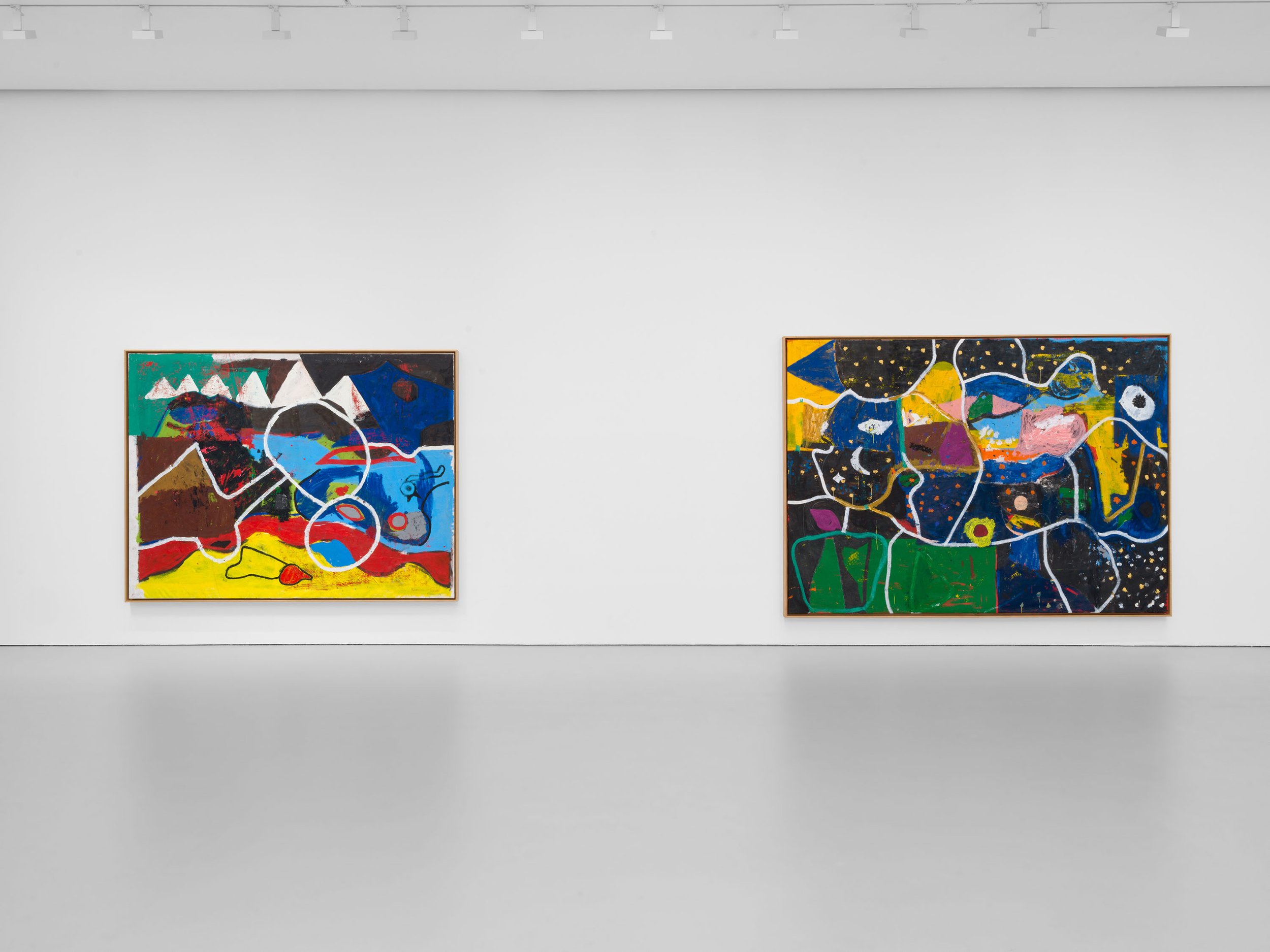
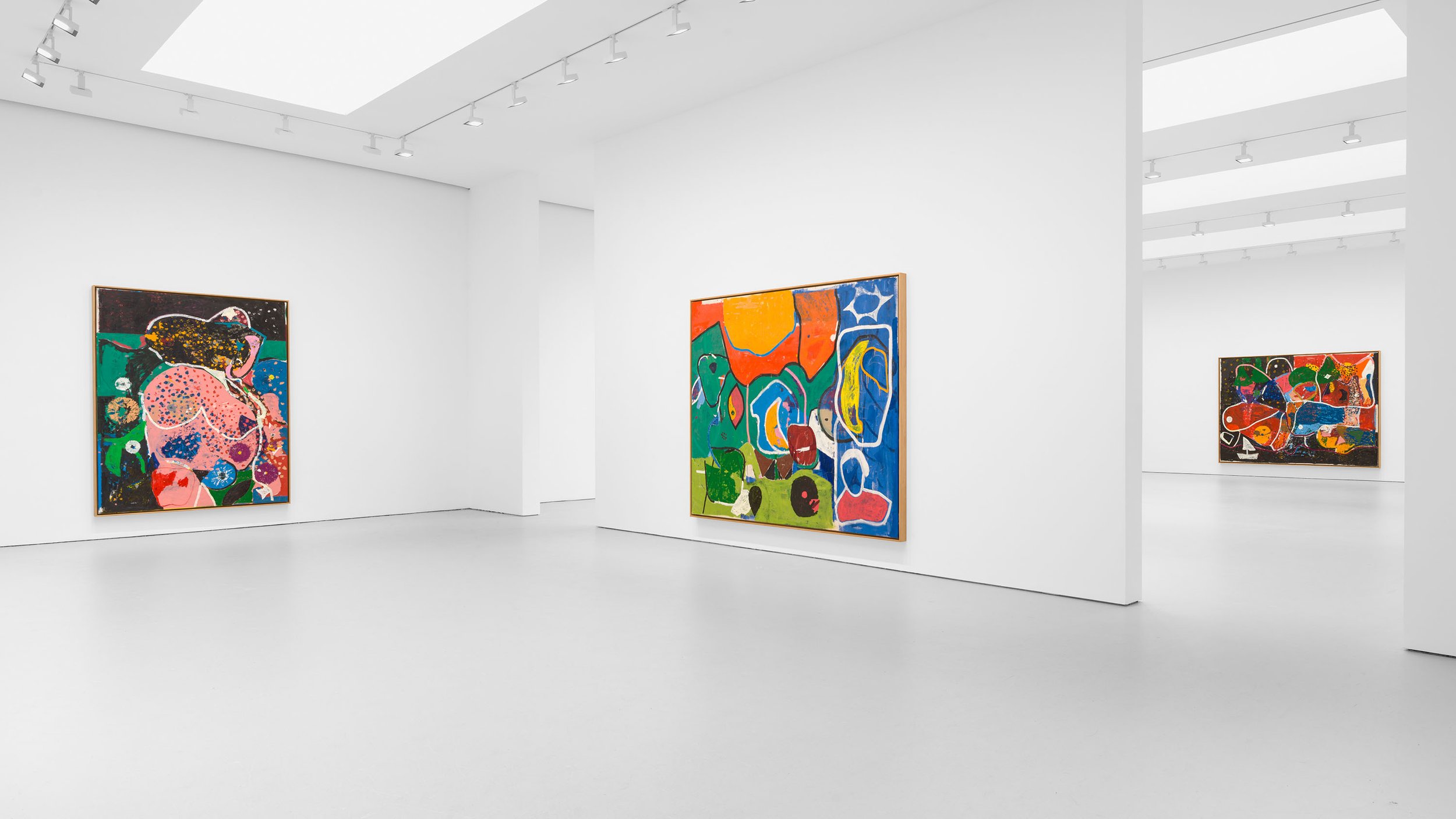
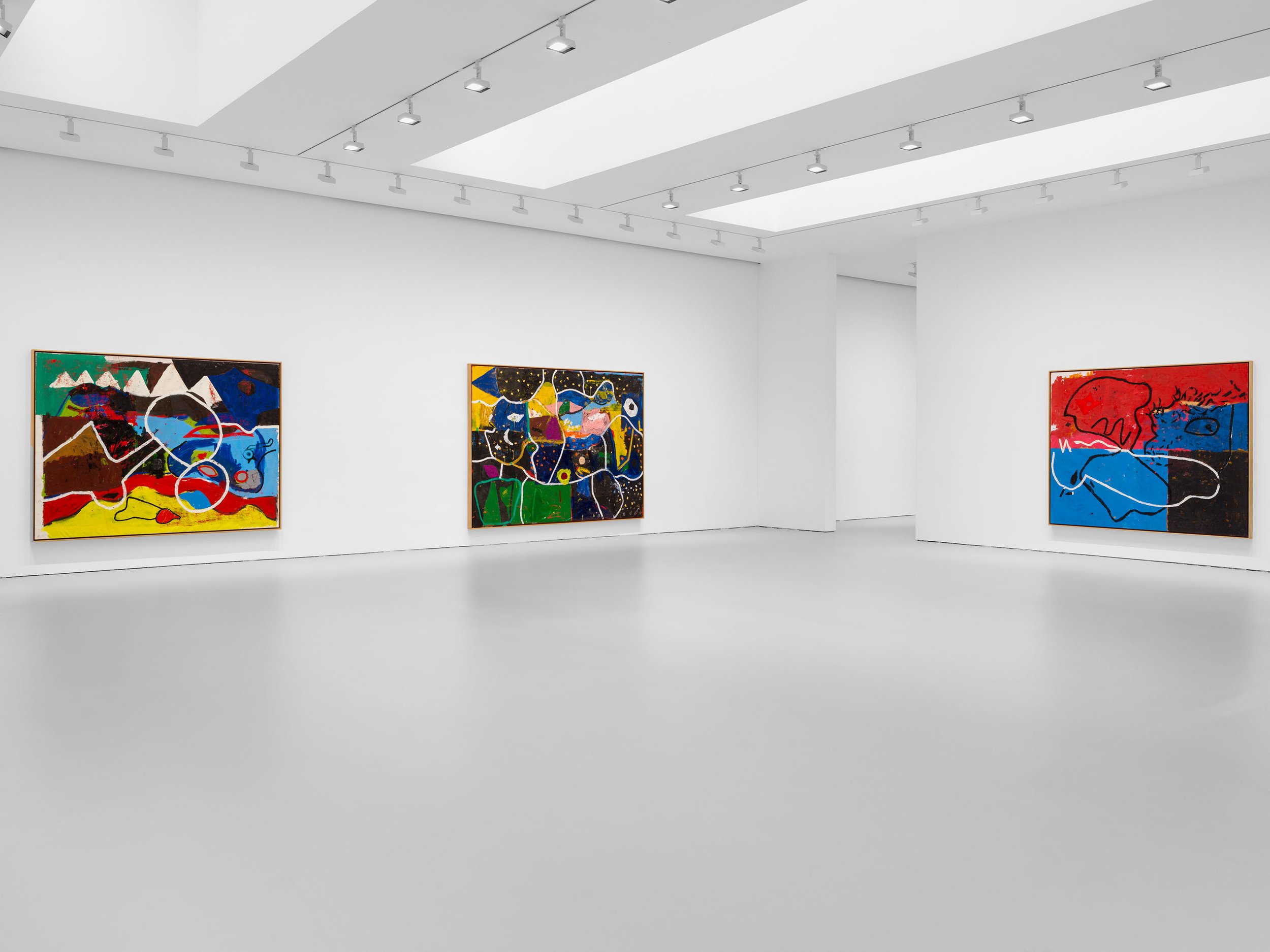
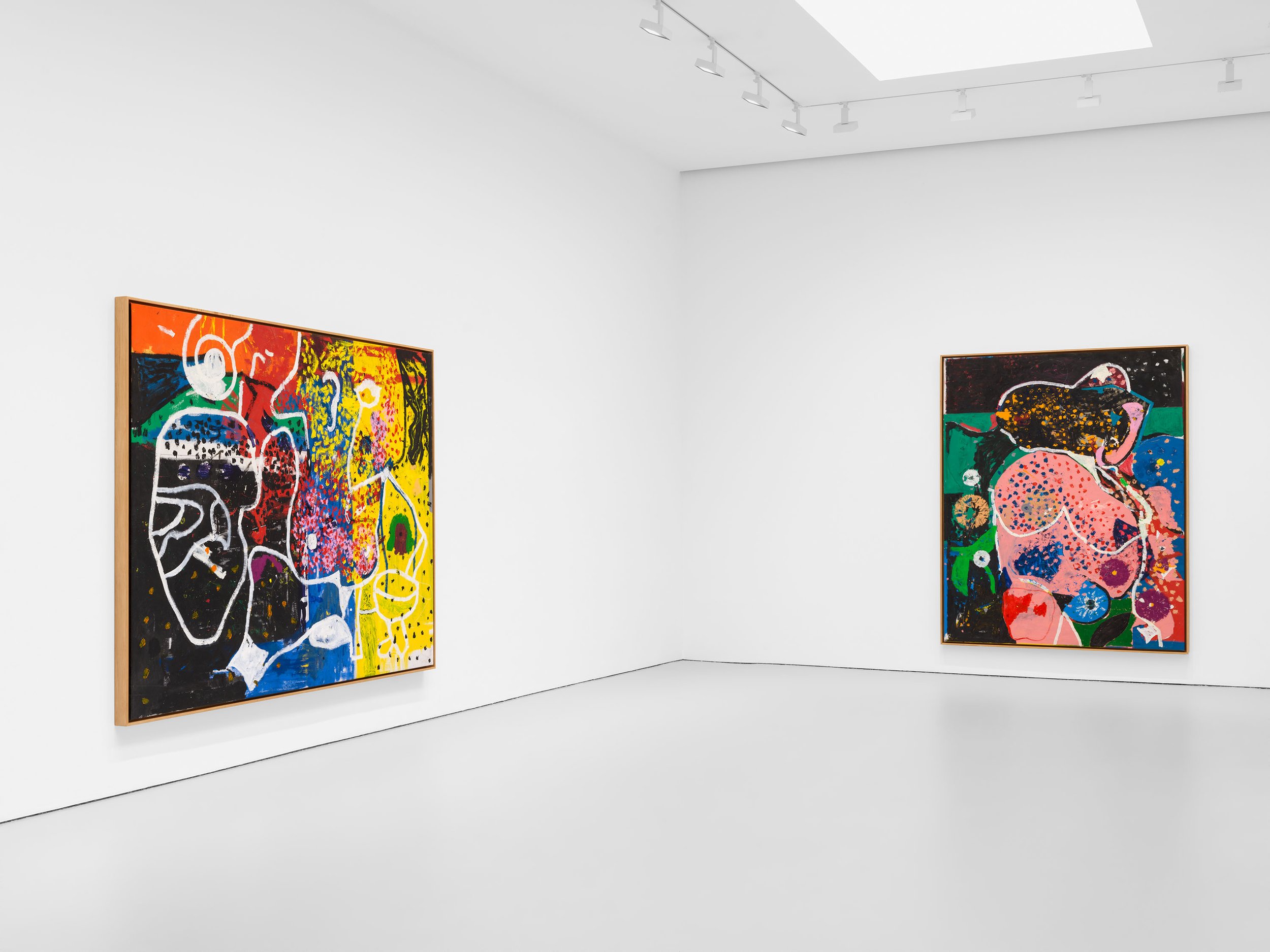
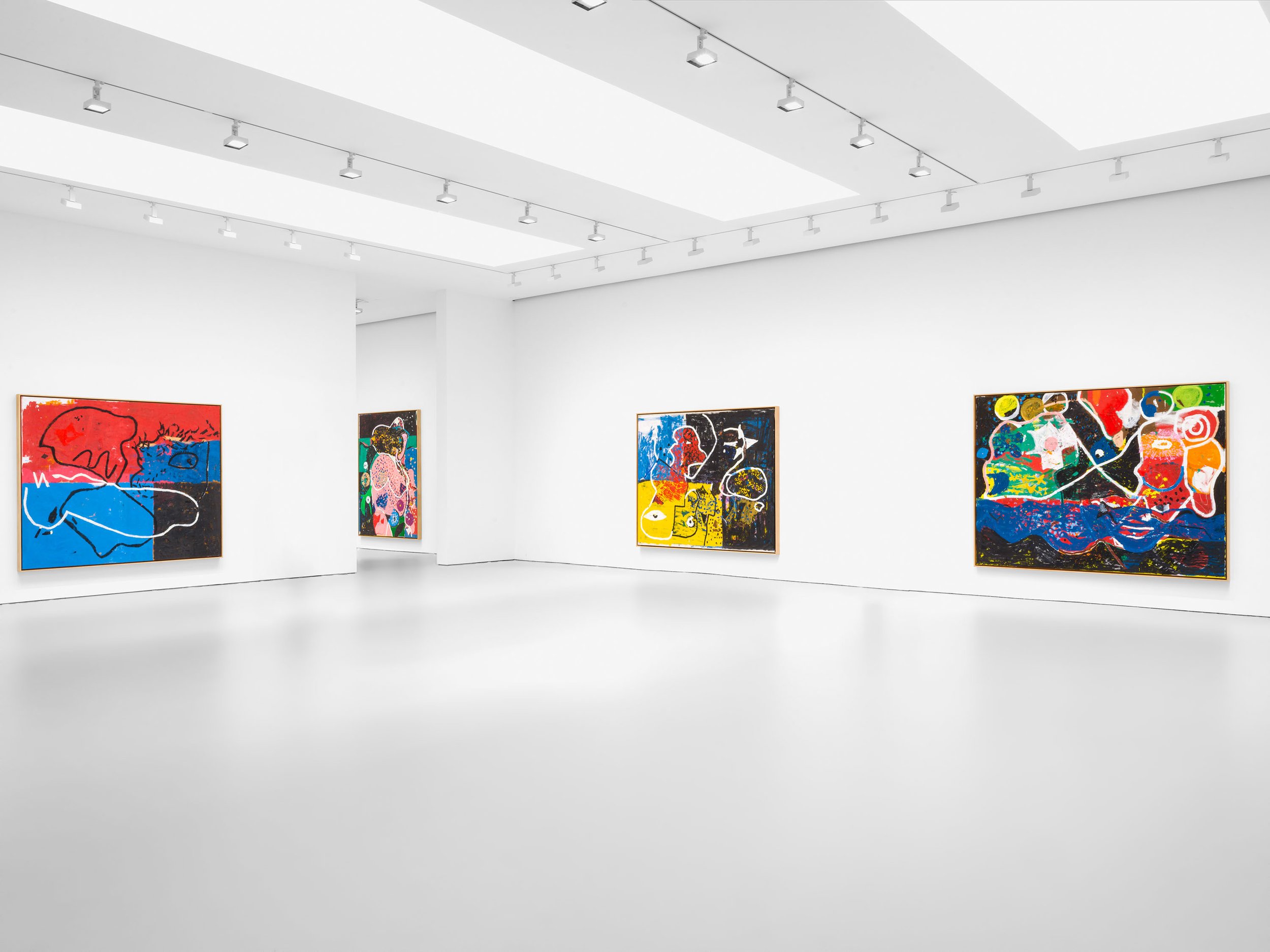
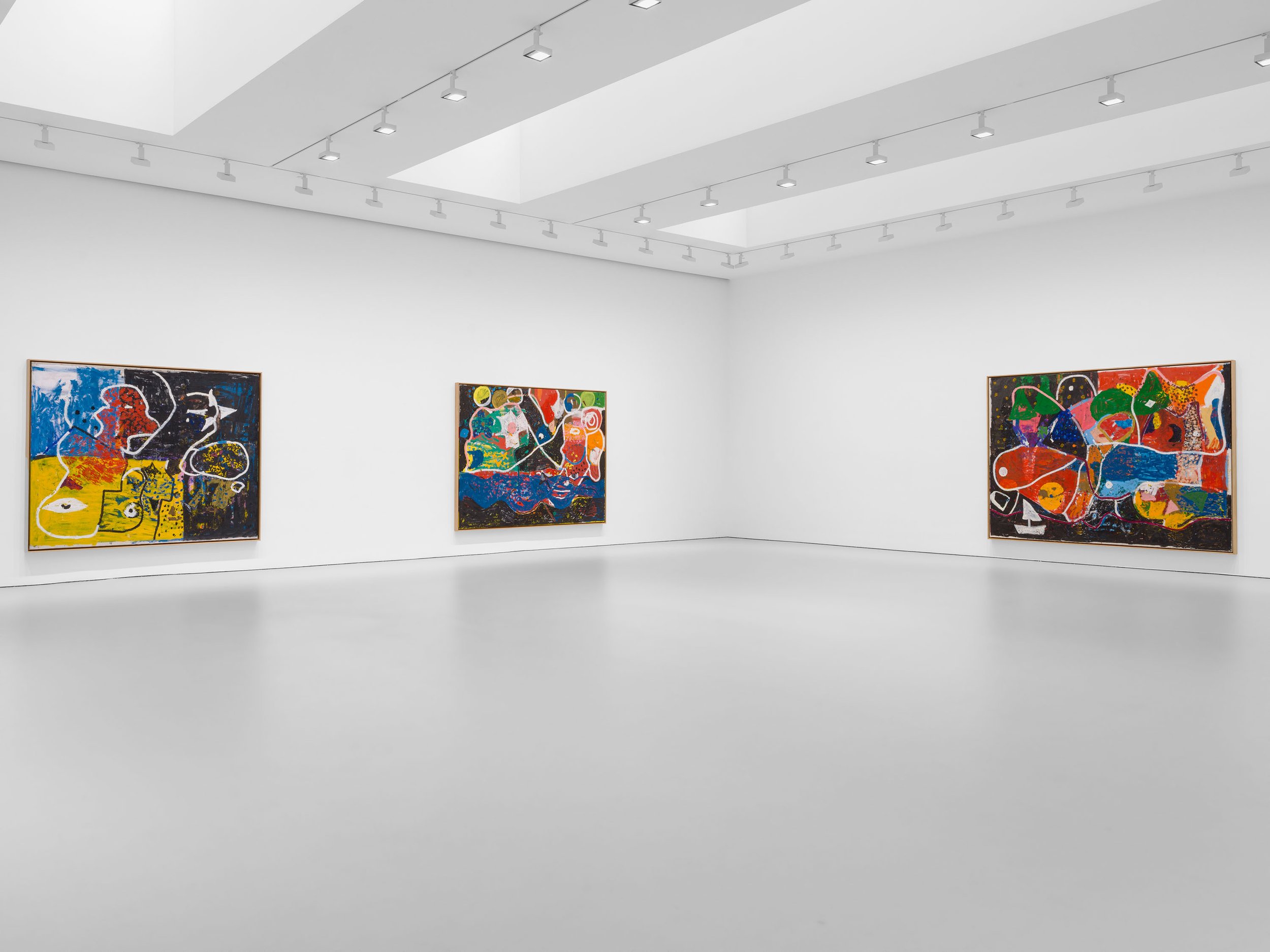
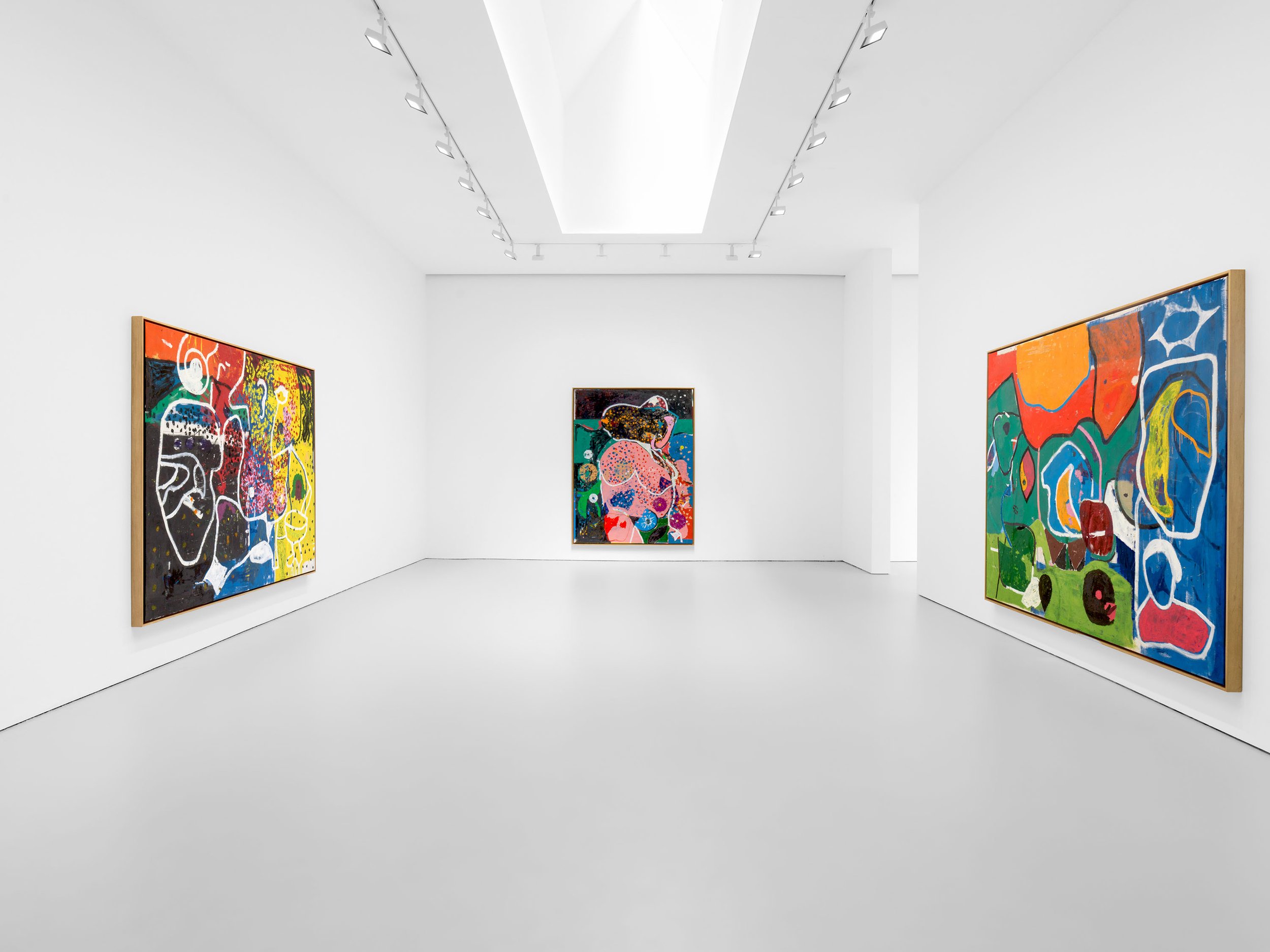
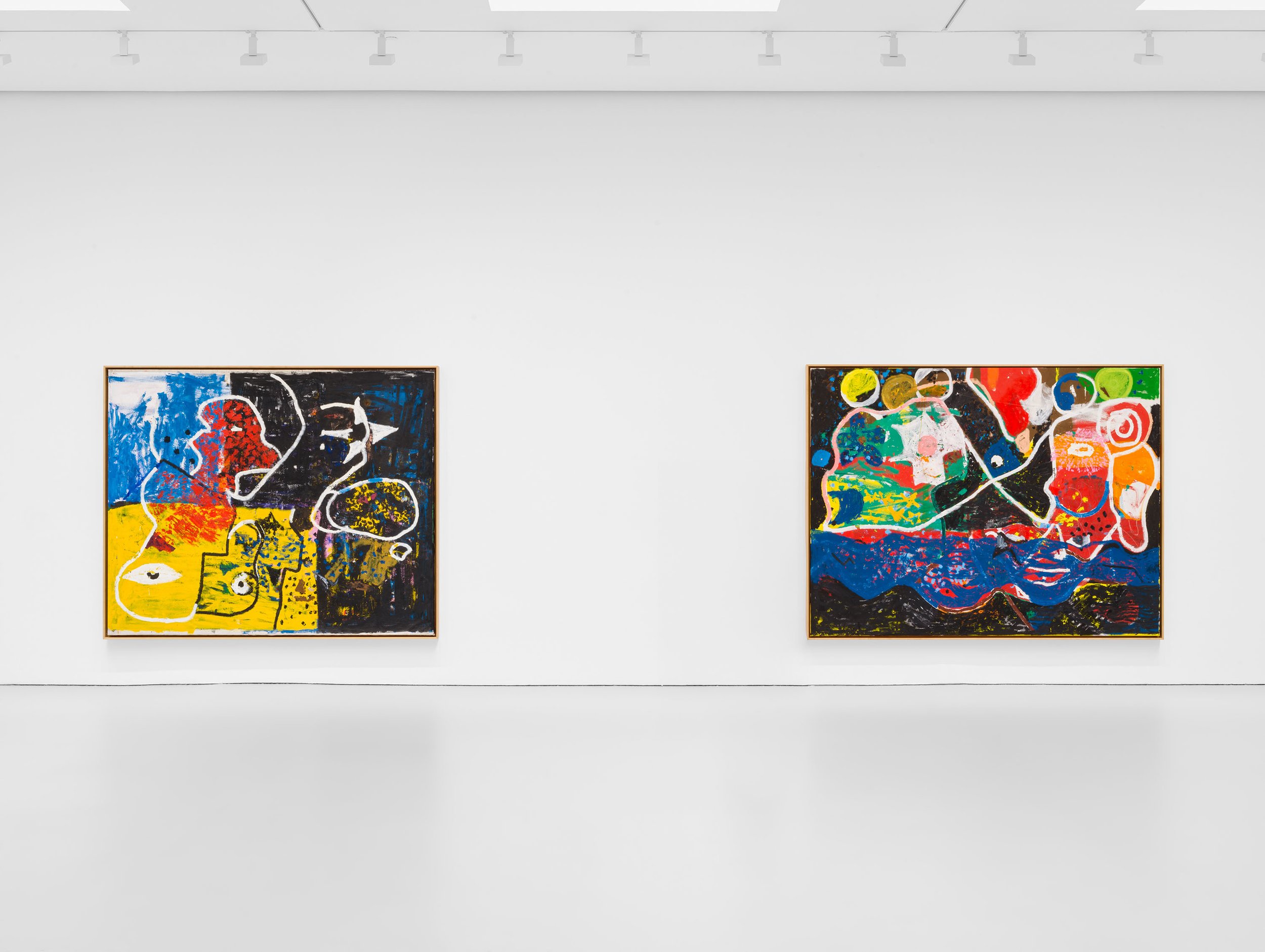
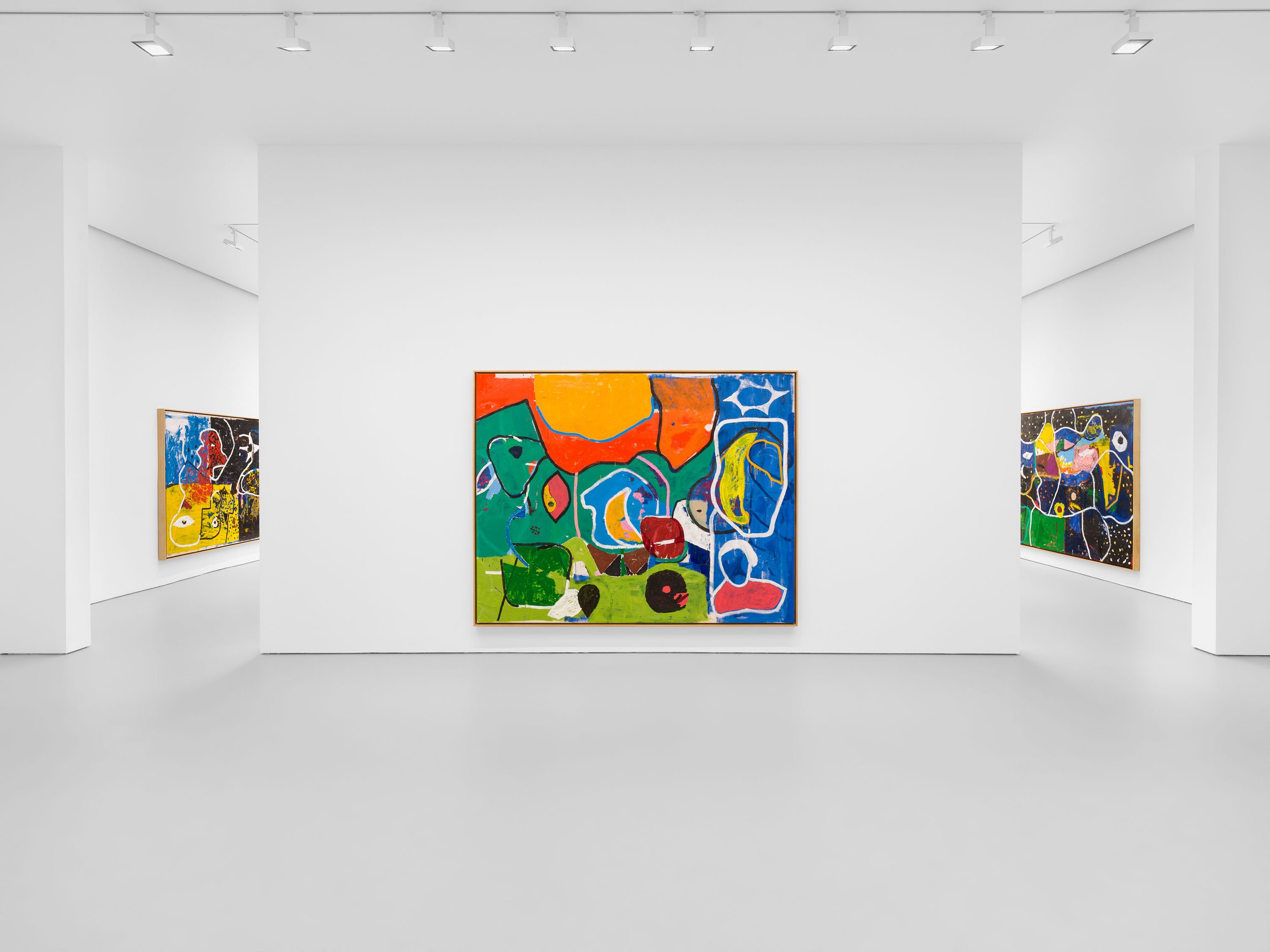
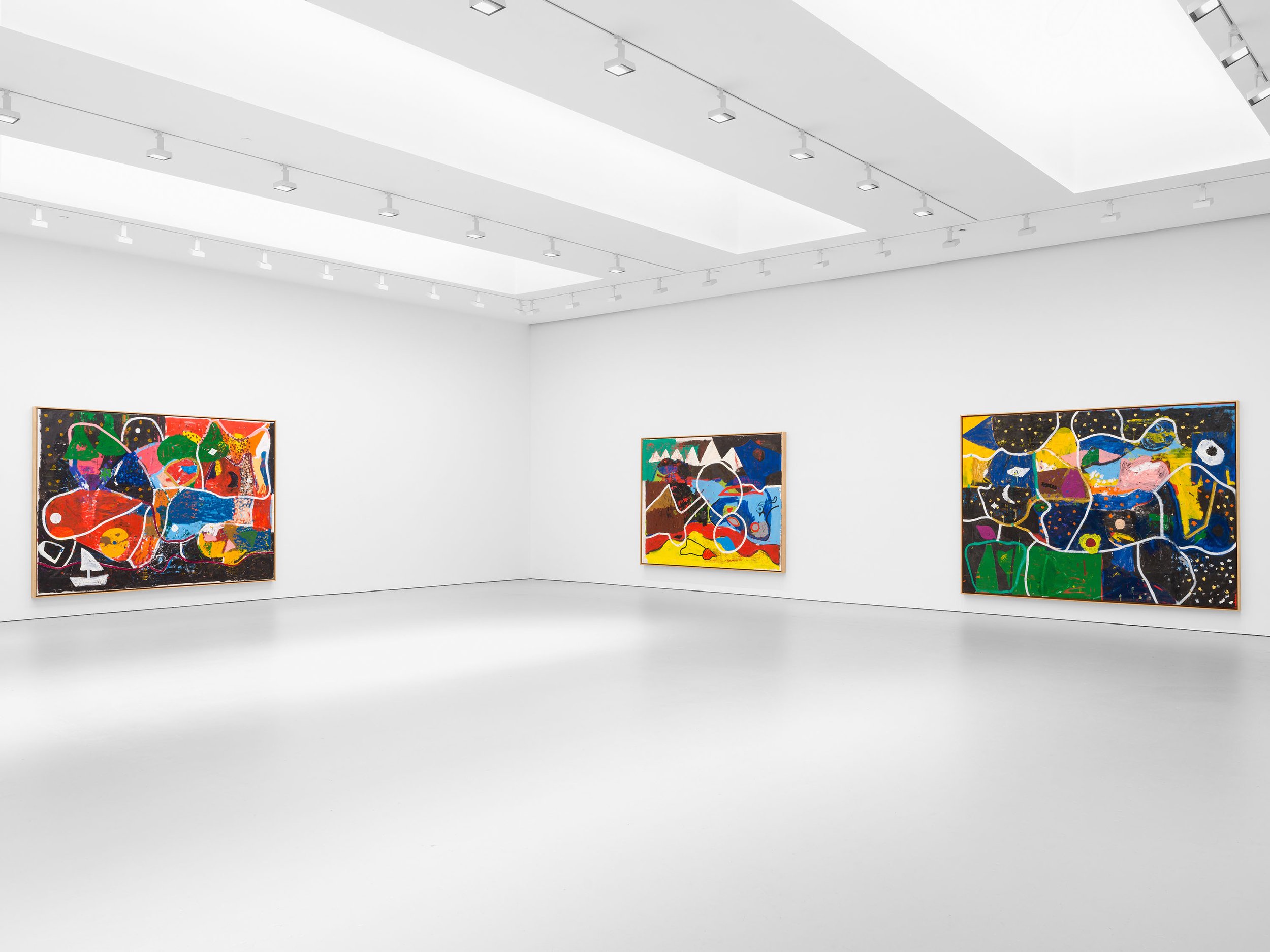
Installation view, Joe Bradley: Vom Abend, David Zwirner, New York, April 11–May 18, 2024 Courtesy David Zwirner
Though they represent a continuation of the painterly trajectory the artist has been pursuing since the middle of the 2010s, these paintings also reflect new turns in Bradley’s practice. As part of the evolution of the artist’s work over the past ten years, figurative elements have started to become more evident in these paintings than in prior ones. The subtle suggestion of faces, animal-like figures, plants, and other organic forms are legible throughout the works. Cosmic abstractions that look like moons or suns mix with eye-like shapes that recall the works of Alexander Calder or Joan Miró, and yet any figurative or stylistic references appear as part of an overall collaging of form, color, and facture without any one feature dominating. On this, Bradley says, “Abstract painting doesn’t feel totally on the nose with these anymore. There are nods and references to the world around us, and to forms and nature, and animals and plants. Those sorts of things are really starting to come to the surface. I think that’s something that interests me. The idea of things emerging. Things forming and dissolving in and on the painting.” 2
Joe Bradley, Kalparush, 2023-2024 © Joe Bradley Courtesy the artist and David Zwirner
Line, which had faded from Bradley’s painterly repertoire for a period of time, has reappeared in recent years—here as white and dark bands that read like pictographic overpainting in some areas, or like outlines demarcating patches of colored ground. Drawing has long been an important medium for Bradley, and his use of line in these paintings reflects the novel ways in which he has come to balance the linear and the painterly in his work.
In addition to the exhibition, David Zwirner Books will be producing a major publication on Bradley, which is scheduled to be released in 2025.
Joe Bradley, 2023. Photo by Jason Schmidt. Courtesy David Zwirner.
Joe Bradley (b. 1975) was born in Kittery, Maine, and received his BFA from the Rhode Island School of Design in 1999. He presently lives and works in New York.
Joe Bradley, Occident, 2023-2024 © Joe Bradley Courtesy the artist and David Zwirner
The artist’s inaugural solo exhibition took place at Allston Skirt Gallery, Boston, in 2002. In 2006, Bradley’s first institutional solo exhibition opened at MoMA PS1, New York. The artist’s work has since been the subject of several international exhibitions. Notably, a mid-career survey of Bradley’s work was organized in 2017 by the Buffalo AKG Art Museum (formerly known as the Albright–Knox Art Gallery) in Buffalo, New York, which later traveled to the Rose Art Museum, Brandeis University, Waltham, Massachusetts. In the same year, the Fundación Almine y Bernard Ruiz-Picasso organized a presentation of Bradley’s sculptures at Pablo Picasso’s former home and studio at the Château de Boisgeloup, Gisors, France. A solo exhibition of Bradley’s work was presented at Le Consortium, Dijon, France, in 2014.
Joe Bradley, Angel's Trumpet, 2023-2024 © Joe Bradley Courtesy the artist and David Zwirner
Significant group exhibitions including the artist’s work have been presented at the de la Cruz Collection, Miami (2019 and 2020); The Brant Foundation Art Study Center, Greenwich, Connecticut (2017 and 2018); Kunstmuseum Bonn, Germany (2015); The Museum of Modern Art, New York (2014); MoMA PS1, New York (2013); and Centro per l'arte contemporanea Luigi Pecci, Prato, Italy (2013); among others. In 2008, Bradley was selected to participate in the Whitney Biennial.
This solo exhibition of Bradley’s work at David Zwirner, New York, is the gallery’s first presentation of his work since the announcement of his representation in May 2023.
Work by the artist is held in distinguished public collections such as the Buffalo AKG Art Museum, Buffalo, New York; de la Cruz Collection, Miami; Fondation Louis Vuitton, Paris; George Economou Collection, Athens; Hall Art Foundation, Reading, Vermont; Mead Art Museum, Amherst College, Amherst, Massachusetts; The Museum of Modern Art, New York; and Whitney Museum of American Art, New York.
This exhibition opened on April 11th and will close on the 18th of May 2024 at the New York location at 533 West 19th Street, New York. For more information about this exhibit, visit David Zwirner’s site; you can also follow them on Instagram and find the gallery on Artsy here.
Citations
1 Bradley in conversation with the gallery, March 2024.
2 Ibid
Richard Serra : Six Large Drawings
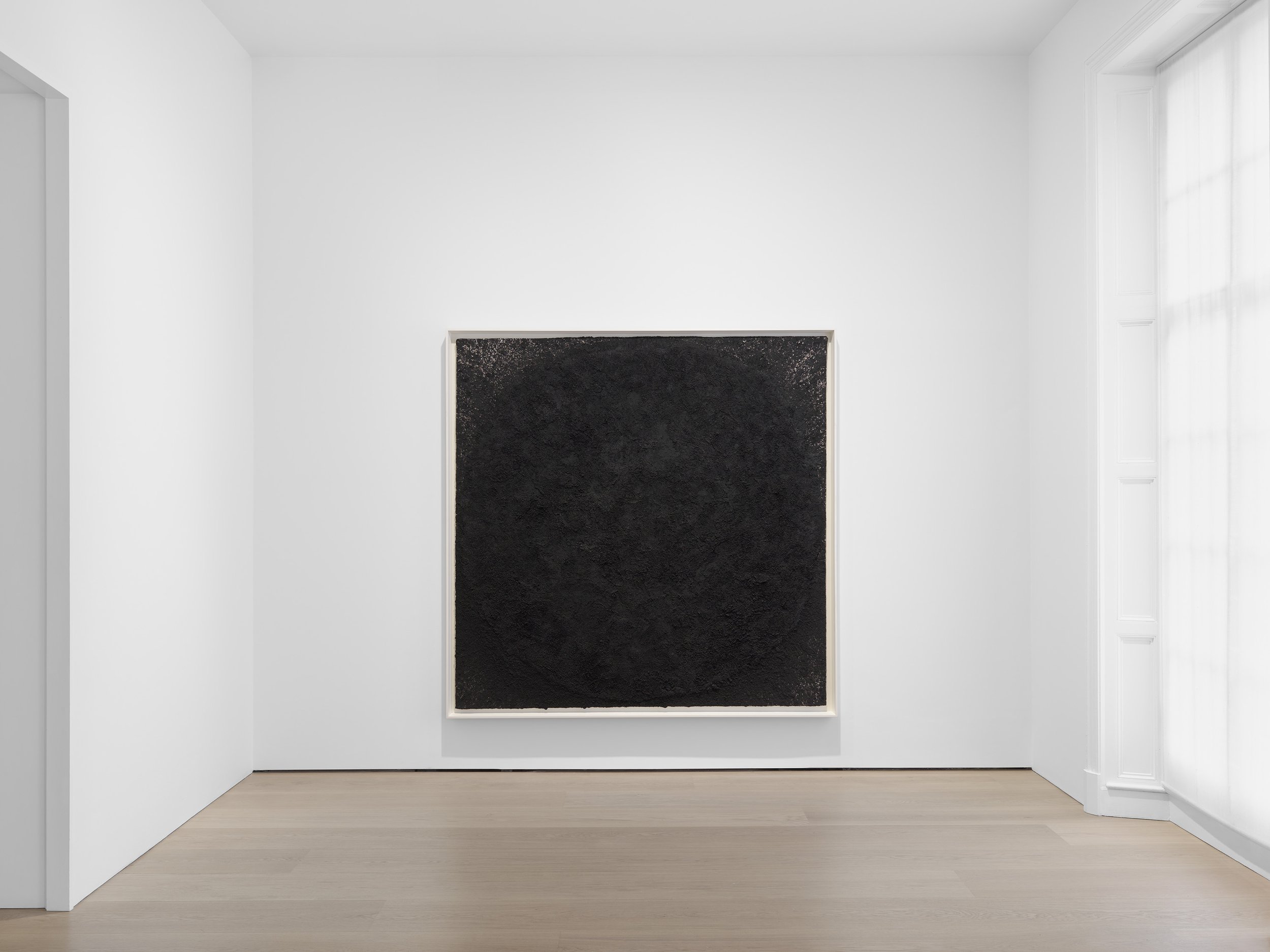
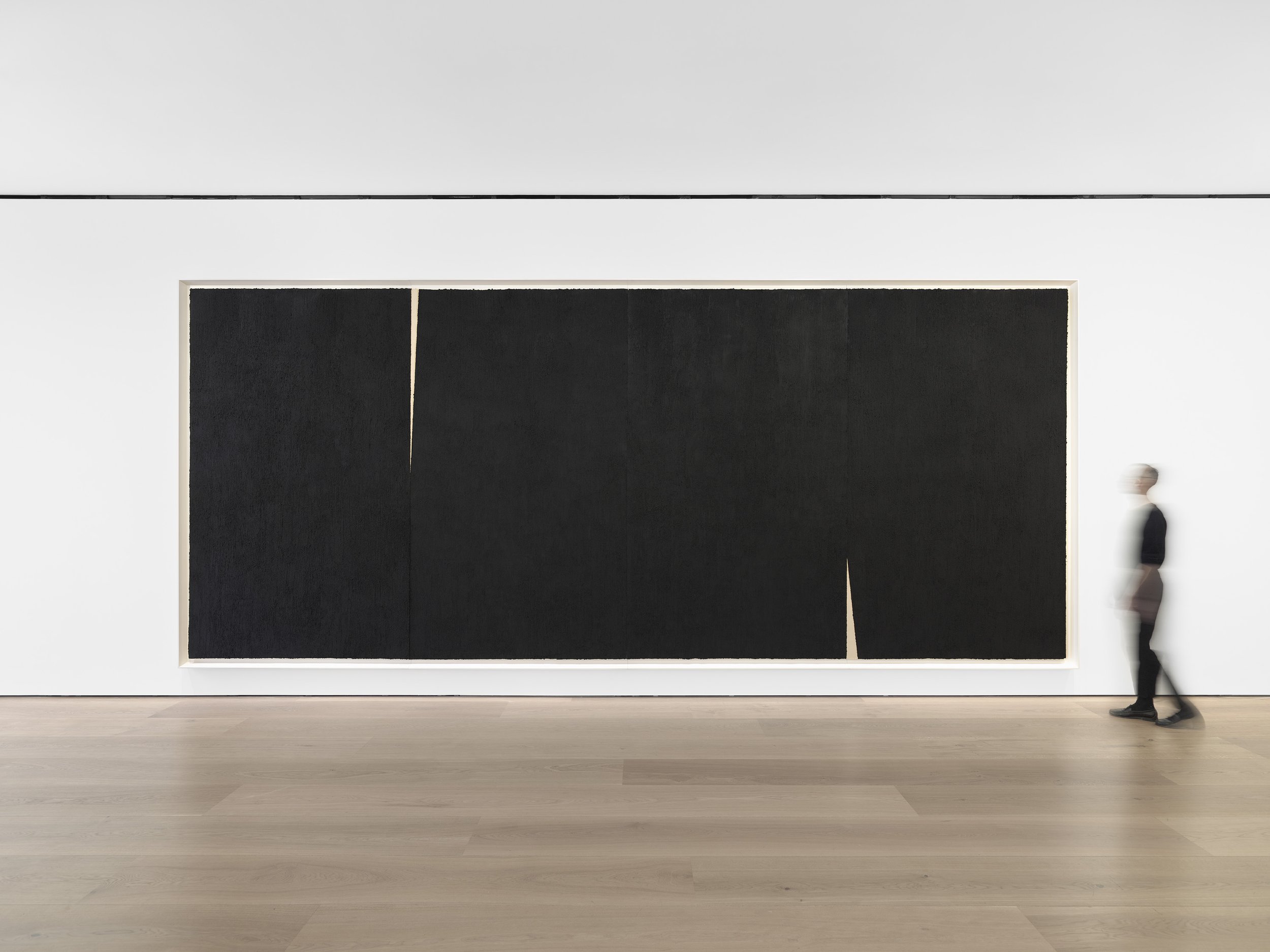
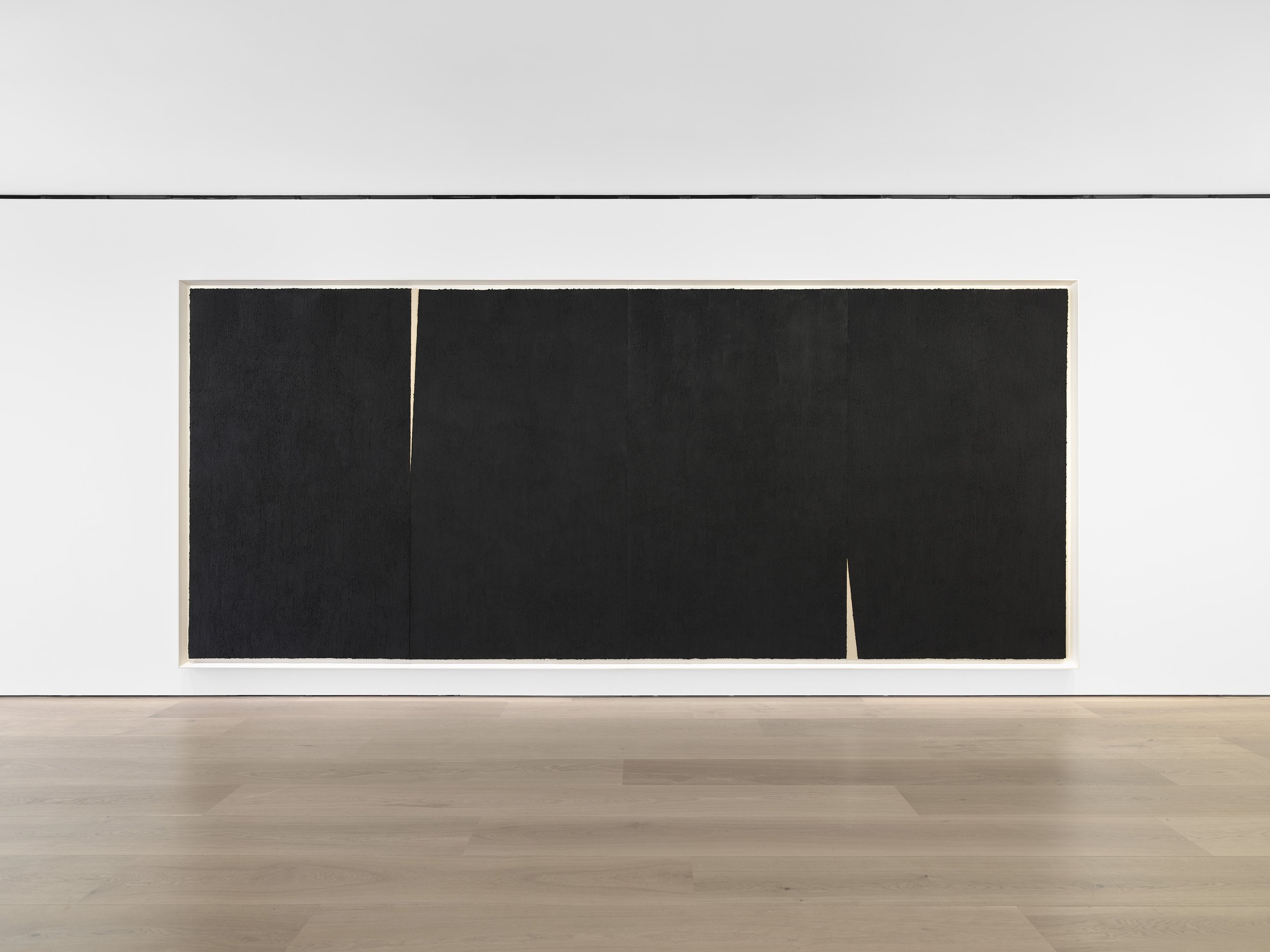
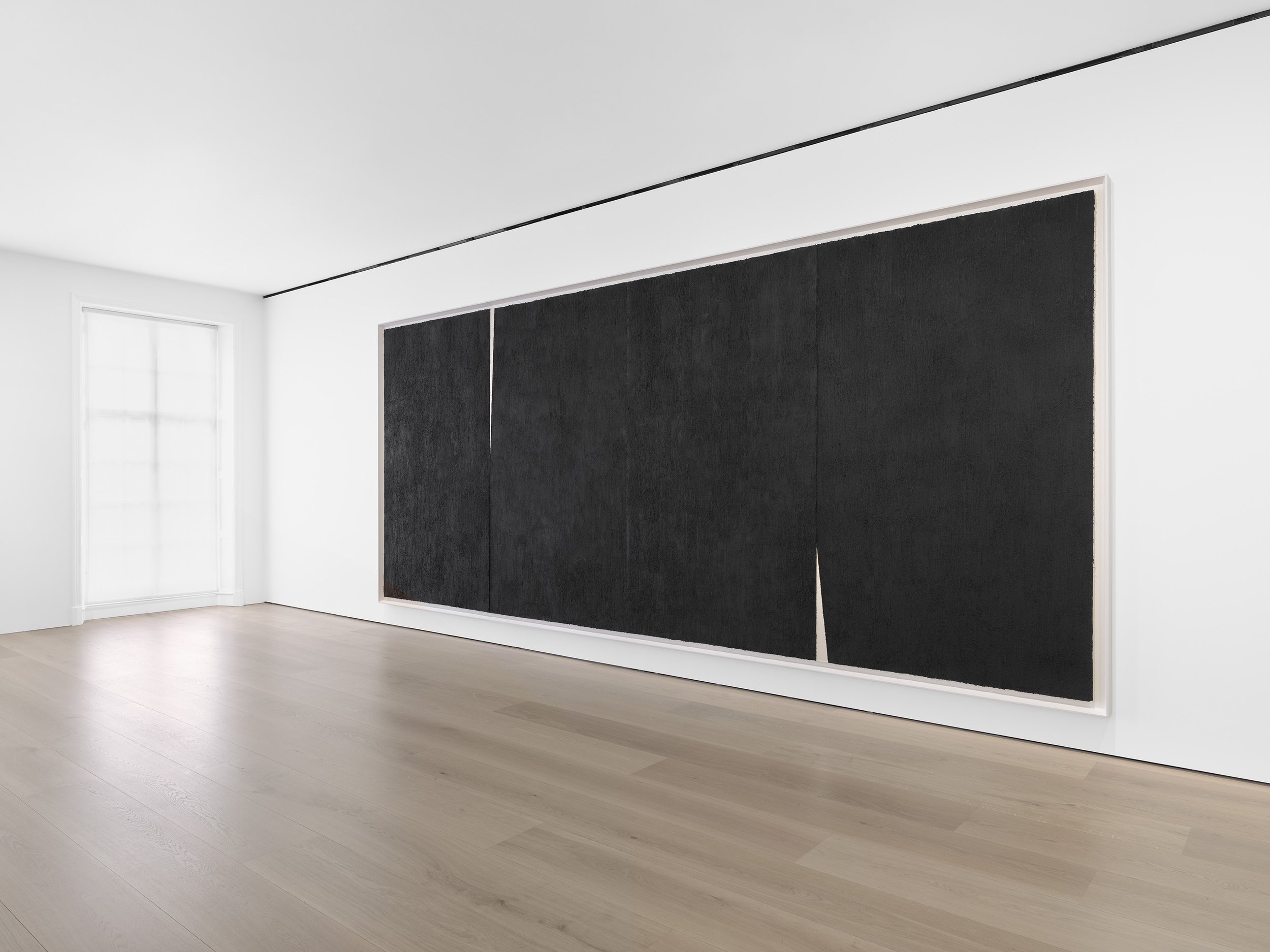
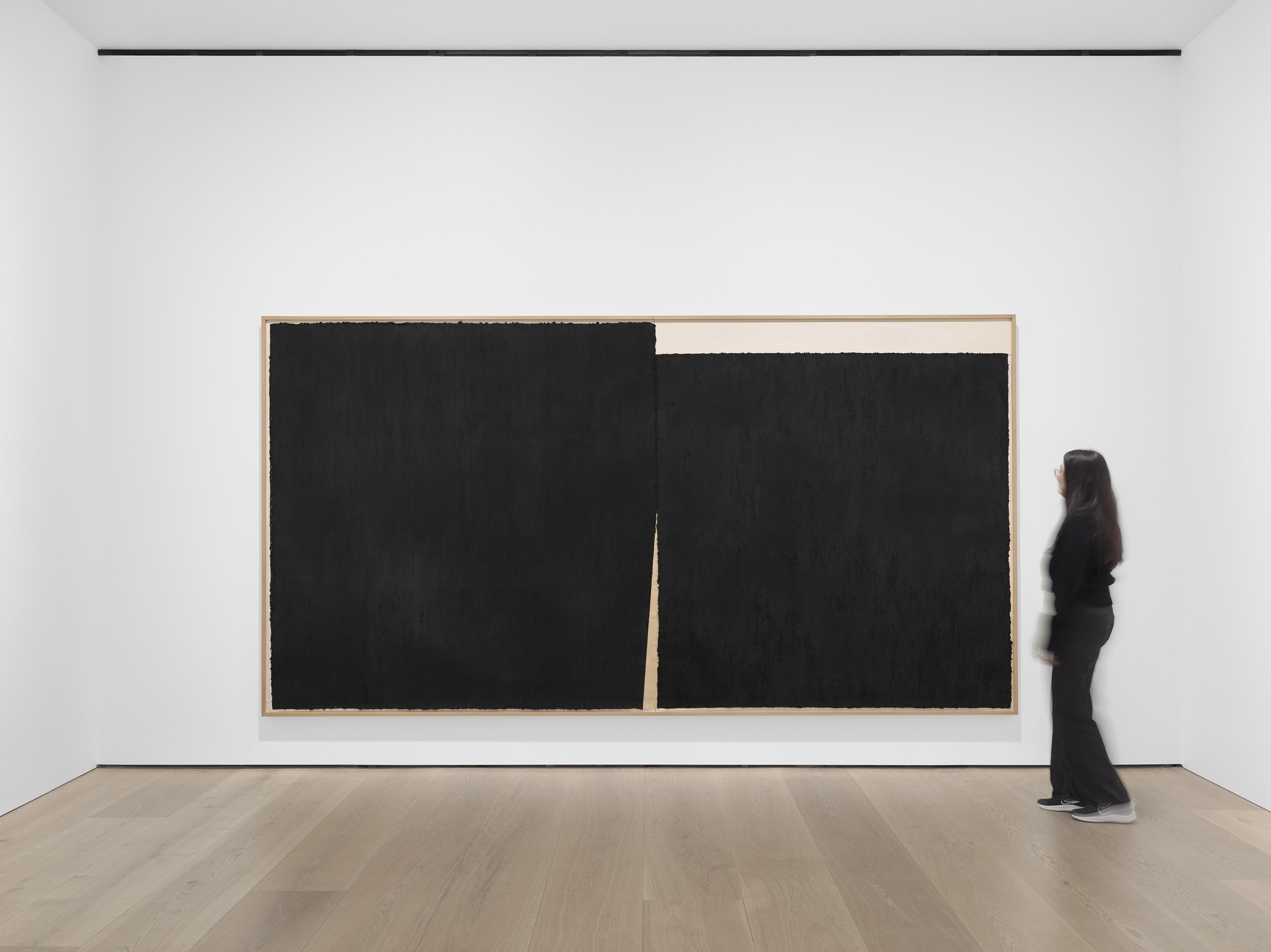
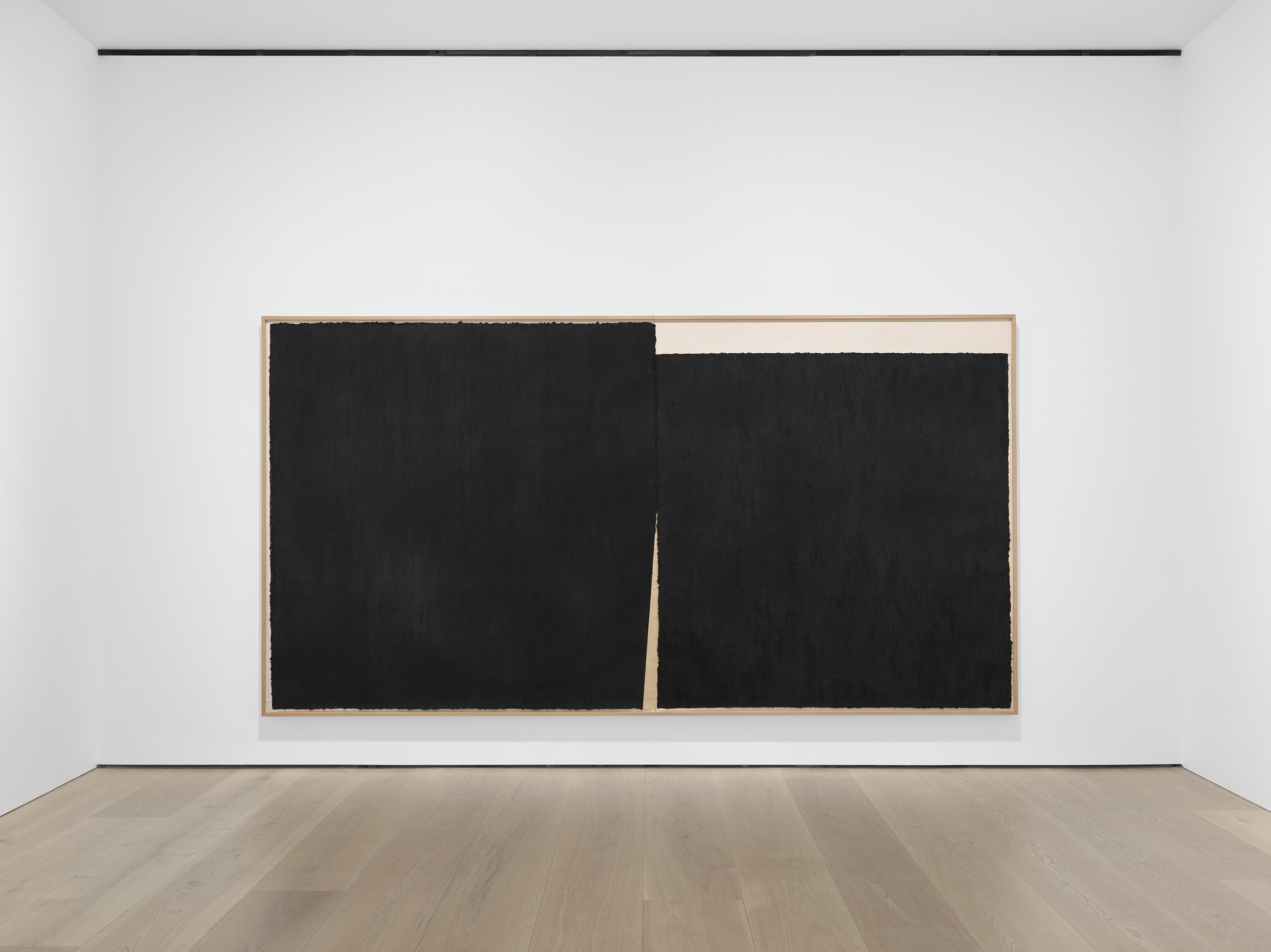
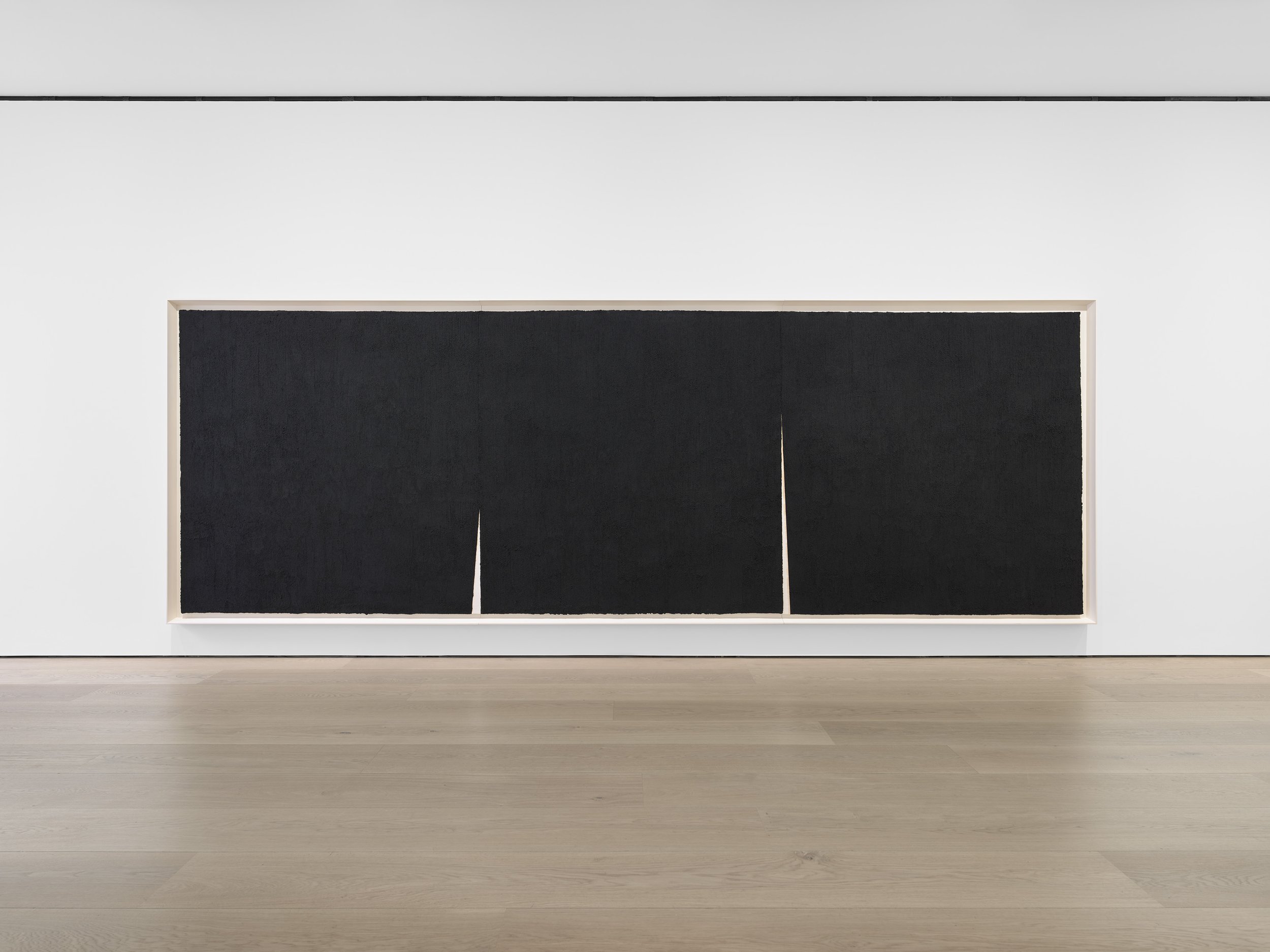
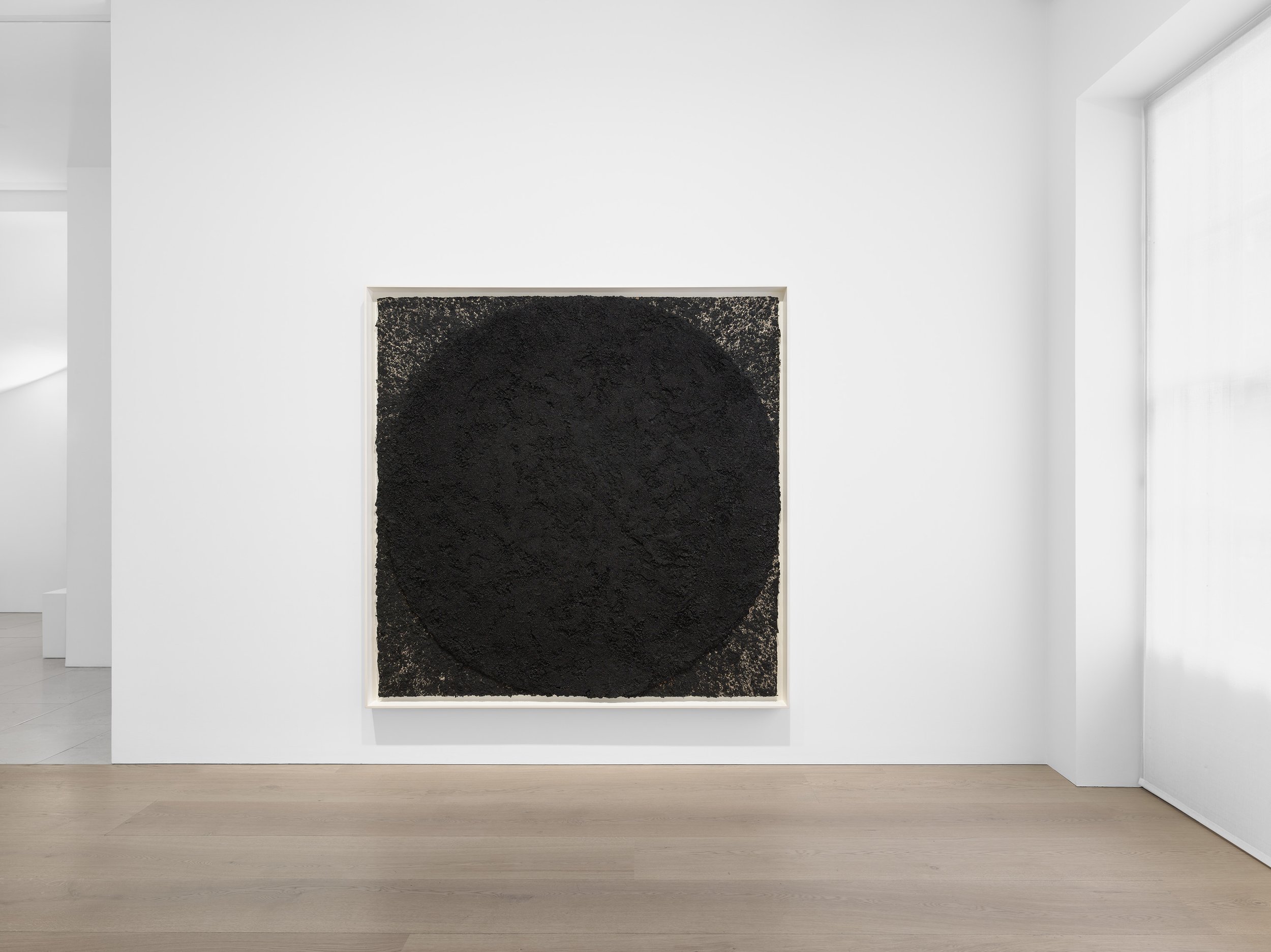
Installation Views: Richard Serra, Six Large Drawings, David Zwirner, London © Richard Serra Courtesy the artist and David Zwirner
Black is a property, not a quality. In terms of weight, black is heavier, creates a larger volume, holds itself in a more compressed field. It is comparable to forging. Since black is the densest color material, it absorbs and dissipates light to a maximum and thereby changes the artificial as well as the natural light in a given room. A black shape can hold its space and place in relation to a larger volume and alter the mass of that volume readily. 1 –Richard Serra
The exhibition of six significant drawings by American artist Richard Serra (1938–2024) are on view at the gallery’s 24 Grafton Street location in London.
Known for his large-scale, site-specific sculptures, Serra consistently produced drawings throughout his career. Beginning in 1971, the artist employed black paintstick (compressed oil paint, wax, and pigment) to create these works. Six Large Drawings is the last exhibition conceived by the artist during his lifetime. Reflecting a considered installation across both floors of the gallery, the presentation includes two of Serra’s large-scale diptychs from the early 1990s, two works from his series of Greenpoint Rounds (begun in 2009), and two multipanel Rift drawings (begun in 2011).
Richard Serra Triple Rift #2, 2018 Paintstick on four sheets of handmade Japanese paper © Richard Serra/Artists Rights Society (ARS), New York/ (DACS), London Courtesy the artist and David Zwirner
As Serra noted about the diptychs: ‘They are masses in relation to each other. They are not about composition or figure ground. They emphasize the comparison of different weights in juxtaposition.’ 2 He has also noted: ‘The construction of these large horizontal drawings refers to something I observed in Machu Picchu in Peru when I went there in 1974. The builders of Machu Picchu cut stones on the site and fit irregular shapes together; oftentimes, the edges only touch on one facet, and then there’s a void between them. It’s not that I went back to look at the notebook notations that I made in Cuzco when I started these drawings, but I’m sure it’s something that seeped into my memory. It is not that these horizontal constructions represent something I’d seen, but it means that there’s something in the reservoir of my understanding of how forms came together that I applied.’ 3
Since 1996, Serra revisited the circular format of ‘rounds’ in various iterations over the course of his career. On view are two works from the artist’s 2009 series of Greenpoint Rounds, which measure approximately eighty inches square. As he noted: ‘What happens in the [earlier Rounds] is that splatters, which are results of the process of making, start to animate the field. I've been working on a new series of large Rounds now since July [2009], trying to see if I could find a way to obliterate the shape even more, so that you are immediately drawn into the field of the drawing without focusing on the shape. What I tried to achieve with the Rounds was to make the mass flood the paper. I am trying to obliterate the shape to the degree that what you're looking at is a black field in which a tremendous amount of matter is pulverized into the paper.’ 4
Installation Views: Richard Serra, Six Large Drawings, David Zwirner, London © Richard Serra Courtesy the artist and David Zwirner
As Neil Cox has written of the Rifts, ‘Serra continues to work as a draftsman on a large scale. These polyptychs, drawn with prepared bricks of noxious black paintstick, made on huge sheets of handmade Japanese paper, were first shown in 2011. They are articulated by “rifts,” very thin vertical triangles where the paper is left blank, intersections that mark out the point of division of the constituent sheets.… The Rift drawings are formidable presences; they are typically at least 8 feet (2.5 metres) high, so giant in comparison to the standing spectator, and between 16 and 20 feet (5 and 6 metres) across, so capable of dominating the visual field.’ 5
Richard Serra was born in San Francisco and lived and worked in New York, the North Fork of Long Island, and Nova Scotia. His first significant solo exhibition was held at the Leo Castelli Warehouse, New York, in 1969. His first solo museum exhibition took place at the Pasadena Art Museum in 1970. Serra subsequently participated in numerous international exhibitions, including Documenta (1972, 1977, 1982, and 1987) in Kassel, Germany; the 1980, 1984, 2001, and 2013 editions of the Venice Biennale; and the Whitney Museum of American Art’s Annual and Biennial exhibitions of 1968, 1970, 1973, 1977, 1979, 1981, 1995, and 2006.
Richard Serra Double Rift #6, 2013 Paintstick on three sheets of handmade Japanese paper © Richard Serra/Artists Rights Society (ARS), New York/ (DACS), London Courtesy the artist and David Zwirner
Solo exhibitions of Serra’s work have been held at numerous public institutions worldwide, including, among others, the Museum Boijmans Van Beuningen, Rotterdam, the Netherlands, 1980; Musée National d’Art Moderne, Paris, 1984; Museum Haus Lange, Krefeld, Germany, 1985; The Museum of Modern Art, New York, 1986; Westfälisches Landesmuseum für Kunst und Kulturgeschichte, Münster, Germany, 1987; Städtische Galerie im Lenbachhaus, Munich, 1987; Stedelijk Van Abbemuseum, Eindhoven, the Netherlands, 1988; Kunsthaus Zürich, 1990; CAPC Musée d’Art Contemporain, Bordeaux, France, 1990; Museo Nacional Centro de Arte Reina Sofía, Madrid, 1992; Kunstsammlung Nordrhein-Westfalen, Düsseldorf, 1992; Dia Center for the Arts, New York, 1997; Centro de Arte Hélio Oiticica, Rio de Janeiro, 1997–1998; Trajan’s Market, Rome, 2000; Pulitzer Foundation for the Arts, St. Louis, 2003; and Museo Archeologico Nazionale di Napoli, Naples, 2004. In 2005, The Matter of Time, a series of eight large-scale works by Serra from 1994 to 2005, was installed permanently at the Guggenheim Museum Bilbao, and in 2007, The Museum of Modern Art, New York, presented the retrospective Richard Serra Sculpture: Forty Years. Promenade, a major site-specific installation, was shown at the Grand Palais, Paris, for MONUMENTA 2008. In 2011, the artist’s large-scale, site-specific sculpture 7 was permanently installed opposite the Museum of Islamic Art in Doha, Qatar. In 2014, the Qatar Museum Authority presented a two-venue retrospective survey of Serra’s work at the QMA Gallery and the Al Riwaq exhibition space, Doha, and East-West/West-East (2014) was permanently installed in the Brouq Nature Reserve in the Zekreet Desert, Qatar. In June 2020, a new major sculpture by Serra was installed on the West Quad of Kenyon College, in Gambier, Ohio. In 2022, Glenstone, Potomac, Maryland, opened a new building designed by Thomas Phifer in collaboration with the artist to house Four Rounds: Equal Weight, Unequal Measure, Serra’s monumental sculpture that debuted at David Zwirner in 2017.
Richard Serra Navajo, 1990 Paintstick on two sheets of paper © Richard Serra/Artists Rights Society (ARS), New York/ (DACS), London Courtesy the artist and David Zwirner
Museum exhibitions that have focused on the artist’s drawings include Richard Serra: Tekeningen/Drawings 1971–1977, Stedelijk Museum, Amsterdam, 1977; Richard Serra: Zeichnungen 1971–1977, Kunsthalle Tübingen, Germany, 1978; Richard Serra: Drawings, Louisiana Museum, Humlebæk, Denmark, 1986; Richard Serra: Tekeningen/Drawings, Bonnefantemuseum, Maastricht, the Netherlands, 1990; Richard Serra: Drawings, Serpentine Gallery, London, 1992; Richard Serra: Drawings and Prints, The National Museum of Art, Osaka, Japan, 1994; Richard Serra: Rio Rounds, Centro de Arte Hélio Oiticica, Rio de Janeiro, 1997–1998; and Richard Serra: Drawings: Work Comes Out of Work, Kunsthaus Bregenz, Austria, 2008. A major travelling retrospective dedicated to the artist’s drawings was presented at The Metropolitan Museum of Art, New York; the San Francisco Museum of Modern Art; and The Menil Collection, Houston (which was the organising venue), in 2011–2012. The Courtauld Gallery, London, presented Richard Serra: Drawings for The Courtauld in 2013, and Richard Serra: desenhos na casa da Gávea was on view at Instituto Moreira Salles, Rio de Janeiro, in 2014. Richard Serra: Drawings 2015–2017, a significant overview of the artist’s recent works on paper, was on view at the Museum Boijmans Van Beuningen, Rotterdam, the Netherlands, in 2017. In 2022, the Guggenheim Bilbao presented Serra/Seurat. Drawings, an exhibition pairing a selection of Serra’s recent drawings alongside those by Georges Seurat. Serra was the recipient of many notable prizes and awards, including a J. Paul Getty Medal (2018) awarded in honour of extraordinary contributions to the practice, understanding, and support of the arts; the Chevalier de l’Ordre national de la Légion d’honneur, Republic of France (2015); Orden de las Artes y las Letras de España, Spain (2008); Orden pour le Mérite für Wissenschaften und Künste, Federal Republic of Germany (2002); Leone d’Oro for lifetime achievement, Venice Biennale, Italy (2001); Praemium Imperiale, Japan Art Association (1994); Carnegie Prize (1985); a National Endowment for the Arts Fellowship (1974); and a Fulbright Grant (1965). In 2013 in New York, David Zwirner presented Richard Serra: Early Work, a critically acclaimed exhibition that brought together significant works from 1966 to 1971. The accompanying catalogue extensively covers this period of the artist’s career with a compendium of archival texts and photographs and an essay by Hal Foster. In 2014, the gallery presented an exhibition of new drawings, Richard Serra: Vertical and Horizontal Reversals; a catalogue accompanied the exhibition and included an essay by Gordon Hughes. Richard Serra: Equal, an installation in forged weatherproof steel, was presented at David Zwirner, New York, in 2015. That work is now in the collection of The Museum of Modern Art, New York. In 2016, David Zwirner Books/Steidl published Richard Serra: Forged Steel, which surveys the artist’s work in forged steel since 1977 and features scholarship by Richard Shiff and texts by the artist. In 2017, the gallery presented an exhibition of new sculpture and drawings by the artist at its New York location. In 2018, David Zwirner presented a series of new drawings by Serra in Hong Kong.
In 2022, Serra’s last realised sculpture, a forged steel work titled 2022, was presented at David Zwirner, New York, alongside a series of drawings by the artist; these two presentations were accompanied by the publication Richard Serra: 2022. Six Large Drawings is the first show of the artist’s work at David Zwirner’s London location.
Richard Serra Periodic Table, 1991 Paintstick on two sheets of paper © Richard Serra/Artists Rights Society (ARS), New York/ (DACS), London Courtesy the artist and David Zwirner
Citations
1 Richard Serra, “Notes on Drawing” (1988), in Richard Serra: Drawings/Zeichnungen 1969–1990. Exh. cat. and cat. rais. (Bern: Benteli, 1990), p. 11
2 Gary Garrels, ‘An Interview with Richard Serra.’ in Richard Serra: Drawing: A Retrospective. Exh. cat. (Houston: The Menil Collection, 2011), p. 79.
3 Richard Serra, quoted in Phong Bui, ‘In Conversation: Richard Serra with Phong Bui.’ The Brooklyn Rail (July–August 2011), accessed online.
4 Garrels, ibid., p. 82.
5 Neil Cox, ‘The Shape of Feeling,’ in Richard Serra: Drawings 2015–2017. Exh. cat. (New York/Göttingen, Germany: Gagosian/Steidl, 2017), p. 14.
This exhibition opened on April 9th and will close on the 18th of May 2024, at the London location at 24 Grafton Street. For more information about this exhibit, visit David Zwirner’s site , along with following them on Instagram and find the gallery also on Artsy here.
Wolfgang Tillmans : The Point Is Matter
Installation view, Wolfgang Tillmans: The Point Is Matter, David Zwirner, Hong Kong, March 25—May 11, 2024 Courtesy David Zwirner
David Zwirner is pleased to present The Point Is Matter, a solo exhibition of new and recent work by Wolfgang Tillmans at the gallery’s location in Hong Kong. The exhibition’s title stems from Tillmans’s long-term understanding of his work sitting between the physical reality and presence of the world he works and lives in and the conceptual, sociopolitical, sensual, and spiritual concerns that underpin his practice. Presented across both floors of the gallery, the works on view include depictions of changing forms of atmosphere and elusive natural phenomena; pictures that explore notions of time and temporality; and images that engage with the artist’s expansive conceptions of the still life and the portrait. Tillmans punctuates the exhibition with works made in Addis Ababa, Berlin, Lagos, and Mongolia, along with those taken in Hong Kong and Shenzhen, sensitively invoking resonant associations between the local and the world at large, while advocating for an experience of connectedness that is rooted in the process of looking.
In each of the gallery spaces, distinct subject matter emerges. Among them is a room that focuses on images that picture the cycle of water as it transitions from a liquid to a solid (ice) to a gas (water vapor). In Lunar Landscape (2022), the Atlantic Ocean glows at great luminosity, the image colliding the celestial plane with the surface of the Earth. Sirius Through a Defocused Telescope, a–f (each 2023) show Sirius, the brightest star visible to the human eye, at distinct moments as the star “twinkles.” The works depict air currents and air cells of different densities that result in an ever-changing flicker, blur, and display of spectral colors and shapes. Astronomy represents the artist’s earliest passion, having trained his eye through the observation of the physical universe, the sky, and celestial phenomena.
Wolfgang Tillmans, Badehose, photocopy II, 1996 Courtesy David Zwirner, New York/Hong Kong; Galerie Buchholz, Berlin/Cologne; and Maureen Paley, London
Tillmans further indicates the subtle geological movements and natural states of matter in a world undergoing historic and rapid changes. In Ulaanbaatar Still Life (2023), arranged in Mongolia, silk flowers rest on a heating unit in front of a window that overlooks a snowy landscape and a ger, a portable tent that can withstand fierce winter winds, used in the region as a nomadic, adaptable home. Summer Storm Rain Drops Freeze Frame (2023) captures rain droplets outside the artist’s studio in Berlin in an otherwise imperceptible moment of transition.
Other works in the show delicately evince a sense of temporality. These pictures evoke the cumulative passage of time in the distinct moments they depict.Filled with Light, a (2011) exposes in large scale the luminous shifts that Tillmans observed in his studio, rays of light casting the shadows of window frames onto the bare floor, walls, and ceiling. InWindow Left Open (2023), another work Tillmans made in his studio, we see a layered interplay between light and shadow, interior and exterior architecture, and domesticized vegetation. In other works on view, Tillmans reflects further on transformative processes. In Office Paper For Food Wrapping Recycling, Addis Ababa (2019), discarded business papers are repurposed as packing material. InTemporary Shoe Shop (2022), a car hood and windscreen are covered in trainers—the surfaces effectively converted into a retail outlet in Lagos.
Wolfgang Tillmans, Window Left Open, 2023 Courtesy David Zwirner, New York/Hong Kong; Galerie Buchholz, Berlin/Cologne; and Maureen Paley, London
Tillmans’s expanded approach to still life and the portrait are emphasized throughout the exhibition. In a large still life, citrus fruit and a smoked cigarette in an ashtray are laid atop a copy of the Los Angeles Times from 2001. In Badehose, photocopy II (1996), the sculptural qualities of swimming trunks are translated into two-dimensionality, their folds abstracted further by the photocopying process. Though recognizable, the otherwise distorted, crumpled form is suggestive of the way in which figuration and abstraction coexist within Tillmans’s oeuvre, as well as the relationship of photography to surface and three-dimensionality.
Tillmans’s portraits are at times long-planned, at other times the result of unexpected interactions or in-the-moment encounters. The portraits shown in this exhibition range from Anders Stretching On the Carpet (2022), of his oft-photographed long-term friend, the Danish artist Anders Clausen, toZaur Abduraimov (2023), a Crimean Tatar refugee whom Tillmans shot in Toronto, where Abduraimov works; from Jodie Foster, an actor long admired by the artist, photographed in his kitchen, to the women of Maraljingoo, Sambuunyam & Norimaa in their ger (2023), which shows multiple generations of a Mongolian family in their home. Tillmans’s portraits have served as an ongoing investigation: what does it mean to depict a person?
Wolfgang Tillmans, Filled with Light, a, 2011 Courtesy David Zwirner, New York/Hong Kong; Galerie Buchholz, Berlin/Cologne; and Maureen Paley, London
A new video work on view, Build from Here (Video Room) (2024), extends Tillmans’s fascination with the interplay between his video and music-making languages and showcases his interest in sound and movement. The video features tracks from the artist’s forthcoming album, Build From Here, to be released on April 26; Tillmans will be working on the video right through the installation period, in response to the exhibition. The video consists of footage recorded by Tillmans at different times and locations. In the opening and closing sequences, we see Tillmans’s body at moonrise, silhouetted as the full moon illuminates the ocean; he performs gestures with a large stick-like form that exaggerates the body’s improvised movements as he effectively draws in space. Another sequence shows telescopic imagery of the surface of the moon: shot in real time, it reveals the rotation of the earth as the moon gradually moves across the screen. Punctuating the footage is close-up imagery of an industrial offset printer in action, in which ink rollers covered in paint show the different stages of the analogue printing process.
Tillmans has visited and returned to Hong Kong and Shenzhen on numerous occasions in his extensive travels and across his body of work. HKG Airport Interior (2023) shows a largely dysfunctional informational display wall, with a pixelated screen frozen in a moment of technological rupture. In HK drive (2018), an image of an outreached hand on the back of a Hong Kong bus merges with the porticoed stairwell on the street—the public built environment seamlessly flowing into the visual excesses of advertising. Portraits such as those of a young woman, Yixue, seated in a banquet hall, and a scene of packages toppling onto a Shenzhen street connect the presentation to the surrounding metropolis and region.
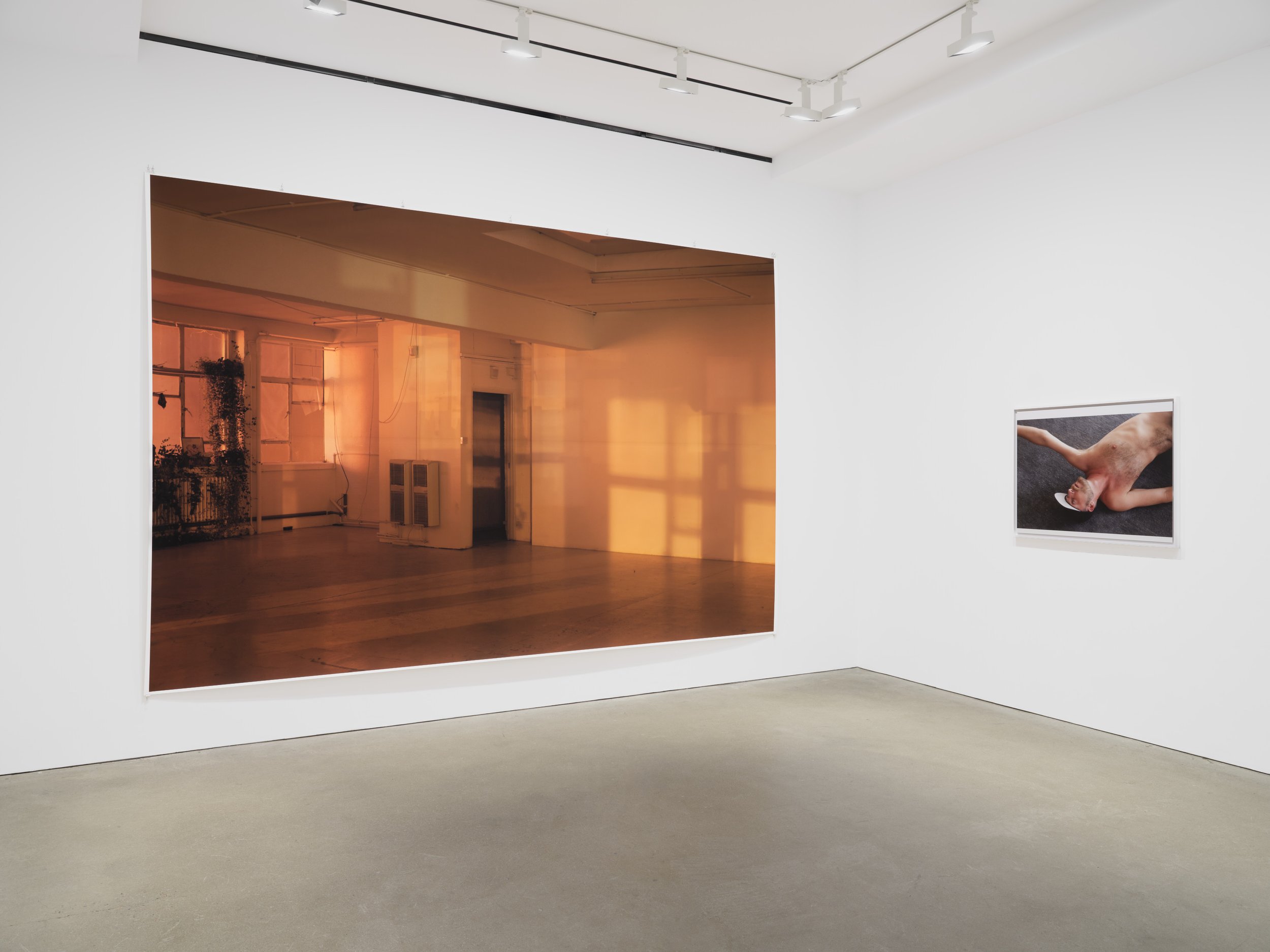
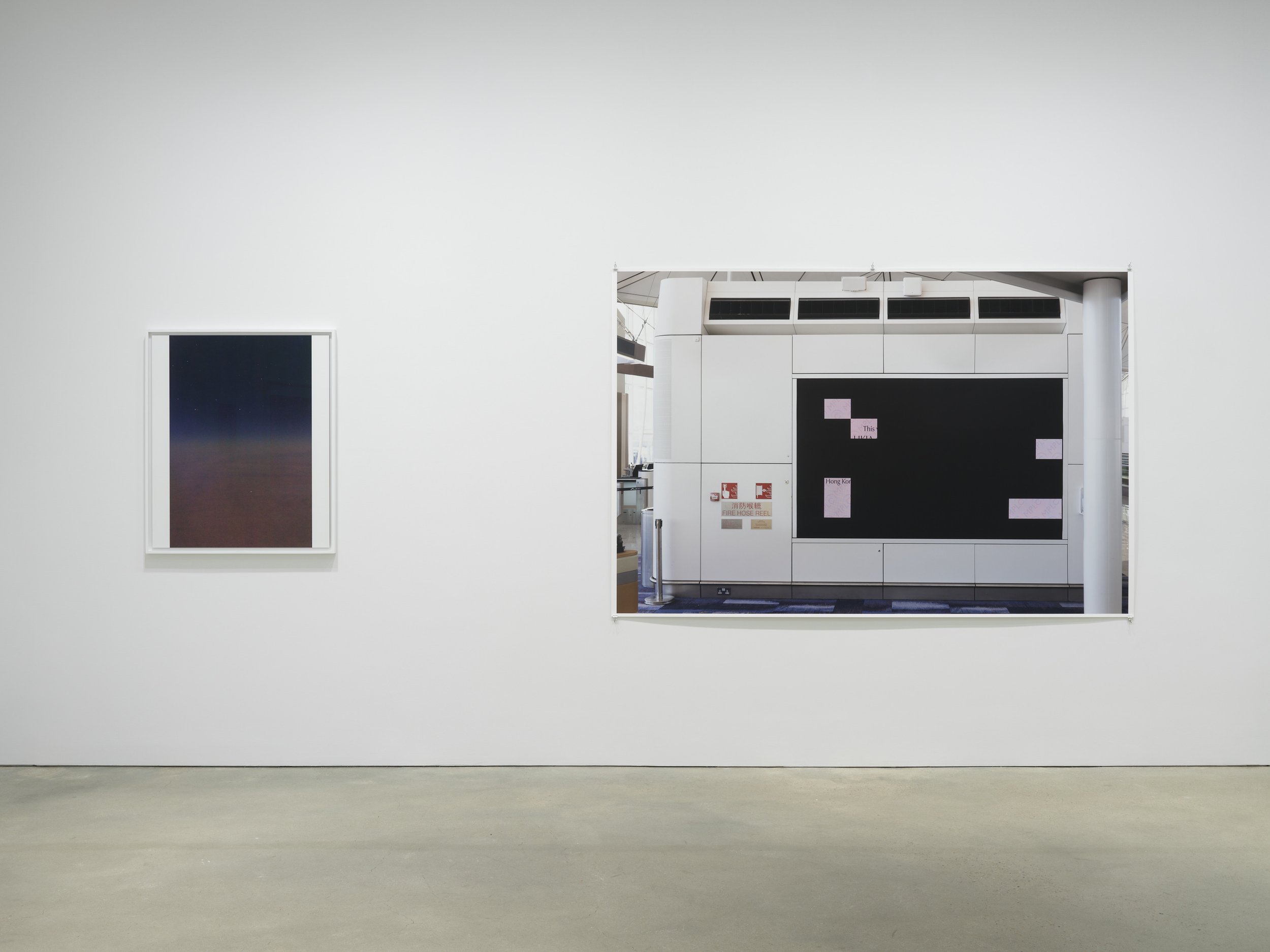
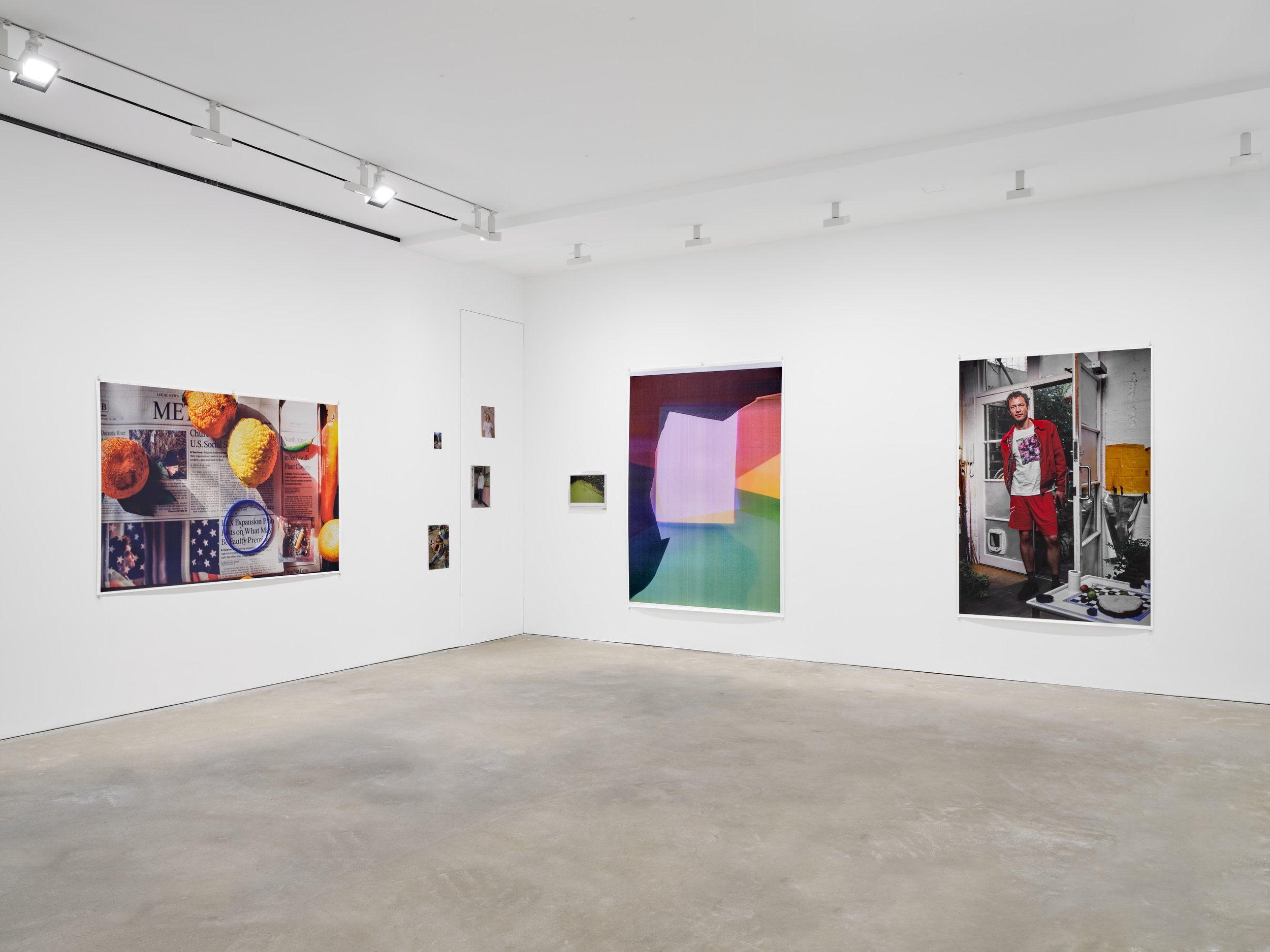
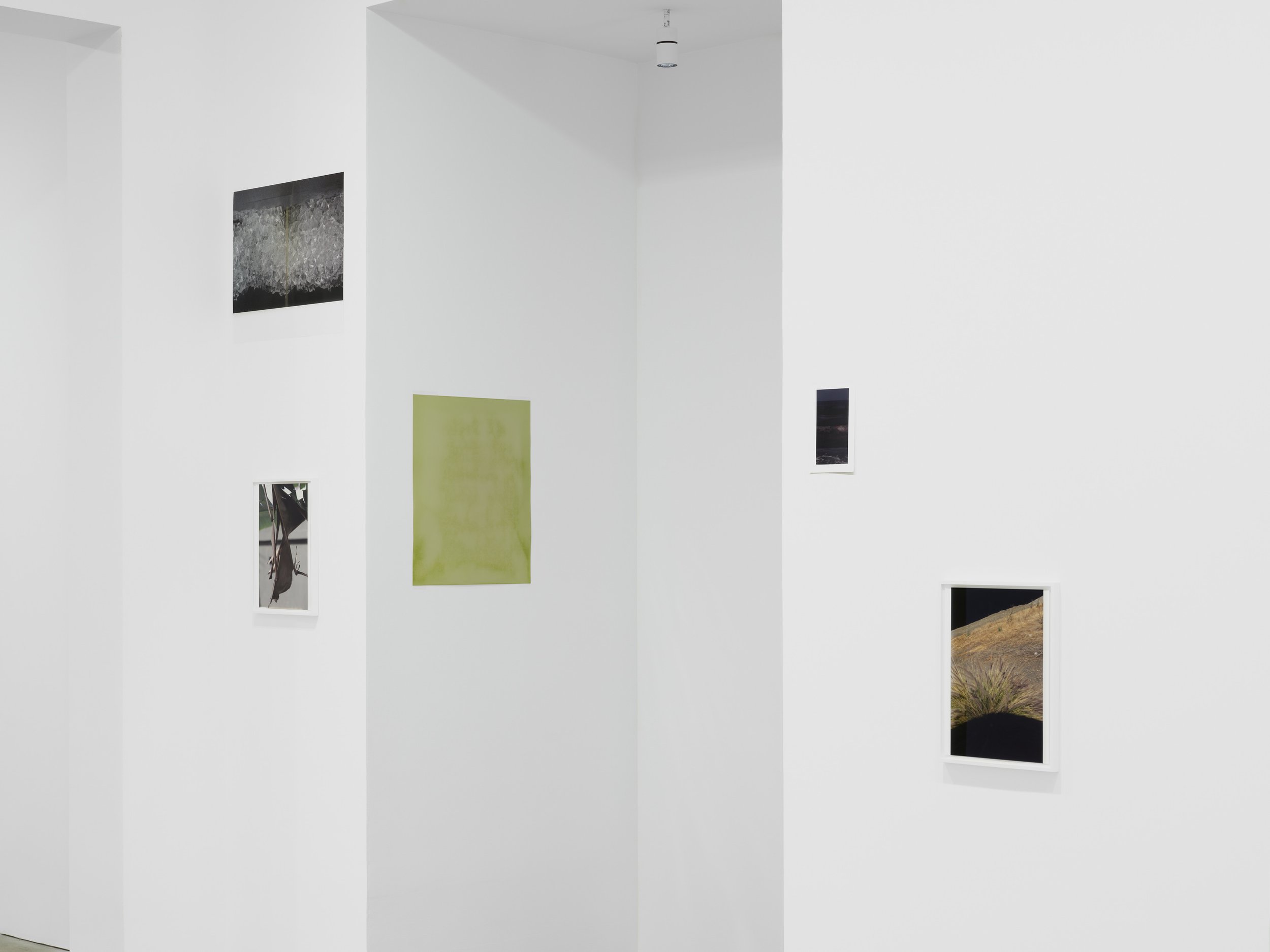
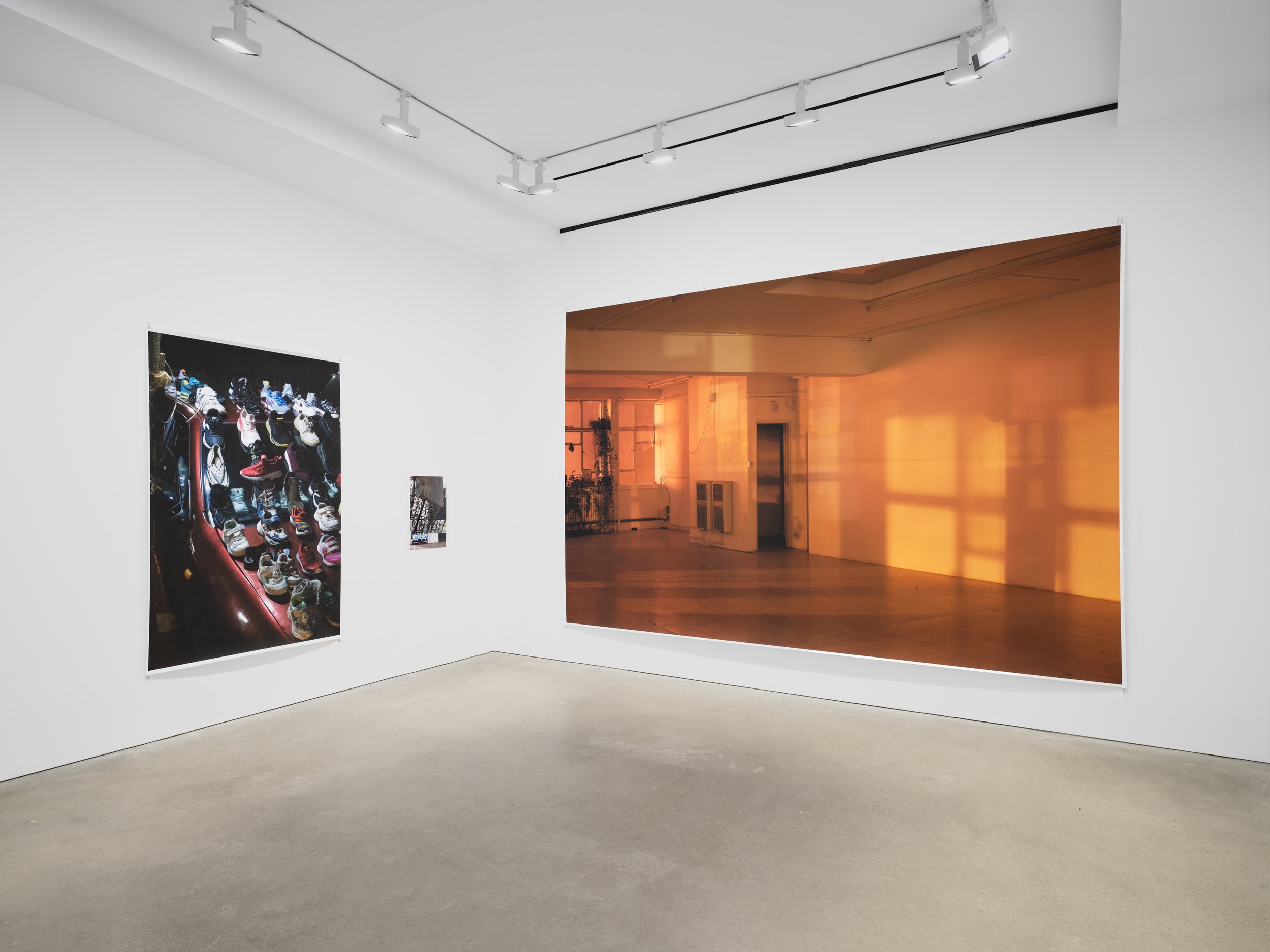
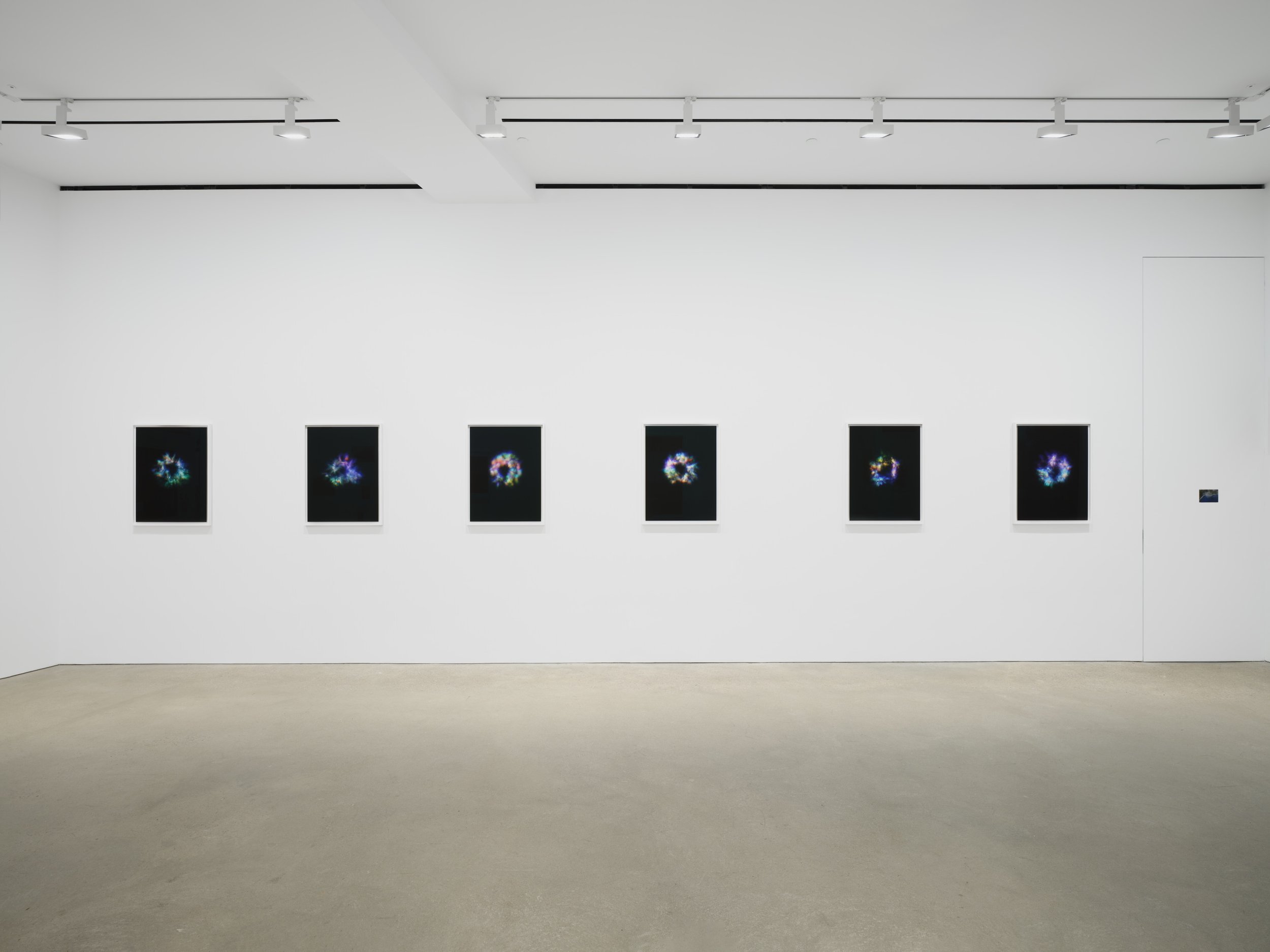
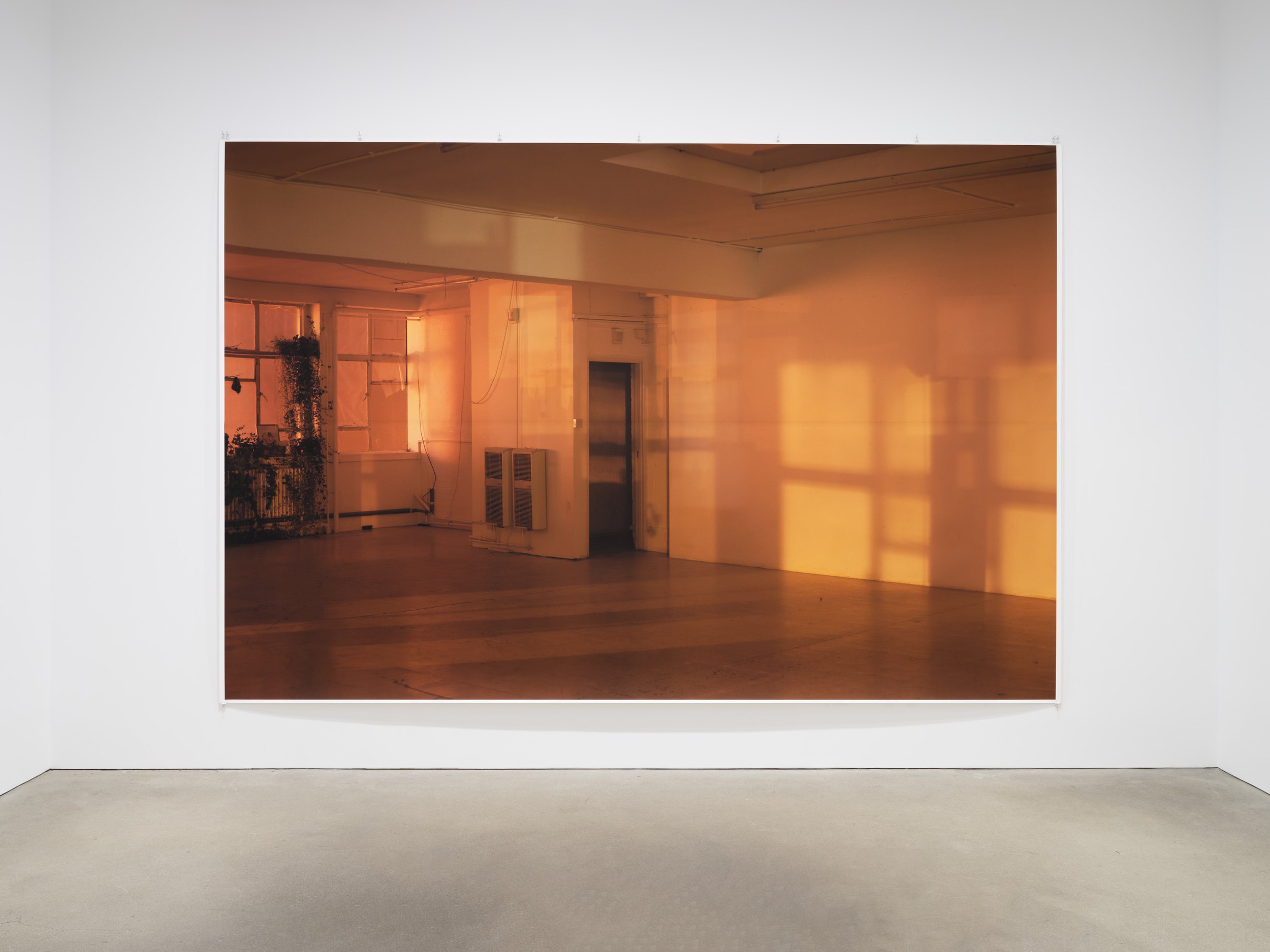
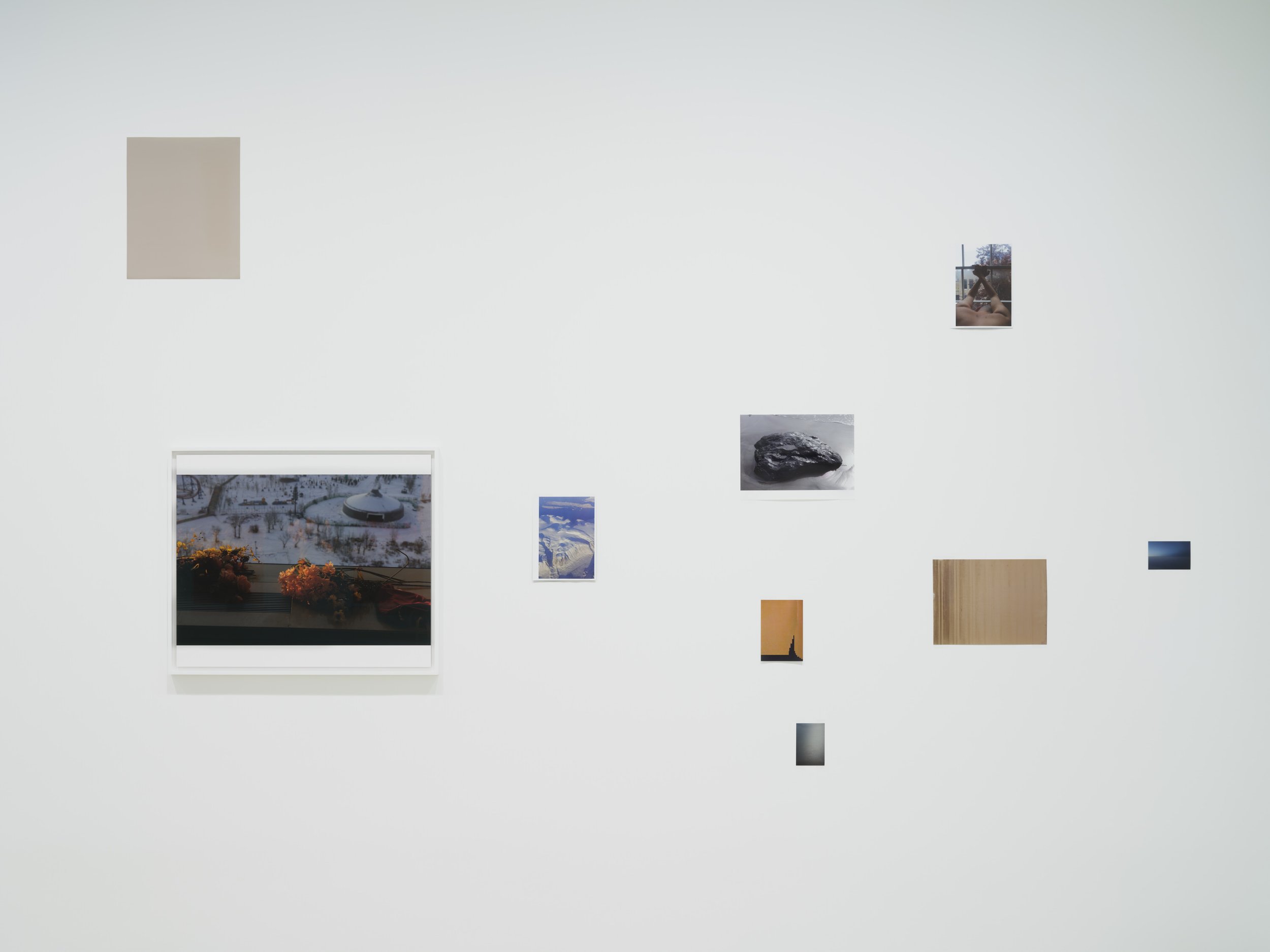
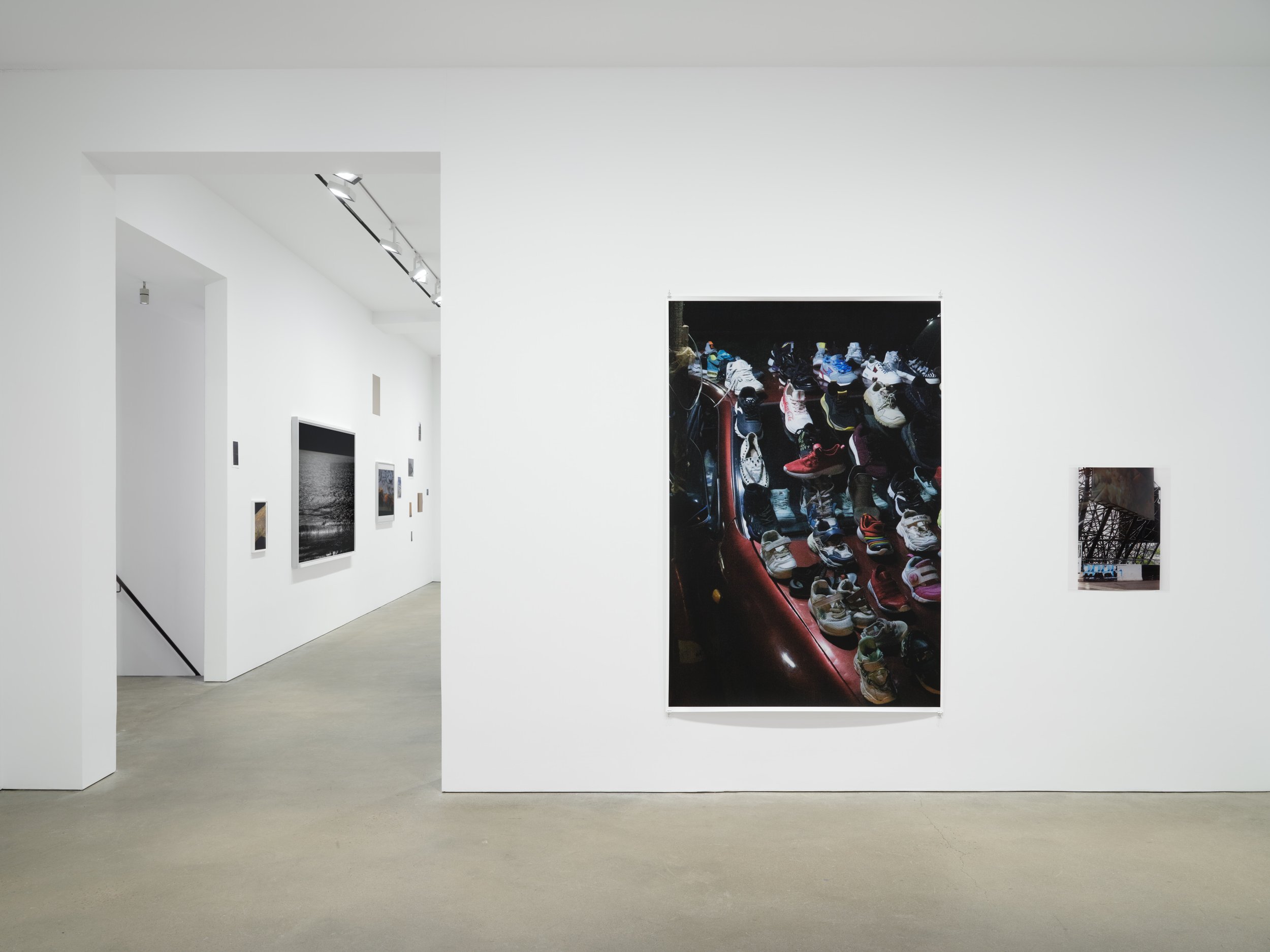
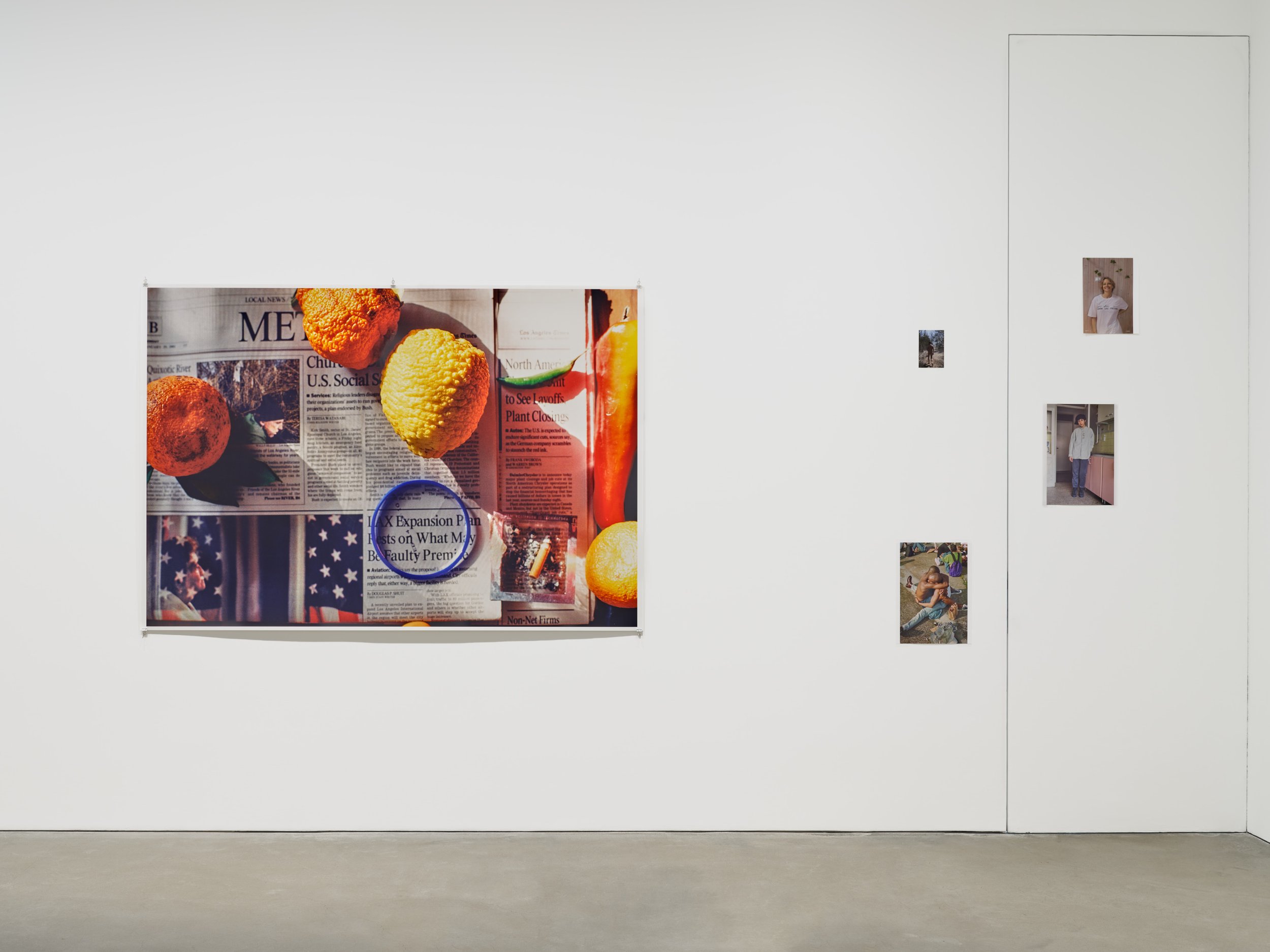
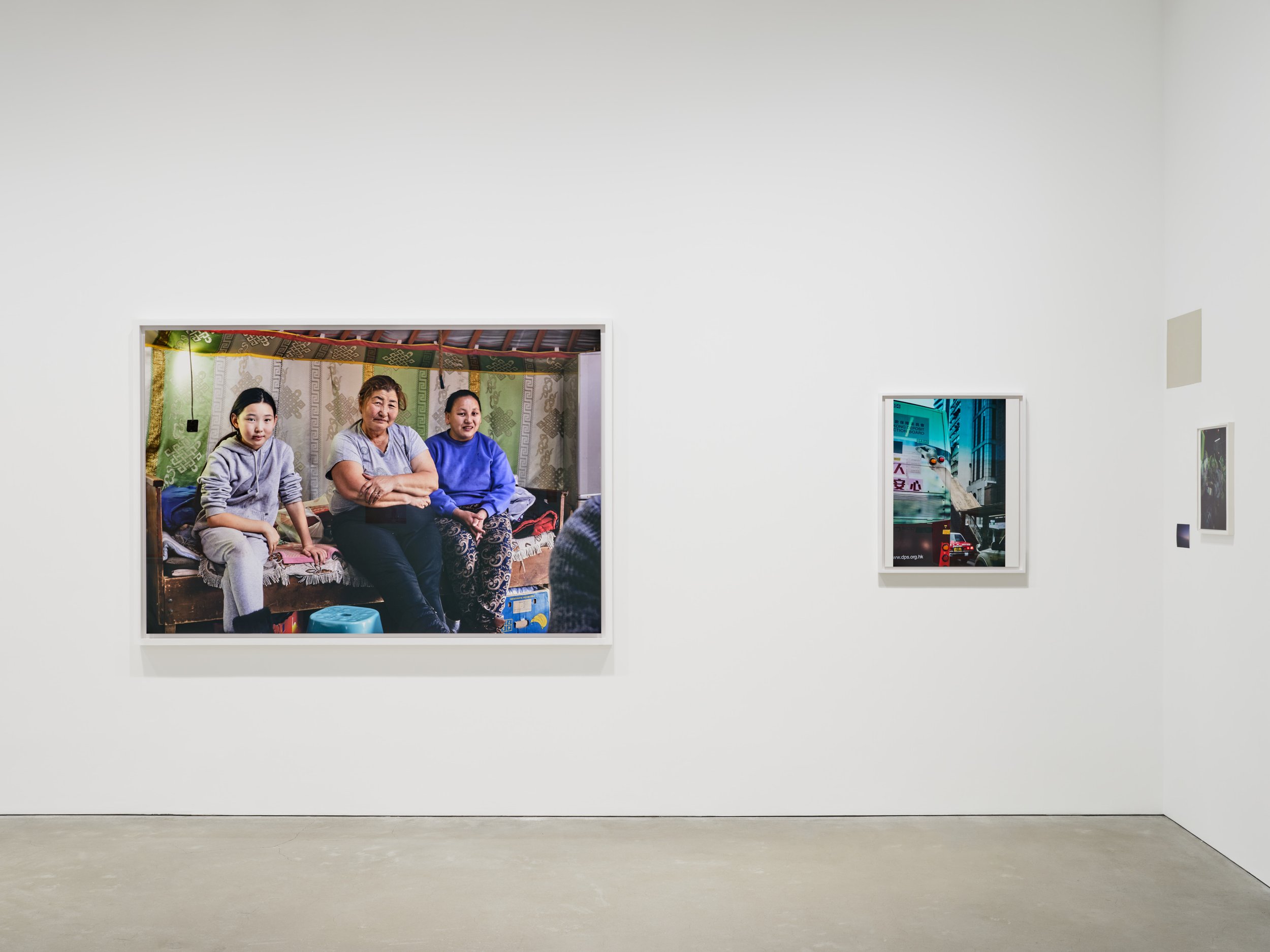
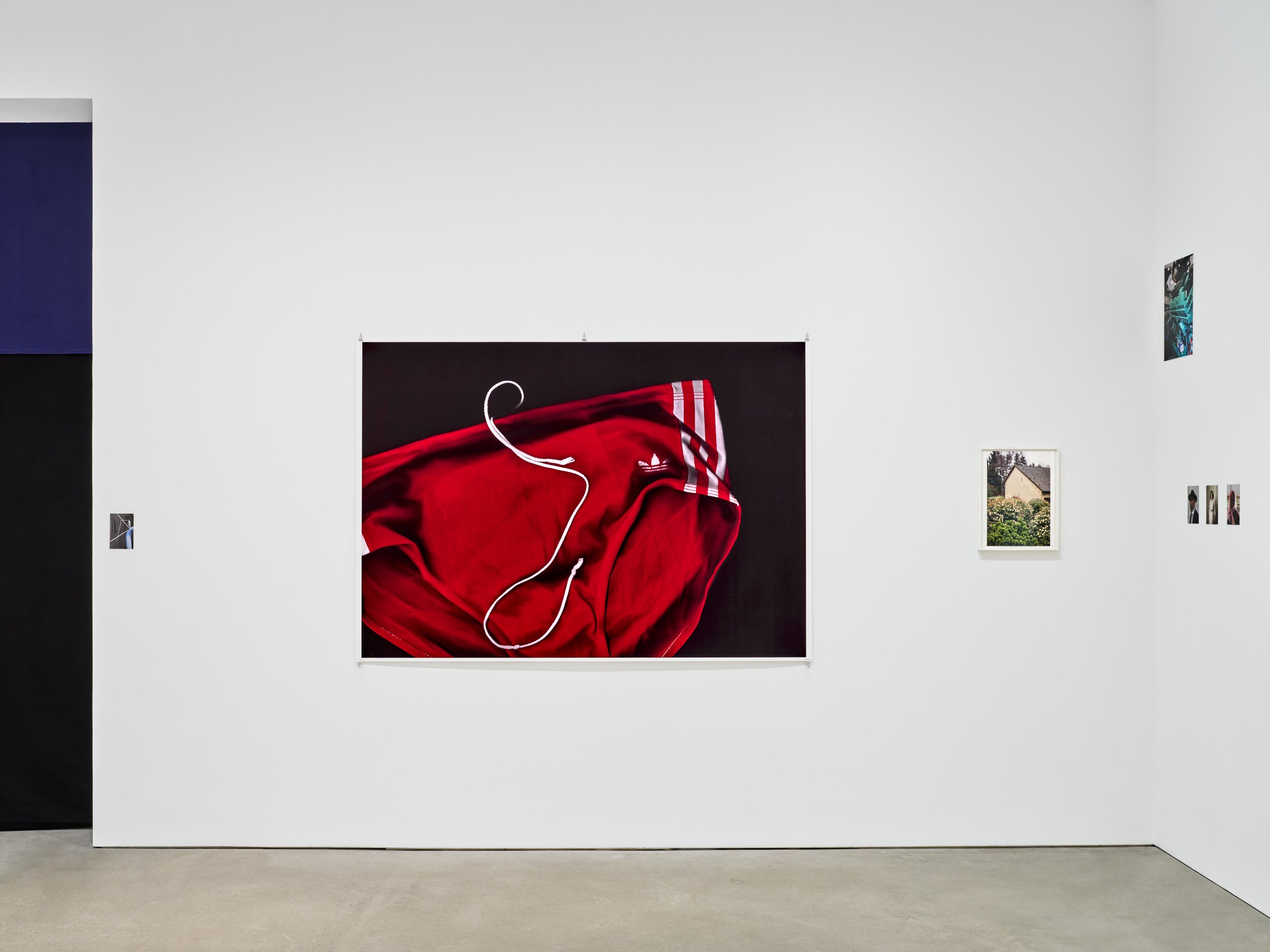
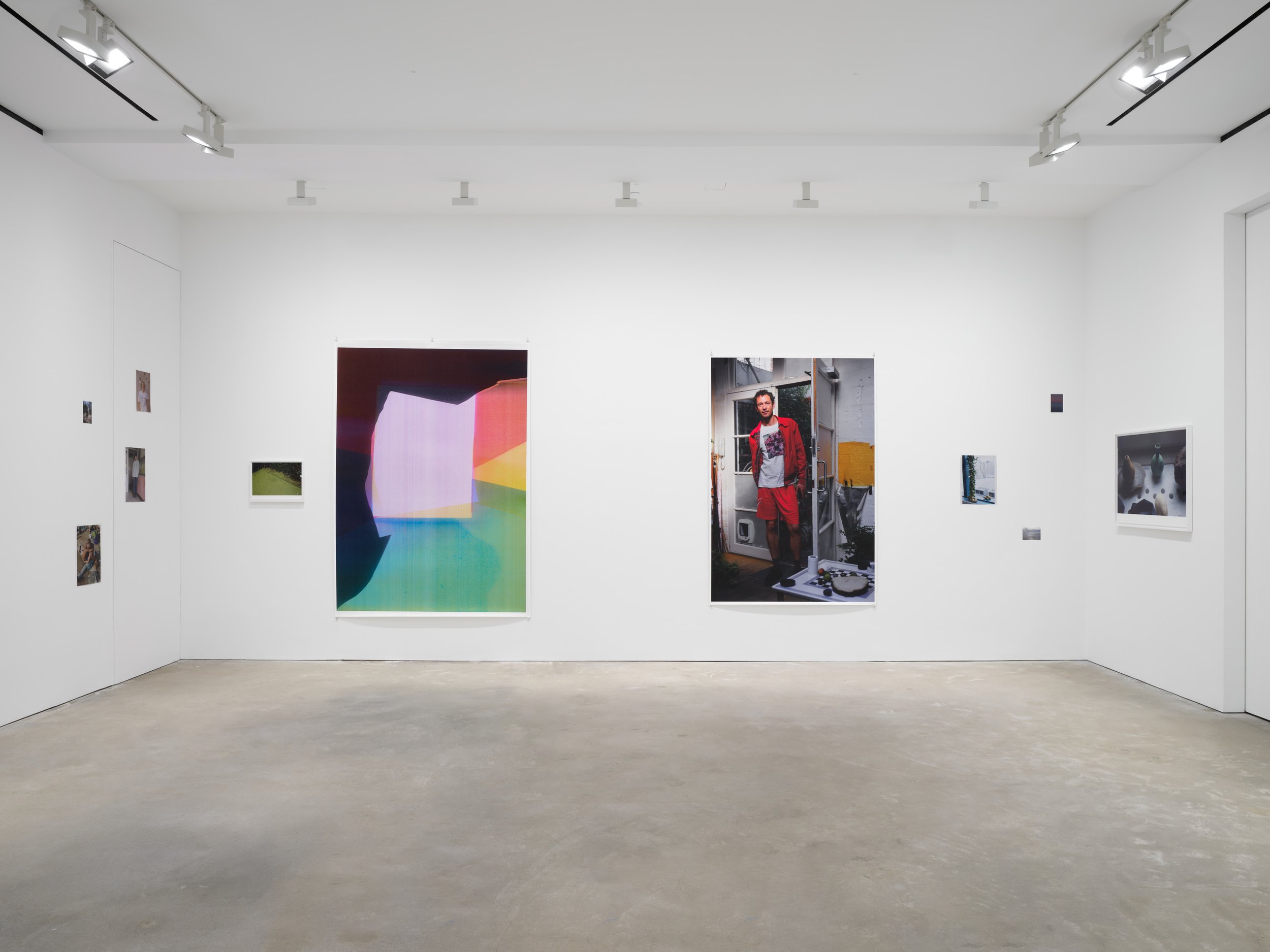
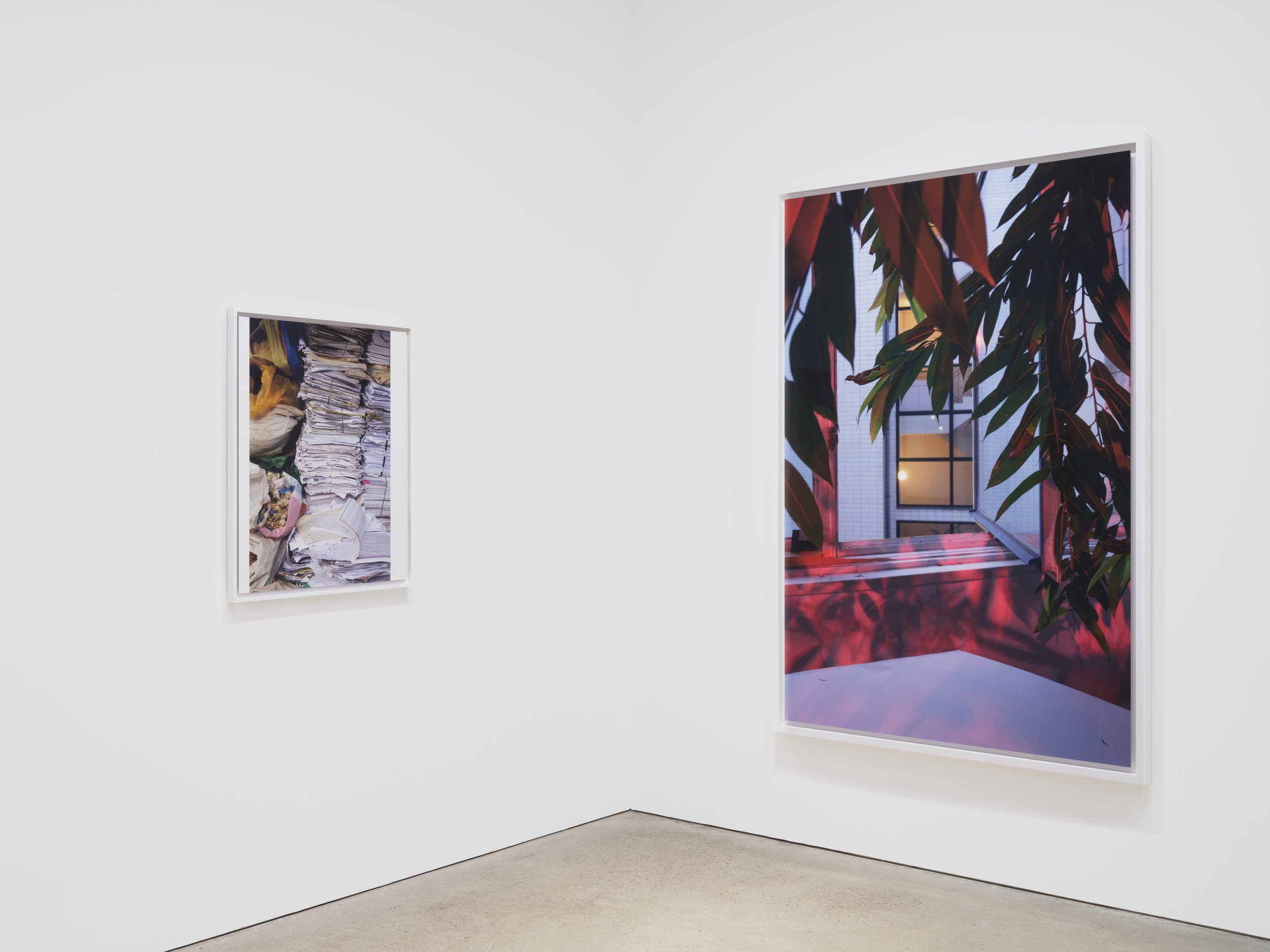
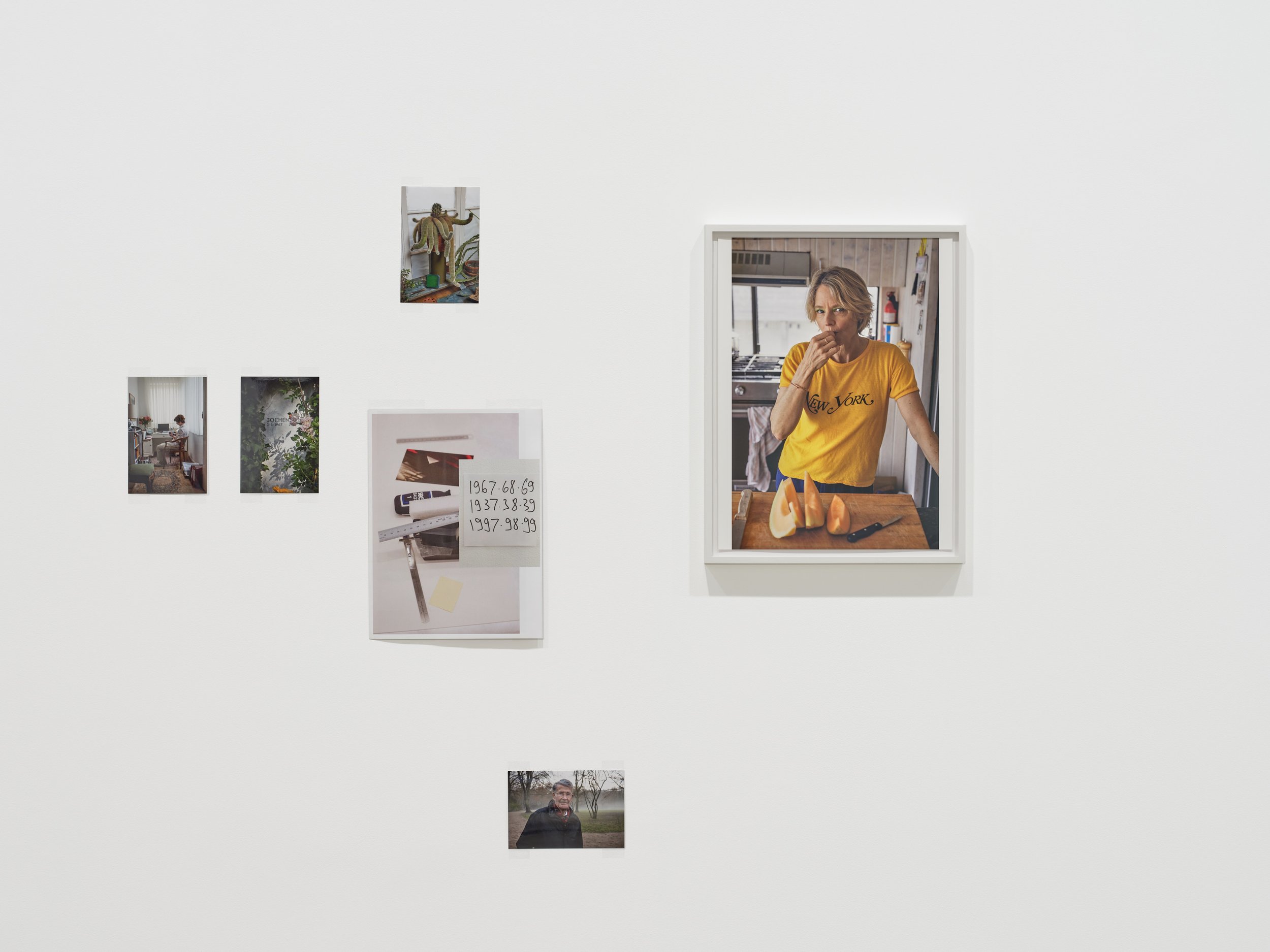
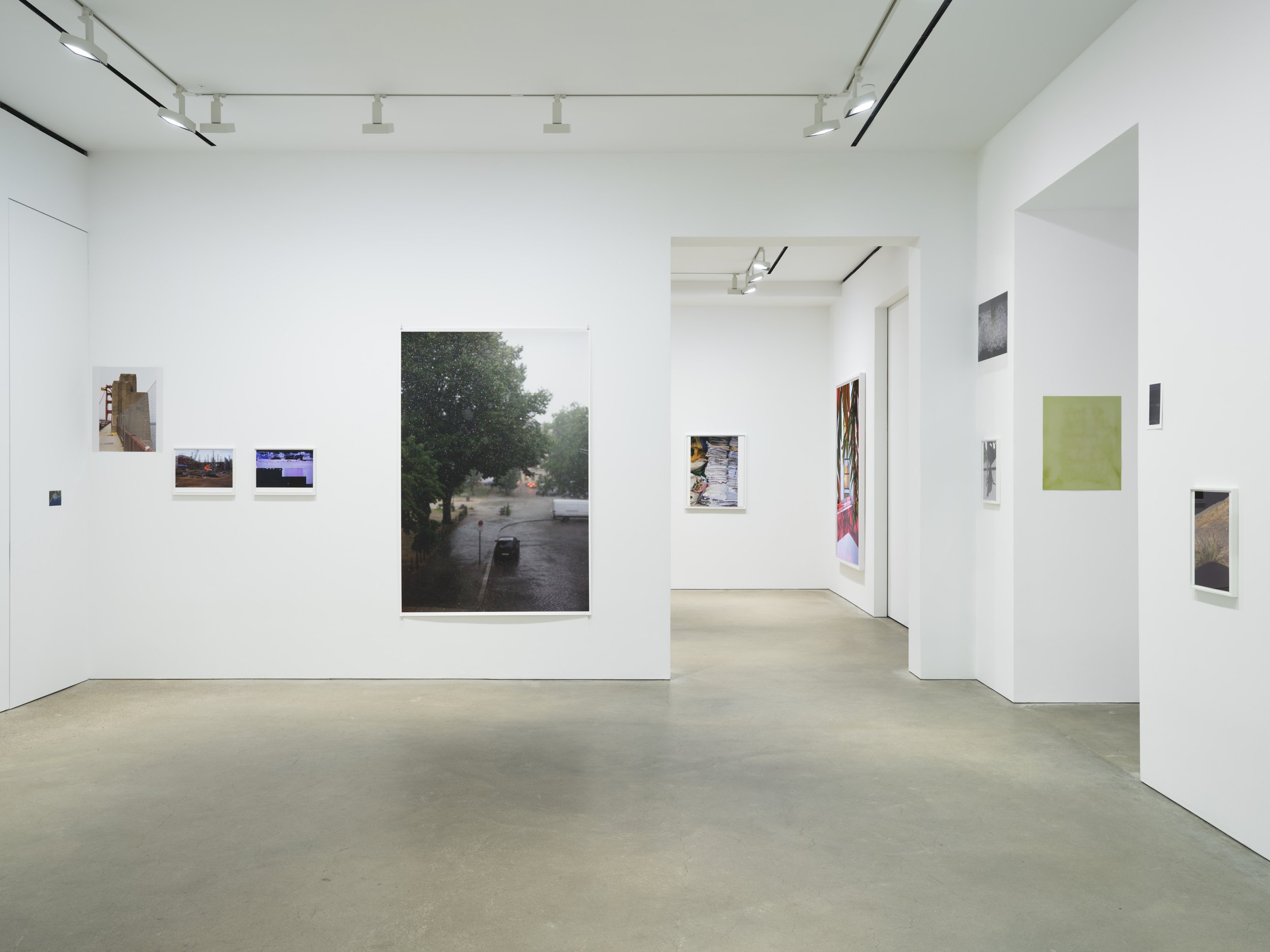
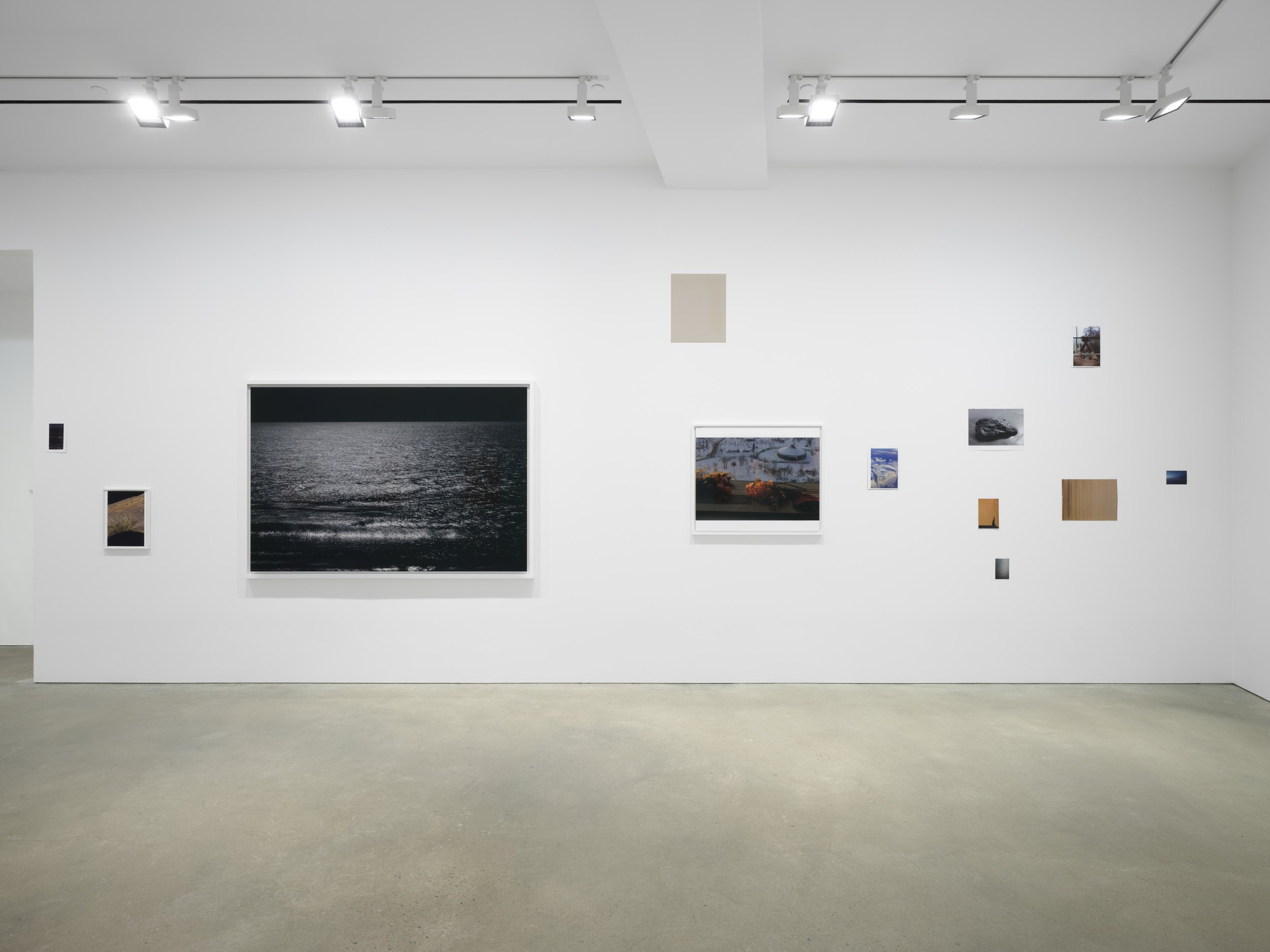
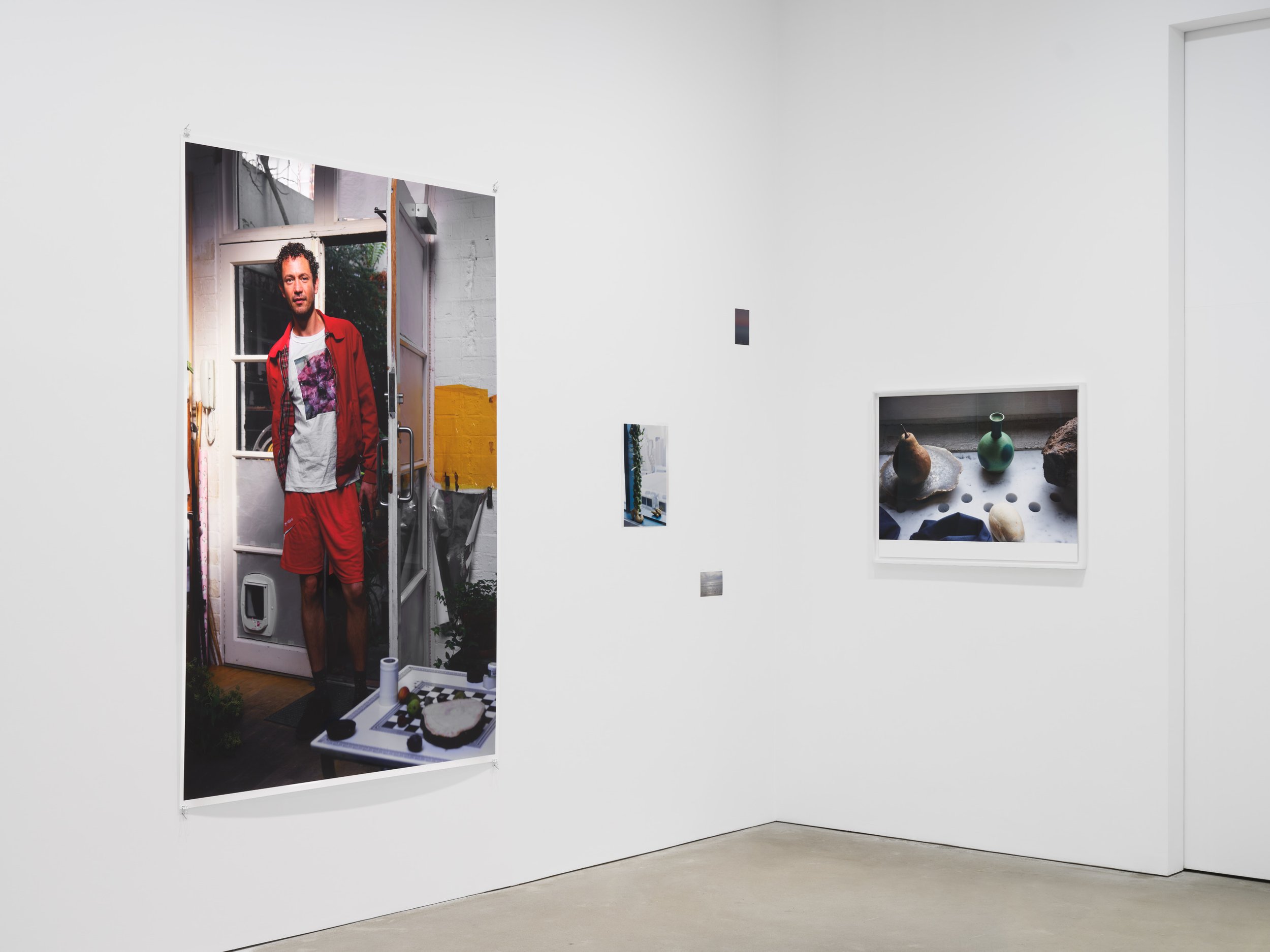
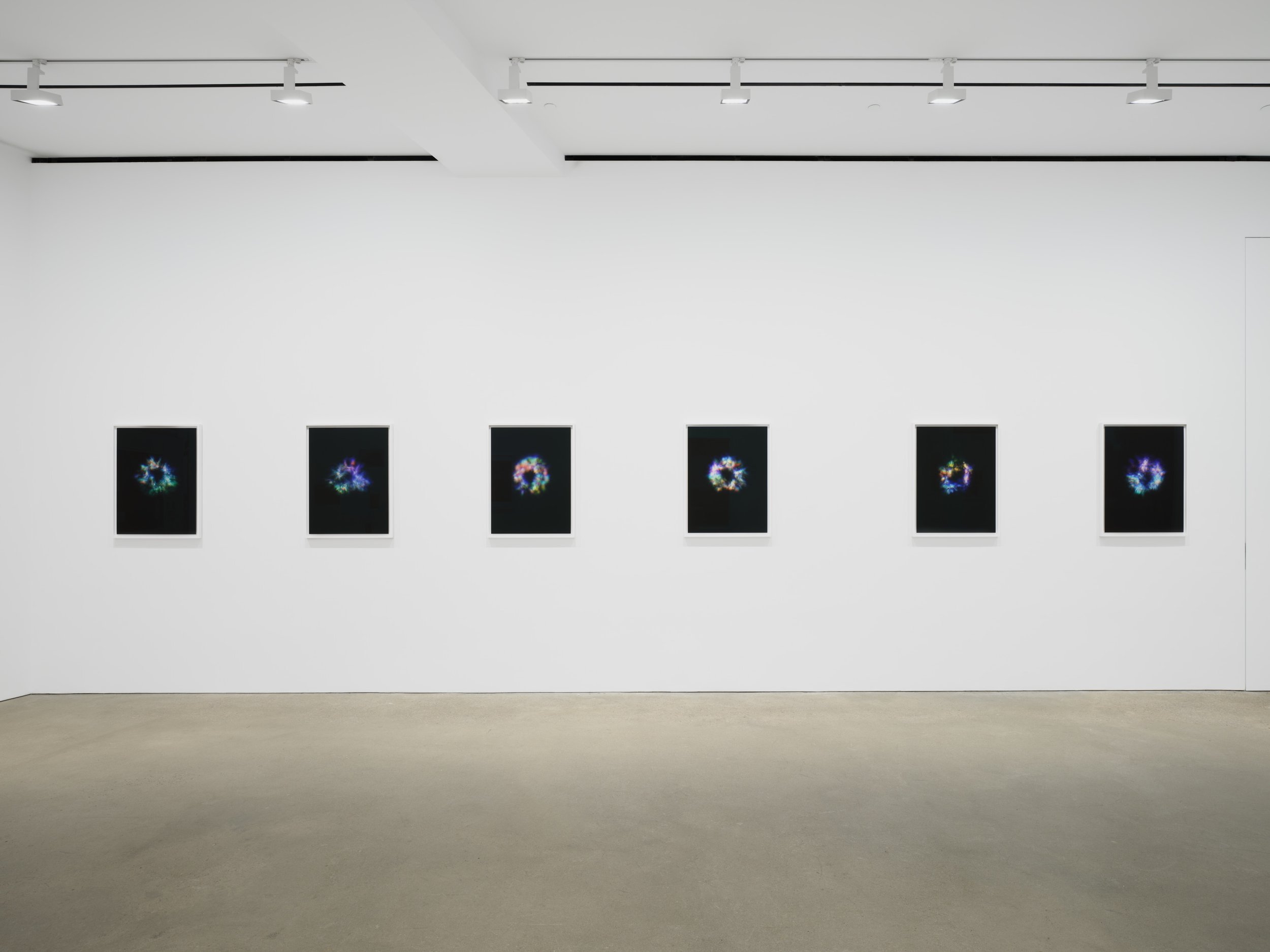
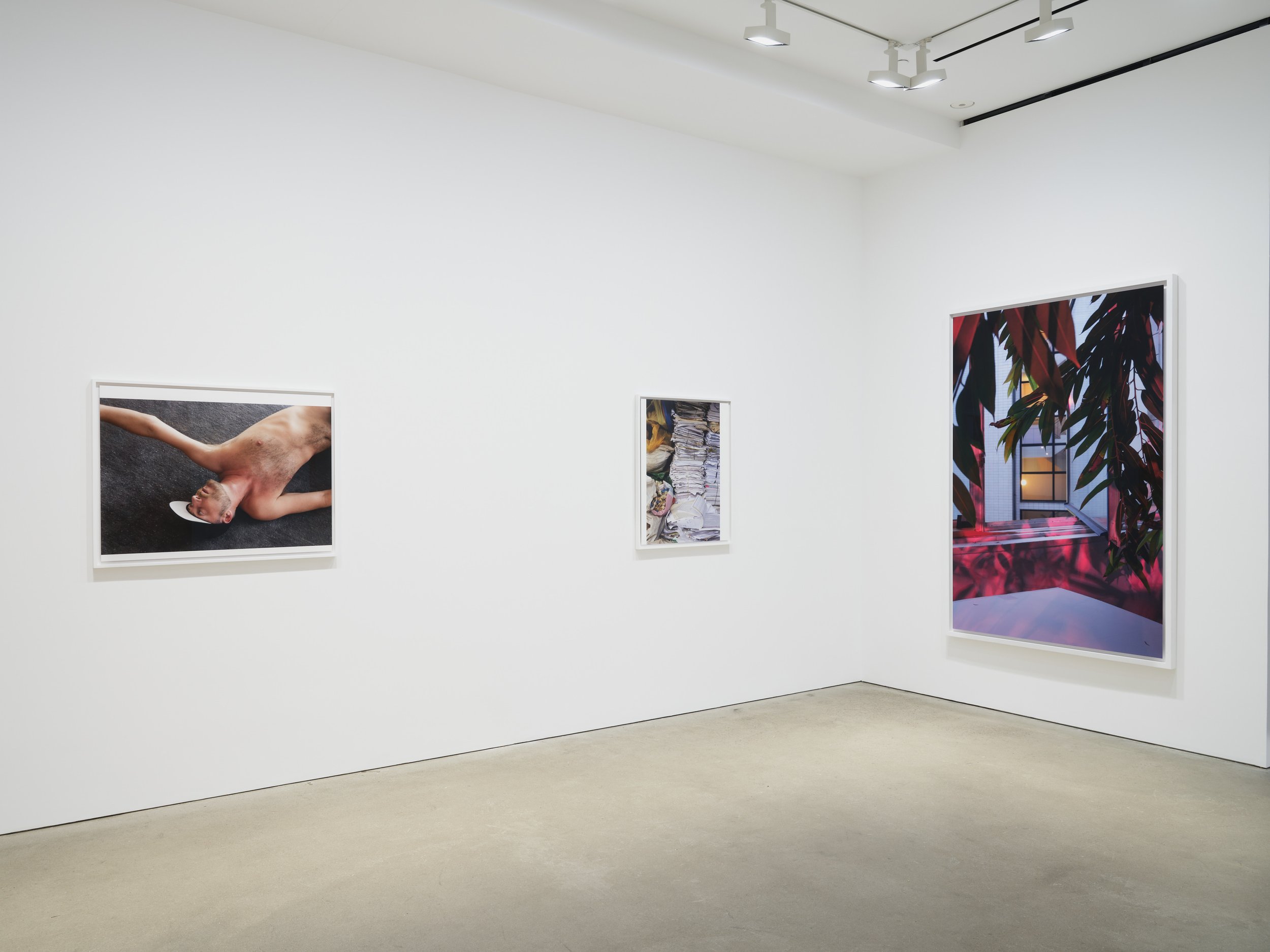
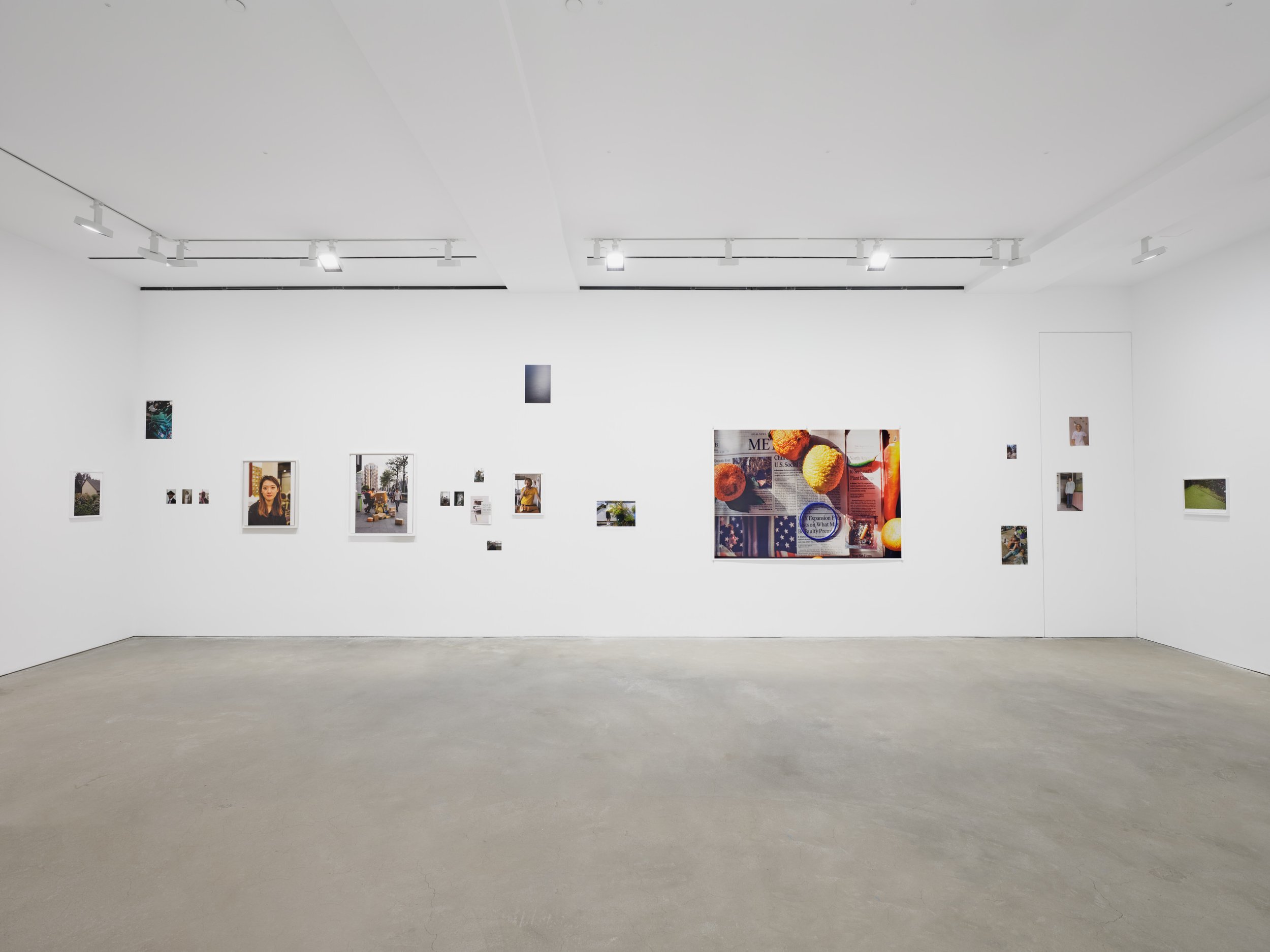
Installation view, Wolfgang Tillmans: The Point Is Matter, David Zwirner, Hong Kong, March 25—May 11, 2024 Courtesy David Zwirner
This exhibition follows his 2023 solo exhibition Fold Me at David Zwirner New York and his major 2022–2023 traveling retrospective To look without fear at The Museum of Modern Art, New York, the Art Gallery of Ontario, Toronto, and the San Francisco Museum of Modern Art. This will be the artist’s fifth solo exhibition with the gallery and his second at David Zwirner Hong Kong.
Wolfgang Tillmans, 2024 Photo: Mustafah Abdulaziz
Wolfgang Tillmans was born in 1968 in Remscheid, Germany, and studied at Bournemouth and Poole College of Art and Design in Bournemouth, England, from 1990 to 1992.
Few artists have shaped the scope of contemporary art and influenced younger generations more than Tillmans. In a career spanning almost four decades, he has consistently redefined the medium of photography through a seamless integration of genres, subjects, techniques, and exhibition strategies. His inventive practice pairs intimacy and playfulness with a commitment to social awareness and a persistent questioning of existing values and hierarchies. Guided by a profound sense of curiosity and care towards his subjects, Tillmans seeks to expand the poetic possibilities of the medium while addressing the fundamental question of what it means to create pictures in an increasingly image-saturated world. As the artist states, “The underpinning of my work has always been the use of my medium and everything it offers in order to make a new picture.”
In 2000, Tillmans was the first photographer and first non-British artist to receive the Turner Prize, an award given annually by Tate in London. From 2003 to 2009, Tillmans served as a professor at the Städelschule in Frankfurt. In 2009, he was selected to serve as an artist trustee on the board of Tate. He has been a member of the Akademie der Künste, Berlin, since 2012 and was appointed a member of the Royal Academy of Arts, London, in 2013. Tillmans was the recipient of the 2015 Hasselblad Foundation International Award in Photography and in January 2018, he was awarded the Kaiserring (Emperor’s Ring) prize from the city of Goslar in Germany. Tillmans was named one of the TIME100 Most Influential People of 2023.
Wolfgang Tillmans, Sirius Through a Defocused Telescope, f, 2023 Courtesy David Zwirner, New York/Hong Kong; Galerie Buchholz, Berlin/Cologne; and Maureen Paley, London
Since the early 1990s, Tillmans’s work has been the subject of prominent solo exhibitions at international institutions, including Tate Britain (2003); P.S.1 Contemporary Art Center, New York (2006); Museum of Contemporary Art Chicago (2006), which traveled to Hammer Museum, Los Angeles (2006–2007), Hirshhorn Museum and Sculpture Garden, Washington, DC (2007), and Museo Tamayo, Mexico City (2008); Serpentine Gallery, London (2010), which traveled to venues in South America including Museu de Arte Moderna de São Paulo, Museo de Arte del Banco de la República, Bogotá, Colombia, Museo de Arte de Lima, Peru, and Museo de Artes Visuales, Santiago, Chile; Kunsthalle Zürich (2012), which traveled to Les Rencontres d’Arles, France (2013); Moderna Museet, Stockholm (2013); and The National Museum of Art, Osaka (2015). Also in 2015, Book for Architects, a two-channel video installation, was on view at The Metropolitan Museum of Art, New York. In 2016, a solo show of the artist’s work was hosted by Museu Serralves, Porto, Portugal.
In 2017, Tate Modern, London, held a major survey of Tillmans’s work. The artist also presented a new immersive installation featuring his work in music and video in the South Tank at the museum. Later that year, solo shows of Tillmans’s work were on view at the Fondation Beyeler in Basel, marking the institution’s first comprehensive examination of photography as a medium, as well as at the Kunstverein in Hamburg.
Wolfgang Tillmans, Ulaanbaatar Still Life, 2023 Courtesy David Zwirner, New York/Hong Kong; Galerie Buchholz, Berlin/Cologne; and Maureen Paley, London
Fragile, a major solo exhibition of the artist’s work, opened in 2018 at the Musée d’Art Contemporain et Multimédias in Kinshasa, Democratic Republic of Congo, organized by Institut für Auslandsbeziehungen, Stuttgart, Germany, and traveled throughout Africa, with its last stop at Art Twenty One and Centre for Contemporary Art, Lagos, Nigeria. Qu’est-ce qui est différent? was presented at Carré d'Art - Musée d’art contemporain, Nîmes, France, in 2018. Rebuilding the Future was on view at Irish Museum of Modern Art, Dublin, in 2018–2019. The exhibition Today Is The First Day was presented at WIELS, Brussels, in 2020. Sound is Liquid was on view at the Museum moderner Kunst Stiftung Ludwig Wien, Vienna, in 2022. A major traveling exhibition of Tillmans’s work, To look without fear, opened at The Museum of Modern Art, New York, in September 2022, and subsequently traveled to the Art Gallery of Ontario, Toronto, in the Spring of 2023; and to the San Francisco Museum of Modern Art in November 2023– March 2024.
The artist has operated the nonprofit exhibition space Between Bridges since 2006. Located in London until 2011, Between Bridges has exhibited a range of work by artists, including David Wojnarowicz, Ull Hohn, Charlotte Posenenske, and Charles Henri Ford. In January 2014, it reopened in Berlin with a solo show of work by Patrick Caulfield.
Installation view, Wolfgang Tillmans: The Point Is Matter, David Zwirner, Hong Kong, March 25—May 11, 2024 Courtesy David Zwirner
Tillmans considers the printed page to be an important venue for his work. He is deeply involved in the publication of artist books and monographs, and regularly contributes to magazines. Publications that have been designed and edited by the artist include manual (Verlag der Buchhandlung Walther König, 2007); Lighter (Hatje Cantz, 2008); Abstract Pictures (Hatje Cantz, 2011); FESPA Digital / FRUIT LOGISTICA (Verlag der Buchhandlung Walther König, 2012); Neue Welt (Taschen, 2012); The Cars (Verlag der Buchhandlung Walther König, 2015); What Is Different? (Sternberg Press, 2018); and four books (Taschen, 2020); amongst others. In 2019, the artist guest edited Aperture’s “Spirituality” issue.
In recent years, Tillmans has been more directly involved in political activism. In tandem with his ongoing Truth Study Center project (begun in 2005), he has created posters for the anti-Brexit campaign in Britain and in response to right-wing populism in Germany.
Work by the artist is held in museum collections worldwide. Tillmans lives and works in Berlin and London.
The exhibition opened on March 25th and will end on May 11, 2024. For more information about this exhibit, visit David Zwirner’s site , along with following them on Instagram and find the gallery also on Artsy here.









